Sony PM-0330 GSM/GPRS/EDGE/UMTS/HSPA Smartphone with WLAN, Bluetooth, RFID User Manual Sony Ericsson Mobile Communications AB
Sony Mobile Communications Inc GSM/GPRS/EDGE/UMTS/HSPA Smartphone with WLAN, Bluetooth, RFID Sony Ericsson Mobile Communications AB
Sony >
Contents
- 1. user guide all parts
- 2. user guide - all parts
user guide all parts

User guide
Xperia™ ZR
C5503/C5502
Contents
Xperia™ ZR User guide..................................................................6
Getting started...............................................................................7
Android™ – what and why?...............................................................7
Device overview.................................................................................7
Assembly...........................................................................................8
Turning the device on and off .........................................................10
Screen lock......................................................................................10
Setup guide......................................................................................10
Accounts and services.....................................................................11
Getting to know your device........................................................12
Using the keys.................................................................................12
Battery..............................................................................................12
Using the touchscreen.....................................................................15
Using the lockscreen.......................................................................17
Home screen....................................................................................18
Accessing and using applications...................................................20
Status and notifications...................................................................23
Settings menu..................................................................................24
Typing text.......................................................................................25
Customising your device.................................................................29
Enhancing the sound output............................................................32
Memory............................................................................................32
Using a headset ..............................................................................33
Internet and messaging settings......................................................33
Controlling data usage.....................................................................34
Mobile network settings...................................................................35
Google Play™..............................................................................37
Getting started with Google Play™.................................................37
Downloading from Google Play™....................................................37
Clearing your application data.........................................................37
Permissions......................................................................................38
Installing applications not from Google Play™ ...............................38
Calling..........................................................................................39
Emergency calls...............................................................................39
Call handling....................................................................................39
Voicemail..........................................................................................41
Multiple calls....................................................................................41
Conference calls..............................................................................41
Call settings.....................................................................................42
2
This is an Internet version of this publication. © Print only for private use.
Contacts ......................................................................................44
About Contacts................................................................................44
Transferring contacts to your new device.......................................44
Contacts screen overview...............................................................46
Managing your contacts..................................................................46
Communicating with your contacts.................................................48
Sharing your contacts......................................................................48
Backing up contacts........................................................................49
Messaging....................................................................................50
Using text and multimedia messaging.............................................50
Text and multimedia message options............................................51
Google Talk™ .................................................................................52
Email.............................................................................................53
Getting started with Email................................................................53
Using email......................................................................................54
Socialife™....................................................................................57
Using the Socialife™ application.....................................................57
"WALKMAN" application .............................................................58
About the "WALKMAN" application.................................................58
Transferring media files to your device ...........................................58
Using the "WALKMAN" application ................................................59
Visualiser .........................................................................................60
Getting more information about a track or artist.............................60
Using My music to organise your tracks ........................................60
Managing playlists...........................................................................62
"WALKMAN" application widget ....................................................63
Protecting your hearing....................................................................63
Music services..............................................................................64
TrackID™ technology......................................................................64
Music Unlimited™............................................................................65
About the PlayNow™ service..........................................................65
FM radio.......................................................................................67
About the FM radio..........................................................................67
Using your favourite radio channels................................................68
Sound settings.................................................................................68
Identifying radio tracks using TrackID™..........................................68
Camera.........................................................................................70
About the camera............................................................................70
Using the still camera......................................................................70
Face detection.................................................................................71
Using Smile Shutter™ to capture smiling faces..............................71
Adding the geographical position to your photos...........................72
3
This is an Internet version of this publication. © Print only for private use.
Using still camera settings...............................................................72
Using the video camera...................................................................76
Album...........................................................................................81
About Album....................................................................................81
Mobile BRAVIA® Engine..................................................................81
Viewing photos and videos in the Pictures tab ...............................81
Viewing photos and videos in the My albums tab ..........................82
Viewing your photos on a map........................................................86
Viewing online albums.....................................................................87
Movies..........................................................................................89
About Movies...................................................................................89
Using Movies...................................................................................89
Video Unlimited™........................................................................91
About Video Unlimited™..................................................................91
Renting or buying a video................................................................91
Watching a video from Video Unlimited™.......................................92
Web browser................................................................................93
About the web browser....................................................................93
Connectivity.................................................................................94
Connecting to wireless networks.....................................................94
Sharing content with DLNA Certified™ devices..............................97
NFC..................................................................................................99
Bluetooth™ wireless technology...................................................102
Connecting your device to a computer.........................................104
Connecting your device to a TV set...............................................106
Screen mirroring............................................................................107
Scanning barcodes with the NeoReader™ application.................107
Smart Connect...............................................................................108
Synchronising data on your device............................................110
About synchronising data on your device.....................................110
Synchronising with Google™........................................................110
Synchronising your corporate email, calendar and contacts........110
Synchronising with Facebook™....................................................111
Maps and locations....................................................................113
About location services..................................................................113
Using GPS.....................................................................................113
Google Maps™..............................................................................114
Using Google Maps™ to get directions.........................................114
Calendar and alarm clock..........................................................115
Calendar.........................................................................................115
Alarm clock....................................................................................115
4
This is an Internet version of this publication. © Print only for private use.
Support and maintenance..........................................................118
Updating your device.....................................................................118
Backup and restore application.....................................................119
Resetting your device....................................................................120
Locking and protecting your device..............................................121
Support application.......................................................................123
Recycling your device....................................................................123
Reference...................................................................................124
Settings overview...........................................................................124
Status and notification icons overview..........................................125
Application overview......................................................................126
Important information.................................................................128
Important information leaflet..........................................................128
Limitations to services and features..............................................128
Protecting your device from water and dust.................................128
Legal information...........................................................................130
Index...........................................................................................131
5
This is an Internet version of this publication. © Print only for private use.
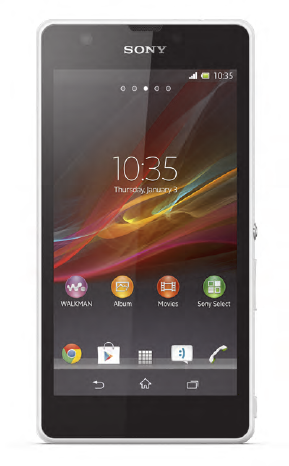
Xperia™ ZR User guide
6
This is an Internet version of this publication. © Print only for private use.
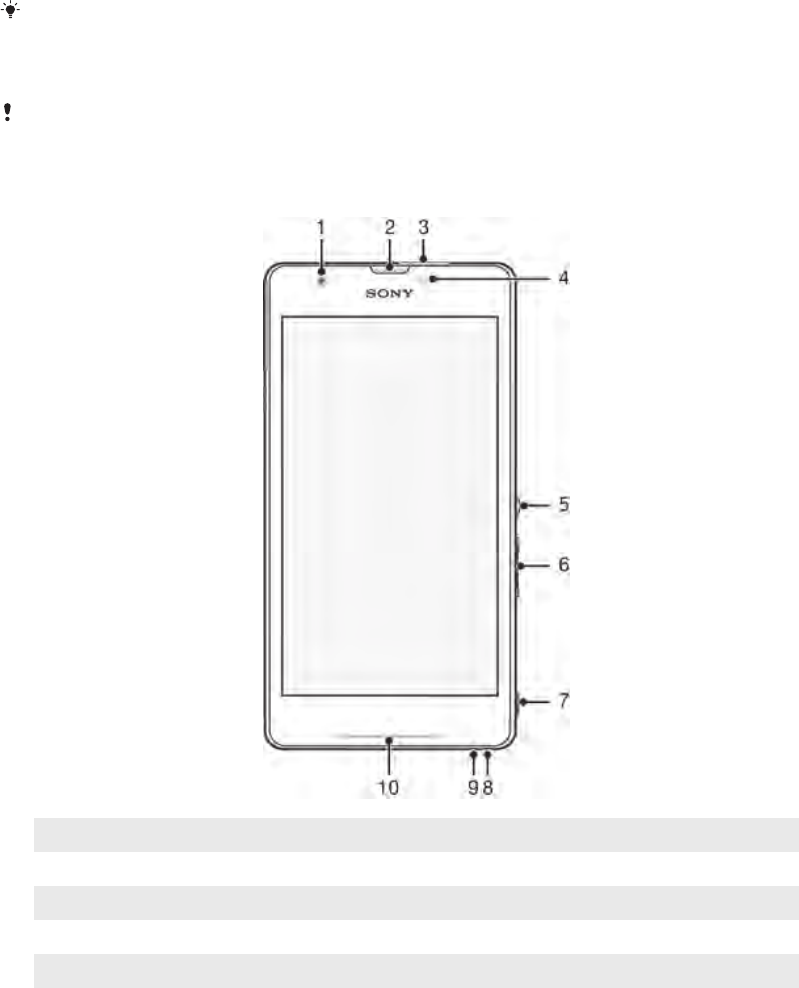
Getting started
Android™ – what and why?
Your Xperia™ from Sony runs on the Android platform. Android devices can perform
many of the same functions as a computer and you can customise them to your own
needs. For example, you can add and delete applications, or enhance existing
applications to improve functionality. On Google Play™ you can download a range of
applications and games from a constantly growing collection. You can also integrate
applications on your Android™ device with other applications and with online
services that you use. For example, you can back up your contacts, access your
different email accounts and calendars from one place, keep track of your
appointments, and engage in social networking.
Android™ devices are constantly evolving. When a new software version is available
and your device supports this new software, you can update your device to get new
features and the latest improvements.
Your Android™ device is pre-loaded with Google™ services. To get the most out of the
provided Google™ services, you should have a Google™ account and sign in to it when you
first start your device. You also need to have Internet access to use many of the features in
Android™.
New software releases may not be compatible with all devices.
Device overview
1Front camera lens
2 Ear speaker
3 Headset jack
4 Light sensor
5 Power key
7
This is an Internet version of this publication. © Print only for private use.
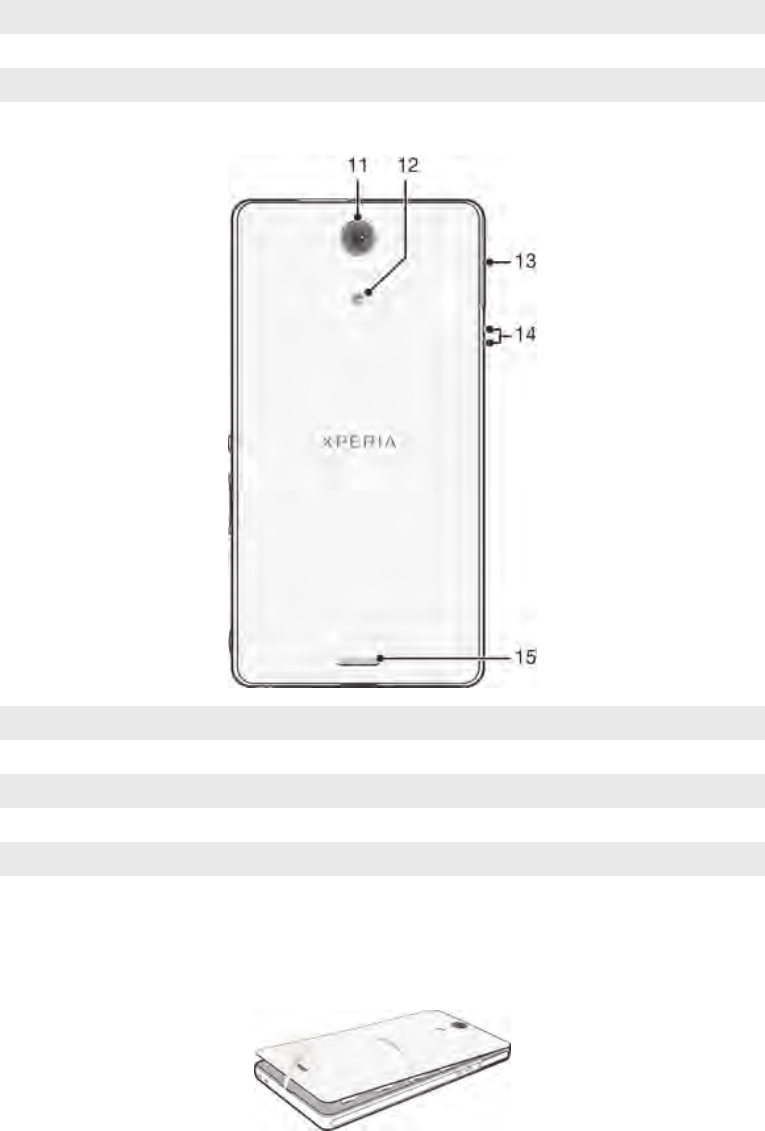
6 Volume/Zoom key
7 Camera key
8 Strap hole
9 Microphone
10 Notification light
11 Camera lens
12 Camera light
13 Port for charger/USB cable
14 Connector for charging dock
15 Speaker
Assembly
To remove the back cover
•Insert a thumbnail into the gap between the back cover and the bottom side of
your device, then lift up the cover.
8
This is an Internet version of this publication. © Print only for private use.
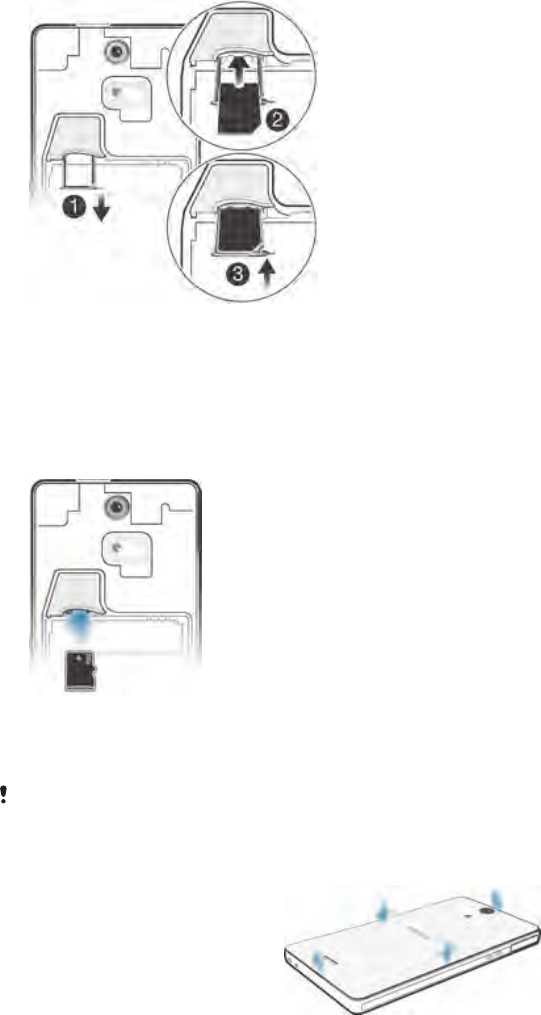
To insert the micro SIM card
1Remove the battery cover and the battery, then pull out the micro SIM card
holder.
2Place the micro SIM card into the micro SIM card holder, with the gold-
coloured contacts facing down.
3Push the micro SIM card and the holder back into the phone.
To insert a memory card
1Remove the back cover and the battery.
2Insert the memory card into the memory card slot, with the gold-coloured
contacts facing down.
The memory card may not be included at purchase in all markets.
To attach the back cover
1Place the back cover over the back of the device, then press down on the top
corners to lock them into place.
2Moving from top to bottom, press down the sides of the cover. The clips on the
inside of the cover make clicking noises as they lock into place.
9
This is an Internet version of this publication. © Print only for private use.
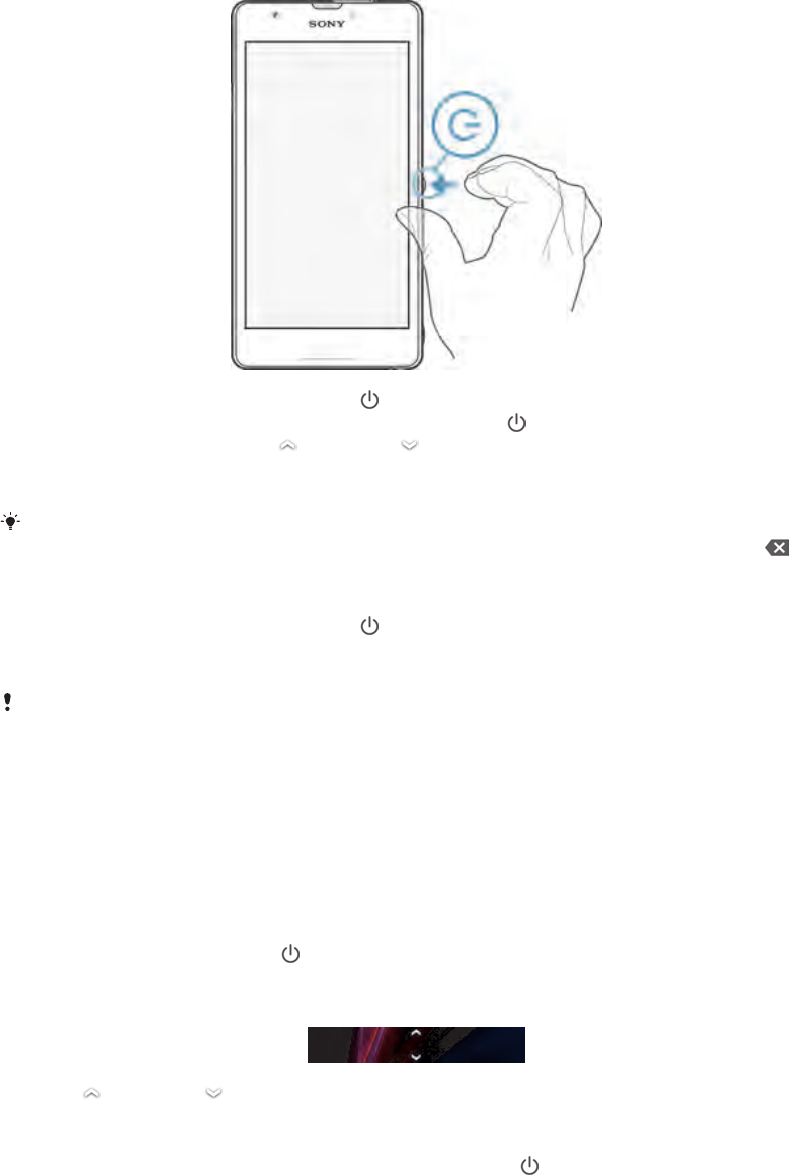
Turning the device on and off
To turn on the device
1Press and hold down the power key until the device vibrates.
2If your screen goes dark, briefly press the power key to activate the screen.
3To unlock the screen, drag up or drag down.
4Enter your SIM card PIN when requested, then select OK.
5Wait a while for the device to start.
Your SIM card PIN is initially supplied by your network operator, but you can change it later
from the Settings menu. To correct a mistake made while entering your SIM card PIN, tap .
To turn off the device
1Press and hold down the power key until the options menu opens.
2In the options menu, tap Power off.
3Tap OK.
It may take a while for the device to shut down.
Screen lock
When your device is on and left idle for a set period of time, the screen darkens to
save battery power, and locks automatically. This lock prevents unwanted actions on
the touchscreen when you are not using it. On the lockscreen, you can still take
photos and play audio tracks.
To activate the screen
•Briefly press the power key .
To unlock the screen
•Drag up or drag down.
To lock the screen manually
•When the screen is active, briefly press the power key .
Setup guide
The first time you start your device, a setup guide opens to explain basic functions
and help you enter essential settings. This is a good time to configure the device to
10
This is an Internet version of this publication. © Print only for private use.

your specific needs. You can also access the setup guide later from the settings
menu.
To access the setup guide manually
1From the Home screen, tap .
2Tap Settings > Setup guide.
Accounts and services
Sign in to your online service accounts from your device to get easy access when
you're on the move. For example, you can integrate contacts from your Google™
account into your phonebook, so you have everything in one place. You can sign up
to new online services from your device as well as from a computer.
Google™ account
Having a Google™ account is key to using a range of applications and services with
your Android device. You need a Google™ account, for example, to use the Gmail™
application in your device, to chat with friends using Google Talk™, and to
synchronise the calendar application on your device with your Google Calendar™.
You also need a Google™ account to download applications and games, music,
movies and books from Google Play™.
Microsoft® Exchange ActiveSync® account
Synchronise your device with your corporate Microsoft® Exchange ActiveSync®
account. This way, you keep your work email, contacts and calendar events with you
at all times.
Facebook™ account
Facebook™ is a social networking service that connects you with friends, family and
colleagues around the world. Set up Facebook to work on your device so that you
can stay in touch from anywhere.
11
This is an Internet version of this publication. © Print only for private use.
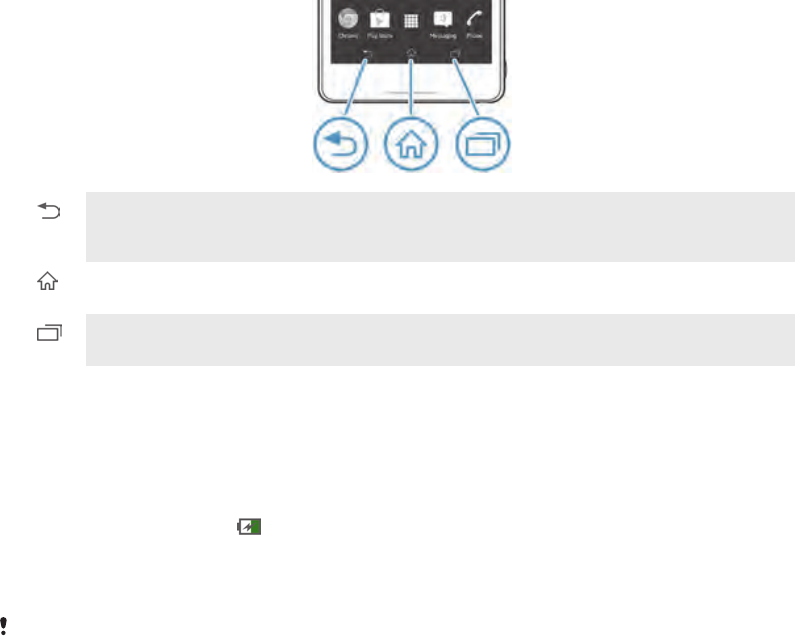
Getting to know your device
Using the keys
Back
•Go back to the previous screen
•Close the on-screen keypad, a dialog box, an options menu, or the Notification panel
Home
•Go to the Home screen
Task
•Tap to open a window showing your most recently used applications and a small apps bar
Battery
Charging the battery
Your battery is partly charged when you buy the device. It may take a few minutes
before the battery icon appears on the screen when you connect the charger
cable to a power source, such as a USB port or a charger. You can still use your
device while it is charging. Charging your device over a long period of time, for
example, overnight, does not damage the battery or the device.
The battery will start to discharge a little after it is fully charged and then charges again after a
certain time when the charger is connected. This is to extend battery life and may result in the
charge status showing a level below 100 percent.
12
This is an Internet version of this publication. © Print only for private use.
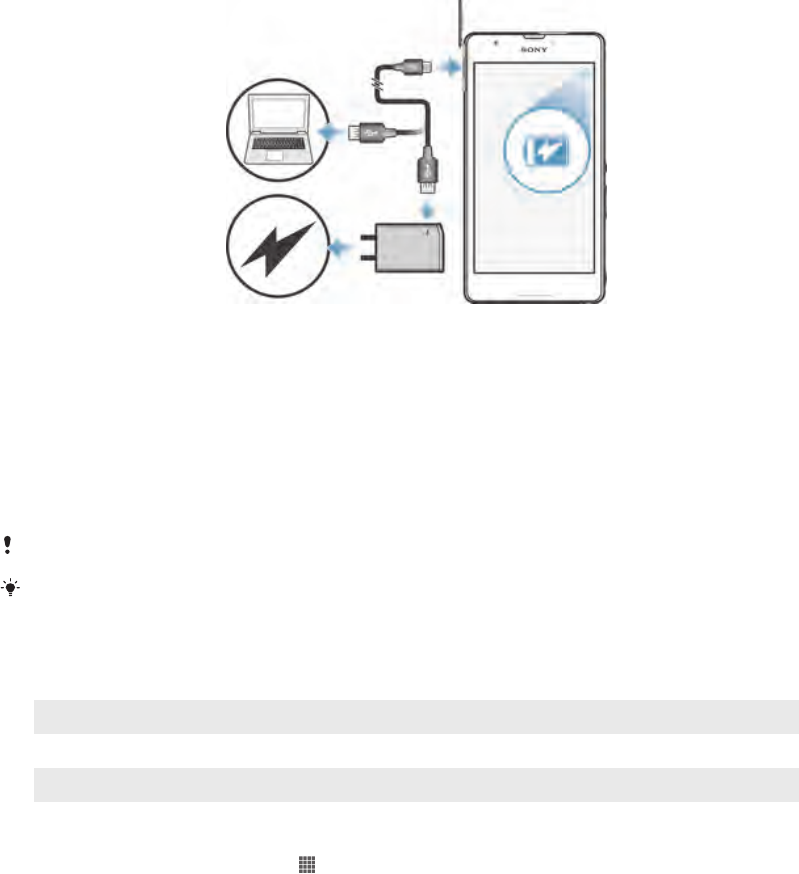
To charge your device
1Plug the charger into a power outlet.
2Plug one end of the USB cable into the charger (or into the USB port of a
computer).
3Plug the other end of the cable into the micro USB port on your device, with
the USB symbol facing up. The battery status LED lights up when charging
starts.
4When the battery status LED is green, the device is fully charged. Disconnect
the USB cable from your device by pulling it straight outwards. Make sure not
to bend the connector when removing the cable from the device.
Use the charger and USB cable provided with the device to ensure faster charging.
If the battery is completely discharged, it may take a few minutes before the LED lights up
after you connect the charger cable to a power source.
Battery LED status
Green The battery is fully charged
Red The battery level is low
Orange The battery is charging. The battery level is between low and full
To check the battery level
1From your Home screen, tap .
2Find and tap Settings > About phone > Status > Battery level.
Improving battery performance
The following tips can help you improve battery performance:
•Charge your device often. This will not affect the lifetime of the battery.
•Downloading data from the Internet is power consuming. When you're not using the
Internet, you can save power by disabling all data connections over mobile networks.
This setting does not prevent your device from transmitting data over other wireless
networks.
•Turn off Bluetooth™ and Wi-Fi® when you don't need these features. You can turn
them on and off more easily by adding the Quick settings widget to your Home
screen.
•Use the STAMINA mode and Low battery mode features to reduce battery
consumption. You can select the power saving mode that best suits the way you use
your device. You can also customise the settings of each power saving mode.
•Set your synchronisation applications (used to synchronise your email, calendar and
contacts) to synchronise manually. You can also synchronise automatically, but
increase the synchronisation intervals.
•Check the battery usage menu in your device to see which applications use the most
power. Your battery consumes more power when you use video and music streaming
13
This is an Internet version of this publication. © Print only for private use.

applications, such as YouTube™. Some applications downloaded from Google
Play™ may also consume more power.
•Close and exit applications that you are not using.
•Lower the screen display brightness level.
•Turn off your device or activate the Airplane mode setting if you are in an area with
no network coverage. Otherwise, your device repeatedly scans for available
networks, and this consumes power.
•Use a Sony original handsfree device to listen to music. Handsfree devices demand
less battery power than your device's own loudspeakers.
•Keep your device in standby mode whenever possible. Standby time refers to the
time during your device is connected to the network and is not being used.
•Disable any live wallpaper.
To access the battery usage menu
1From your Home screen, tap .
2Find and tap Settings > Power management > Battery usage.
To add the Data traffic widget to your Home screen
1Tap and hold an empty area of your Home screen.
2Tap Widgets > Tools.
3Tap and hold the Mobile data widget, then drag it to an empty area of your
Home screen.
To add the Quick settings widget to your Home screen
1Tap and hold an empty area of your Home screen.
2Tap Widgets > Tools.
3Tap and hold the Quick settings widget, then drag it to an empty area of your
Home screen.
Using STAMINA mode
Activate the STAMINA mode feature to pause your Wi-Fi® connection, data traffic
and several power consuming applications when your screen is inactive. When
STAMINA mode is active, you can still receive phone calls, and text and multimedia
messages. You can also set up an applications list to allow some applications to
keep running when your screen is inactive. Once the screen becomes active again, all
paused functions are resumed.
To activate STAMINA mode
1From your Home screen, tap .
2Find and tap Settings > Power management.
3Tap next to STAMINA mode, then tap Activate.
To deactivate STAMINA mode
1From your Home screen, tap .
2Find and tap Settings > Power management.
3Tap next to STAMINA mode.
To change the settings for STAMINA mode
1From your Home screen, tap .
2Find and tap Settings > Power management.
3To open the settings menu, tap STAMINA mode.
4Add or remove applications, as desired.
5When you're finished, tap Done.
Estimating the standby time of your device
Standby time refers to the amount of time the battery can last when your device is
connected to the network but is not in active use, for example, to receive or make
phone calls. STAMINA mode, when activated, continuously evaluates the remaining
standby time, which can vary depending on how you use your device. STAMINA
mode is more effective in lengthening the standby time if you keep the screen of your
14
This is an Internet version of this publication. © Print only for private use.

device locked. If you rarely lock the screen, you may not see much improvement in
battery performance.
When you use your device for the first time, the estimated standby time may not be accurate
since there is no previous usage history to estimate from.
To view the estimated standby time
1From your Home screen, tap .
2Find and tap Settings > Power management.
Using Low battery mode
You can activate the Low battery mode feature when the battery level is low. This
feature helps you to adjust the settings for screen brightness, data traffic and the
vibrate function so that you can reduce battery consumption.
To activate Low battery mode
1From your Home screen, tap .
2Find and tap Settings > Power management.
3Tap next to Low battery mode, then tap Activate.
To deactivate Low battery mode
1From your Home screen, tap .
2Find and tap Settings > Power management.
3Tap next to Low battery mode.
To change the settings for Low battery mode
1From your Home screen, tap .
2Find and tap Settings > Power management.
3To open the settings menu, tap Low battery mode.
4Adjust the settings as desired.
5When you're finished, tap .
Using the touchscreen
A protective plastic sheet is already attached to the screen of your device when you
buy it. You should peel off this sheet before using the touchscreen. Otherwise, the
touchscreen might not function properly.
When your device is on and left idle for a set period of time, the screen darkens to
save battery power, and locks automatically. This lock prevents unwanted actions on
the touchscreen when you are not using it. You can also set personal locks to protect
your subscription and make sure only you can access content on your device.
The device screen is made from glass. Do not touch the screen if the glass is cracked or
shattered. Avoid trying to repair a damaged screen yourself. Glass screens are sensitive to
drops and mechanical shocks. Cases of negligent care are not covered by the Sony warranty
service.
To open or highlight an item
•Tap the item.
Marking options
Marked checkbox
Unmarked checkbox
Marked list option
Unmarked list option
15
This is an Internet version of this publication. © Print only for private use.
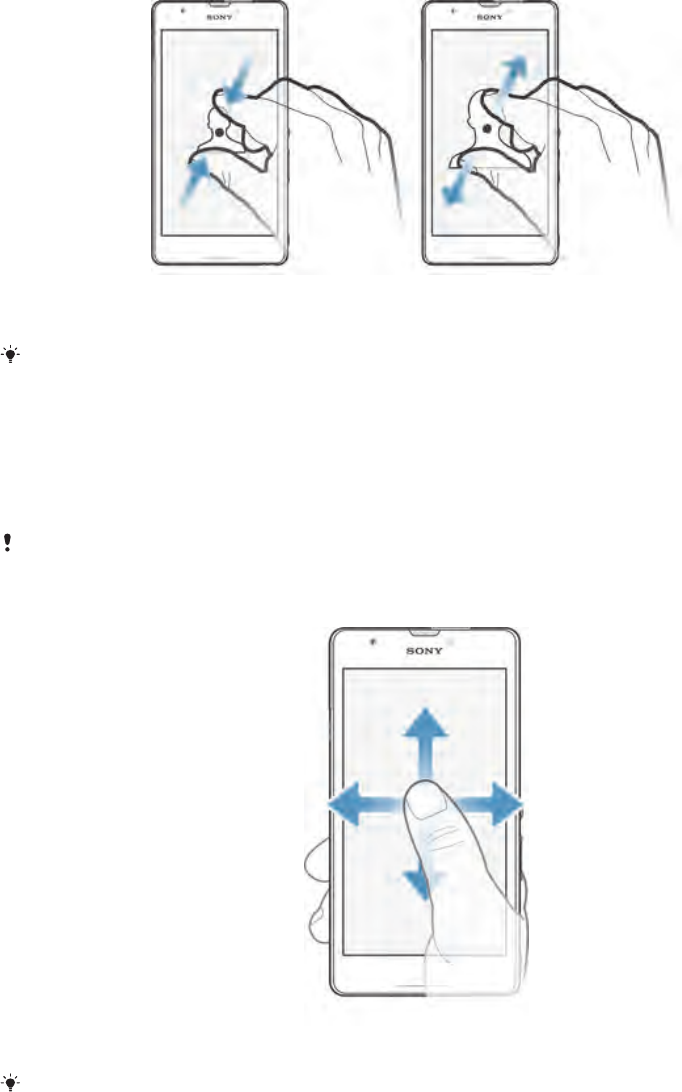
To mark or unmark options
•Tap the relevant checkbox or list option.
Zooming
The zoom options available depend on the application you are using.
To zoom
•Place two fingers on the screen at once and pinch them together (to zoom out)
or spread them apart (to zoom in).
When you use two fingers on the screen to zoom, it is only possible to zoom if both fingers
are within the zoomable area. If you, for example, want to zoom in on a photo, make sure that
both fingers are within the photo frame area.
Scrolling
Scroll by moving your finger up or down on the screen. On some web pages you can
also scroll to the sides.
Dragging or flicking will not activate anything on the screen.
To scroll
•Drag or flick your finger in the direction you want to scroll on the screen.
To scroll more quickly, flick your finger in the direction you want to go on the screen.
16
This is an Internet version of this publication. © Print only for private use.
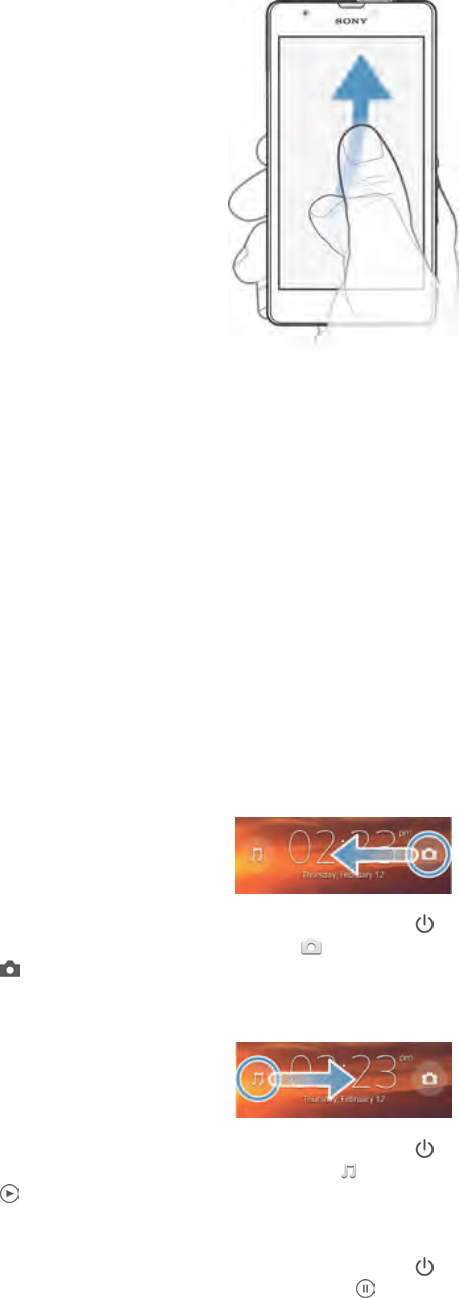
To flick
•To scroll more quickly, flick your finger in the direction you want to go on the
screen. You can wait for the scrolling movement to stop by itself, or you can
stop it immediately by tapping the screen.
Sensors
Your device has sensors that detect both light and proximity. The light sensor detects
the ambient light level and adjusts the brightness of the screen accordingly. The
proximity sensor turns the touch screen off during voice calls when your ear is close
to the screen. This prevents you from unintentionally activating other functions on
your device when you are engaged in a call.
Using the lockscreen
On the lockscreen, you can play tracks, take photos and record videos without
unlocking the screen.
To take a photo from the lockscreen
1To activate the screen, briefly press the power key .
2To activate the camera controls, drag to the left across the screen.
3Tap .
To play an audio track from the lockscreen
1To activate the screen, briefly press the power key .
2To display the music player controls, drag to the right across the screen.
3Tap .
To pause an audio track from the lockscreen
1To activate the screen, briefly press the power key .
2When the music player controls appear, tap .
17
This is an Internet version of this publication. © Print only for private use.
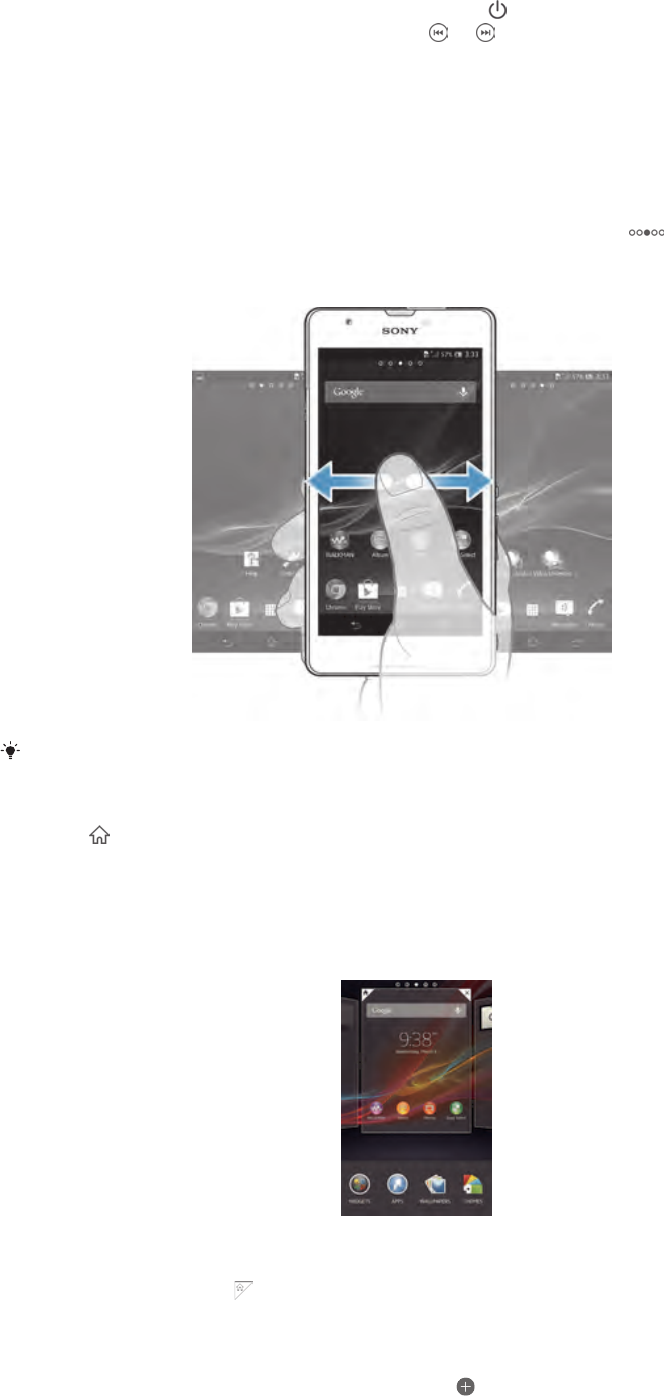
To change the currently playing audio track from the lockscreen
1To activate the screen, briefly press the power key .
2When the music player controls appear, tap or .
Home screen
The Home screen is your gateway to the main features on your device. You can
customise your Home screen with widgets, shortcuts, folders, themes, wallpaper and
other items.
The Home screen extends beyond the regular screen display width, so you need to
flick left or right to view content in all of the Home screen's panes. shows which
part of the Home screen you are in. You can set a pane as the main Home screen
pane, and add or delete panes.
The items in the bar at the bottom of the screen are always available for quick access.
To go to the Home screen
•Press .
To browse the Home screen
•Flick right or left.
To set a pane as the main Home screen pane
1Touch and hold an empty area on your Home screen until the device vibrates.
2Flick left or right to browse to the pane that you want to set as your main Home
screen pane, then tap .
To add a pane to your Home screen
1Touch and hold an empty area on your Home screen until the device vibrates.
2Flick left or right to browse the panes, then tap .
18
This is an Internet version of this publication. © Print only for private use.

To delete a pane from your Home screen
1Touch and hold an empty area on your Home screen until the device vibrates.
2Flick left or right to browse to the pane that you want to delete, then tap .
Widgets
Widgets are small applications that you can use directly on your Home screen. For
example, the “WALKMAN” widget allows you to start playing music directly.
Some widgets are resizable, so you can expand them to view more content or shrink
them to save space on your Home screen.
To add a widget to the Home screen
1Touch and hold an empty area on your Home screen until the device vibrates,
then tap Widgets.
2Find and tap the widget that you want to add.
To resize a widget
1Touch and hold a widget until it magnifies and the device vibrates, then release
the widget. If the widget can be resized, for example, the Calendar widget,
then a highlighted frame and resizing dots appear.
2Drag the dots inward or outward to shrink or expand the widget.
3To confirm the new size of the widget, tap anywhere on the Home screen.
Rearranging your Home screen
Customise the appearance of your Home screen and change the features that you
can access from it. Change the screen background, move items around, create
folders, and add shortcuts and widgets.
Customisation options
When you touch and hold an empty area of your Home screen, the following
customisation options appear:
Add widgets to your Home screen.
Add applications and shortcuts.
Set a wallpaper for your Home screen.
Set a background theme.
To view customisation options from the Home screen
•Touch and hold an empty area on your Home screen until the device vibrates
and customisation options appear at the bottom of the screen.
To add a shortcut to your Home screen
1Touch and hold an empty area on your Home screen until the device vibrates.
2Tap Apps > Shortcuts.
3Select a shortcut.
You can add an application shortcut directly from the Application screen by touching and
holding the application.
To move an item on the Home screen
•Touch and hold the item until it magnifies and the device vibrates, then drag
the item to the new location.
To delete an item from the Home screen
•Touch and hold an item until it magnifies and the device vibrates, then drag the
item to .
19
This is an Internet version of this publication. © Print only for private use.
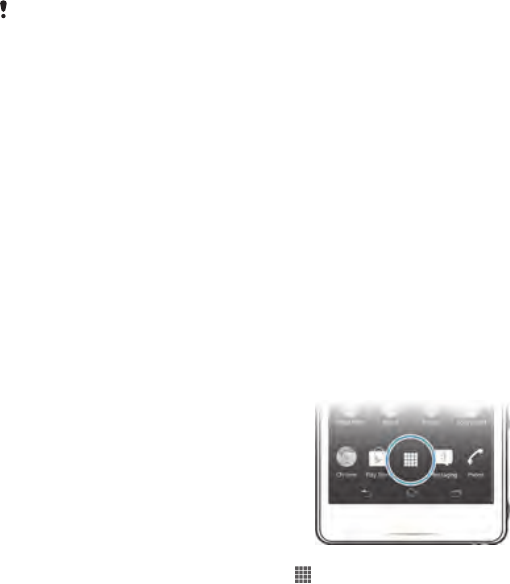
To create a folder on the Home screen
1Touch and hold an application icon or a shortcut until it magnifies and the
device vibrates, then drag and drop it on top of another application icon or
shortcut.
2Enter a name for the folder and tap Done.
To add items to a folder on the Home screen
•Touch and hold an item until it magnifies and the device vibrates, then drag the
item to the folder.
To rename a folder on the Home screen
1Tap the folder to open it.
2Tap the folder's title bar to show the Folder name field.
3Enter the new folder name and tap Done.
Changing the background of your Home screen
Adapt the Home screen to your own style using wallpapers and different themes.
To change your Home screen wallpaper
1Touch and hold an empty area on your Home screen until the device vibrates.
2Tap Wallpapers and select an option.
To set a theme for your Home screen
1Touch and hold an empty area on your Home screen until the device vibrates.
2Tap Themes, then select a theme.
When you change a theme, the background also changes in some applications.
Accessing and using applications
Open applications from shortcuts on your Home screen or from the Application
screen.
Application screen
The Application screen, which you open from your Home screen, contains the
applications that come pre-installed on your device as well as the applications you
download.
The Application screen extends beyond the regular screen width, so you need to flick
left and right to view all content.
To open the Application screen
•From your Home screen, tap .
To browse the Application screen
•From the Application screen, flick right or left.
20
This is an Internet version of this publication. © Print only for private use.
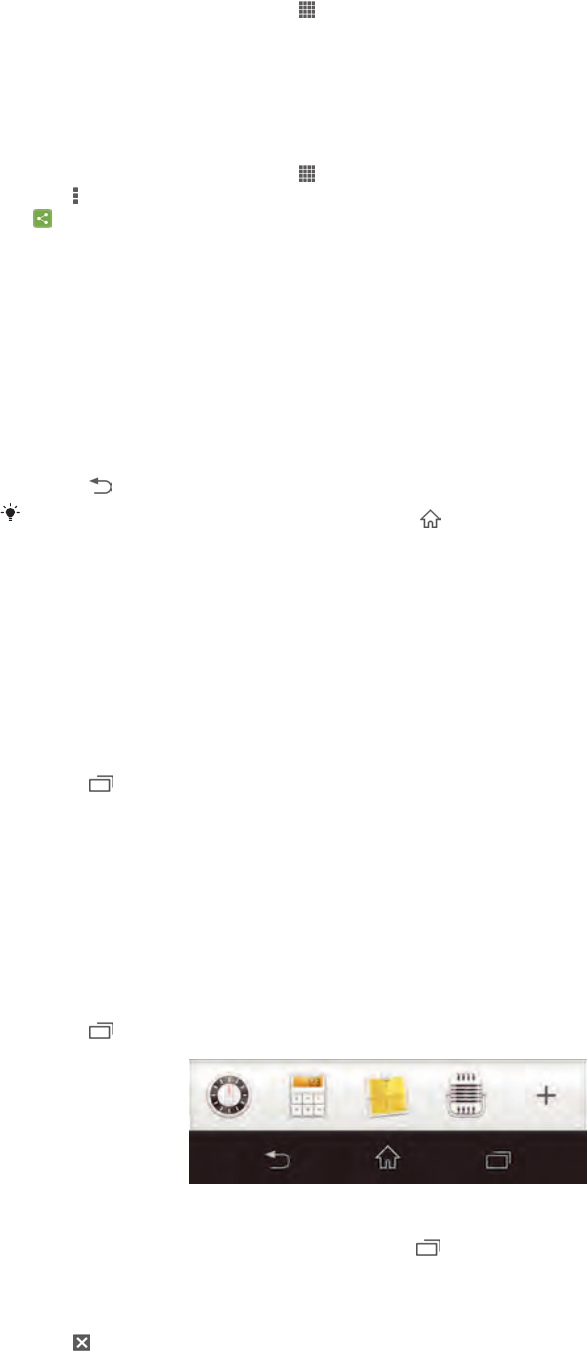
To create a shortcut to an application on the Home screen
1From your Home screen, tap .
2Touch and hold an application icon until the screen vibrates, then drag the icon
to the top of the screen. The Home screen opens.
3Drag the icon to the desired location on the Home screen, then release your
finger.
To share an application from your Application screen
1From your Home screen, tap .
2Tap , then tap Share. All applications which can be shared are indicated by
.
3Tap the application that you want to share, then select an option and confirm,
if necessary. A link to a download of the application is sent to the people you
have selected.
Opening and closing applications
To open an application
•From your Home screen or the Application screen, tap the application.
To close an application
•Press .
Some applications are paused when you press to exit, while other applications may
continue to run in the background. In the first case, the next time you open the application,
you can continue where you left off. Remember that some applications may cause data
connection charges when they are running in the background, for example, social networking
services.
Recently used applications window
You can switch between recently used applications from this window. You can also
open small apps.
To open the recently used applications window
•Press . The recently used applications window appears on the right of the
screen.
Using small apps
From the recently used applications window, you can get quick access to several
small apps at any time using the small apps bar. A small app only takes up a small
area of your screen. So you can interact with a small app and another application at
the same time on the same screen.
To open the small apps bar
•Press . The small apps bar appears at the bottom of the screen.
To open a small app
1To make the small apps bar appear, press .
2Tap the small app that you want to open. A small app window appears.
To close a small app
•Tap on the small app window.
21
This is an Internet version of this publication. © Print only for private use.

To move a small app
•When the small app is open, touch and hold the top left corner of the small
app, then move it to the desired location.
To minimise a small app
•When the small app is open, touch and hold the top left corner of the small
app, then drag it to the right edge or to the bottom edge of the screen.
To rearrange your small apps
1To make the small apps bar appear, press .
2Touch and hold a small app and drag it to the desired position in the small
apps bar.
To remove a small app from the small apps bar
1To make the small apps bar appear, press .
2Touch and hold a small app icon and drag it away from the small apps bar.
To restore a previously removed small app
1To make the small apps bar appear, press .
2Tap > Installed small apps.
3Select the small app that you want to restore.
To download a small app
1To make the small apps bar appear, press .
2Tap > .
3Find a small app that you want to download, then follow the instructions to
complete the installation.
Application menu
You can open a menu at any time when you are using an application. The menu will
look different depending on which application you are using.
To open a menu in an application
•While using the application, press .
A menu is not available in all applications.
Rearranging your Application screen
Move the applications around on the Application screen according to your
preferences.
To arrange applications on the Application screen
1From your Home screen, tap to go to the Application screen.
2Tap the drop-down list on the top left of the screen and select an option.
To move an application on the Application screen
1Open the Application screen.
2Touch and hold an item until it magnifies and the device vibrates, then drag the
item to the new location.
You can only move your applications when Own order is selected.
To uninstall an application from the Application screen
1From your Home screen, tap .
2Tap , then tap Uninstall. All uninstallable applications are indicated by .
3Tap the application that you want to uninstall, then tap Uninstall.
22
This is an Internet version of this publication. © Print only for private use.

Status and notifications
The status bar at the top of your screen shows what's going on in your device. To the
left you get notifications when there is something new or ongoing. For example, new
message and calendar notifications appear here. The right side shows the signal
strength, battery status, and other information.
The status bar allows you to adjust basic settings on your device, for example,
Wi-Fi®, Bluetooth™, data traffic, and sound. You can also open the settings menu
from the Notification panel to change other settings.
A notification light also gives you battery status information and some notifications.
For example, a flashing blue light means there is a new message or a missed call.
The notification light may not work when the battery level is low.
Checking notifications and ongoing activities
You can drag down the status bar to open the Notification panel and get more
information. For example, you can use the panel to open a new message or view a
calendar event. You can also open some applications that run in the background,
such as the music player.
To open the Notification panel
•Drag the status bar downwards.
23
This is an Internet version of this publication. © Print only for private use.
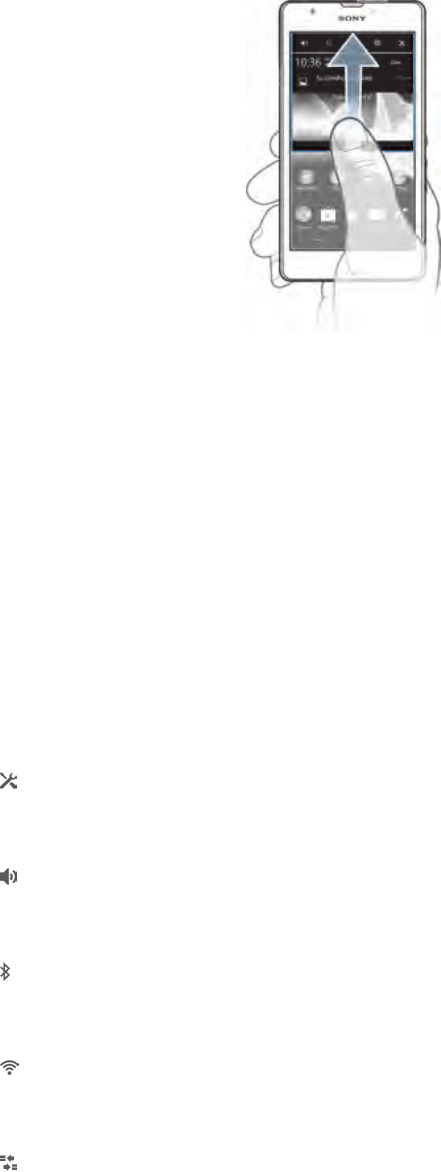
To close the Notification panel
•Drag the tab at the bottom of the Notification panel upwards.
To open a running application from the Notification panel
•Tap the icon for the running application to open it.
To dismiss a notification from the Notification panel
•Place your finger on a notification and flick left or right.
To clear the Notification panel
•From the Notification panel, tap Clear.
Setting your device from the Notification panel
You can open the settings menu from the Notification panel to adjust basic device
settings. For example, you can turn on Wi-Fi®.
To open the device settings menu from the Notification panel
1Drag the status bar downwards.
2Tap .
To adjust sound settings from the Notification panel
1Drag the status bar downwards.
2Tap .
To control the Bluetooth™ function from the Notification panel
1Drag the status bar downwards.
2Tap .
To control the Wi-Fi® function from the Notification panel
1Drag the status bar downwards.
2Tap .
To enable or disable data traffic from the Notification panel
1Drag the status bar downwards.
2Tap .
Settings menu
View and change settings for your device from the Settings menu.
24
This is an Internet version of this publication. © Print only for private use.
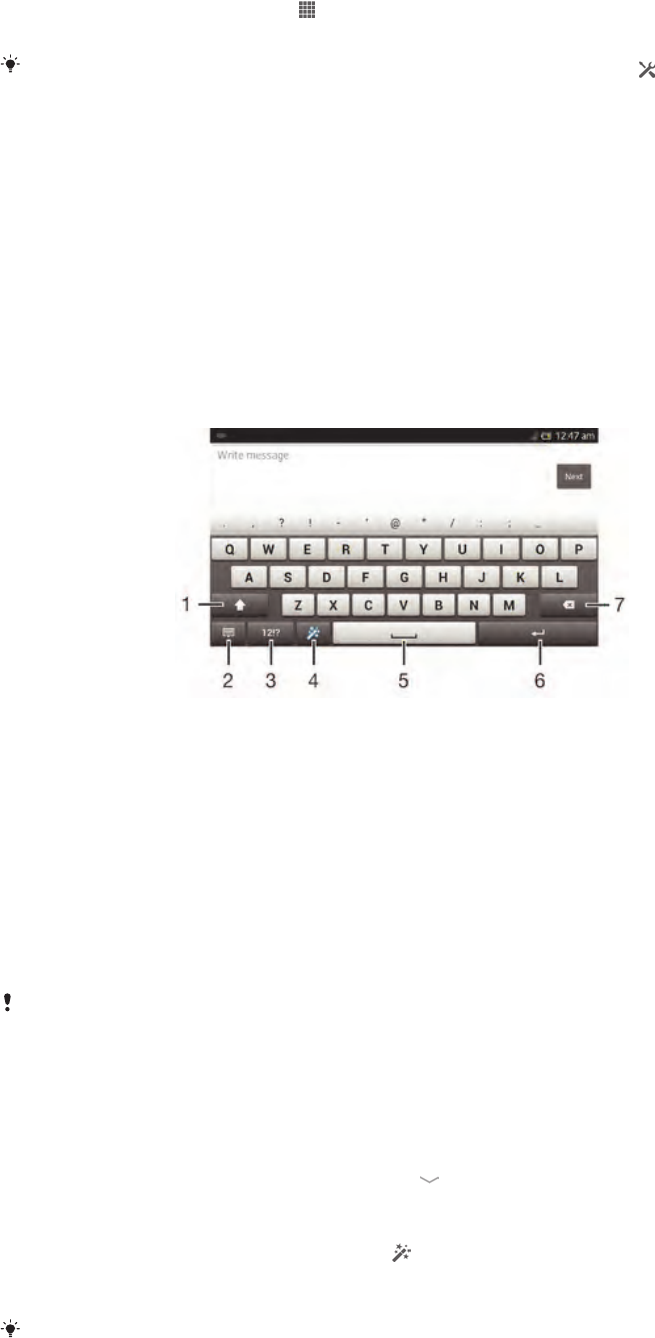
To access your device settings
1From your Home screen, tap .
2Tap Settings.
You can also drag the status bar downwards on the Home screen and tap to access your
device settings.
Typing text
You can select from a number of keyboards and input methods to type text
containing letters, numbers and other characters.
On-screen keyboard
Tap the keys of the on-screen QWERTY keyboard to enter text conveniently. Some
applications open the on-screen keyboard automatically. You can also open this
keyboard by touching a text field.
Using the on-screen keyboard
1Change the character case and turn on the caps lock. For some languages, this key is used to access
extra characters in the language.
2 Close the on-screen keyboard view. Note that this icon does not appear in portrait mode.
3 Display numbers and symbols.
4 Personalise your keyboard. This key disappears after the keyboard is personalised.
5 Enter a space.
6 Enter a carriage return or confirm text input.
7 Delete a character before the cursor.
All illustrations are for illustration purposes only and may not accurately depict the actual
device.
To display the on-screen keyboard to enter text
•Tap a text entry field.
To hide the on-screen keyboard
•When the on-screen keyboard is open, tap .
To personalise the on-screen keyboard
1Open the on-screen keyboard, then tap .
2Follow the instructions to personalise your on-screen keyboard, for example,
mark the Smiley key checkbox.
If you don't mark the Smiley key checkbox when you personalise the on-screen keyboard, the
smiley icon will not appear.
25
This is an Internet version of this publication. © Print only for private use.
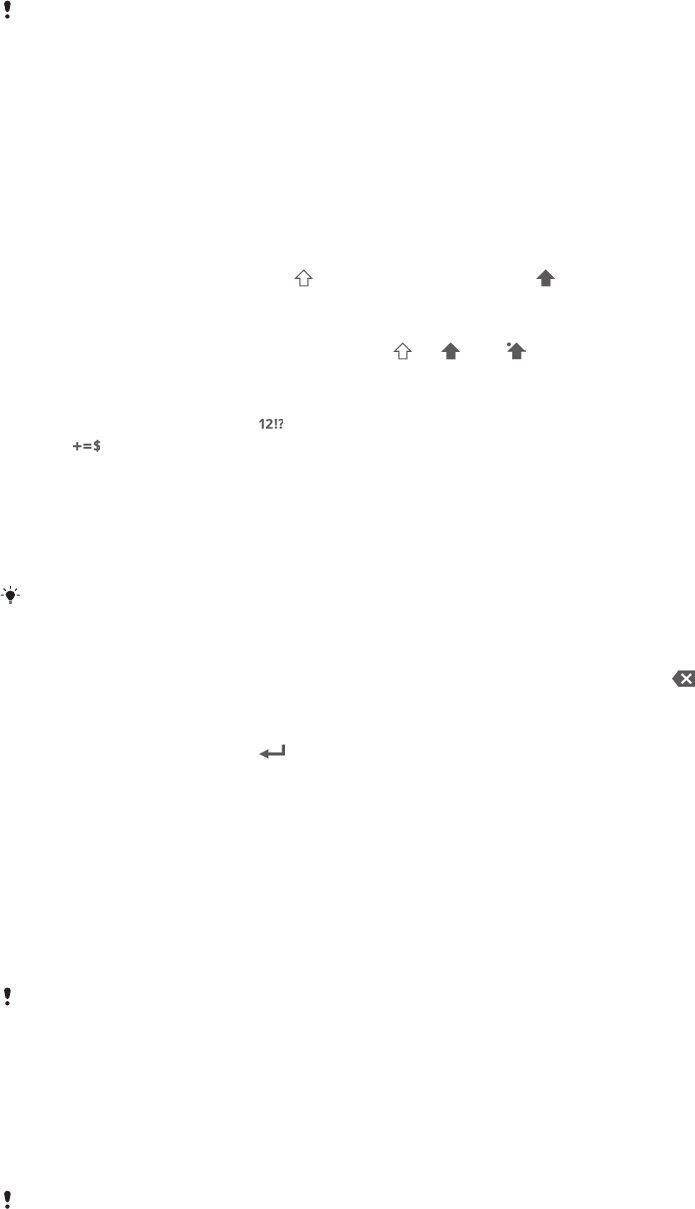
To use the on-screen keyboard in landscape orientation
•When you enter text, turn the device sideways.
For the keyboard to support this feature, landscape mode must be supported by the
application you are using, and your screen orientation settings must be set to automatic.
To enter text using the on-screen keyboard
1To enter a character visible on the keyboard, tap the character.
2To enter a character variant, touch and hold a regular keyboard character to
get a list of available options, then select from the list. For example, to enter
"é", touch and hold "e" until other options appear, then, while keeping your
finger pressed on the keyboard, drag to and select "é".
To shift between upper-case and lower-case letters
•Before you enter a letter, tap to switch to upper-case , or vice versa.
To turn on the caps lock
•Before you type a word, touch and hold or until appears.
To enter numbers or symbols
•When you enter text, tap . A keyboard with numbers and symbols appears.
Tap to view more options.
To enter common punctuation marks
1When you finish entering a word, tap the space bar.
2Select a punctuation mark from the candidate bar. The selected mark is
inserted before the space.
To quickly enter a full stop, tap the space bar twice when you finish entering a word.
To delete characters
•Tap to place the cursor after the character you want to delete, then tap .
To enter a carriage return
•When you enter text, tap to enter a carriage return.
To select text
1Enter some text, then double-tap the text. The word you tap gets highlighted
by tabs on both sides.
2Drag the tabs left or right to select more text.
To edit text in landscape orientation
1Enter some text, then double-tap the entered text.
2Select the text you want to work with, then tap Edit... and select an option.
To paste text from the clipboard, double-tap the text field to make Paste appear, then tap
Paste.
To edit text in portrait orientation
1Enter some text, then double-tap the entered text to make the application bar
appear.
2Select the text you want to edit, then use the application bar to make your
desired changes.
To paste text from the clipboard, double-tap the text field to make Paste appear, then tap
Paste.
26
This is an Internet version of this publication. © Print only for private use.
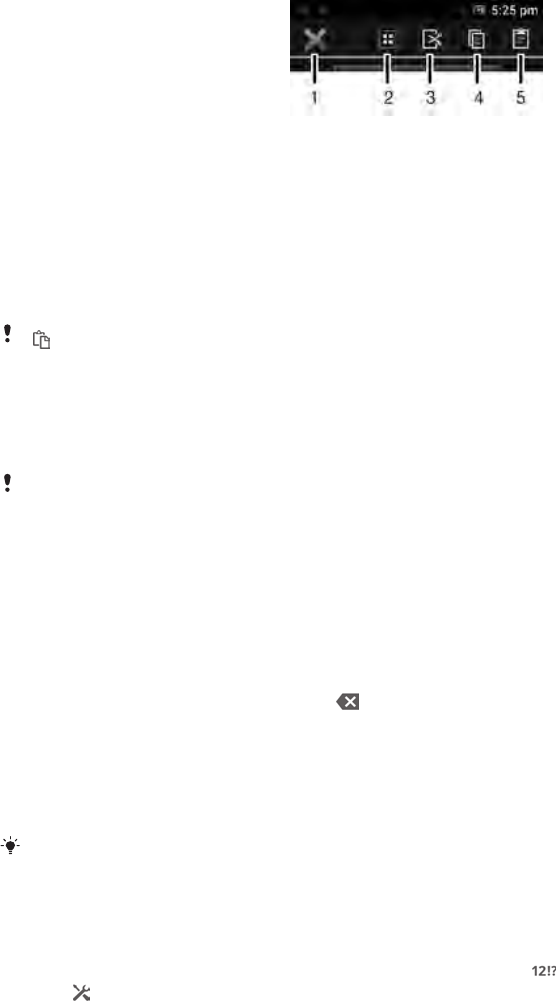
Application bar
1 Close the application bar
2 Select all text
3 Cut text
4 Copy text
5 Paste text
only appears when you have text stored on the clipboard.
Using the Gesture input function to write words
You can input text by sliding your finger from letter to letter on the on-screen
keyboard.
Gesture input is only available when you use the on-screen keyboard.
To enter text using the Gesture input function
1When you enter text using the on-screen keyboard, slide your finger from letter
to letter to trace the word you want to write.
2Lift up your finger when you’ve finished entering a word. A word is suggested
based on the letters you have traced. If necessary, select the correct word in
the candidate bar.
3To view more options, scroll right or left in the word candidate bar. If you
cannot find the desired word, tap once to delete the entire word. Then try
again to trace the word using the Gesture input function, or tap each letter to
enter the word.
4If the Space between gestures setting is activated, trace the next word that
you want to enter. If not, tap the space bar and then trace the next word you
want to enter.
To enter joined compound words when the Space between gestures setting is activated, you
may need to slide to enter the first part of the word, then tap each letter to enter the rest of
the word.
To change the Gesture input settings
1When you enter text using the on-screen keyboard, tap .
2Tap , then tap Keyboard settings.
3Tap Text input settings.
4Mark or unmark the Gesture input checkbox.
5If you want to automatically add a space between gestures without having to
tap the space bar each time, mark the Space between gestures checkbox.
Phonepad
The Phonepad is similar to a standard 12-key telephone keypad. It gives you
predictive text and multi-tap input options. You can activate the Phonepad text input
method via the keyboard settings. The Phonepad is only available in portrait
orientation.
27
This is an Internet version of this publication. © Print only for private use.
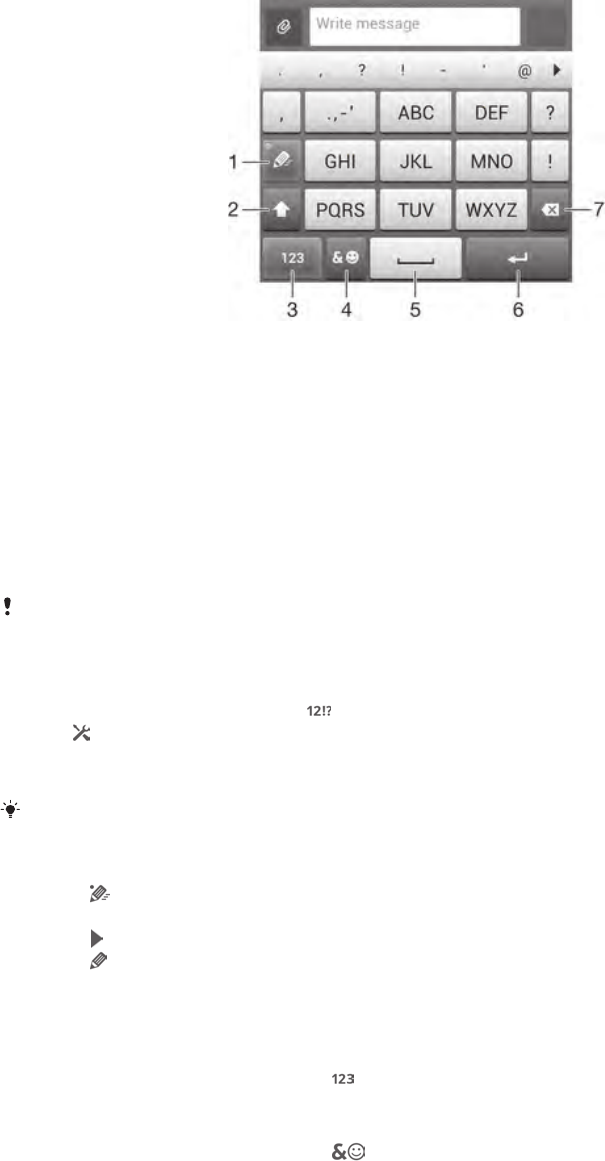
Using the Phonepad
1 Choose a text input option
2 Change the character case and turn on the caps lock
3 Display numbers
4 Display symbols and smileys
5 Enter a space
6 Enter a carriage return or confirm text input
7 Delete a character before the cursor
All illustrations are for illustration purposes only and may not accurately depict the actual
device.
To open the Phonepad for the first time
1Tap a text entry field, then tap .
2Tap , then tap Keyboard settings.
3Tap Keyboard appearance > Keyboard layout.
4Select the Phonepad.
The Phonepad can only be used in portrait mode.
To enter text using the Phonepad
•When appears in the Phonepad, tap each character key only once, even if
the letter you want is not the first letter on the key. Tap the word that appears
or tap to view more word suggestions and select a word from the list.
•When appears in the Phonepad, tap the on-screen key for the character you
want to enter. Keep pressing this key until the desired character is selected.
Then do the same for the next character you want to enter, and so on.
To enter numbers using the Phonepad
•When the Phonepad is open, tap . A Phonepad with numbers appears.
To insert symbols and smileys using the Phonepad
1When the Phonepad is open, tap . A grid with symbols and smileys
appears.
2Scroll up or down to view more options. Tap a symbol or smiley to select it.
Keyboard and Phonepad settings
You can select settings for the on-screen keyboard and the Phonepad, such as
writing language and automatic correction.
28
This is an Internet version of this publication. © Print only for private use.

To access the on-screen keyboard and Phonepad settings
1When you enter text using the on-screen keyboard or Phonepad, tap or .
2Tap , then tap Keyboard settings.
To add a writing language for text input
1When you enter text using the on-screen keyboard or Phonepad, tap or .
2Tap , then tap Keyboard settings.
3Tap Languages > Writing languages and mark the relevant checkboxes. Tap
OK to confirm.
Text input settings
When entering text using the on-screen keyboard or the Phonepad, you can access a
text input settings menu that helps you set options for text prediction, automatic
spacing and quick fixes. For example, you can decide how word options are
presented and how words get corrected as you type. You can also set the text input
application to remember new words that you write.
To change the text input settings
1When you enter text using the on-screen keyboard or the Phonepad, tap or
.
2Tap , then tap Keyboard settings > Text input settings and select the
relevant settings.
Entering text using voice input
When you enter text, you can use the voice input function instead of typing the
words. Just speak the words that you want to enter. Voice input is an experimental
technology from Google™, and is available for a number of languages and regions.
To enable voice input
1When you enter text using the on-screen keyboard or the Phonepad, tap or
.
2Tap , then tap Keyboard settings .
3Mark the Google voice typing key checkbox.
4Press to save your settings. A microphone icon appears on your on-
screen keyboard or Phonepad.
To enter text using voice input
1Open the on-screen keyboard or the Phonepad.
2If is available, tap it. If not, touch and hold the input language key, for
example, .
3When appears, speak to enter text. When you're finished, tap again. The
suggested text appears.
4Edit the text manually if necessary.
Customising your device
You can adjust several device settings to suit your own needs. For example, you can
change the language, add a personal ringtone, or change the screen brightness.
Adjusting the volume
You can adjust the ringtone volume for incoming calls and notifications as well as for
music and video playback.
To adjust the ring volume with the volume key
•Press the volume key up or down.
To adjust the media playing volume with the volume key
•When playing music or watching video, press the volume key up or down.
29
This is an Internet version of this publication. © Print only for private use.

Adjusting the sound settings
You can adjust several sound settings. For example, you can set your device to silent
mode so that it doesn't ring when you're in a meeting.
To set your device to vibrate mode
•Press the volume key down until appears in the status bar.
You can also press and hold down the power key and then tap in the menu that opens
to set your device to vibrate mode.
To set your device to silent mode
1Press the volume key down until the device vibrates and appears in the
status bar.
2Press the volume key down again. appears in the status bar.
You can also press and hold down the power key and then tap in the menu that opens
to set your device to silent mode.
To set your device to vibrate and ring mode
1From your Home screen, tap .
2Find and tap Settings > Sound.
3Mark the Vibrate when ringing checkbox.
Time and date
You can change the time and date on your device.
To set the date manually
1From the Home screen, tap .
2Find and tap Settings > Date & time.
3Unmark the Automatic date & time checkbox, if it is marked.
4Tap Set date.
5Adjust the date by scrolling up and down.
6Tap Done.
To set the time manually
1From your Home screen, tap .
2Find and tap Settings > Date & time.
3Unmark the Automatic date & time checkbox if it is marked.
4Tap Set time.
5Scroll up or down to adjust the hour and minute.
6If applicable, scroll up to change am to pm, or vice versa.
7Tap Done.
To set the time zone
1From your Home screen, tap .
2Find and tap Settings > Date & time.
3Unmark the Automatic time zone checkbox, if it is marked.
4Tap Select time zone.
5Select an option.
Ringtone settings
To set a ringtone
1From your Home screen, tap .
2Find and tap Settings > Sound > Phone ringtone.
3Select a ringtone.
4Tap Done.
30
This is an Internet version of this publication. © Print only for private use.

To enable touch tones
1From your Home screen, tap .
2Find and tap Settings > Sound.
3Mark the Dial pad touch tones and Touch sounds checkboxes.
To select the notification sound
1From your Home screen, tap .
2Find and tap Settings > Sound > Default notification.
3Select the sound to be played when notifications arrive.
4Tap Done.
Screen settings
To adjust the screen brightness
1From your Home screen, tap .
2Find and tap Settings > Display > Brightness.
3Drag the slider to adjust the brightness.
4Tap OK.
The brightness level affects your battery performance. For tips on how to improve battery
performance, see Improving battery performance.
To set the screen to vibrate
1From your Home screen, tap .
2Find and tap Settings > Sound.
3Mark the Vibrate on touch checkbox. The screen now vibrates when you tap
soft keys and certain applications.
To adjust the idle time before the screen turns off
1From your Home screen, tap .
2Find and tap Settings > Display > Sleep.
3Select an option.
To turn off the screen quickly, briefly press the power key .
To keep the screen active while your device is charging
1From the Home screen, tap .
2Find and tap Settings > Developer options.
3Mark the Stay awake checkbox.
Language settings
You can select a default language for your device and change it again at a later time.
To change the language
1From the Home screen, tap .
2Find and tap Settings > Language & input > Language.
3Select an option.
4Tap OK.
If you select the wrong language and cannot read the menu texts, find and tap . Then select
the text beside and select the first entry in the menu that opens. You can then select the
language you want.
Airplane mode
In Airplane mode, the network and radio transceivers are turned off to prevent
disturbance to sensitive equipment. However, you can still play games, listen to
music, watch videos and other content, as long as all this content is saved on your
31
This is an Internet version of this publication. © Print only for private use.

memory card or internal storage. You can also be notified by alarms, if alarms are
activated.
Turning on Airplane mode reduces battery consumption.
To turn on Airplane mode
1From your Home screen, tap .
2Find and tap Settings > More….
3Mark the Airplane mode checkbox.
You can also press and hold down the power key and then select Airplane mode in the
menu that opens.
Enhancing the sound output
You can enhance the sound output that comes from the speakers in your device
using features such as Clear Phase™ and xLOUD™ technology.
Using Clear Phase™ technology
Use Clear Phase™ technology from Sony to automatically adjust the sound quality
coming from your device's internal speakers and get a cleaner, more natural sound.
To enhance the speaker sound quality using Clear Phase™
1From your Home screen, tap .
2Find and tap Settings > Sound.
3Mark the Clear Phase™ checkbox.
The activation of the Clear Phase™ feature has no effect on voice communication
applications. For example, there is no change in the voice call sound quality.
Using xLOUD™ technology
Use xLOUD™ audio filter technology from Sony to enhance the speaker volume
without sacrificing quality. Get a more dynamic sound as you listen to your favourite
songs.
To enhance the speaker volume using xLOUD™
1From your Home screen, tap .
2Find and tap Settings > Sound.
3Mark the xLOUD™ checkbox.
The activation of the xLOUD™ feature has no effect on voice communication applications. For
example, there is no change in the voice call sound quality.
Memory
You can save content to your device's internal storage and to a memory card.
Memory card
Your device supports a microSD™ memory card, which is used for storing content.
This type of card can also be used as a portable memory card with other compatible
devices.
You may have to purchase a memory card separately.
Formatting the memory card
You can format the memory card in your device, for example, to free up memory.
This means that you erase all data on the card.
All content on the memory card gets erased when you format it. Make sure you make backups
of everything you want to save before formatting the memory card. To back up your content,
32
This is an Internet version of this publication. © Print only for private use.
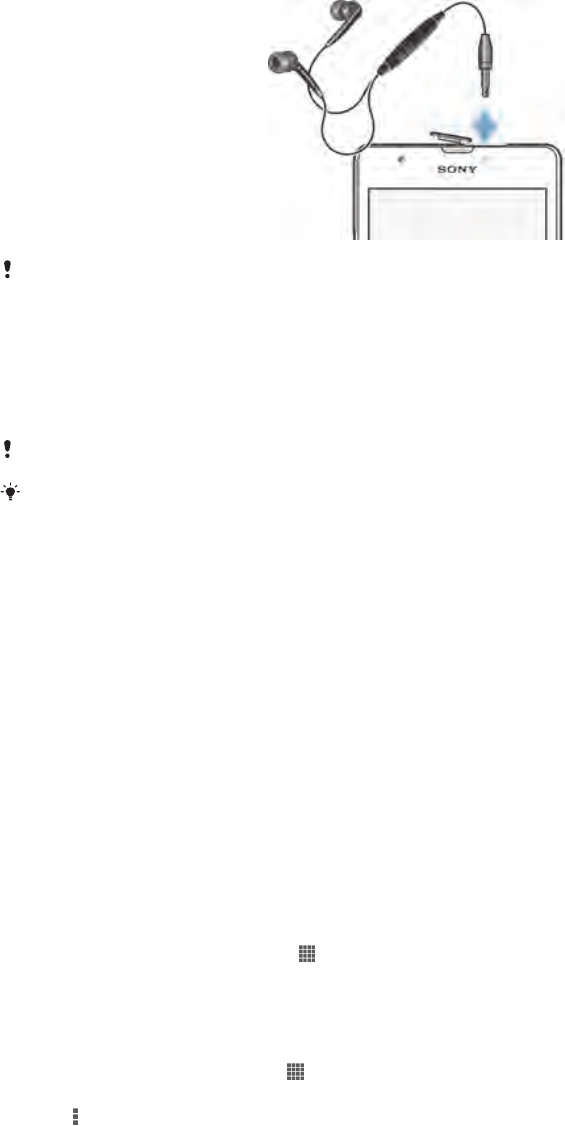
you can copy it to your computer. For more information, refer to the chapter Connecting your
device to a computer on page 104.
Using a headset
Use the accessories provided with your device, or other compatible accessories, for optimal
performance.
To use a headset
1Connect the headset to your device.
2To answer a call, press the call handling key.
3To end the call, press the call handling key.
If a headset is not included with the device, you may purchase one separately.
If you are listening to music, the music stops when you answer a call and resumes after you
end the call.
Internet and messaging settings
To send text and multimedia messages and to access the Internet, you must have a
mobile data connection and the correct settings. There are different ways to get
these settings:
•For most mobile networks and operators, Internet and messaging settings come
preinstalled on your device. You can then start using the Internet and send messages
right away.
•In some cases you will get the option to download Internet and messaging settings
the first time you turn on your device. It is also possible to download these settings
later from the Settings menu.
•You can manually add and change Internet and network settings on your device at
any time. Contact your network operator for detailed information about Internet and
messaging settings.
To download Internet and messaging settings
1From your Home screen, tap .
2Find and tap Settings > Xperia™ > Internet settings.
3Tap Accept.
To reset the default Internet settings
1From the Home screen, tap .
2Tap Settings > More… > Mobile networks > Access Point Names.
3Tap .
4Tap Reset to default.
Access Point Names (APNs)
An APN is used to establish data connections between your device and the Internet.
The APN defines which type of IP address to use, which security methods to invoke,
and which fixed-end connections to use. Checking the APN is useful when you
33
This is an Internet version of this publication. © Print only for private use.

cannot access the Internet, have no data connection, or cannot send or receive
multimedia messages.
To view the current APN
1From your Home screen, tap .
2Find and tap Settings > More… > Mobile networks.
3Tap Access Point Names.
If you have several available connections, the active network connection is indicated by a
marked button.
To add Internet settings manually
1From the Home screen, tap .
2Find and tap Settings > More… > Mobile networks > Access Point Names.
3Tap .
4Tap New APN.
5Tap Name and enter the name of the network profile that you want to create.
6Tap APN and enter the access point name.
7Enter all other information required by your network operator.
8Tap , then tap Save.
Usage info
For quality purposes, Sony collects anonymous bug reports and statistics regarding
your device. None of the information gathered includes personal data.
To allow the sending of usage info
1From your Home screen, tap .
2Find and tap Settings > Xperia™ > Usage info settings.
3Mark the Send usage info checkbox if it is not already marked.
4Tap Agree to allow the sending of usage information.
Controlling data usage
Keep track of and control the amount of data transferred to and from your device
during a given period. For example, you can set data usage warnings and limits for
your device to avoid additional charges. You can also limit the amount of data used
by individual applications.
Adjusting data usage settings can help you keep greater control over data usage but cannot
guarantee the prevention of additional charges.
To access data usage settings
1From your Home screen, tap .
2Find and tap Settings > Data usage.
To turn data traffic on or off
1From your Home screen, tap .
2Find and tap Settings > Data usage.
3To turn data traffic on or off, tap the on-off switch beside Mobile data
accordingly.
You can also turn data traffic on or off by marking or unmarking the Mobile data traffic
checkbox under Settings > More… > Mobile networks.
To set a data usage warning
1Make sure that you have turned on data traffic.
2From your Home screen, tap .
3Find and tap Settings > Data usage.
4To set the warning level, drag the lines to the desired values. You receive a
warning notification when the amount of data traffic approaches the level you
set.
34
This is an Internet version of this publication. © Print only for private use.

To set a data usage limit
1Make sure that you have turned on data traffic.
2From your Home screen, tap .
3Find and tap Settings > Data usage.
4Mark the Set mobile data limit checkbox if it is not marked, then tap OK.
5To set the data usage limit, drag the lines to the desired values.
Once your data usage reaches the set limit, data traffic on your device will be turned off
automatically.
To control the data usage of individual applications
1From your Home screen, tap .
2Find and tap Settings > Data usage.
3Find and tap the desired application.
4Make the necessary adjustments to change the data usage limit, restrict
background data, or restrict all data traffic for the application.
5To access more specific settings for the application, tap View app settings
and make the desired changes.
Specific settings for an application may not always be accessible.
The performance of individual applications may be affected if you change the related data
usage settings.
Mobile network settings
Your device automatically switches between mobile networks depending on what
mobile networks are available in different areas. You can also manually set your
device to use a particular mobile network mode, for example, WCDMA or GSM.
To select a network mode
1From your Home screen, tap .
2Find and tap Settings > More… > Mobile networks.
3Tap Network Mode.
4Select a network mode.
To select another network manually
1From the Home screen, tap .
2Find and tap Settings > More… > Mobile networks > Network operators.
3Tap Search mode > Manual.
4Select a network.
If you select a network manually, your device will not search for other networks, even if you
move out of range of the manually selected network.
To activate automatic network selection
1From the Home screen, tap .
2Find and tap Settings > More… > Mobile networks > Network operators.
3When a pop-up window appears, tap Search mode.
4Tap Automatic.
Turning off data traffic
You can disable all data connections over mobile networks to avoid any unwanted
data downloads and synchronisations. Contact your network operator if you need
detailed information about your subscription plan and data traffic charges.
When data traffic is turned off, you can still use Wi-Fi® and Bluetooth™ connections. You can
also send and receive multimedia messages.
35
This is an Internet version of this publication. © Print only for private use.

To turn off all data traffic
1From your Home screen, tap .
2Find and tap Settings > More… > Mobile networks.
3Unmark the Mobile data traffic checkbox.
Data roaming
Some network operators allow mobile data connections via mobile networks when
you are outside of your home network (roaming). Note that data transmission charges
may apply. Contact your network operator for more information.
Applications may sometimes use the Internet connection in your home network without any
notification, for example, when sending search and synchronisation requests. Additional
charges may apply when such Internet connections are established while you are roaming.
Consult your network operator for more information.
To activate data roaming
1From the Home screen, tap .
2Find and tap Settings > More… > Mobile networks.
3Mark the Data roaming checkbox.
You can’t activate data roaming when data connections have been deactivated.
36
This is an Internet version of this publication. © Print only for private use.

Google Play™
Getting started with Google Play™
Open Google Play™ and enter a world of applications and games. You can browse
these applications and games through different categories. You can also rate an
application or game and send feedback on it.
To use Google Play™, you need to have a Google™ account. See To set up a
Google™ account on your device on page 54.
Google Play™ may not be available in all countries or regions
To open Google Play™
1From the Home screen, tap .
2Find and tap Play Store.
Downloading from Google Play™
You can download all kinds of applications from Google Play™, including free
applications.
Before you download applications
Before you start downloading from Google Play™, make sure that you have a
working Internet connection.
Also, remember that you might incur data traffic charges when you download content
to your device. Contact your operator for more information.
To download a free application
1In Google Play™, find an item you wish to download by browsing categories,
or by using the search function.
2Tap the item to view its details, and follow the instructions to complete the
installation.
To download a paid application
1In Google Play™, find an item you wish to download by browsing categories,
or by using the search function.
2Tap the item to view its details, and follow the instructions to complete your
purchase.
To open a downloaded application
1In Google Play™, press , then tap My Apps.
2Tap the downloaded application.
You can also access downloaded applications from the Application screen.
Clearing your application data
You may sometimes need to clear data for an application. This might happen if, for
example, the application memory becomes full, or you want to clear high scores for a
game. You might also want to erase incoming email, text and multimedia messages
in some applications.
37
This is an Internet version of this publication. © Print only for private use.

To clear all cache for an application
1From your Home screen, tap .
2Find and tap Settings.
3Tap Apps.
4Tap the application for which you want to clear all cache.
5Tap Clear cache.
It is not possible to clear the cache for some applications.
To delete an installed application
1From your Home screen, tap .
2Find and tap Settings.
3Tap Apps.
4Select the application that you want to delete.
5Tap Uninstall.
It is not possible to delete some preinstalled applications.
Permissions
Some applications may need to access data, settings and various functions on your
device in order to work properly. If so, then they need the relevant permissions from
you. For example, a navigation application needs permissions to send and receive
data traffic, and access your location. Some applications might misuse their
permissions by stealing or deleting data, or by reporting your location. Make sure you
only install and give permissions to applications you trust.
To view permissions of an application
1From your Home screen, tap .
2Find and tap Settings.
3Tap Apps.
4Tap the desired application.
5Scroll down to view the relevant details under Permissions.
Installing applications not from Google Play™
Installing applications of unknown or unreliable origin can damage your device. By
default, your device is set to block such installations. However, you can change this
setting and allow installations from unknown sources.
Sony does not warrant or guarantee the performance of any third-party applications or content
transferred via download or other interface to your device. Similarly, Sony is not responsible
for any damage or reduced performance of your device attributable to the transfer of third-
party content. Only use content from reliable sources. Contact the content provider if you have
any questions or concerns.
To allow the installation of applications not from Google Play™
1From your Home screen, tap .
2Find and tap Settings > Security.
3Mark the Unknown sources checkbox.
4Tap OK.
38
This is an Internet version of this publication. © Print only for private use.

Calling
Emergency calls
Your device supports international emergency numbers, for example, 112 or 911.
You can normally use these numbers to make emergency calls in any country, with or
without the SIM card inserted if you are within range of a network.
To make an emergency call
1From your Home screen, tap .
2Find and Tap Phone.
3Enter the emergency number and tap Call. To delete a number, tap .
You can make emergency calls when no SIM card is inserted or when outgoing calls are
barred.
To make an emergency call while the SIM card is locked
1Tap Emergency call.
2Enter the emergency number and tap Call. To delete a number, tap .
Call handling
You can make a call by manually dialling a phone number, by tapping a number
saved in your contact list, or by tapping the phone number in your call log view. You
can also use the smart dial feature to quickly find numbers from your contact list and
call logs.
To dial a phone number
1From your Home screen, tap .
2Find and tap .
3If the call log appears, tap to enter the dialpad view.
4Enter the phone number and tap .
To delete a digit entered by mistake, tap .
To make a call using smart dial
1From your Home screen, tap .
2Find and tap Phone.
3Use the dialpad to enter letters or numbers that correspond to the contact you
want to call. As you enter each letter or number, a list of possible matches
appears.
4Tap the contact you want to call.
To end a call
•Tap End call.
To make an international call
1From your Home screen, tap .
2Find and tap Phone.
3Touch and hold 0 until a “+” sign appears.
4Enter the country code, area code (without the first 0) and phone number, then
tap Call.
39
This is an Internet version of this publication. © Print only for private use.
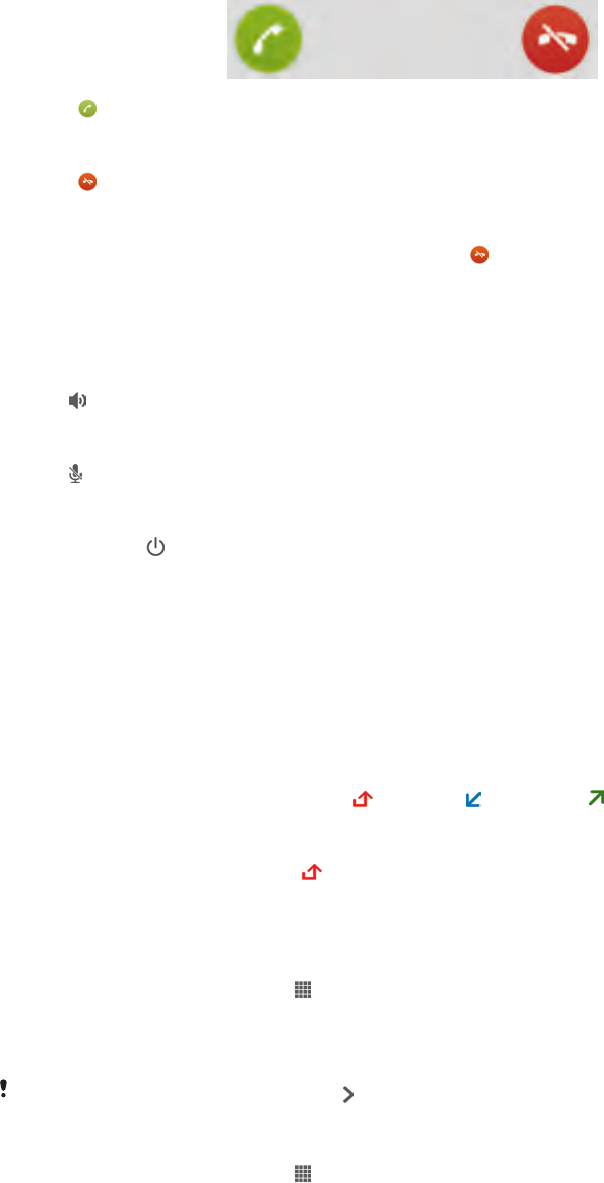
To answer a call
•Drag to the right across the screen.
To decline a call
•Drag to the left across the screen.
To reject a second call
•When you hear repeated beeps during a call, tap .
To change the ear speaker volume during a call
•Press the volume key up or down.
To turn on the loudspeaker during a call
•Tap .
To mute the microphone during a call
•Tap .
To activate the screen during a call
•Briefly press .
To enter numbers during a call
1During the call, tap Dialpad. A keypad appears.
2Tap the numbers you want to enter.
To mute the ringtone for an incoming call
•When you receive the call, press the volume key.
Recent calls
In the call log, you can view missed , received and dialled calls.
To view your missed calls
1When you have missed a call, appears in the status bar. Drag the status bar
downwards.
2Tap Missed call.
To call a number from your call log
1From your Home screen, tap .
2Find and tap Phone.The call log view appears on the upper part of the screen.
3To call a number directly, tap the number. To edit a number before calling,
touch and hold the number, then tap Edit number before call.
You can also call a number by tapping > Call back.
To add a number from the call log to your contacts
1From your Home screen, tap .
2Find and tap Phone.The call log view appears on the upper part of the screen.
3Touch and hold the number, then tap Add to Contacts.
4Tap the desired contact, or tap Create new contact.
5Edit the contact details and tap Done.
40
This is an Internet version of this publication. © Print only for private use.

Voicemail
If your subscription includes a voicemail service, callers can leave voice messages for
you when you can't answer calls. Your voicemail service number is normally saved on
your SIM card. If not, you can get the number from your service provider and enter it
manually.
To enter your voicemail number
1From the Home screen, tap .
2Find and tap Settings > Call settings > Voicemail >Voicemail settings >
Voicemail number.
3Enter your voicemail number.
4Tap OK.
To call your voicemail service
1From your Home screen, tap .
2Find and tap Phone.
3Touch and hold 1.
Multiple calls
If you have activated call waiting, you can handle multiple calls at the same time.
When it is activated, you will be notified by a beep if you receive another call.
To activate or deactivate call waiting
1From the Home screen, tap .
2Find and tap Settings > Call settings > Additional settings.
3To activate or deactivate call waiting, tap Call waiting.
To answer a second call and put the ongoing call on hold
•When you hear repeated beeps during a call, tap .
To make a second call
1During an ongoing call, tap Dialpad.
2Enter the number of the recipient and tap Call.
3The first call is put on hold.
The same procedure applies to subsequent calls.
To switch between multiple calls
•To switch to another call and put the current call on hold, tap .
To end the ongoing call and return to the next call on hold
•Tap End call.
Conference calls
With a conference or multiparty call, you can have a joint conversation with two or
more persons.
For details on the number of participants you can add to a conference call, contact your
network operator.
To make a conference call
1During an ongoing call, tap Dialpad.
2Dial the number of the second participant and tap Call. After the second
participant answers, the first participant is put on hold.
3Tap to add the second participant to the conference call.
4Repeat steps 1 to 3 to add more call participants.
41
This is an Internet version of this publication. © Print only for private use.

To have a private conversation with a conference call participant
1During an ongoing conference call, tap {0} participants.
2Tap the telephone number of the participant with whom you want to talk
privately.
3To end the private conversation and return to the conference call, tap .
To release a participant from a conference call
1During an ongoing conference call, tap the button showing the number of
participants. For example, tap 3 participants if there are three participants.
2Tap next to the participant you want to release.
To end a conference call
•During the conference call, tap End conference call.
Call settings
Barring calls
You can bar all or certain categories of incoming and outgoing calls. When you use
call barring for the first time, you need to enter your PUK (Personal Unblocking Key)
and then a new password to activate the call barring function.
To bar incoming or outgoing calls
1From your Home screen, tap .
2Find and tap Settings > Call settings > Call barring.
3Select an option.
4Enter the password and tap Enable.
Rejecting a call with a message
You can reject a call with a predefined message. When you reject a call with such a
message, the message is automatically sent to the caller and saved on your device.
Six messages are predefined on your device. You can select from these predefined
messages, which can also be edited if necessary.
To reject a call with a predefined message
•Drag Reject with message upward, then select a message.
To reject a second call with a predefined message
•When you hear repeated beeps during a call, drag Reject with message
upward, then select a message.
To edit the message used to reject a call
1From your Home screen, tap .
2Find and tap Settings > Call settings > Reject call with message.
3Tap the message you want to edit, then make the necessary changes.
4When you're done, tap OK.
Forwarding calls
You can forward calls, for example, to another phone number, or to an answering
service.
To forward calls
1From your Home screen, tap .
2Find and tap Settings > Call settings > Call forwarding.
3Select an option.
4Enter the number you want to forward the calls to, then tap Enable.
42
This is an Internet version of this publication. © Print only for private use.

To turn off call forwarding
1From your Home screen, tap .
2Find and tap Settings > Call settings > Call forwarding.
3Select an option, then tap Disable.
Showing or hiding your phone number
You can select to show or hide your phone number on call recipients' devices when
you call them.
To show or hide your phone number
1From your Home screen, tap .
2Find and tap Settings > Call settings > Additional settings > Caller ID.
Fixed Dialling Numbers
If you have received a PIN2 code from your service provider, you can use a list of
Fixed Dialling Numbers (FDN) to restrict outgoing calls.
To enable or disable fixed dialling
1From your Home screen, tap .
2Find and tap Settings > Call settings > Fixed dialling numbers.
3Tap Activate fixed dialling or Deactivate fixed dialling.
4Enter your PIN2 and tap OK.
To access the list of accepted call recipients
1From your Home screen, tap .
2Find and tap Settings > Call settings > Fixed dialling numbers > Fixed
dialling numbers.
43
This is an Internet version of this publication. © Print only for private use.
Contacts
About Contacts
Use the Contacts application to store and manage all your numbers, email
addresses, and other contact data in one place. Just tap on a contact to see all
communications with that contact in one easy overview.
You can add new contacts in your device and synchronise them with contacts saved
in your Google™ account, Microsoft® Exchange ActiveSync® account, or other
accounts that support synchronisation. The Contacts application automatically
creates new entries and also helps you match data such as email addresses with
existing entries.
Transferring contacts to your new device
There are several ways to transfer contacts to your new device. Select a transfer
method that best suits your situation.
Transferring contacts using a PC
You can use a PC to transfer contacts from several device brands, including iPhone,
Samsung, HTC and Nokia.
You need:
•An Internet-connected PC running Windows®
•A USB cable for your old device
•A USB cable for your new Android™ device
•Your old device
•Your new Android™ device
Using the PC Companion program to transfer contacts
If you are transferring contacts using a PC, use the PC Companion program. It's free,
and the installation files are already saved on your new device. PC Companion also
offers a range of other features, including help to update your device software.
To install PC Companion
1New device: Turn on your new Android™ device and connect it to a PC using
a USB cable.
2New device: Tap Install to install PC Companion on the PC.
3Computer: If a popup window appears to notify you about available PC
software, select Run Startme.exe.
4Computer: Click Install to start the installation and then follow the instructions
to complete the installation.
To transfer contacts to your new device using PC Companion
1Make sure that PC Companion is installed on your PC.
2Open the PC Companion program on the PC, then click Contacts Setup and
follow the instructions to transfer your contacts.
Transferring contacts using an Apple® Mac® computer
For detailed instructions on how to use an Apple Mac computer to transfer contacts
from your old device, go to Transfer your contacts.
Transferring contacts using synchronisation accounts
Your device works with popular online synchronisation accounts such as Google
Sync™, Microsoft® Exchange ActiveSync®or Facebook™. If you have synced the
contacts in your old device or your computer with an online account, you can transfer
44
This is an Internet version of this publication. © Print only for private use.

your contacts to your new device using that account. For more detailed information
about synchronisation, see Synchronising your corporate email, calendar and
contacts on page 110.
To synchronise contacts on your device with a synchronisation account
1From your Home screen, tap , then tap .
2Tap , then tap Settings > Accounts & sync.
3If you have already set up a synchronisation account and you want to sync
with that account, tap the account, then tap , and tap Sync now.
Transferring contacts from a SIM card
To import contacts from a SIM card
1From your Home screen, tap , then tap .
2Press , then tap Import contacts > SIM card.
3If you have set up a synchronisation account, you can choose to add the SIM
card contacts under that account. Or you can choose to only use these
contacts on your device. Select your desired option.
4To import an individual contact, find and tap the contact. To import all
contacts, tap Import all.
Transferring contacts from a memory card
To import contacts from a memory card
1From your Home screen, tap , then tap .
2Press , then tap Import contacts > SD card.
3If you have set up a synchronisation account, you can add the imported
memory card contacts under that account. Or you can choose to only use the
imported contacts on your device. Select your desired option.
4If you have more than one vCard file on the SD card, a list appears showing
different batches of contacts saved on your device, with the corresponding
dates for when they were created. Select the batch that you want to import.
Receiving contacts from other devices
To receive contact data sent using Bluetooth™ technology
1Make sure you have the Bluetooth™ function turned on and your device set to
visible. If not, then you cannot receive data from other devices.
2When you are asked to confirm whether you want to receive the file, tap
Accept.
3Drag down the Notification panel and tap the file you received to import the
contact data.
To receive contacts sent using a messaging service
1When you receive a new text message, multimedia message, or email
message, open the message.
2The received contact data appears as a vCard attachment. Tap, or touch and
hold the vCard file to open a menu so you can save the contact data.
45
This is an Internet version of this publication. © Print only for private use.
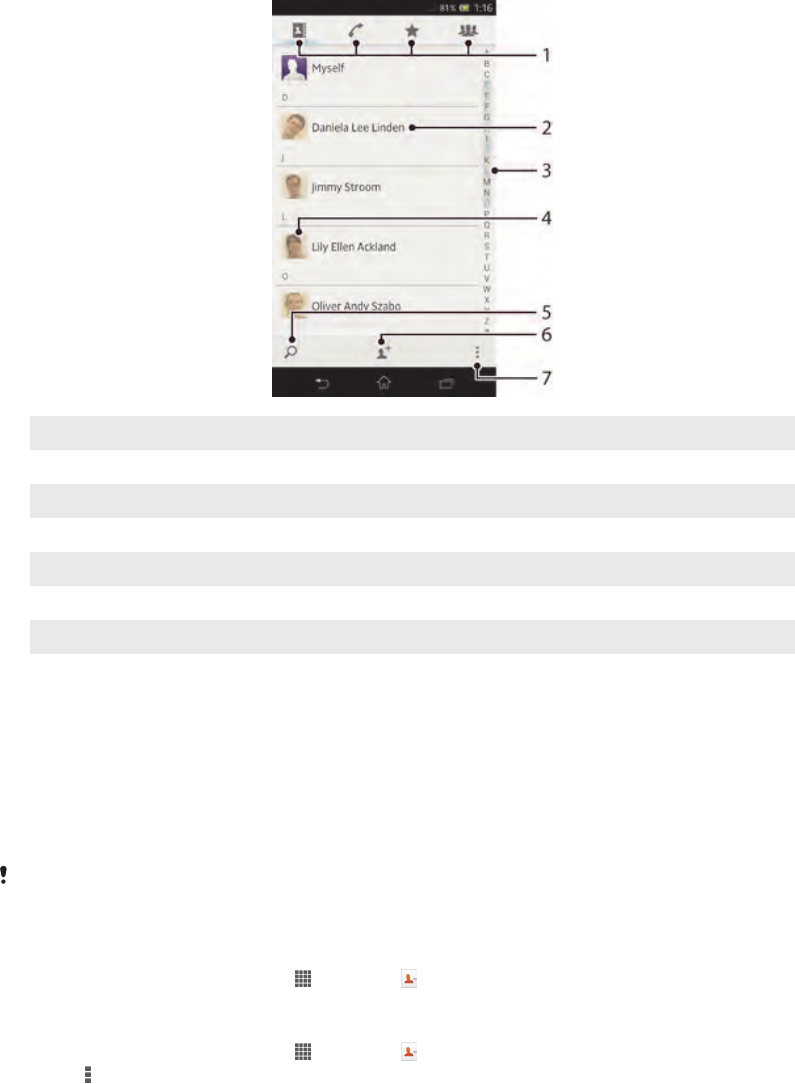
Contacts screen overview
1 Shortcut tabs
2 Tap a contact to view its details
3 Alphabetical index for browsing contacts
4 Tap a contact thumbnail to access the quick contact menu
5 Search for contacts
6 Create a contact
7 Open more options
Managing your contacts
You can create, edit and synchronise your contacts in a few simple steps. You can
select contacts saved in different accounts and manage how you display them on
your device.
If you synchronise your contacts with more than one account, you can join contacts
on your device to avoid duplicates.
Some synchronisation services, for example, some social networking services, do not allow
you to edit contact details.
To view your contacts
•From your Home screen, tap , then tap . Your contacts are listed here.
To select which contacts to display in the Contacts application
1From your Home screen, tap , then tap .
2Press , then tap Filter.
3In the list that appears, mark and unmark the desired options. If you have
synchronised your contacts with a synchronisation account, that account
appears in the list. To further expand the list of options, tap the account.
4When you are finished, tap OK.
46
This is an Internet version of this publication. © Print only for private use.

To add a contact
1From your Home screen, tap , then tap .
2Tap .
3If you have synchronised your contacts with one or more accounts, select the
account to which you want to add this contact, or tap Phone contact if you
only want to use this contact on your device.
4Enter or select the desired information for the contact.
5When you are finished, tap Done.
If you add a plus sign and the country code before a contact's phone number, you do not
have to edit the number again when you make calls from other countries.
To edit a contact
1From the Home screen, tap , then tap .
2Tap the contact you want to edit, then tap .
3Edit the desired information. When you are finished, tap Done.
To associate a picture with a contact
1From your Home screen, tap , then tap .
2Tap the contact you want to edit, then tap .
3Tap and select the desired method for adding the contact picture.
4When you have added the picture, tap Done.
You can also add a picture to a contact directly from the Album application.
To view your communication with a contact
1From the Home screen, tap , then tap .
2Tap the contact you want to view.
3To view your communication with the contact for different media, tap or flick
through the filter items at the bottom of the screen.
To delete contacts
1From your Home screen, tap , then tap .
2Touch and hold the contact you want to delete. To delete all contacts, press ,
then tap Mark several.
3Tap the downwards arrow to open the drop down menu, then select Mark all.
4Tap , then tap OK.
To edit contact information about yourself
1From your Home screen, tap , then tap .
2Tap Myself, then tap .
3Enter the new information or make the changes you want.
4When you are done, tap Done.
Avoiding duplicate entries in the Contacts application
If you synchronise your contacts with a new account or import contact information in
other ways, you could end up with duplicate entries in the Contacts application. If this
happens, you can join such duplicates to create a single entry. And if you join entries
by mistake, you can separate them again later.
To link contacts
1From your Home screen, tap , then tap .
2Tap the contact you want to link with another contact.
3Press , then tap Link contact.
4Tap the contact whose information you want to join with the first contact, then
tap OK to confirm. The information from the first contact is merged with the
second contact, and the first contact is no longer displayed in the Contacts list.
47
This is an Internet version of this publication. © Print only for private use.

To separate linked contacts
1From your Home screen, tap , then tap .
2Tap the linked contact you want to edit, then tap .
3Tap Unlink contact.
4Tap OK.
Favourites
You can mark contacts as favourites so that you can get quick access to them from
the Contacts application.
To mark or unmark a contact as a favourite
1From the Home screen, tap , then tap .
2Tap the contact you want to add to or remove from your favourites.
3Tap .
To view your favourite contacts
1From your Home screen, tap , then tap .
2Tap .
Groups
You can assign contacts to groups to get quicker access to them from within the
Contacts application.
To assign a contact to a group
1In the Contacts application, tap the contact that you want to assign to a group.
2Tap , then tap the bar directly under Assign to group.
3Mark the checkboxes for the groups to which you want to add the contact,
then tap Done.
4Tap Done.
Communicating with your contacts
To search for a contact
1From your Home screen, tap , then tap .
2Tap and enter the first few letters of the contact name in the Search
contacts field. All contacts beginning with those letters appear.
The quick contact menu
Tap a contact's thumbnail to view quick communication options for a particular
contact. Options include calling the contact, sending a text or multimedia message,
and starting a chat using the Google Talk™ application.
For an application to appear as an option in the quick contact menu, you may need to set up
the application in your device and be logged in to the application. For example, you need to
start the Gmail™ application and enter your login details before you can use Gmail™ from the
quick contact menu.
Sharing your contacts
To send your business card
1From your Home screen, tap , then tap .
2Tap Myself.
3Press , then tap Send contact > OK.
4Select an available transfer method and follow the on-screen instructions.
48
This is an Internet version of this publication. © Print only for private use.

To send a contact
1From your Home screen, tap , then tap .
2Tap the contact whose details you want to send.
3Press , then tap Send contact > OK.
4Select an available transfer method and follow the on-screen instructions.
To send several contacts at once
1From your Home screen, tap , then tap .
2Press , then tap Mark several.
3Mark the contacts you want to send, or select all if you want to send all
contacts.
4Tap , then select an available transfer method and follow the on-screen
instructions.
Backing up contacts
You can use a memory card, a SIM card or an online synchronisation tool such as
Microsoft® Exchange ActiveSync® to back up contacts.
To export all contacts to a memory card
1From your Home screen, tap , then tap .
2Press , then tap Back up contacts > Memory Card.
3Tap OK.
To export contacts to a SIM card
1From your Home screen, tap , then tap .
2Press , then tap Back up contacts > SIM card.
3Mark the contacts you want to export, or tap Mark all if you want to export all
your contacts.
4Tap Back up.
5Select Add contacts if you want to add the contacts to existing contacts on
your SIM card, or select Replace all contacts if you want to replace the
existing contacts on your SIM card.
When you export contacts to a SIM card, not all information may get exported. This is due to
memory limitations on SIM cards.
49
This is an Internet version of this publication. © Print only for private use.

Messaging
Using text and multimedia messaging
You can send and receive text messages from your device using SMS (Short
Message Service). If your subscription includes MMS (Multimedia Messaging
Service), you can also send and receive messages that contain media files, for
example, pictures and videos. The number of characters you can send in a single text
message varies depending on the operator and the language you use. If you exceed
the character limit, then all your single messages are linked together and sent as one
message. You are charged for each single text message you send. When you view
your messages, they appear as conversations, which means that all messages to and
from a particular person are grouped together.
To send multimedia messages, you need the correct MMS settings on your device. See
Internet and messaging settings.
To create and send a message
1From your Home screen, tap , then find and tap .
2Tap .
3Tap , then select the desired recipients from the Contacts list. If the recipient
is not listed as a contact, enter the contact's number manually and tap .
4When you are finished adding recipients, tap Done.
5Tap Write message and enter your message text.
6If you want to add a media file, tap and select an option.
7To send the message, tap Send.
If you exit a message before sending, it gets saved as a draft. The conversation gets tagged
with the word Draft:.
To read a received message
1From your Home screen, tap , then find and tap .
2Tap the desired conversation.
3If the message is not yet downloaded, tap and hold the message, then tap
Download message.
You can also open messages from the status bar when appears there. Just drag down the
bar and tap the message.
To reply to a message
1From your Home screen, tap , then find and tap .
2Tap the conversation containing the message.
3Enter your reply and tap Send.
To forward a message
1From your Home screen, tap , then find and tap .
2Tap the conversation containing the message you want to forward.
3Touch and hold the message you want to forward, then tap Forward message.
4Tap , then select a recipient from the Contacts list. If the recipient is not
listed as a contact, enter the contact's number manually and tap .
5When you are finished adding recipients, tap Done.
6Edit the message, if necessary, and tap Send.
In step 4, you can also tap To and enter the recipient's phone number manually.
To delete a message
1From your Home screen, tap , then find and tap .
2Tap the conversation containing the message you want to delete.
3Touch and hold the message you want to delete, then tap Delete message >
Delete.
50
This is an Internet version of this publication. © Print only for private use.

To delete conversations
1From your Home screen, tap , then find and tap .
2Tap , then tap Delete conversations.
3Mark the checkboxes for the conversations that you want to delete, then tap
> Delete.
To save a sender's number
1From your Home screen, tap , then find and tap .
2Tap > Save.
3Select an existing contact, or tap Create new contact.
4Edit the contact information and tap Done.
To call a message sender
1From your Home screen, tap , then find and tap .
2Tap a conversation.
3Tap the recipient name or number at the top of the screen, then select the
recipient name or number from the list that appears.
4If the recipient is saved in your contacts, tap the phone number that you want
to call. If you have not saved the recipient in your contacts, tap .
To save a file contained in a message you receive
1From your Home screen, tap , then find and tap .
2Tap the conversation you want to open.
3If the message has not been downloaded yet, tap and hold the message, then
tap Download message.
4Touch and hold the file you want to save, then select the desired option.
To star a message
1From your Home screen, tap , then find and tap .
2Tap the conversation you want to open.
3In the message you want to star, tap .
4To unstar a message, tap .
To view starred messages
1From your Home screen, tap , then find and tap .
2Tap , then tap Starred messages.
3All starred messages appear in a list.
To search for messages
1From your Home screen, tap , then find and tap .
2Tap , then tap Search.
3Enter your search keywords, then tap the confirm key.
Text and multimedia message options
To change your message notification settings
1From your Home screen, tap , then find and tap .
2Tap , then tap Settings.
3To set a notification sound, tap Notification tone and select an option.
4For other notification settings, check or uncheck the relevant checkboxes.
To change the delivery report settings for outgoing messages
1From your Home screen, tap , then find and tap .
2Tap , then tap Settings.
3Tap Delivery report to activate or deactivate delivery reports.
To view messages saved on the SIM card
1From your Home screen, tap , then find and tap .
2Tap , then tap Settings > SIM messages.
51
This is an Internet version of this publication. © Print only for private use.

Google Talk™
The Google Talk™ application lets you chat with your friends using text, voice and
video.
To start Google Talk™
1From your Home screen, tap .
2Find and tap Talk.
To reply to an instant message with Google Talk™
1When someone contacts you on Google Talk™, appears in the status bar.
2Drag the status bar downwards, then tap the message and begin to chat.
52
This is an Internet version of this publication. © Print only for private use.

Email
Getting started with Email
You can handle several email accounts at the same time using the Email application,
including corporate Microsoft Exchange Active Sync accounts. Emails you receive to
your Gmail™ account can be accessed on your device from both the Email and the
Gmail™ applications.
Using email accounts
To set up an email account on your device
1From your Home screen, tap .
2Find and tap Email.
3Follow the instructions that appear on the screen to complete the setup.
For some email services, you may need to contact your email service provider for information
on detailed settings for the email account.
To set an email account as your default account
1From your Home screen, tap .
2Find and tap Email.
3Press , then tap Settings.
4Select the account you want to use as the default account for composing and
sending emails.
5Mark the Default account checkbox. The inbox of the default account appears
every time you open the email application.
If you only have one email account, this account is automatically the default account.
To add an extra email account on your device
1From your Home screen, tap .
2Find and tap Email.
3Tap at the top of the screen, then tap Add account.
4Enter the email address and password, then tap Next. If the settings for the
email account cannot be downloaded automatically, complete the setup
manually.
5When prompted, enter a name for your email account so that it is easily
identifiable. The same name shows in the emails you send from this account.
6When you are finished, tap Next.
To remove an email account from your device
1From your Home screen, tap .
2Find and tap Email.
3Press , then tap Settings.
4Select the account you want to remove.
5Tap Delete account > OK.
Gmail™ and other Google™ services
If you have a Google™ account, you can use the Gmail™ application on your device
to read, write and organise email messages. After you set up your Google™ account
to work on your device, you can also chat to friends using the Google Talk™
application, synchronise your calendar application with your Google Calendar™, and
download applications and games from Google Play™.
The services and features described in this chapter may not be supported in all countries or
regions, or by all networks and/or service providers in all areas.
53
This is an Internet version of this publication. © Print only for private use.

To set up a Google™ account on your device
1From your Home screen, tap .
2Find and tap Settings > Add account > Google.
3Follow the registration wizard to create a Google™ account, or sign in if you
already have an account.
You can also sign in to or create a Google™ account from the setup guide the first time you
start your device. Or you can go online and create an account at www.google.com/accounts.
To open the Gmail™ application
1From the Home screen, tap .
2Find and tap Gmail .
Using email
To create and send an email message
1Make sure that you have set up an email account.
2From your Home screen, tap , then find and tap Email.
3If you are using several email accounts, tap at the top of the screen and
select the account that you want to use.
4Tap , then tap To and start typing the recipient's name or email address, or
tap and select one or more recipients from your Contacts list.
5Enter the email subject and message text, then tap .
To receive email messages
1From your Home screen, tap .
2Find and tap Email.
3If you are using several email accounts, tap at the top of the screen and
select the account that you want to check. If you want to check all your email
accounts at once, tap Combined view.
4To download new messages, tap .
If you have set up a corporate email account, you can set the check frequency to Automatic
(Push).
To read your email messages
1From your Home screen, tap .
2Find and tap Email.
3If you are using several email accounts, tap at the top of the screen and
select the account you want to check. If you want to check all your email
accounts at once, tap Combined view.
4In the email inbox, scroll up or down and tap the email you want to read.
To use the email preview pane
1From your Home screen, tap , then find and tap Email.
2If you are using several email accounts, tap and select the account you want
to check. If you want to check all your email accounts at once, tap Combined
view.
3Hold your device horizontally. The email preview pane appears.
4Scroll up or down in the email inbox and tap the email you want to read. The
email opens in the preview pane. To view more information about the email,
tap the downward arrow next to the sender's name. In the body text field,
pinch two fingers together, or spread them apart, to zoom out or in.
5To view the email in fullscreen format, tap the split bar (located between the
email list and email body) accordingly. In fullscreen format, use the leftward
and rightward arrows to read your previous or next message.
6To return to the inbox view, tap the split bar accordingly.
Before using the preview pane, activate it in the preview pane settings.
To hide the preview pane, hold your device vertically, or change the preview pane settings.
54
This is an Internet version of this publication. © Print only for private use.

To change email preview pane settings
1From your Home screen, tap , then find and tap Email.
2Press , then tap Settings.
3Tap General > Preview pane, then select an option.
To view an email message attachment
1From your Home screen, tap .
2Find and tap Email.
3Find and tap the email message containing the attachment that you want to
view. Emails with attachments are indicated by .
4After the email message opens, tap , then tap View.
To save a sender's email address to your contacts
1From your Home screen, tap .
2Find and tap Email.
3Find and tap a message in your email inbox.
4Tap the name of the sender, then tap OK.
5Select an existing contact, or tap Create new contact.
6Edit the contact information, if desired, then tap Done.
To reply to an email message
1From your Home screen, tap .
2Find and tap Email.
3In your email inbox, find and tap the message you want to reply to, then tap .
4Tap Reply or Reply all.
5Enter your reply, then tap .
To forward an email message
1From your Home screen, tap .
2Find and tap Email.
3In your email inbox, find and tap the message you want to forward, then tap .
4Tap Forward.
5Tap To and enter the recipient's email address manually, or tap to select a
recipient from your contacts.
6Enter your message text, then tap .
To delete an email message
1From your Home screen, tap .
2Find and tap Email.
3In your email inbox, find and tap the message you want to delete, then tap .
4Tap Yes.
To sort your emails
1From your Home screen, tap .
2Find and tap Email.
3If you are using several email accounts, tap at the top of the screen and
select the account that you want to check. If you want to check all your email
accounts at once, tap Combined view.
4Press , then tap Sort.
5Select a sorting option.
To search for emails
1From your Home screen, tap , then find and tap Email.
2Tap at the top of the screen and select the account that you want to search.
3Tap .
4Enter your search text, then tap Go on your keyboard.
5The search result appears in a list sorted by date. Tap the email that you want
to open.
To change search options, tap and select a different option.
55
This is an Internet version of this publication. © Print only for private use.

To view all folders for one email account
1From your Home screen, tap . Then find and tap Email.
2Tap at the top of the screen and select the account you want to check, then
tap again and select Show all folders to view all the folders in this account.
To change the inbox check frequency
1From your Home screen, tap .
2Find and tap Email.
3Press , then tap Settings.
4Select the account for which you want to change the inbox check frequency.
5Tap Inbox check frequency and select an option.
To set an Out of Office auto-reply in an Exchange Active Sync account
1From your Home screen, tap , then find and tap Email.
2Press , then tap Settings.
3Select the EAS (Exchange Active Sync) account for which you want to set an
Out of Office auto-reply.
4Tap Out of office.
5Tap beside Out of office so that changes to .
6If needed, mark the Set time range checkbox and set the time range for the
auto reply.
7Enter your Out of Office message in the body text field.
8Tap OK to confirm.
56
This is an Internet version of this publication. © Print only for private use.

Socialife™
Using the Socialife™ application
Use the Socialife™ application from Sony to get your favourite news, videos and
social networking feeds in one place. The Socialife™ home screen gives a clear
overview of friends’ Facebook and Twitter activity, plus news feeds that you have
subscribed to. It colour-codes and sizes articles for easy reading, adding photos and
cropping images of your friends’ faces to illustrate each story.
The Socialife™ application is not available in all markets.
To open the Socialife™ application
1From your Home screen, tap .
2Find and tap .
57
This is an Internet version of this publication. © Print only for private use.
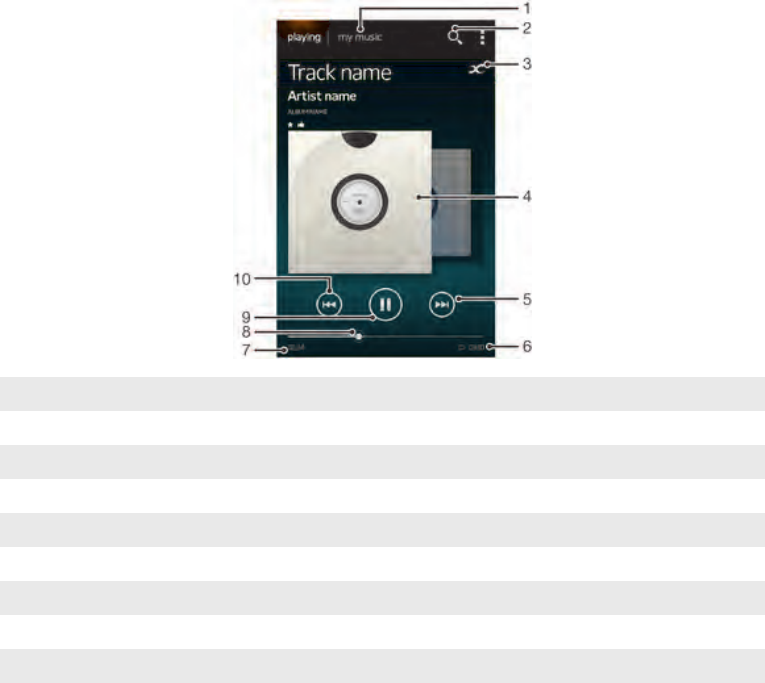
"WALKMAN" application
About the "WALKMAN" application
Get the most out of your "WALKMAN" application. Listen to and organise music and
audio books that you have transferred to your device from a computer, or purchased
and downloaded from online stores.
To make content easily available to the "WALKMAN" application, you can use the
Media Go™ application. Media Go™ helps transfer music content between a
computer and your device. For more information, see Connecting your device to a
computer on page 104.
"WALKMAN" application overview
1Browse your music
2 Search all tracks saved on your device
3 Tap the infinite button to find related information online and plug-ins on Google Play™
4 Album art (if available)
5 Go to the next track in the current play queue, or fast forward
6 Total time length of the track
7 Elapsed time of current track
8 Progress indicator – drag the indicator or tap along the line to fast forward or rewind
9 Play/Pause button
10 Go to the previous track in the current play queue, or rewind
Transferring media files to your device
Before using the "WALKMAN" application, it's a good idea to transfer all your
favourite media content from a computer to your device and then play or view this
content on your device. Media content can include music, photos and videos. The
easiest way to transfer files is with a USB cable. After you connect your device and
the computer using the USB cable, you can use the file manager application on the
computer or the Media Go™ application to transfer the files.
58
This is an Internet version of this publication. © Print only for private use.

Using the "WALKMAN" application
To play audio content
1From your Home screen, tap , then find and tap .
2In My music, select a music category and browse to the track that you want to
open.
3Tap a track to play it.
You might not be able to play copyright-protected items. Please verify that you have
necessary rights in material that you intend to share.
To change tracks
•When a track is playing, tap or .
•When a track is playing, swipe the album art left or right.
To pause a track
•Tap .
To fast forward and rewind music
•Touch and hold or .
You can also drag the progress indicator marker right or left.
To adjust the audio volume
•Press the volume key.
To improve the sound quality using the equaliser
1When the "WALKMAN" application is open, tap .
2Tap Settings > Sound enhancements.
3To adjust the sound manually, drag the frequency band buttons up or down.
To adjust the sound automatically, tap and select a style.
To turn on the surround sound feature
1When the "WALKMAN" application is open, tap .
2Tap Settings > Sound enhancements > Settings > Surround sound (VPT).
3Select a setting, then tap OK to confirm.
To view the current play queue
1While a track is playing in the "WALKMAN" application, tap .
2Tap Play queue.
To minimise the "WALKMAN" application
•When the "WALKMAN" application is playing, tap to go to the previous
screen, or tap to go to the Home screen. The "WALKMAN" application
stays playing in the background.
To open the "WALKMAN" application when it is playing in the background
1While a track is playing in the background, drag the status bar downwards to
open the Notification panel.
2Tap the track title to open the "WALKMAN" application.
Alternatively, you can press and then select the "WALKMAN" application.
To delete a track
1In My music, browse to the track that you want to delete.
2Touch and hold the track title, then tap Delete.
You can also delete albums this way.
59
This is an Internet version of this publication. © Print only for private use.

To send a track
1In My music, when browsing your tracks , touch and hold a track title.
2Tap Send.
3Select an application from the list, and follow the on-screen instructions.
You can also send albums and playlists in the same way.
To "Like" a track on Facebook™
1While the track is playing in the "WALKMAN" application, tap the album art.
2Tap to show that you "Like" the track on Facebook™. If desired, add a
comment in the comments field.
3Tap Share to send the track to Facebook™. If the track is received
successfully, you will get a confirmation message from Facebook™.
Visualiser
The Visualiser adds visual effects to your music tracks as you play them. The effects
for each track are based on the characteristics of the music. They change, for
example, in response to changes in the music’s loudness, rhythm and frequency
level. You can also change the background theme.
To turn on the Visualiser
1In the "WALKMAN" application, tap .
2Tap Visualiser.
Tap to switch to full screen view.
To change the background theme
1In the "WALKMAN" application, tap .
2Tap Visualiser.
3Tap > Theme and select a theme.
Getting more information about a track or artist
In the "WALKMAN" application, you can get more information about the artist that
you are listening to by tapping the infinite button .
The infinite button also gives you access to related content such as:
•Music videos on YouTube™
•Artist info on Wikipedia
•Lyrics on Google
•Karaoke videos on YouTube™
•Extension searches on the web
•Content from the PlayNow™ service
The accuracy of search results may vary.
To get more information about an artist or track
•When a track is playing in the "WALKMAN" application, tap .
Using My music to organise your tracks
Tap the My music tab in the "WALKMAN" application to get an overview of all the
tracks that are available from your device. In My music, you can manage your albums
and playlists, create shortcuts, and arrange your music by mood and tempo.
60
This is an Internet version of this publication. © Print only for private use.

Overview of My music
1 Go back to the current track
2 Picture of the currently playing artist (if available)
3 Browse your music by artist
4 Categorise your music using SensMe™ channels
5 Manage and edit your music using Music Unlimited™
6 Browse your favourite playlists
7 Collect links to music and related content that you and friends have shared using online services
8 Browse all playlists
9 Browse audio by track
10 Browse by album
To add a shortcut to a track
1In My music, tap , , or , then browse to the track for which you want to
create a shortcut.
2Touch and hold the track title.
3Tap Add as shortcut. The shortcut now appears in the My music main view.
To rearrange shortcuts
•In My music, touch and hold a shortcut until it magnifies and your device
vibrates, then drag the item to a new location.
To delete a shortcut
•In My music, touch and hold a shortcut until it magnifies and your device
vibrates, then drag the item to .
You can only delete shortcuts that you create yourself.
To update your music with the latest information
1In My music, tap .
2Tap Download music info > Start. Your device searches online and downloads
the latest available album art and track information for your music.
The SensMe™ channels application is activated when you download music information.
61
This is an Internet version of this publication. © Print only for private use.

Categorising your music using SensMe™ channels
The SensMe™ channels application helps you arrange your music by mood and
tempo. SensMe™ groups all your tracks into several categories, or channels, so you
can select music that matches your mood or suits the time of day.
To enable the SensMe™ channels application
•In My music, tap , then tap Download music info.
This application requires a mobile or Wi-Fi® network connection.
Using the Friends' music function to share music
The Friends’ music function collects links to music and music-related content that
you and your friends have shared using Facebook™.
To manage music from your friends
1In My music, tap Friends' music > Recent.
2Tap an item to open it, then work on it as desired.
3Tap to show that you "Like" the track on Facebook™. If desired, add a
comment in the comments field.
To view your shared music
1In My music, tap Friends' music > My shares.
2Scroll to an item you want to open, then tap it. All comments about the item, if
any, are displayed.
Playing music in random order
You can play tracks in playlists in random order. A playlist can be, for example, a
playlist you have created yourself or an album.
To play tracks in random order
1In My music, tap and navigate to an album, or tap and browse to a
playlist.
2Tap the album art, then tap to turn on Shuffle mode.
To turn off shuffle mode
•When tracks are playing in random order, tap the album art > .
Managing playlists
In My music, you can create your own playlists from the music that is saved on your
device.
In addition, you can install the Media Go™ application on a computer and use it to
copy playlists from the computer to your device.
To create your own playlists
1In the WALKMAN player, tap the MY MUSIC tab.
2Tap Playlists.
3In the menu that opens, tap Create new playlist.
4Enter a name for the playlist and tap OK.
5Select your music and tap the Save icon at the top right of the screen.
To add tracks to a playlist
1In My music, when browsing your tracks, touch and hold the name of the artist
or the title of the album or track that you want to add.
2Tap Add to playlist.
3Tap the name of the playlist to which you want to add the artist, album or
track. The artist, album or track is added to the playlist.
62
This is an Internet version of this publication. © Print only for private use.

To play your own playlists
1In My music, tap .
2Under Playlists, tap a playlist.
3Tap a track to play it.
To remove a track from a playlist
1In a playlist, touch and hold the title of the track you want to delete.
2Tap Delete from playlist from the list that appears.
To delete a playlist
1In My music, then select Playlists.
2Touch and hold the playlist you want to delete.
3Tap Delete.
4Tap Delete again to confirm.
You cannot delete default playlists.
"WALKMAN" application widget
The "WALKMAN" application widget is a miniature application that gives you direct
access to the "WALKMAN" application from your Home screen. You need to add this
widget to your Home screen before you can use it.
To add the "WALKMAN" application widget to your Home screen
1Tap an empty area on your Home screen, then tap Widgets.
2Find and tap WALKMAN.
Protecting your hearing
Listening to the "WALKMAN" application or other media players at excessive volume
or for a prolonged period of time can damage your hearing, even when the volume is
at a moderate level. To alert you to such risks, a volume level warning appears when
the volume is too high, and after the "WALKMAN" application is used for over 20
hours.
To turn off the volume level warning
•When appears, tap OK to dismiss the warning.
Every time you restart your device, the media volume is automatically set to a moderate level.
63
This is an Internet version of this publication. © Print only for private use.

Music services
TrackID™ technology
Identifying music using TrackID™ technology
Use the TrackID™ music recognition service to identify a music track you hear
playing in your surroundings. Just record a short sample of the song and you’ll get
artist, title and album info within seconds. You can purchase tracks identified by
TrackID™ and you can view TrackID™ charts to see what TrackID™ users around
the globe are searching for. For best results, use TrackID™ technology in a quiet
area.
The TrackID™ application and the TrackID™ service are not supported in all countries/regions,
or by all networks and/or service providers in all areas.
To open the TrackID™ application
1From your Home screen, tap .
2Find and tap TrackID™.
You can also use the TrackID™ widget to open the TrackID™ application.
To search for track information using TrackID™
1Open the TrackID™ application, then hold your device towards the music
source.
2Tap . If the track is recognised by the TrackID™ service, the results appear
on the screen.
To return to the TrackID™ start screen, press .
To view TrackID™ charts
1Open the TrackID™ application, then tap Charts. The first time you view a
chart, it is set to your own region.
2To see charts of the most popular searches in other regions, tap > Regions.
3Select a country or region.
Using TrackID™ technology results
Track information appears when the TrackID™ application recognises a track. You
can select to purchase the track or share it using email, SMS or a social networking
service. You can also get more information about the track's artist.
To buy a track recognised by the TrackID™ application
1After a track has been recognised by the TrackID™ application, tap Download.
2Follow the instructions on your device to complete your purchase.
You can also select a track to buy by opening the History or Charts tabs from the TrackID™
start screen.
The track purchase feature may not be supported in all countries/regions, or by all networks
and/or service providers in all areas.
To share a track
1After a track has been recognised by the TrackID™ application, tap Share,
then select a sharing method.
2Follow the instructions on your device to complete the procedure.
You can also select a track to share by opening the History or Charts tabs from the TrackID™
start screen.
64
This is an Internet version of this publication. © Print only for private use.

To view the artist information for a track
•After a track has been recognised by the TrackID™ application, tap Artist info.
You can also view the artist information for a track by opening the History or Charts tabs from
the TrackID™ start screen.
To delete a track from the track history
1Open the TrackID™ application, then tap History.
2Tap a track title, then tap Delete.
3Tap Yes to confirm.
Music Unlimited™
Using Music Unlimited™
Music Unlimited™ is a subscription-based service that offers access to millions of
songs over a mobile network or Wi-Fi® connection. You can manage and edit your
personal music library in the cloud from a variety of devices, or sync your playlists
and music using a PC that runs the Windows® operating system. Go to
www.sonyentertainmentnetwork.com for more information.
Music Unlimited™ might not be available in all countries or regions.
To open Music Unlimited™
1From your Home screen, tap .
2Find and tap .
About the PlayNow™ service
You can use the PlayNow™ service to download applications, music, games,
ringtones and wallpapers. The PlayNow™ service offers both free and non-free
downloads. Note that payment options for non-free applications may vary per
country.
The PlayNow™ service is not available in all countries.
Before you download content
Before you download, make sure that you have an Internet connection. Also, you may
need to have a memory card inserted in your device to download content.
When you download content to your device, you might be charged for the amount of data
transferred. Contact your operator for information about data transfer rates in your country.
To start PlayNow™
1From the Home screen, tap .
2Find and tap .
Downloading from the PlayNow™ service
Download a range of content from the PlayNow™ service direct to your device.
Choose from a variety of applications, games, music, ringtones and other content.
Note that payment options for non-free applications may vary per country.
65
This is an Internet version of this publication. © Print only for private use.

To download a PlayNow item to your device
1From your Home screen, tap .
2Find and tap PlayNow™.
3Find an item you want to download by browsing categories, or by using the
search function.
4Tap the item to view its details.
5Click “Buy now!” to start the purchase process. After your purchase has been
validated, you can start to download your content.
66
This is an Internet version of this publication. © Print only for private use.
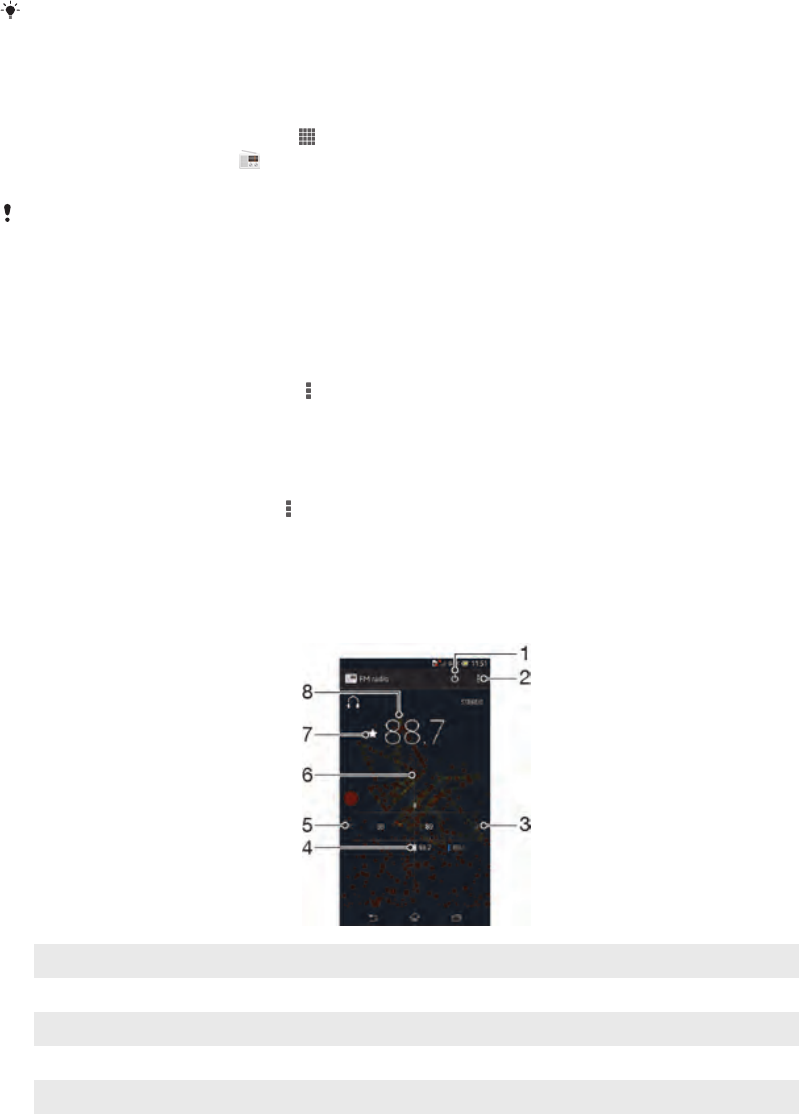
FM radio
About the FM radio
The FM radio in your device works like any FM radio. For example, you can browse
and listen to FM radio stations and save them as favourites. You must connect a
wired headset or headphones to your device before you can use the radio. This is
because the headset or headphones act as an antenna. After one of these devices is
connected, you can then switch the radio sound to the speaker, if desired.
When you open the FM radio, available channels appear automatically. If a channel has RDS
information, it appears a few seconds after you start listening to the channel.
To start the FM radio
1Connect a headset or a set of headphones to your device.
2From your Home screen, tap .
3Find and tap FM radio . The available channels appear as you scroll through
the frequency band.
When you start the FM radio, available channels appear automatically. If a channel has RDS
information, it appears a few seconds after you start listening to the channel.
To move between radio channels
•Flick your finger up or down along the frequency band.
To select the radio region
1When the radio is open, press .
2Tap Set radio region.
3Select an option.
To adjust the visualizer
1When the radio is open, tap .
2Tap Visualiser.
3Select an option.
FM radio overview
1Radio on/off button
2 View menu options
3 Move up the frequency band to search for a channel
4 A saved favourite channel
5 Move down the frequency band to search for a channel
6 Tuning dial
67
This is an Internet version of this publication. © Print only for private use.

7 Save or remove a channel as a favourite
8 Tuned frequency
Using your favourite radio channels
You can save the radio channels you most frequently listen to as favourites. By using
favourites you can quickly return to a radio channel.
To save a channel as a favourite
1When the radio is open, navigate to the channel that you want to save as a
favourite.
2Tap .
3Enter a name and select a colour for the channel, then press Save.
To remove a channel as a favourite
1When the radio is open, navigate to the channel that you want to remove.
2Tap , then tap Delete.
Making a new search for radio channels
If you have moved to a new location or the reception has improved in your current
location, you can start a new scan for radio channels.
Any favourites you have saved are not affected by a new scan.
To start a new search for radio channels
1When the radio is open, press .
2Tap Search for channels. The radio scans the whole frequency band, and all
available channels are displayed.
Sound settings
Switching the radio sound between devices
You can listen to the radio through a wired headset or through wired headphones.
Once either device is connected, you can switch the sound to the speaker, if desired.
To switch the radio sound to the speaker
1When the radio is open, press .
2Tap Play in speaker.
To switch the sound back to the wired headset or headphones, press and tap Play in
headphones.
Switching between mono and stereo sound mode
You can listen to your FM radio in either mono or stereo mode. In some situations,
switching to mono mode can reduce noise and improve sound quality.
To switch between mono and stereo sound mode
1When the radio is open, press .
2Tap Enable stereo sound.
3To listen to the radio in mono sound mode again, press and tap Force mono
sound.
Identifying radio tracks using TrackID™
Use TrackID™ technology to identify music tracks as they play on your device's FM
radio.
68
This is an Internet version of this publication. © Print only for private use.

To identify a song on the FM radio using TrackID™
1While the song is playing on your device's FM radio, tap TrackID™.
2A progress indicator appears while the TrackID™ application samples the
song. If successful, you are presented with a track result or a list of possible
tracks.
3Press to return to the FM Radio.
The TrackID™ application and the TrackID™ service are not supported in all countries/regions,
or by all networks and/or service providers in all areas.
69
This is an Internet version of this publication. © Print only for private use.
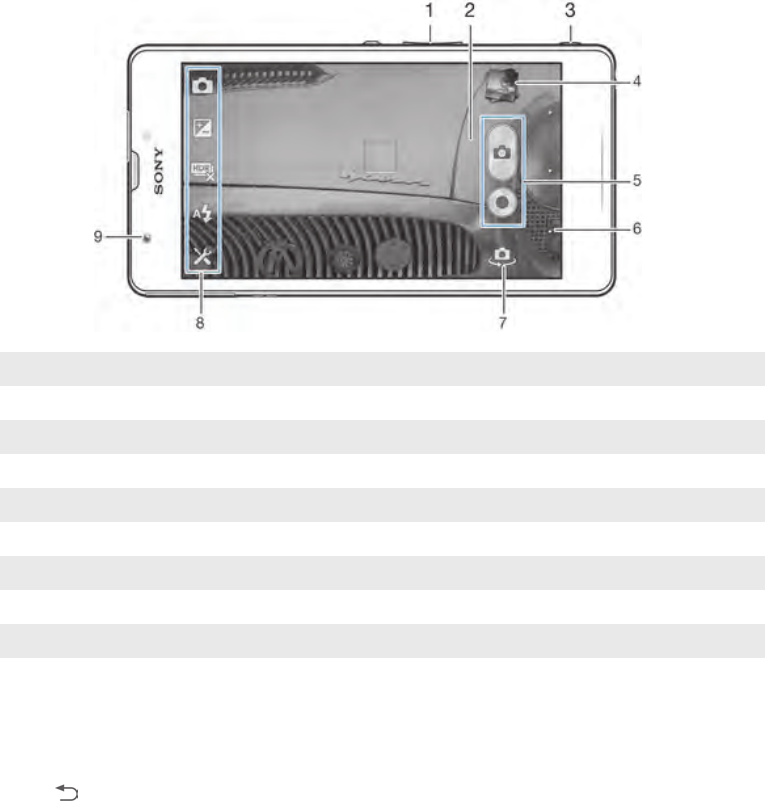
Camera
About the camera
The camera in your device is equipped with the highly sensitive Exmor R sensor,
which helps you capture sharp photos and videos even in low lighting conditions.
From the camera, you can, for example, send your photos and videos to friends as
messages, or upload them to a web service. Your device also has a front camera,
which is useful for self-portraits.
Camera controls overview
1Zoom in or out
2 Main camera screen
3 Camera key – Activate the camera/Take photos/Record videos
4 View photos and videos
5 Take photos or record video clips
6 Go back a step or exit the camera
7 Switch between front and main camera
8 Camera setting icons
9 Front camera
To open the camera
•When the screen is active, press and hold down the camera key.
To close the camera
•Press from the main camera screen.
Using the still camera
There are three ways to take photos with the still camera. You can press the camera
key, tap the on-screen camera button, or touch a spot on the screen.
To take a photo using the camera key
1Activate the camera.
2Press the camera key fully down.
70
This is an Internet version of this publication. © Print only for private use.

To take a photo by tapping the on-screen camera button
1Activate the camera.
2Point the camera towards the subject.
3Tap the on-screen camera button . The photo is taken as soon as you release
your finger.
To take a self-portrait using the front camera
1Activate the camera.
2Tap the icon on the top left of the screen, then find and select Front camera.
3To take the photo, press the camera key. The photo is taken as soon as you
release your finger.
To use the zoom function
•When the camera is open, press the volume key up or down to zoom in or out.
To use the still camera flash
1When the camera is open, tap .
2Tap Flash, and select your desired flash setting.
3Take the photo.
To view your photos and videos
1Open the camera, then tap a thumbnail at the top right of the screen to open a
photo or video.
2Flick left or right to view your photos and videos. Videos are identified by .
To delete a photo
1Open the photo that you want to delete.
2Tap an empty area of the screen to make appear.
3Tap .
4Tap OK to confirm.
Face detection
You can use face detection to bring an off-centre face into focus. The camera
automatically detects up to five faces, indicated by white frames. A yellow frame
shows which face has been selected for focus. Focus is set to the face closest to the
camera. You can also tap one of the frames to select which face should be in focus.
To turn on face detection
1Activate the camera.
2Tap the icon on the top left of the screen, then select Normal.
3To display all settings, tap .
4Tap Focus mode > Face detection.
To take a photo using face detection
1When the camera is open and Face detection turned on, point the camera at
your subject. Up to five faces can be detected, and each detected face is
framed.
2Press the camera key halfway down. A yellow frame shows which face is in
focus.
3To take the photo, press the camera key fully down.
Using Smile Shutter™ to capture smiling faces
Use Smile Shutter™ technology to photograph a face just as it smiles. The camera
detects up to five faces and selects one face for smile detection and auto focus.
When the selected face smiles, the camera automatically takes a photo.
71
This is an Internet version of this publication. © Print only for private use.

To turn on Smile Shutter™
1Activate the camera.
2To display all settings, tap .
3Tap Smile Shutter and select a smile level.
To take a photo using Smile Shutter™
1When the camera is open and Smile Shutter is turned on, point the camera at
your subject. The camera selects which face to focus on.
2The face selected appears inside a green frame and the photo is taken
automatically.
3If no smile is detected, press the camera key to take the photo manually.
Adding the geographical position to your photos
Turn on geotagging to add the approximate geographical location (a geotag) to
photos when you take them. The geographical location is determined either by
wireless networks (mobile or Wi-Fi® networks) or GPS technology.
When appears on the camera screen, geotagging is turned on but the
geographical position has not been found. When appears, geotagging is turned on
and the geographical location is available, so your photo can get geotagged. When
neither of these two symbols appears, geotagging is turned off.
To turn on geotagging
1Activate the camera.
2Tap , then tap Geotagging > On.
3Tap OK to agree to enable GPS and/or wireless networks.
4Check the options that you want to select under Location services.
5After you confirm your settings, press to return to the camera screen.
6If appears on the camera screen, your location is available and your photo
can get geotagged. If not, check your GPS and/or wireless network
connection.
Using still camera settings
To adjust the still camera settings
1Activate the camera.
2To display all settings, tap .
3Select the setting that you want to adjust, then edit as desired.
To customise the still camera settings panel
1When the camera is open, tap to display all settings.
2Touch and hold the setting you want to move and drag it to the desired
position.
If you drag the setting outside of the settings panel, the change is cancelled.
Still camera settings overview
Superior auto
Optimise your settings to suit any scene.
Burst
Use the Burst speed shooting mode to capture several photos in quick succession by keeping
your finger pressed on the shutter button. You can choose between three burst speeds, which
come with different resolution levels, that is, different picture sizes.
Normal
Front camera
Select the front camera if you want to take self-portrait photos.
72
This is an Internet version of this publication. © Print only for private use.

Picture effect
Apply effects to photos.
Scene selection
Use a pre-programmed scene type to quickly set the camera for common situations.
Sweep Panorama
Use this setting to take wide-angle, panoramic photos. Just press the camera key and move the
camera steadily from one side to the other.
Resolution
Choose between several picture sizes and aspect ratios before taking a photo. A
photo with a higher resolution requires more memory.
13 MP 4:3
13 megapixel picture size with 4:3 aspect ratio. Suitable for photos you want to view on non-
widescreen displays or print in high resolution. 13MP is available in the following conditions: select
Normal capturing mode and HDR is off; select Scene mode except in Backlight Correction HDR
mode.
12 MP 4:3
12 megapixel picture size with 4:3 aspect ratio. Suitable for photos you want to view on non-
widescreen displays or print in high resolution. 12MP is maximum resoluted in Superior Auto mode.
9 MP 16:9
9 megapixel picture size with 16:9 aspect ratio. A high resolution widescreen format. Has a higher
resolution than full HD. Suitable for photos you want to view on widescreen displays.
5MP 4:3
5 megapixel picture size with 4:3 aspect ratio. Suitable for photos you want to view on non-
widescreen displays or print in high resolution.
2MP 16:9
2 megapixel picture size with 16:9 aspect ratio. Suitable for photos you want to view on widescreen
displays.
VGA
VGA format with 4:3 aspect ratio. 640x480 pixels.
12 MP is the maximum resolution available when photos are taken using Superior auto mode;
when HDR is turned on in Normal mode; or when Scenes (Backlight correction HDR mode)
mode is selected.
The 13 MP resolution is only available when Normal capturing mode is selected and HDR is
turned off, and when Scenes mode is selected (except in Backlight correction HDR mode).
Flash
Use the flash to take photos when lighting conditions are poor or when there is a
backlight.
Auto
The camera automatically determines if the lighting conditions require the use of a flash.
Fill flash
Use this setting when the background is brighter than the subject. This removes unwanted dark
shadows.
Off
The flash is turned off. Sometimes photo quality can be better without the flash, even if lighting
conditions are poor. Taking a good photo without using the flash requires a steady hand. Use the
self-timer to avoid blurred photos.
Red-eye reduction
Reduces the red colour of eyes when taking a photo.
Self-timer
With the self-timer you can take a photo without holding the device. Use this function
to take self-portraits, or group photos where everyone can be in the photo. You can
also use the self-timer to avoid shaking the camera when taking photos.
73
This is an Internet version of this publication. © Print only for private use.

On (10 s.)
Set a 10-second delay from when you tap the camera screen until the photo is taken.
On (2 s.)
Set a 2-second delay from when you tap the camera screen until the photo is taken.
Off
The photo is taken as soon as you tap the camera screen.
Smile Shutter™
Use the smile shutter function to determine what kind of smile the camera reacts to
before taking a photo.
Quick launch
Use Quick launch settings to launch the camera from the lock screen. If the device is
in sleep mode of camera, press the camera key.
Launch and capture
By pressing and holding down the camera key, the first photo is captured immediately after the
camera is launched from sleep mode.
Launch only (still camera)
By pressing and holding down the camera key, the still camera is launched from sleep mode.
Launch and record video
By pressing and holding down the camera key, the first video is shot immediately after the camera
video camera is launched from sleep mode.
Launch only (video camera)
By pressing and holding down the camera key, the video camera is launched from sleep mode.
Off
Focus mode
The focus function controls which part of a photo should be sharp. When continuous
autofocus is on, the camera keeps adjusting focus so that the area within the yellow
focus frame stays sharp.
Single auto focus
The camera automatically focuses on the selected subject. Continuous autofocus is on. Touch and
hold the camera screen until the yellow focus frame turns blue, indicating that the focus is set. The
photo is taken when you release your finger.
Multi auto focus
The focus is automatically set on several areas of the image. Touch and hold the camera screen
until the yellow focus frame turns blue, indicating that the focus is set. The photo is taken when you
release your finger. Continuous autofocus is off.
Face detection
The camera automatically detects up to five human faces, indicated by frames on the screen. The
camera automatically focuses on the nearest face. You can also select which face to focus on by
tapping it on the screen. When you tap the camera screen, a blue frame shows which face is
selected and in focus. Face detection cannot be used for all scene types. Continuous autofocus is
on.
Touch focus
Touch a specific area on the camera screen to set the area of focus. Continuous autofocus is off.
Touch and hold the camera screen until the yellow focus frame turns blue, indicating that the focus
is set. The photo is taken when you release your finger.
Object tracking
When you select an object by touching it in the viewfinder, the camera tracks it for you.
This setting is only available in Normal capturing mode.
Exposure value
74
This is an Internet version of this publication. © Print only for private use.

Determine the amount of light in the photo you want to take. A higher value indicates an increased
amount of light.
This setting is only available in Normal capturing mode.
HDR
Use the HDR (High Dynamic Range) setting to take a photo against strong back light
or in conditions where the contrast is sharp. HDR compensates for the loss of detail
and produces a picture that is representative of both dark and bright areas.
This setting is only available in Normal capturing mode.
White balance
The white balance setting adjusts the colour balance according to the lighting
conditions.
Auto
Adjusts the colour balance automatically to suit the lighting conditions.
Incandescent
Adjusts the colour balance for warm lighting conditions, such as under light bulbs.
Fluorescent
Adjusts the colour balance for fluorescent lighting.
Daylight
Adjusts the colour balance for sunny outdoor conditions.
Cloudy
Adjusts the colour balance for a cloudy sky.
This setting is only available in Normal capturing mode.
ISO
You can reduce image blurring caused by dark conditions or moving subjects by
increasing the ISO sensitivity.
Auto
Sets the ISO sensitivity automatically.
100
Sets the ISO sensitivity to 100.
200
Sets the ISO sensitivity to 200.
400
Sets the ISO sensitivity to 400.
800
Sets the ISO sensitivity to 800.
1600
Sets the ISO sensitivity to 1600.
This setting is only available in Normal capturing mode.
Metering
This function automatically determines a well-balanced exposure by measuring the
amount of light striking the image you want to capture.
Centre
Adjusts the exposure to the centre of the image.
Average
Calculates the exposure based on the amount of light striking the whole image.
75
This is an Internet version of this publication. © Print only for private use.

Spot
Adjusts the exposure in a very small part of the image that you want to capture.
This setting is only available in Normal capturing mode.
Image stabiliser
When taking a photo, it can be difficult to hold the device steady. The stabiliser helps
you by compensating for small movements of the hand.
Geotagging
Tag photos with details of where you took them.
On
When geotagging is turned on, the approximate geographical location is added to photos when you
take them. To use geotagging, you must enable location features from the Settings menu. For
geotags to be added to a photo, the location must be determined before you take the photo. Your
location is determined when appears on the camera screen. When your device is searching for
your position, appears.
Off
When geotagging is turned off, you cannot view the location where you took a photo.
Auto upload
Automatically upload updates to photos to a pre-selected social networking service
(SNS).
Touch capture
Identify a particular focus area by touching the camera screen with your finger. The
photo is taken as soon as you release your finger. This setting is only available when
focus mode is set to touch focus.
On
Off
Shutter sound
Choose to turn on or turn off the shutter sound when you record a video.
Data storage
You can choose to save your data either to a removable SD card or to your device's
internal storage.
Internal storage
Photos or videos are saved on the device memory.
SD card
Photos or videos are saved on the SD card.
Using the video camera
To record a video using the camera key
1Activate the camera.
2To start recording a video, press the camera key.
3To stop recording, press the camera key again.
Shoot your videos in landscape orientation to get the best results.
76
This is an Internet version of this publication. © Print only for private use.

To record a video by tapping the screen
1Activate the camera.
2Point the camera towards the subject.
3Tap to start recording.
4Tap to stop recording.
Shoot your videos in landscape orientation to get the best results.
To play recorded videos
1Activate the camera.
2Tap the thumbnails at the top right of the screen.
3Flick left or right to browse all photo and video files. Videos are identified by .
4Tap to play a video.
5To stop playing the video, tap or .
To delete a recorded video
1Browse to the video that you want to delete.
2Tap an empty area of the screen to make appear.
3Tap .
4Tap OK to confirm.
Using video camera settings
To adjust the video camera settings
1Activate the camera.
2Tap one of the settings icons on the screen.
3To display all settings, tap .
4Select the setting that want to adjust, then make your changes.
To customise the video camera settings panel
1When the video camera is open, tap to display all settings.
2Touch and hold the setting that you want to move, then drag it to the desired
position.
If you drag the setting outside of the settings panel, the change is cancelled.
Video camera settings overview
Scenes
The Scenes feature helps you to quickly set up the camera for common situations
using pre-programmed scenes. The camera determines a number of settings for you
to fit the selected scene, ensuring the best possible video.
Off
The Scenes feature is off and you can shoot videos manually.
Soft snap
Use for shooting videos against soft backgrounds.
Landscape
Use for videos of landscapes. The camera focuses on distant objects.
Night
When turned on, light sensitivity is increased. Use in poorly lit environments. Videos of fast-moving
objects may get blurred. Hold your hand steady, or use a support. Turn off night mode when lighting
conditions are good, to improve the video quality.
Beach
Use in bright environments to avoid overexposed videos.
Snow
Use in bright environments to avoid overexposed videos.
Sports
77
This is an Internet version of this publication. © Print only for private use.

Use for videos of fast-moving objects. Short exposure time minimises motion blurring.
Party
Use for indoor videos in poorly lit environments. This scene picks up indoor background lighting or
candlelight. Videos of fast-moving objects may get blurred. Hold your hand steady, or use a
support.
Video resolution
Adjust the video resolution for different formats.
1920×1080(16:9)
Full HD (Full High Definition) format with 16:9 aspect ratio. 1920×1080 pixels.
1280×720(16:9)
HD (High Definition) format with 16:9 aspect ratio. 1280×720 pixels.
640×480(4:3)
VGA format with 4:3 aspect ratio. 640x480 pixels.
176×144(11:9)
Record videos suitable for sending in multimedia messages. The recording time of this video format
is limited to fit in a multimedia message.
Photo light
Use the light to record videos when lighting conditions are poor or when there is a
backlight.
On
Off
Sometimes the video quality can be better without a light, even if lighting conditions are poor.
Self-timer
With the self-timer you can record a video without holding the device. Use it to record
group videos where everyone can be in the video. You can also use the self-timer to
avoid shaking the camera when recording videos.
On (10 s.)
Set a 10-second delay from when you tap the camera screen until the video begins to record.
On (2 s.)
Set a 2-second delay from when you tap the camera screen until the video begins to record.
Off
The video begins to record as soon as you tap the camera screen.
Quick launch
Use Quick launch settings to launch the camera from the lock screen. If the device is
in sleep mode of camera, press the camera key.
Launch and capture
By pressing and holding down the camera key, the first photo is captured immediately after the
camera is launched from sleep mode.
Launch only (still camera)
By pressing and holding down the camera key, the still camera is launched from sleep mode.
Launch and record video
By pressing and holding down the camera key, the first video is shot immediately after the camera
video camera is launched from sleep mode.
Launch only (video camera)
By pressing and holding down the camera key, the video camera is launched from sleep mode.
Off
78
This is an Internet version of this publication. © Print only for private use.

Focus mode
The focus setting controls which part of a video should be sharp. When continuous
autofocus is on, the camera keeps adjusting focus so that the area within the white
focus frame stays sharp.
Single auto focus
The camera automatically focuses on the selected subject. Continuous autofocus is on.
Face detection
The camera automatically detects up to five human faces, indicated by frames on the screen. The
camera automatically focuses on the nearest face. You can also select which face to focus on by
tapping it on the screen. When you tap the camera screen, a yellow frame shows which face is
selected and in focus. Face detection cannot be used for all scene types. Continuous autofocus is
on.
Object tracking
When you select an object by touching it in the viewfinder, the camera tracks it for you.
Exposure value
This setting allows you to determine the amount of light in the image you capture. A higher value
indicates an increased amount of light.
White balance
The white balance setting adjusts the colour balance according to the lighting
conditions.
Auto
Adjust the colour balance automatically to the lighting conditions.
Incandescent
Adjusts the colour balance for warm lighting conditions, such as under light bulbs.
Fluorescent
Adjust the colour balance for fluorescent lighting.
Daylight
Adjust the colour balance for sunny outdoor conditions.
Cloudy
Adjust the colour balance for a cloudy sky.
Metering
This function automatically determines a well-balanced exposure by measuring the
amount of light striking the image that you want to capture.
Centre
Adjust the exposure to the centre of the image.
Average
Calculate the exposure based on the amount of light striking the whole image.
Spot
Adjust the exposure in a very small part of the image that you want to capture.
Geotagging
Tag photos with details of where you took them.
On
When geotagging is turned on, the approximate geographical location is added to photos when you
take them. To use geotagging, you must enable location features from the Settings menu. For
geotags to be added to a photo, the location must be determined before you take the photo. Your
location is determined when appears on the camera screen. When your device is searching for
your position, appears.
Off
When geotagging is turned off, you cannot view the location where you took a photo.
79
This is an Internet version of this publication. © Print only for private use.

Microphone
Select whether to pick up the surrounding sound when recording videos.
Touch capture
Identify a particular focus area by touching the camera screen with your finger. The
photo is taken as soon as you release your finger. This setting is only available when
focus mode is set to touch focus.
On
Off
Shutter sound
Choose to turn on or turn off the shutter sound when you record a video.
Data storage
You can choose to save your data either to a removable SD card or to your device's
internal storage.
Internal storage
Photos or videos are saved on the device memory.
SD card
Photos or videos are saved on the SD card.
80
This is an Internet version of this publication. © Print only for private use.

Album
About Album
Use Album to view photos and play videos that you’ve taken with your camera, or to
view similar content that you've saved to your device. You can add geotags to your
photos and videos, and then view them on a world map. In Album, you can also view
photos and videos that you've uploaded to an online service, for example, to a
Picasa™ web album or to Facebook™.
From Album, you can share your favourite photos and videos with friends via
Bluetooth™ wireless technology, email, messaging and various online services. You
can also perform basic editing tasks on photos and set them as wallpaper or contact
pictures. For more information, see Connecting your device to a computer
on page 104.
Album tab overview
The following tabs are available in Album:
•Pictures – view all photos and videos saved on your device.
•My albums – view your online albums, and your geotagged photos and video clips on
a world map .
To open Album
1From your Home screen, tap .
2Find and tap Album.
If the screen orientation does not change automatically when you turn your device sideways,
mark the Auto-rotate screen checkbox under Settings > Display.
Mobile BRAVIA® Engine
Sony's Mobile BRAVIA® Engine technology improves the viewing quality of photos
and videos after you take them, giving you clearer, sharper and more natural images.
Mobile BRAVIA Engine is turned on by default, but you can turn it off if you want to
reduce battery consumption.
To turn on Mobile BRAVIA® Engine
1From your Home screen, tap .
2Find and tap Settings > Display.
3Mark the Mobile BRAVIA Engine 2 checkbox if it is not marked.
Viewing photos and videos in the Pictures tab
In the Pictures tab in Album, you can view your photos and videos in thumbnails in a
grid view.
81
This is an Internet version of this publication. © Print only for private use.
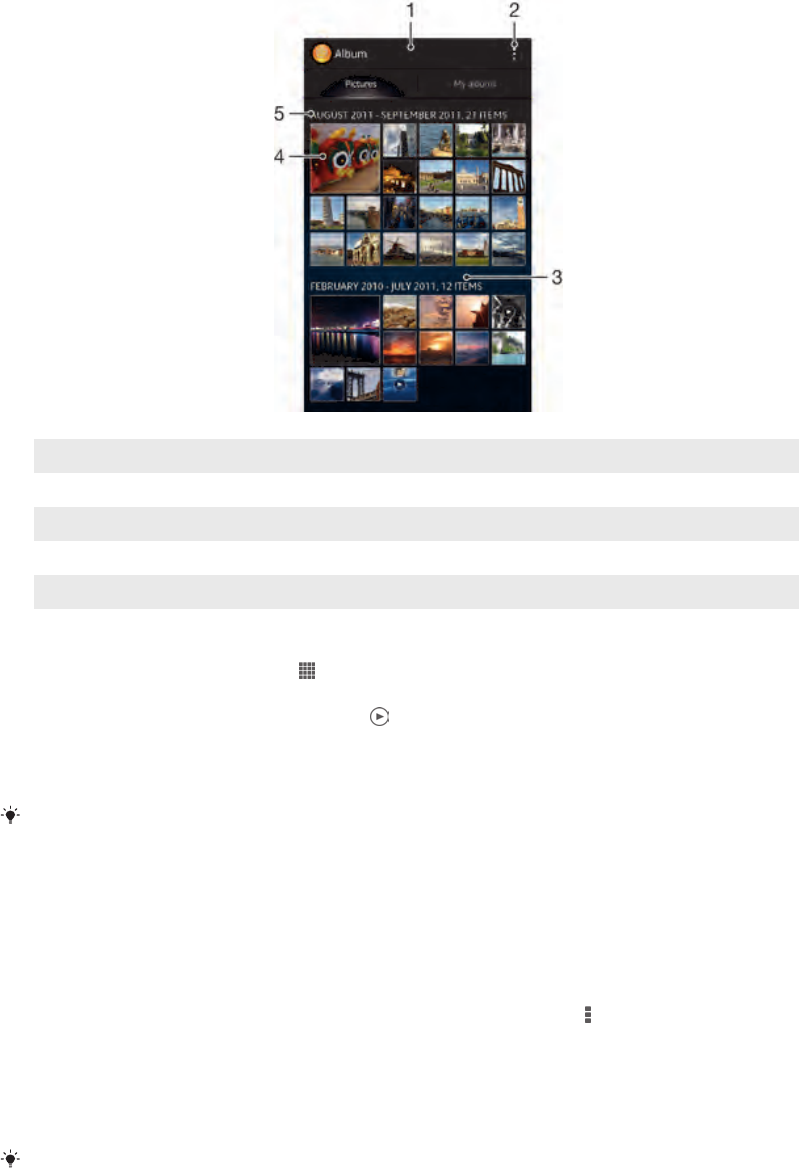
Overview of Pictures tab
1 Grid view of photos and videos.
2 View menu options.
3 Scroll up or down to view content.
4 Tap a photo or video to view it.
5 The date and number of items in the group below.
To view photos and videos in grid view
1From your Home screen, tap .
2Find and tap Album. All photos and videos are displayed in a chronologically
ordered grid. Videos are indicated by .
3Tap a photo or video to view it.
4Flick left to view the next photo or video. Flick right to view the previous photo
or video.
If the screen orientation does not change automatically when you turn your device sideways,
mark the Auto-rotate screen checkbox under Settings > Display.
To change the size of the thumbnails in Album
•When viewing thumbnails of photos and videos in Album, spread two fingers
apart to zoom in, or pinch two fingers together to zoom out.
To work with batches of photos or videos in Album
1When viewing thumbnails of photos and videos in Album, tap , then tap Select
items.
2Tap the items you want to work with. Selected items are indicated by a blue
frame.
3Use the tools in the toolbar at the top of the screen to work with your selected
items.
To activate selection mode, you can also touch and hold an item until its frame turns blue.
Then you can tap other items to select them.
Viewing photos and videos in the My albums tab
The following tiles are available in My albums:
•Camera albums – view all photos and videos taken with your device’s camera.
•Internal memory – view all photos and videos saved to your device's internal storage.
82
This is an Internet version of this publication. © Print only for private use.

•My SD card – view all photos and videos saved to a removable memory card in your
device.
Overview of My albums tab
1 View photos and videos using the PlayMemories online service.
2 View photos and videos on Facebook™.
3 View photos and videos in Picasa™.
4 View your photos on a map.
5 View all photos and videos saved to your device's internal storage.
6 View all photos and videos saved to the removable memory card.
7 View your photos in globe mode.
8 View all photos and videos taken with your device’s camera.
To view content in list view in the Camera albums tile
1From your Home screen, tap .
2Find and tap Album > My albums > Camera albums.
3Tap a folder that you want to open. The folder's content appears in a
chronologically ordered grid. Videos are indicated by .
4Tap a photo or video to view it.
5Flick left to view the next photo or video. Flick right to view the previous photo
or video.
If the screen orientation does not change automatically when you turn your device sideways,
mark the Auto-rotate screen checkbox under Settings > Display.
To view content in list view in the Internal memory tile
1From your Home screen, tap .
2Find and tap Album > My albums > Internal memory.
3Tap a folder that you want to open. The folder's content appears in a
chronologically ordered grid. Videos are indicated by .
4Tap a photo or video to view it.
5Flick left to view the next photo or video. Flick right to view the previous photo
or video.
If the screen orientation does not change automatically when you turn your device sideways,
mark the Auto-rotate screen checkbox under Settings > Display.
83
This is an Internet version of this publication. © Print only for private use.

To view content in list view in the My SD card tile
1From your Home screen, tap .
2Find and tap Album > My albums > My SD card.
3Tap a folder that you want to open. The folder's content appears in a
chronologically ordered grid. Videos are indicated by .
4Tap a photo or video to view it.
5Flick left to view the next photo or video. Flick right to view the previous photo
or video.
If the screen orientation does not change automatically when you turn your device sideways,
mark the Auto-rotate screen checkbox under Settings > Display.
Working with photos in Album
You can edit photos in Album. For example, you can crop photos, associate them
with contacts, or use them as wallpaper.
To zoom a photo
•When you are viewing a photo, double-tap the screen to zoom in. Double-tap again
to zoom out.
•When you are viewing a photo, spread two fingers apart to zoom in, or pinch two
fingers together to zoom out.
To watch a slideshow of your photos
1When you are viewing a photo, tap the screen to display the toolbars, then tap
> Slideshow to start playing all the photos in an album.
2Tap a photo to end the slideshow.
To watch a slideshow of your photos with music
1When you are viewing a photo, tap the screen to display the toolbars, then tap
> SensMe™ slideshow.
2Select the music and theme that you want to use for the slideshow, then tap
. The Album application analyses your photos and uses SensMe™ music
data to play a slideshow.
3To pause playing, tap the screen to display the controls, then tap .
For more information about SensMe™, see Categorising your music using SensMe™
channels on page 62.
To rotate a photo
1When you are viewing a photo, tap the screen to display the toolbars, then tap
.
2Select Rotate left or Rotate right. The photo is saved in the new orientation.
To crop a photo
1When you are viewing a photo, tap the screen to display the toolbars, then tap
> Edit photo > Crop.
2To adjust the crop frame, touch and hold the edge of the crop frame. When the
squares at the edges disappear, drag inward or outward to resize the frame.
3To resize all sides of the crop frame at the same time, touch and hold one of
the four corners to make the squares at the edges disappear, then drag the
corner accordingly.
4To move the crop frame to another area of the photo, touch and hold inside the
frame, then drag it to the desired position.
5To save a copy of the photo as you cropped it, tap Save. The original
uncropped version remains on your device.
To use a photo
1When you are viewing a photo, tap the screen to display the toolbars, then tap
> Use as.
2Select an option from the list that appears.
3Follow the relevant steps to use the photo.
84
This is an Internet version of this publication. © Print only for private use.

To edit a photo
•When you are viewing a photo, tap the screen to display the toolbars, then tap
> Edit photo.
To share a photo
1When you are viewing a photo, tap the screen to display the toolbars, then tap
.
2In the menu that opens, tap the application that you want to use to share the
photo, then follow the steps to send it.
To add a geotag to a photo
1When you are viewing a photo, tap the screen to display the toolbars, then tap
to open the map screen.
2Find and tap the desired location to put the photo on the map.
3To adjust the location of the photo, tap the location on the map to where you
want to move the photo.
4When you are finished, tap OK to save the geotag and return to the photo
viewer.
When a photo is geotagged, appears along with location information. You can tap this icon
to view the photo on a map.
To delete a photo
1When you are viewing a photo, tap the screen to display the toolbars, then tap
.
2Tap OK.
Working with videos in Album
Use Album to watch videos that you’ve taken with the camera, downloaded, or
copied to your device. You can also share your videos with friends, for example, by
uploading them to online services.
To play a video
1Open the Pictures tab or the My albums tab in Album.
2Using grid view or list view, locate the video that you want to open.
3Tap the video to play it.
4If the playback controls are not displayed, tap the screen to display them. To
hide the controls, tap the screen again.
To pause a video
1When a video is playing, tap the screen to display the controls.
2Tap .
To fast forward and rewind a video
1When a video is playing, tap the screen to display the controls.
2Drag the progress bar marker left to rewind, or right to fast forward.
To adjust the volume of a video
•Press the volume key.
To share a video
1When a video is playing, tap the screen to display the toolbars, then tap >
Share.
2In the menu that opens, tap the application that you want to use to share the
selected video, then follow the relevant steps to send it.
You might not be able to copy, send or transfer copyright-protected items. Also, some items
may not send if the file size is too large.
85
This is an Internet version of this publication. © Print only for private use.
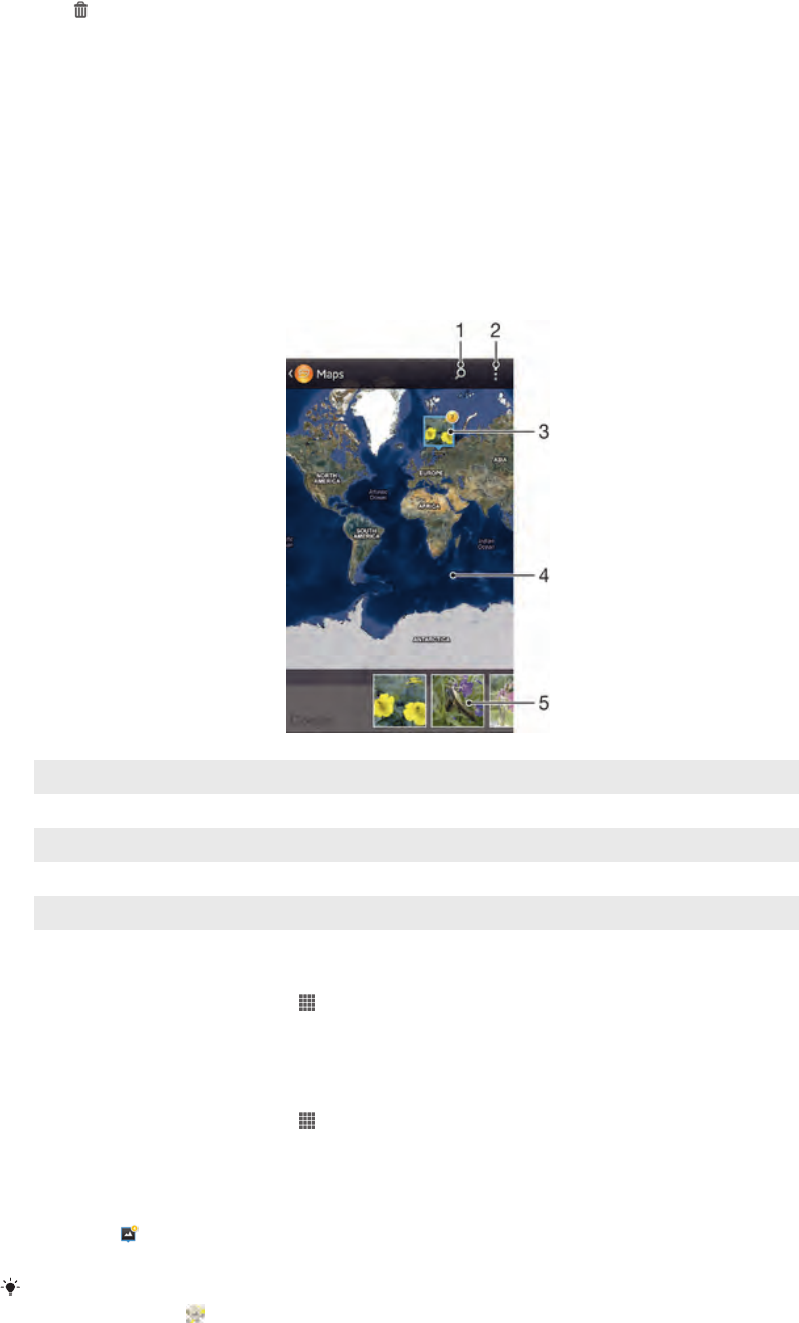
To delete a video
1In Album, find the video you want to delete.
2Touch and hold the video to activate selection mode. The frame of the video
thumbnail turns blue when it is selected.
3Tap , then tap OK.
Viewing your photos on a map
If you enable location detection when taking photos, you can use the information
gathered at a later stage. For example, you can view your photos on a map and show
friends and family where you were when you took the photo. Adding location
information is also referred to as geotagging. When you enable location detection,
you can select to use either GPS satellites or wireless networks, or both, to find your
position.
Overview of Maps tile
1Search a location on the map.
2 View menu options.
3 A group of photos and/or videos geotagged with the same location.
4 Double tap to zoom in. Pinch to zoom out. Drag to view different parts of the map.
5 Thumbnails of the selected group of photos and/or videos. Tap an item to view it in full screen.
To enable location detection
1From your Home screen, tap .
2Find and tap Settings > Location services.
3Mark the GPS satellites and/or Google's location service checkboxes.
To view geotagged photos on a map in Album
1From your Home screen, tap .
2Find and tap Album > My albums > Maps.
3Tap a photo to view it in full screen.
4If several photos were taken at the same location, only one of them appears on
the map. The total number of photos appears in the top right corner, for
example, . To view these photos, tap the cover photo and then tap one of the
thumbnails at the bottom of the screen.
When viewing a geotagged photo in the photo viewer, you can touch the screen to display the
toolbars, then tap to view the photo on the map.
86
This is an Internet version of this publication. © Print only for private use.
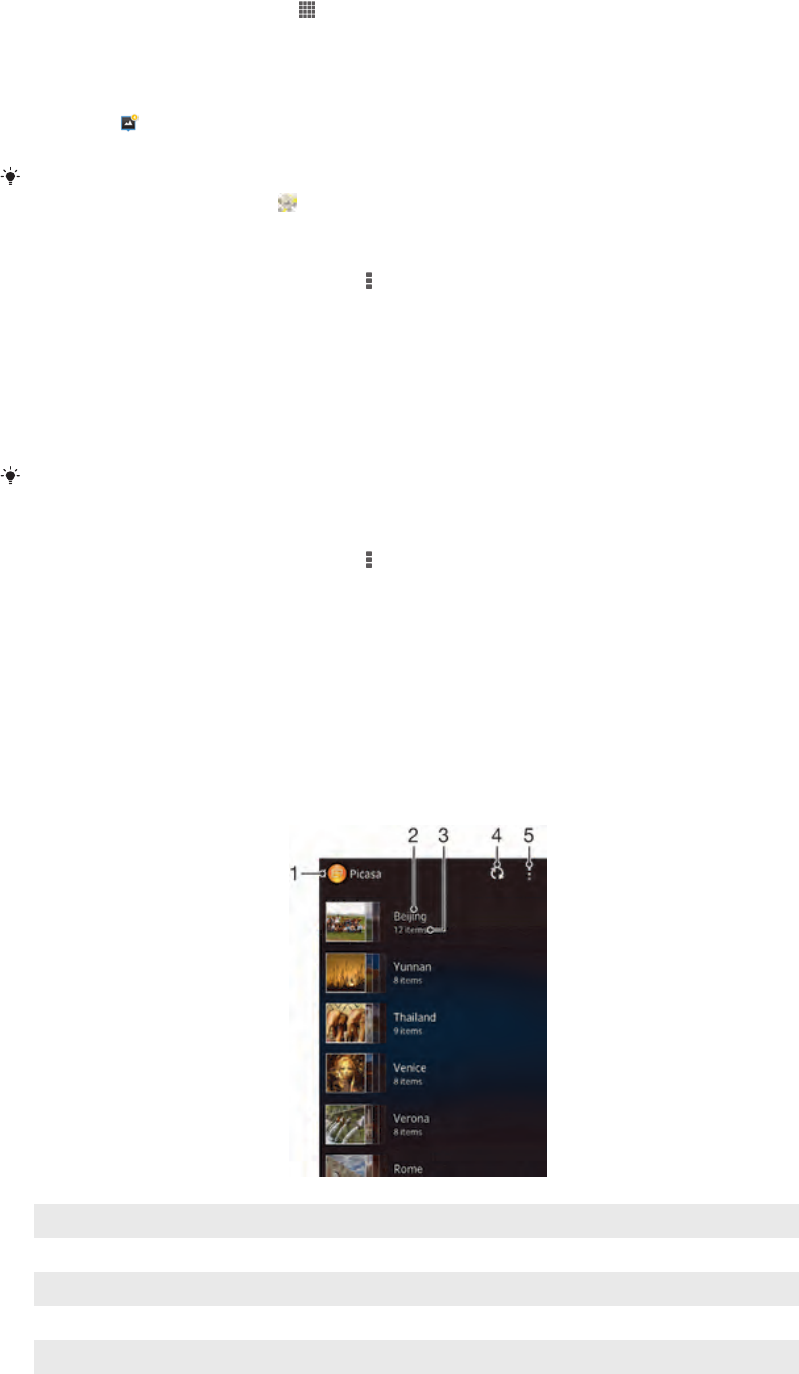
To view geotagged photos on a globe in Album
1From your Home screen, tap .
2Find and tap Album > My albums > Globe.
3Tap a photo to view it in full screen.
4If several photos were taken at the same location, only one of them appears on
the map. The total number of photos appears in the top right corner, for
example, . To view these photos, tap the cover photo and then tap one of the
thumbnails at the bottom of the screen.
When viewing a geotagged photo from the camera application, you can touch the screen to
display the toolbars, then tap to view the photo on the map.
To add a geotag when viewing the map in Album
1When viewing the map in Album, tap , then tap Add geotag.
2Find and tap the photo to which you want to add the geotag.
3Tap the desired location on the map to set the geotag, then tap OK.
To edit the geotag of a photo in Album
1When viewing a photo on the map in Album, touch and hold the photo until its
frame turns blue.
2Drag the photo to the new location.
You can also tap the desired location on the map instead of dragging.
To change the map view in Album
•When viewing the map in Album, tap , then select Classic view, Globe view or
Satellite view.
Viewing online albums
In Album, view the photos and videos that you and your friends have uploaded to
online services, such as Picasa™ and Facebook™. You can view comments from
your friends and add your own comments as well.
Overview of online services
1Active online service.
2 Name of online album.
3 Number of items in the online album.
4 Refresh.
5 View menu options.
87
This is an Internet version of this publication. © Print only for private use.

To view photos from online services in Album
1From your Home screen, tap .
2Find and tap Album > My albums.
3Tap the desired online service.
4Tap Connect. All available online albums that you have uploaded to the service
are displayed.
5Tap any album to view its content, then tap a photo in the album.
6Flick left to view the next photo or video. Flick right to view the previous photo
or video.
To view and add comments to online album content
1When viewing a photo from an online album, tap the screen to display the
toolbars, then tap to view the comments.
2To view more comments, scroll down the screen.
3To add your own comments, enter your comments at the bottom of the screen,
then tap Post.
To "Like" a photo or video on Facebook™
•While viewing a photo or video from one of your Facebook™ albums, tap the
screen to display the toolbars, then tap to show that you "Like" the item on
Facebook™.
88
This is an Internet version of this publication. © Print only for private use.
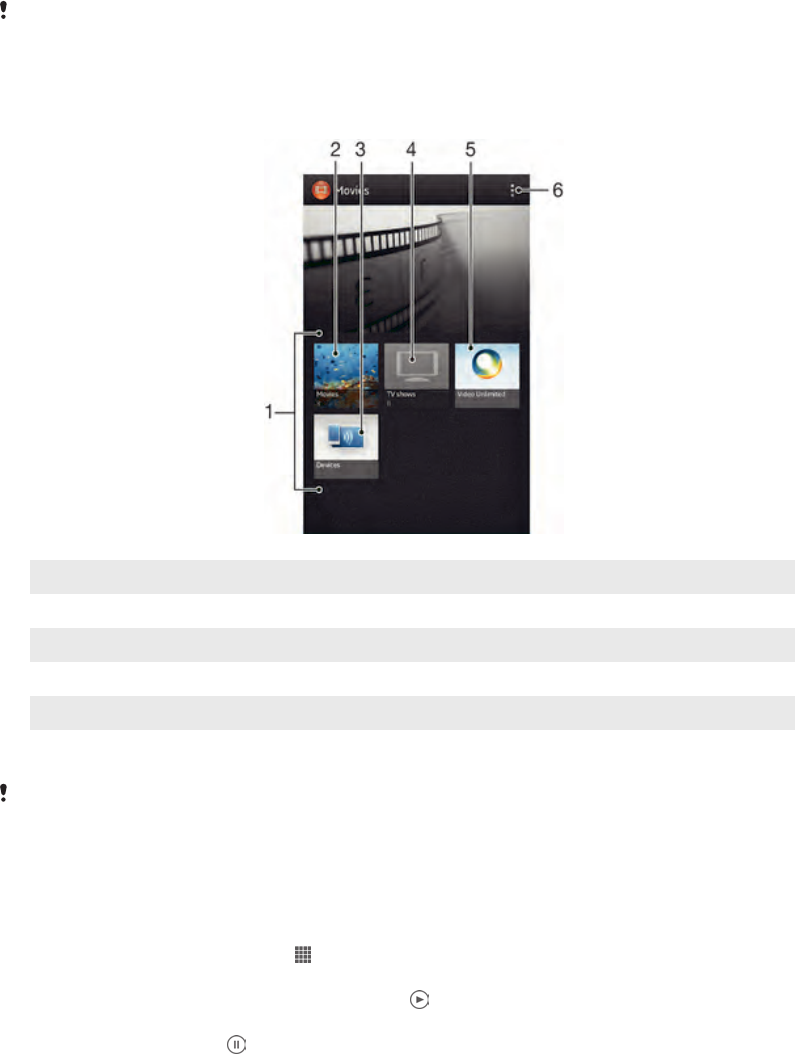
Movies
About Movies
Use the Movies application to play movies and other video content that you’ve saved
on your device. The Movies application also helps you get poster art, plot summaries,
genre info and director details for each movie. You can also play your movies on
other devices that are connected to the same network.
Videos taken with your device's camera are displayed in the Album application, not in the
Movies application.
Overview of Movies
1All video categories available on your device.
2 Browse all movies.
3 Browse content on other connected DLNA Certified™ devices.
4 Browse all TV shows.
5 Manage video content from Video Unlimited™.
6 View menu options.
Video Unlimited™ may not be available in all countries or regions.
Using Movies
To play a video in Movies
1From your Home screen, tap , then find and tap Movies.
2Select a video category and browse to the video that you want to play.
3Tap the video you want to select, then tap to play it.
4To display or hide the controls, tap the screen.
5To pause playing, tap .
6To rewind, drag the progress bar marker left. To fast forward, drag the
progress bar marker right.
89
This is an Internet version of this publication. © Print only for private use.

To play a video in full screen
1When a video is playing, tap the screen to display the controls.
2Tap .
To play the video in its original size, tap .
To share a video
1When a video saved under Movies or TV shows is playing, tap , then tap
Share.
2Tap the application that you want to use to share the selected video, then
follow the relevant steps to send it.
To get movie information manually
1Make sure that your device has an active data connection.
2From your Home screen, tap , then find and tap Movies.
3Tap , then make sure that the Get video details checkbox is marked.
4Open the Movies or TV shows tab and browse to the thumbnail of a file that
you want to get information about.
5Touch and hold the thumbnail for the video, then tap Search for info.
6In the search field, enter keywords for the video, then tap the confirm key on
the keyboard. All matches are displayed in a list.
7Select a search result, then tap Done. The download of the information begins.
You also get information about newly added videos automatically when the Movies application
is opened and the Get video details checkbox is marked. Data transmission charges may
apply.
If the downloaded information is not correct, tap and search again using different
keywords.
To clear information about a video
1From your Home screen, tap , then find and tap Movies.
2Select a video category and browse to the video that you want to edit.
3Touch and hold the video thumbnail, then tap Clear info.
To play a video on an external device
1Make sure the devices that you want to share files with are connected to the
same Wi-Fi® network as your device.
2From your Home screen, tap , then find and tap Movies > .
3Tap Throw, then select a device from the list.
4Select the video that you want to play.
To change the sound settings while a video is playing
1While a video is playing, tap the screen to display the controls.
2Tap , then tap Sound settings.
3Mark the checkboxes for the sound settings that you want to activate.
4When you're finished, tap OK.
To delete a video
1From your Home screen, tap , then find and tap Movies.
2Select a video category and browse to the video that you want to delete.
3Touch and hold the video thumbnail, then tap Delete from the list that appears.
4Tap Delete again to confirm.
90
This is an Internet version of this publication. © Print only for private use.
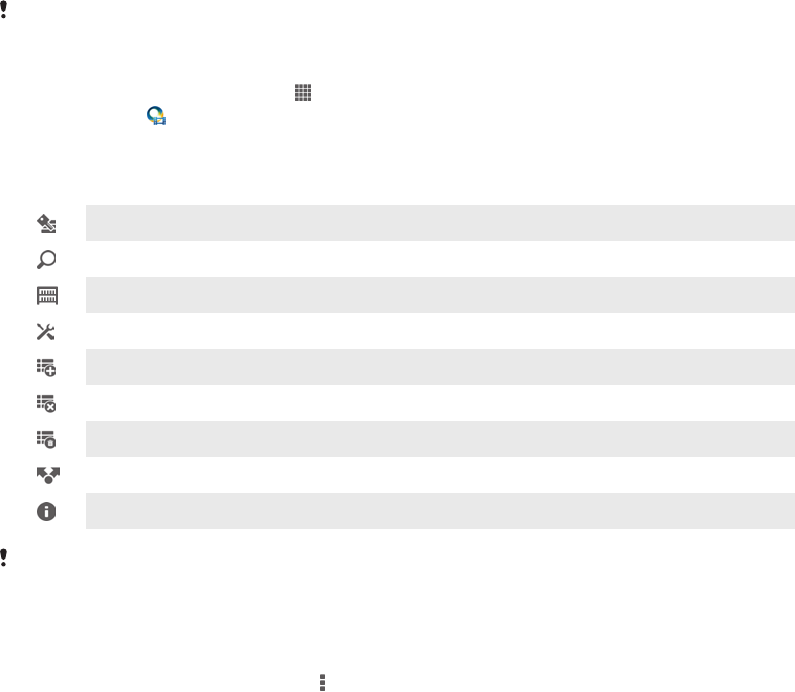
Video Unlimited™
About Video Unlimited™
Use the Video Unlimited™ service to rent and purchase videos that you can view not
only on your Android device, but also on a PC, PlayStation® Portable (PSP®) or
PlayStation® 3. Select your pick from the latest Hollywood releases, action movies,
comedies, classics, and a range of other categories.
Video Unlimited™ might not be available in all countries or regions.
To open Video Unlimited™
1From your Home screen, tap .
2Find and tap .
Video Unlimited™ menu overview
View your account information
Search for a video
View the download status for all your items
View and change settings for your account, purchases, and downloads
Add the current video to a wish list
Delete all items in your wish list
Delete the video you're currently viewing from the wish list
Share information about the current video via a social network, email, Bluetooth or other method
View legal information
The Video Unlimited™ menu is dynamic, which means that all options are not always available.
For example, the option to delete all items in your wish list is only available when you are
viewing the list.
To open the Video Unlimited™ menu
•Open Video Unlimited, then tap .
Creating a Video Unlimited™ account
You need to create a Video Unlimited™ account if you want to buy or rent movies
through the Video Unlimited™ service.
Exploring the Video Unlimited™ selection
Browse videos by category, or enter text to search for a particular item. You can also
choose to preview videos you're interested in.
Renting or buying a video
When you rent a video, you have a fixed amount of time in which to view it. This time
period varies from market to market. You can also choose to download a purchased
video to most Sony™ devices that are connected to your Video Unlimited™ account.
Video Unlimited™ notifications overview
When you buy or rent videos, the following notifications may appear:
91
This is an Internet version of this publication. © Print only for private use.

Downloading of video is completed
Downloading has failed. You need to check that, for example, your device is
connected to a Wi-Fi® network, and that you have enough free space on your
memory card.
Downloading of video is ongoing
Downloading is paused
Confirmation of successful purchase
Rental countdown period has started
Watching a video from Video Unlimited™
You can watch your rented or purchased videos on most Sony™ device that are
connected to your Video Unlimited™ account.
Video menu overview
When you watch a video from Video Unlimited™, you can open a menu to get the
following options:
Delete the current video
View information about the current video
Change the audio language
Change the language of subtitles, or remove subtitles
92
This is an Internet version of this publication. © Print only for private use.

Web browser
About the web browser
The Google Chrome™ web browser for Android™ devices comes pre-installed in
most markets. Go to http://support.google.com/chrome and click the "Chrome for
Mobile" link to get more detailed information about how to use this web browser.
Google Chrome™ is not available in all markets.
To open the web browser
1From your Home screen, tap .
2Find and tap .
93
This is an Internet version of this publication. © Print only for private use.
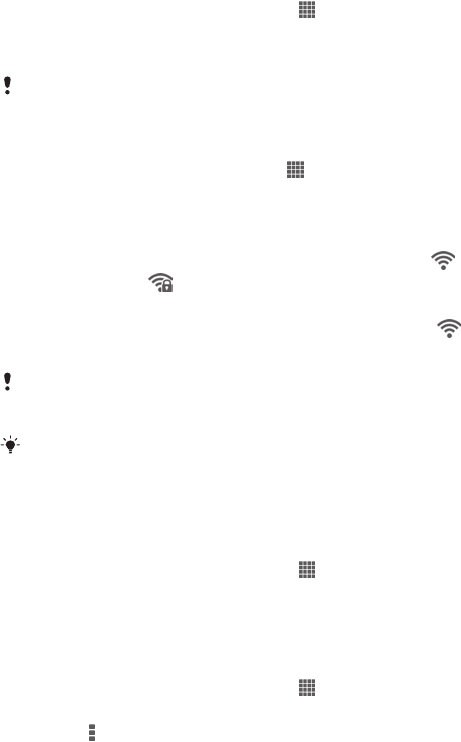
Connectivity
Connecting to wireless networks
You can access the Internet wirelessly from your device using Wi-Fi® technology.
This way you can browse the web and share media files over the same Wi-Fi®
network with other DLNA Certified™ devices, for example, TVs and computers.
If your company or organisation has a virtual private network (VPN), you can connect
to this network using your device. You can use a VPN to access intranets and other
internal services at your company.
Before using Wi-Fi®
To browse the Internet using a Wi-Fi® connection, you need to search for and
connect to an available Wi-Fi® network and then open the Internet browser. The
signal strength of the Wi-Fi® network may differ depending on your device's location.
Move closer to the Wi-Fi® access point to increase the signal strength.
To turn on Wi-Fi®
1From your Home screen, tap .
2Find and tap Settings.
3Drag the slider beside Wi-Fi® to the right to turn on the Wi-Fi® function.
It may take a few seconds before Wi-Fi® is enabled.
To connect to a Wi-Fi® network
1From the Home screen, tap .
2Find and tap Settings.
3Make sure that the Wi-Fi® function is on. Tap Wi-Fi .
4Available Wi-Fi® networks are displayed. The available networks may be open
or secured. Open networks are indicated by and secured networks are
indicated by next to the Wi-Fi® network name.
5Tap a Wi-Fi® network to connect to it. If you are trying to connect to a secure
network, you are asked to enter a password. is displayed in the status bar
once you are connected.
Your device remembers Wi-Fi® networks you connect to. The next time you come within
reach of a previously connected Wi-Fi® network, your device automatically connects to it.
In some locations, open Wi-Fi® networks require you to log in to a web page before you can
get access to the network. Contact the relevant Wi-Fi® network administrator for more
information.
To connect to another Wi-Fi® network
1From your Home screen, tap .
2Find and tap Settings > Wi-Fi. Detected Wi-Fi® networks are displayed.
3Tap another Wi-Fi® network to connect to it.
To scan for Wi-Fi® networks manually
1From your Home screen, tap to go to the Application screen.
2Find and tap Settings > Wi-Fi.
3Press , then tap Scan. Your device now scans for all available Wi-Fi®
networks.
4To connect to a Wi-Fi® network, tap the network name from the list of
available networks.
94
This is an Internet version of this publication. © Print only for private use.

To add a Wi-Fi® network manually
1Make sure that Wi-Fi® is turned on.
2From the Home screen, tap .
3Find and tap Settings > Wi-Fi .
4Tap .
5Enter the Network SSID for the network.
6Tap the Security field to select a security type.
7If required, enter a password.
8Tap Save.
The Wi-Fi® network name may be indicated as SSID, ESSID or Access Point. Contact your
Wi-Fi® network administrator to get the Network SSID and password.
Advanced Wi-Fi® settings
Wi-Fi® network status
When you are connected to a Wi-Fi® network or when there are Wi-Fi® networks
available in your vicinity, it is possible to see the status of these Wi-Fi® networks.
You can also enable your device to notify you whenever an open Wi-Fi® network is
detected.
To enable Wi-Fi® network notifications
1Turn on Wi-Fi®, if it is not already on.
2From your Home screen, tap .
3Find and tap Settings > Wi-Fi.
4Press .
5Tap Advanced.
6Mark the Network notification checkbox.
To view detailed information about a connected Wi-Fi® network
1From the Home screen, tap .
2Find and tap Settings > Wi-Fi.
3Tap the Wi-Fi® network that you are currently connected to. Detailed network
information is displayed.
Wi-Fi® sleep policy
By adding a Wi-Fi® sleep policy, you can specify when to switch from Wi-Fi® to
mobile data.
If you are not connected to a Wi-Fi® network, your device uses a mobile data connection to
access the Internet (if you have set up and enabled a mobile data connection on your device).
To add a Wi-Fi® sleep policy
1From the Home screen, tap .
2Find and tap Settings > Wi-Fi.
3Press .
4Tap Advanced.
5Tap Keep Wi-Fi on during sleep.
6Select an option.
Sharing your mobile data connection
You can share your device's mobile data connection with a single computer using a
USB cable. This process is called USB tethering. You can also share your device's
data connection with up to eight other devices at once, by turning your device into a
portable Wi-Fi® hotspot.
When your device is sharing its data connection, the following icons may appear in
the status bar or in the Notification panel:
USB tethering is active
95
This is an Internet version of this publication. © Print only for private use.

Portable Wi-Fi® hotspot is active
To share your data connection using a USB cable
1Deactivate all USB cable connections to your device.
2Using the USB cable that came with your device, connect your device to a
computer.
3From your Home screen, tap .
4Find and tap Settings > More… > Tethering & portable hotspot.
5Mark the USB tethering checkbox.
6To stop sharing your data connection, unmark the USB tethering checkbox or
disconnect the USB cable.
You cannot share your device's data connection and SD card over a USB cable at the same
time.
You may need to prepare your computer to establish a network connection via USB cable. Go
to www.android.com/tether to get the most current information.
To use your device as a portable Wi-Fi® hotspot
1From the Home screen, tap .
2Find and tap Settings > More… > Tethering & portable hotspot.
3Tap Portable Wi-Fi hotspot settings > Set up Wi-Fi hotspot.
4Enter the Network SSID for the network. Tap the Security field to select a
security type.
5If required, enter a password.
6Tap Save.
7Mark the Portable Wi-Fi hotspot checkbox. Your device starts broadcasting its
Wi-Fi network name (SSID). Up to eight computers or other devices can now
connect to this network.
8Unmark the Portable Wi-Fi hotspot checkbox when you want to stop sharing
your data connection via Wi-Fi®.
To rename or secure your portable hotspot
1From the Home screen, tap .
2Find and tap Settings > More… > Tethering & portable hotspot.
3Tap Portable Wi-Fi hotspot settings > Set up Wi-Fi hotspot.
4Enter the Network SSID for the network.
5To select a security type, tap the Security field.
6If required, enter a password.
7Tap Save.
Virtual private networks (VPNs)
Use your device to connect to virtual private networks (VPNs), which allow you to
access resources inside a secured local network from outside the actual network. For
example, VPN connections are commonly used by corporations and educational
institutions for users who need to access intranets and other internal services when
they are outside of the internal network, for example, when they are travelling.
VPN connections can be set up in many ways, depending on the network. Some
networks may require you to transfer and install a security certificate in your device.
For detailed information on how to set up a connection to your virtual private
network, please contact the network administrator of your company or organisation.
To add a virtual private network
1From your Home screen, tap .
2Find and tap Settings > More… > VPN.
3Tap Add VPN profile.
4Select the type of VPN to add.
5Enter your VPN settings.
6Tap Save.
96
This is an Internet version of this publication. © Print only for private use.

To connect to a virtual private network
1From your Home screen, tap .
2Find and tap Settings > More… > VPN.
3In the list of available networks, tap the VPN that you want to connect to.
4Enter the required information.
5Tap Connect.
To disconnect from a virtual private network
1Drag the status bar downwards.
2Tap the notification for the VPN connection to turn it off.
Sharing content with DLNA Certified™ devices
You can view or play media content saved to your device on other devices such as,
for example, a TV, or a computer. Such devices must be DLNA Certified™ by the
Digital Living Network Alliance and all devices must be connected to the same Wi-
Fi® network in order for content to be shared. You can also view or play content from
other DLNA Certified™ devices on your device.
After you set up the sharing of content between devices, you can, for example, listen
to music files stored on your home computer from your device, or view photos taken
with your device's camera on a large-screen TV.
Playing files from DLNA Certified™ devices on your device
When you play files from another DLNA Certified™ device on your device, this other
device acts as a server. In other words, it shares content over a network. The server
device must have its content sharing function enabled and give access permission to
your device. It also must be connected to the same Wi-Fi® network as your device.
To play a shared track on your device
1Make sure the devices that you want to share files with are connected to the
same Wi-Fi® network as your device.
2From your Home screen, tap , then find and tap WALKMAN.
3Tap My music to open the music library.
4Select a device from the list of connected devices.
5Browse the folders of the connected device and select the track that you want
to play. The track starts playing automatically.
To play a shared video on your device
1Make sure the devices that you want to share files with are connected to the
same Wi-Fi® network as your device.
2From your Home screen, tap , then find and tap Movies > Devices.
3Select a device from the list of connected devices.
4Browse the folders of the connected device and select the video that you want
to play.
To view a shared photo on your device
1Make sure the devices that you want to share files with are connected to the
same Wi-Fi® network as your device.
2From your Home screen, tap .
3Find and tap Album > My albums. All your available online albums and
connected devices are displayed.
4Select a device from the list of connected devices.
5Browse the folders of the connected device and select a photo to view it.
Preparing to play content from your device on DLNA Certified™
devices
Before you can view or play media files from your device on other DLNA Certified™
devices, you must set up file sharing on your device. The devices that you share
content with are called client devices. For example, a TV, computer or tablet can act
97
This is an Internet version of this publication. © Print only for private use.

as client devices. Your device works as a media server when it makes content
available to client devices. When you set up file sharing on your device, you must
also give access permission to client devices. After you do so, such devices appear
as registered devices. Devices that are waiting for access permission are listed as
pending devices.
To set up file sharing with other DLNA Certified™ devices
1Connect your device to a Wi-Fi® network.
2From your Home screen, tap , then find and tap .
3Tap My music to open the music library.
4Press , then tap Media server.
5To turn on the Share content function, drag the slider. appears in the status
bar. Your device can now work as a media server.
6Connect your computer or other devices to the same Wi-Fi® network as your
device.
7A notification appears in the status bar of your device. Open the notification
and set the relevant access permissions for other devices.
The instructions described above may differ depending on the client devices used. Refer to
your client device User guide for more information. If the device cannot connect, check that
your Wi-Fi® network is working.
You can also access the Media server menu under Settings > More… > Media server
settings. If you close the Media server view, file sharing function function stays running in the
background.
To stop sharing files with other DLNA Certified™ devices
1From your Home screen, tap , then find and tap .
2Tap My music to open the music library.
3Press , then tap Media server.
4Drag the slider to turn off the Share content function.
To set access permissions for a pending device
1From your Home screen, tap , then find and tap .
2Tap My music to open the music library.
3Press , then tap Media server.
4Select a device from the Pending devices list.
5Select an access permission level.
To change the name of a registered device
1From your Home screen, tap , then find and tap .
2Tap My music to open the music library.
3Press , then tap Media server.
4Select a device from the Registered devices list, then select Change name.
5Enter a new name for the device.
To change the access level of a registered device
1From your Home screen, tap , then find and tap .
2Tap My music to open the music library.
3Press , then tap Media server.
4Select a device from the Registered devices list.
5Tap Change access level and select an option.
To get help about sharing content with other DLNA Certified™ devices
1From your Home screen, tap , then find and tap .
2Tap My music to open the music library.
3Press , then tap Media server.
4Tap .
98
This is an Internet version of this publication. © Print only for private use.

Playing files on a Digital Media Renderer device
Using DLNA™ technology, you can push media content saved on your device to
another device connected to the same Wi-Fi® network. The other device must be
able to function as a Digital Media Renderer (DMR) device, which means that it can
render, or play, content received from your device. A DMR device can be, for
example, a TV with DLNA function, or a PC running Windows® 7 or higher.
The settings for enabling the Digital Media Renderer may vary depending on the device used.
Refer to the user guide for the respective device for more detailed information.
To view photos or videos from your device on a DMR device
1Make sure that you have correctly set up the DMR device and that it is
connected to the same Wi-Fi® network as your device.
2From your Home screen, tap .
3Find and tap Album.
4Browse to and open the file that you want to view.
5Tap the screen to display the toolbars, then tap and select a DMR device to
share your content with. The selected files start playing in chronological order
on the device that you select.
6To disconnect from the DMR device, tap and select My phone. The file stops
playing on the DMR device but continues playing on your device.
You can also share a video from the Movies application on your device by tapping the video
and then tapping .
To play a music track from your device on a DMR device
1Make sure that you have correctly set up the DMR device and that it is
connected to the same Wi-Fi® network as your device.
2From your Home screen, tap , then find and tap WALKMAN.
3Tap My music to open the music library.
4Select a music category and browse to the track that you want to share, then
tap the track.
5Tap and select a DMR device to share your content with. The track plays
automatically on the device that you select.
6To disconnect from the DMR device, tap and select My phone. The track
stops playing on the DMR device but continues playing on your device.
NFC
Use Near Field Communications (NFC) to share data with other devices, such as a
video, photo, web page address, music file or contact. You can also use NFC to scan
tags that give you more information about a product or service as well as tags that
activate certain functions on your device.
NFC is a wireless technology with a maximum range of one centimetre, so the
devices sharing data must be held close to each other. Before you can use NFC, you
must first turn on the NFC function, and the device's screen must be active.
NFC may not be available in all countries and/or regions.
To turn on the NFC function
1From your Home screen, tap .
2Find and tap Settings > More….
3Mark the NFC checkbox.
99
This is an Internet version of this publication. © Print only for private use.
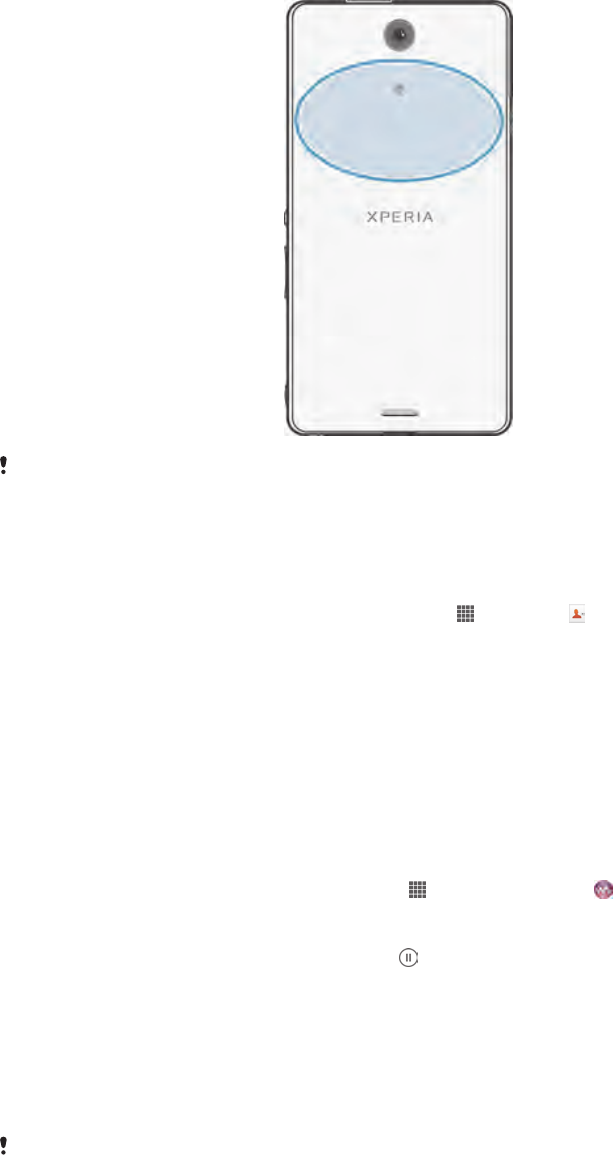
NFC detection area
The location of the NFC detection area is not the same on all devices. When sharing data with
another device using NFC, refer to the User guide of the other device for more information.
To share a contact with another device using NFC
1Make sure that both devices have the NFC function turned on, and that both
screens are active.
2To view contacts, go to your Home screen, tap , then tap .
3Tap the contact that you want to share.
4Hold your device and the receiving device back to back so that the NFC
detection areas of each device touch each other. When the devices connect,
they vibrate and play a short sound. A thumbnail of the contact appears.
5Tap the thumbnail to start the transfer.
6When the transfer is done, the contact information is displayed on the screen
of the receiving device and is also saved on the receiving device.
To share a music file with another device using NFC
1Make sure that both your device and the receiving device have the NFC
function turned on, and that both screens are active.
2To open the "WALKMAN" application, tap , then find and tap .
3Tap the My music tab to open the music library.
4Select a music category and browse to the track you want to share.
5Tap the track to play it. You can then tap to pause the track. The transfer
works whether the track is playing or paused.
6Hold your device and the receiving device back to back so that the NFC
detection areas of each device touch each other. When the devices connect,
they vibrate and play a short sound. A thumbnail of the track appears.
7Tap the thumbnail to start the transfer.
8When the transfer is done, the music file plays immediately on the receiving
device. At the same time, the file is saved on the receiving device.
You might not be able to copy, send or transfer copyright-protected items.
100
This is an Internet version of this publication. © Print only for private use.

To share a photo or video with another device using NFC
1Make sure that both devices have the NFC function turned on, and that both
screens are active.
2To view photos and videos in your device, go to your Home screen, tap ,
then find and tap Album.
3Tap the photo or video that you want to share.
4Hold your device and the receiving device back to back so that the NFC
detection areas touch each other. When the devices connect, they vibrate and
play a short sound. A thumbnail of the photo or video appears.
5Tap the thumbnail to start the transfer.
6When the transfer is done, the photo or video is displayed on the screen of the
receiving device. At the same time, the item is saved on the receiving device.
You can also use NFC to share a video from the Movies application.
To share a web address with another device using NFC
1Make sure that both devices have the NFC function turned on, and that both
screens are active.
2From your Home screen, tap .
3To open the web browser, find and tap .
4Load the web page that you want to share.
5Hold your device and the receiving device back to back so that the NFC
detection areas touch each other. When the devices connect, they vibrate and
play a short sound. A thumbnail of the web page appears.
6Tap the thumbnail to start the transfer.
7When the transfer is done, the web page is displayed on the screen of the
receiving device.
Scanning NFC tags
Your device can scan various kinds of NFC tags. For example, it can scan embedded
tags on a poster, on a billboard advertisement, or beside a product in a retail store.
You can receive additional information, such as a web address.
To scan an NFC tag
1Make sure that your device has the NFC function turned on and that the screen
is active.
2Place your device over the tag so that the NFC detection area touches it. Your
device scans the tag and displays the content collected. Tap the content of the
tag to open it.
3To open the tag, tap it.
Paying for items with your device
You can use the Operator wallet application on your device to pay for items in stores
that support NFC payment methods. Just tap your device on specially enabled
electronic payment pads to pay for your purchases. Payments are backed by a credit
or debit card, or by prepaid cards or vouchers. Your payment information is stored in
the payment application, so you don’t need to enter it every time.
To use Operator wallet, your SIM card must have a secure element embedded. Contact your
network operator for more details.
Google Wallet™
Use the Google Wallet™ application to pay for goods at checkouts. If there is a
supported NFC terminal at the checkout, you can just tap your device on the terminal
to pay. Google Wallet™ stores details of your credit and debit cards as well as details
of coupons and other special offers. Most major credit card types are supported.
Security features include a PIN, encrypted storage and the ability to remotely disable
a lost wallet.
101
This is an Internet version of this publication. © Print only for private use.

Operator wallet
The Operator wallet application lets you access a variety of services provided by your
network operator, such as the option to pay for items in underground trains and
stores. Contact your network operator for more information about such services.
To select a wallet for use on your device
1Make sure that the NFC function is on.
2From your Home screen, tap .
3Find and tap Settings > More….
4Tap Wallet and select an option.
Connecting to an NFC compatible device
You can connect your device to other NFC compatible devices produced by Sony,
such as a speaker or a headphone. When establishing this kind of connection, refer
to the User guide of the compatible device for more information.
You may need to have Wi-Fi® or Bluetooth™ activated on both devices for the connection to
work.
Bluetooth™ wireless technology
Use the Bluetooth™ function to send files to other Bluetooth™ compatible devices,
or to connect to handsfree accessories. Turn on the Bluetooth™ function in your
device and create wireless connections to other Bluetooth™ compatible devices
such as computers, handsfree accessories, and phones. Bluetooth™ connections
work better within 10 metres (33 feet), with no solid objects in between. In some
cases you have to manually pair your device with other Bluetooth™ devices.
Interoperability and compatibility among Bluetooth™ devices can vary.
To turn on the Bluetooth™ function and make your device visible
1From your Home screen, tap .
2Find and tap Settings.
3Tap the on-off switch beside Bluetooth to turn on the Bluetooth™ function.
4Tap Bluetooth. Your device and a list of available Bluetooth™ devices appear.
5Tap your device name to make your device visible to other Bluetooth™
devices.
To adjust your device's visibility time to other Bluetooth™ devices
1From your Home screen, tap .
2Find and tap Settings > Bluetooth.
3Press and select Visibility timeout.
4Select an option.
Naming your device
You can give your device a name. This name is shown to other devices after you
have turned on the Bluetooth™ function and your device is set to visible.
To give your device a name
1Make sure that the Bluetooth™ function is turned on.
2From your Home screen, tap .
3Find and tap Settings > Bluetooth.
4Press and select Rename phone.
5Enter a name for your device.
6Tap Rename.
102
This is an Internet version of this publication. © Print only for private use.

Pairing with another Bluetooth™ device
When you pair your device with another device, you can, for example, connect your
device to a Bluetooth™ headset or a Bluetooth™ car kit and use these other devices
to make and receive calls.
Once you have paired your device with a Bluetooth™ device, your device will
remember this pairing. When pairing your device with a Bluetooth™ device, you may
need to enter a passcode. Your device will automatically try the generic passcode
0000. If this does not work, refer to the user guide for your Bluetooth™ device to get
the device passcode. You do not need to re-enter the passcode the next time you
connect to a paired Bluetooth™ device.
Some Bluetooth™ devices, for example, most Bluetooth™ headsets, require you to
both pair and connect with the other device.
You can pair your device with several Bluetooth™ devices, but you can only connect
to one Bluetooth™ profile at the same time.
To pair your device with another Bluetooth™ device
1Make sure that the device you want to pair your device with has the
Bluetooth™ function activated and is visible to other Bluetooth™ devices.
2From the Home screen, tap .
3Find and tap Settings > Bluetooth. All available Bluetooth™ devices appear in
a list.
4Tap the Bluetooth™ device that you want to pair with your device.
5Enter a passcode, if required, or confirm the same passcode on both devices.
Your device and the Bluetooth™ device are now paired.
To connect your device to another Bluetooth™ device
1If you are connecting to a Bluetooth device that requires you to first pair your
device before connecting, follow the relevant steps to pair your device with
that device.
2From your Home screen, tap .
3Find and tap Settings > Bluetooth.
4Tap the Bluetooth™ device to which you want to connect your device.
To unpair a Bluetooth™ device
1From the Home screen, tap .
2Find and tap Settings > Bluetooth.
3Under Paired devices, tap beside the name of the device that you want to
unpair.
4Tap Unpair.
Sending and receiving items using Bluetooth™ technology
Share items with other Bluetooth™ compatible devices such as phones or
computers. You can send and receive several kinds of items using the Bluetooth™
function, such as:
•Photos and videos
•Music and other audio files
•Contacts
•Web pages
103
This is an Internet version of this publication. © Print only for private use.

To send items using Bluetooth™
1Receiving device: Make sure the Bluetooth™ function is turned on and that
the device is visible to other Bluetooth™ devices.
2Sending device: Open the application which contains the item that you want to
send, and scroll to the item.
3Depending on the application and the item you want to send, you may need to,
for example, touch and hold the item, open the item or press . Other ways to
send an item may exist.
4Select Share or Send.
5Select Bluetooth.
6Turn on Bluetooth™, if you are asked to do so.
7Tap the name of the receiving device.
8Receiving device: If asked, accept the connection.
9Sending device: If asked, confirm the transfer to the receiving device.
10 Receiving device: Accept the incoming item.
To receive items using Bluetooth™
1Make sure that the Bluetooth™ function is on and is visible to other
Bluetooth™ devices.
2The sending device now starts sending data to your device.
3If prompted, enter the same passcode on both devices, or confirm the
suggested passcode.
4When you are notified of an incoming file to your device, drag the status bar
downwards and tap the notification to accept the file transfer.
5Tap Accept to start the file transfer.
6To view the progress of the transfer, drag the status bar downwards.
7To open a received item, drag the status bar downwards and tap the relevant
notification.
To view files you have received using Bluetooth™
1From your Home screen, tap .
2Find and tap Settings > Bluetooth.
3Press and select Show received files.
Connecting your device to a computer
Connect your device to a computer and start transferring pictures, music and other
file types. The easiest ways to connect are using a USB cable or Bluetooth wireless
technology.
When you connect your device to the computer using a USB cable, you are
prompted to install the PC Companion application on your computer. PC Companion
helps you access additional computer applications to transfer and organise media
files, update your device, synchronise device content, and more.
You might not be able to transfer some copyright-protected material between your device and
a computer.
Transferring and handling content using a USB cable
Use a USB cable connection between a computer and your device for easy transfer
and management of your files. Once the two devices are connected, you can drag
and drop content between your device and the computer, or between your device's
internal storage and SD card, using the computer's file explorer.
If you're transferring music, video, pictures or other media files to your device, it's
best to use the Media Go™ application on your computer. Media Go™ converts
media files so that you can use them on your device.
104
This is an Internet version of this publication. © Print only for private use.

To transfer content between your device and computer using a USB cable
1Using a USB cable, connect your device to a computer. Internal storage & SD
card connected appears in the status bar on the screen of your device.
2Computer: Open Microsoft® Windows® Explorer from the desktop and wait
until your device's internal storage and your SD card appear as external disks
in Microsoft® Windows® Explorer.
3Computer: Drag and drop the desired files between your device and the
computer.
To transfer content between internal storage and an SD card via USB
1Using a USB cable, connect your device to a computer. Internal storage & SD
card connected appears in the status bar on the screen of your device.
2Computer: Open Microsoft® Windows® Explorer from the desktop and wait
until your device's internal storage and your SD card appear as external disks
in Microsoft® Windows® Explorer.
3Computer: Drag and drop the desired files between the device's internal
storage and the SD card.
To transfer files directly from internal storage to an SD card in the device
1From your Home screen, tap .
2Find and tap Settings > Storage > Transfer data to SD card.
3Mark the file types you want to transfer to the SD card.
4Tap Transfer.
The direct transfer method means that a USB cable connection to a computer is not
necessary.
Transferring files using Media transfer mode via Wi-Fi®
You can transfer files between your device and other MTP compatible devices, such
as a computer, using a Wi-Fi® connection. Before connecting, you first need to pair
the two devices. If you're transferring music, video, pictures or other media files
between your device and a computer, it's best to use the Media Go™ application on
the computer. Media Go™ converts media files so that you can use them on your
device.
In order to use this feature, you need a Wi-Fi® enabled device that supports Media transfer,
for example, a computer running Microsoft® Windows Vista® or Windows® 7.
To pair your device wirelessly with a computer using Media transfer mode
1Make sure Media transfer mode is enabled on your device. It is normally
enabled by default.
2Connect your device to the computer using a USB cable.
3Computer: Once the name of your device appears on the screen, click
Network configuration and follow the instructions to pair the computer.
4When you are finished pairing, disconnect the USB cable from both devices.
The above instructions only work if Windows® 7 is installed on your computer and the
computer is connected to a Wi-Fi® Access Point via a network cable.
To connect paired devices wirelessly in Media transfer mode
1Make sure Media transfer mode is enabled on your device. It is normally
enabled by default.
2From your Home screen, tap .
3Find and tap Settings > Xperia™ > USB Connectivity.
4Tap the paired device that you want to connect to under Trusted devices.
5Tap Connect.
Make sure the Wi-Fi® function is turned on.
105
This is an Internet version of this publication. © Print only for private use.

To disconnect a wirelessly paired device in Media transfer mode
1From your Home screen, tap .
2Find and tap Settings > Xperia™ > USB Connectivity.
3Tap the paired device that you want to disconnect from under Trusted
devices.
4Tap Disconnect.
To remove a pairing with another device
1From your Home screen, tap .
2Find and tap Settings > Xperia™ > USB Connectivity.
3Tap the paired device that you want to remove.
4Tap Forget.
PC Companion
PC Companion is a computer application that gives you access to additional features
and services which help you transfer music, video and pictures to and from your
device. You can also use PC Companion to update your device and get the latest
software version available. The installation files for PC Companion are saved on your
device and the installation is launched from the device when you connect it to a
computer via USB cable.
You need an internet connected computer running one of the following operating
systems to use the PC Companion application:
•Microsoft® Windows® 7
•Microsoft® Windows Vista®
•Microsoft® Windows® XP (Service Pack 3 or higher)
To start PC Companion
1Make sure that PC Companion is installed on your PC.
2Open the PC Companion application on the PC, then click Start to open one of
the features that you want to use.
Media Go™
The Media Go™ computer application helps you transfer and manage media content
in your device and computer. You can install and access Media Go™ from within the
PC Companion application.
You need one of these operating systems to use the Media Go™ application:
•Microsoft® Windows® 7
•Microsoft® Windows Vista®
•Microsoft® Windows® XP, Service Pack 3 or higher
To transfer content using the Media Go™ application
1Connect your device to a computer using a supported USB cable.
2Device: In the status bar, Internal storage connected appears.
3Computer: Open the PC Companion application on the PC first. In
PC Companion, click Media Go to start the Media Go™ application. In some
cases, you may have to wait for Media Go™ to install.
4Using Media Go™, drag and drop files between your computer and device.
Connecting your device to a TV set
Connect your device to a TV set and start viewing content saved in your device on a
larger screen. When you connect your device to the TV set, the TV launcher
application opens. This application helps you to play media files from your device on
TVs and other devices.
You may have to purchase an MHL cable separately.
106
This is an Internet version of this publication. © Print only for private use.

To view content from your device on a TV which supports MHL input
1Connect your device to the TV using an MHL cable. appears in your
device's status bar after a connection is established.
2The TV launcher application starts automatically. Follow the instructions to
view your media files on the TV.
To view content from your device on a TV which supports HDMI™ input
1Connect your device to an MHL-HDMI adaptor, and connect the adaptor to a
USB power supply.
2Connect the adaptor to a TV using a HDMI™ cable. appears in your
device's status bar after a connection is established.
3The TV launcher application starts automatically. Follow the instructions to
view your media files on the TV.
To view help about using the TV remote control
1While your device is connected to the TV set, drag the status bar downwards
to open the Notification panel.
2Tap MHL connected.
You can also press the yellow button on the TV remote control to open the Notification panel.
To disconnect your device from the TV set
•Disconnect the MHL™ cable or the MHL-HDMI adaptor from your device.
Screen mirroring
Use Screen mirroring to show the screen of your device on a TV or other large display
without using a cable connection. Wi-Fi Direct™ technology creates a wireless
connection between the two devices, so you can sit back and enjoy your favourite
photos from the comfort of your couch. You can also use this feature to listen to
music from your phone via the TV's speakers.
Your TV must support screen mirroring based on Wi-Fi CERTIFIED Miracast™ for the
functionality described above to work. If your TV does not support screen mirroring, you need
to purchase a wireless display adapter separately.
When using screen mirroring, the image quality may sometimes be negatively impacted if there
is interference from other Wi-Fi® networks.
To mirror the screen of your device on a TV screen
1Follow the instructions in the User guide for your TV to turn on the screen
mirroring function.
2From your Home screen, tap .
3Find and tap Settings > Xperia™ > Screen mirroring.
4Tap Turn on Screen mirroring and select a device.
When using screen mirroring, do not cover the Wi-Fi antenna area of your device.
Scanning barcodes with the NeoReader™ application
About scanning with the NeoReader™ application
Use your device as a barcode scanner to find out more about items you scan. For
example, you see a coat in a magazine ad and want to find the nearest retail outlet to
buy it. If the ad contains a readable barcode, the NeoReader™ application uses this
code to access mobile web content, such as a web page with more product
information or a map of nearby outlets. NeoReader™ supports most standard
barcode types.
107
This is an Internet version of this publication. © Print only for private use.

To start the NeoReader™ application
1From the Home screen, tap .
2Find and tap NeoReader™.
To scan a barcode
1When the NeoReader™ application is open, hold your device over the barcode
until the complete barcode is visible in the viewfinder.
2Your device automatically scans the barcode, and vibrates when the barcode
is recognised.
To enter a barcode manually
1When the NeoReader™ application is open, tap .
2Enter the numbers of the barcode in the text field, then tap GO!.
NeoReader™ application menu overview
The following menu options are available in the NeoReader™ application:
Tap to open more options
Enter the barcode numbers manually. This option can be used if your camera has difficulty
reading the barcode
View a list of previously scanned barcodes
View information about the NeoReader™ application. Read more about different barcode types,
and about how to use NeoReader™
Select your personal settings, such as language or country. This information is used to
personalise barcode content. Also, you can select preferences for how you use the NeoReader™
application
Send a text message to invite a friend to download the NeoReader™ application
Smart Connect
About Smart Connect
Use the Smart Connect application to set what happens in your device when you
connect or disconnect an accessory. You can also use it to set a specific action or a
group of actions to launch on your device at certain times of the day.
For example, when you connect your headset or headphones, you can set an event
so that the following actions are launched on your device:
•Between 7am and 9am, when you commute to work, the WALKMAN player starts,
and the web browser opens the morning paper. The ring volume is set to vibrate.
•Between office hours, a conference call app opens on your device.
•On the way back from work, the FM radio starts, and a notes app with your shopping
list opens.
To start the Smart Connect application
1From your Home screen, tap .
2Find and tap Smart Connect.
108
This is an Internet version of this publication. © Print only for private use.

To create a Smart Connect event
1Start the Smart Connection application. If you are opening Smart Connect for
the first time, tap OK to close the introduction screen.
2On the Events tab, tap .
3Give the event a name, then tap Create.
4Under When, add either an accessory or a time interval, or both.
5Under Do this, add what you want to happen in your device.
6Under At the end, add what you want to happen when you disconnect the
accessory or when the time interval comes to an end. If both these conditions
are set, the actions start either when you disconnect the accessory, or when
the time interval comes to an end.
7To save the event, press .
To add a Bluetooth™ accessory, you have to first pair it with your device.
To edit a Smart Connect event
1Start the Smart Connection application.
2On the Events tab, tap an event.
3If the event is switched off, tap .
4Adjust the settings as desired.
5To save the event, press .
To delete an incorrect entry, touch and hold the entry and then tap Delete.
109
This is an Internet version of this publication. © Print only for private use.

Synchronising data on your device
About synchronising data on your device
You can sync contacts, email, calendar events, and other information with your
device from multiple email accounts, synchronisation services and other kinds of
accounts, depending on the applications installed on your device. Synchronising your
device with other information sources is an easy and practical way to stay up to date.
Synchronising with Google™
Synchronise your device with different Google™ services to keep your information up
to date, regardless of which device you're using your Google™ account from. For
example, you can synchronise your contacts, Gmail™, calendar and web browser
data.
To set up a Google™ account for synchronisation
1From your Home screen, tap .
2Tap Settings > Add account > Google.
3Follow the registration wizard to create a Google™ account, or sign in if you
already have an account.
4Mark the Back up & restore checkbox if you want to back up data to your
Google™ account, then tap Next.
5Tap your newly created Google™ account, then tap the items you that want to
synchronise.
To synchronise manually with your Google™ account
1From the Home screen, tap .
2Tap Settings > Google.
3Tap the Google™ account that you want to synchronise.
4Press , then tap Sync now.
To synchronise an application with a Google™ account
1From your Home screen, tap .
2Tap Settings > Google.
3Tap the Google™ account that you want to synchronise with. A list appears of
applications that can be synchronised with the Google account.
4Tap the application that you want to synchronise with the selected Google
account.
To synchronise the web browser data
1From your Home screen, tap .
2Tap Settings > Google.
3Tap the Google™ account that you want to synchronise with, then tap Sync
Browser.
To remove a Google™ account
1From your Home screen, tap .
2Tap Settings > Google.
3Tap the Google™ account that you want to remove from the accounts list.
4Press , then tap Remove account.
5Tap Remove account again to confirm.
Synchronising your corporate email, calendar and contacts
Access your corporate email messages, calendar appointments and contacts directly
from your device. View and manage them just as easily as you would from a
110
This is an Internet version of this publication. © Print only for private use.

computer. After setup, you can find your information in the Email, Calendar and
Contacts applications.
For you to access the functionality described above, your corporate information must be
stored on a Microsoft® Exchange server.
To set up corporate email, calendar and contacts
1From your Home screen, tap .
2Tap Settings > Add account > Exchange ActiveSync.
3Enter your corporate email address and password.
4Tap Next. Your device begins to retrieve your account information. If a failure
occurs, contact your corporate network administrator for more information.
5Tap OK to allow your corporate server to control your device.
6Select what data you want to sync with your device, such as contacts and
calendar entries.
7If desired, activate the device administrator to allow your corporate server to
control certain security features on your device. For example, you can allow
your corporate server to set password rules and set storage encryption.
8When the setup is done, enter a name for the corporate account.
To edit the setup of corporate email, calendar and contacts
1From your Home screen, tap .
2Tap Email, then tap .
3Tap Settings and select a corporate account.
4Change the desired settings.
To set a synchronisation interval for a corporate account
1From your Home screen, tap .
2Tap Email, then tap .
3Tap Settings and select a corporate account.
4Tap Inbox check frequency and select an interval option.
To remove a corporate account
1From your Home screen, tap .
2Tap Settings > Exchange ActiveSync, then select the corporate account.
3Tap , then tap Remove account.
4Tap Remove account again to confirm.
Synchronising with Facebook™
There are two ways to use Facebook™ on your device. You can use the standard
Facebook application to access your online Facebook account, or you can
synchronise your Facebook account with your device and share content between
Facebook™ and a range of other applications. For example, you can share music in
the "WALKMAN" application on your device via Facebook. To synchronise your
device with Facebook, you must first set up an "Xperia™ with Facebook" account —
a solution developed by Sony to enable easy integration.
To set up an "Xperia™ with Facebook" account on your device
1From your Home screen, tap .
2Tap Settings > Add account > Xperia™ with Facebook.
3Follow the on-screen instructions to sign in to your Facebook™ account, or
create a new account.
To synchronise manually with an "Xperia™ with Facebook" account
1From your Home screen, tap .
2Tap Settings > Xperia™ with Facebook.
3Select the account that you want to synchronise.
4Press , then tap Sync now.
111
This is an Internet version of this publication. © Print only for private use.

To remove an "Xperia™ with Facebook" account
When you remove an "Xperia™ with Facebook" account from your device, the associated
online Facebook account is not deleted and you can still access it from a computer.
1From your Home screen, tap .
2Tap Settings > Xperia™ with Facebook.
3Select the account that you want to remove.
4Press , then tap Remove account.
5Tap Remove account again to confirm.
112
This is an Internet version of this publication. © Print only for private use.
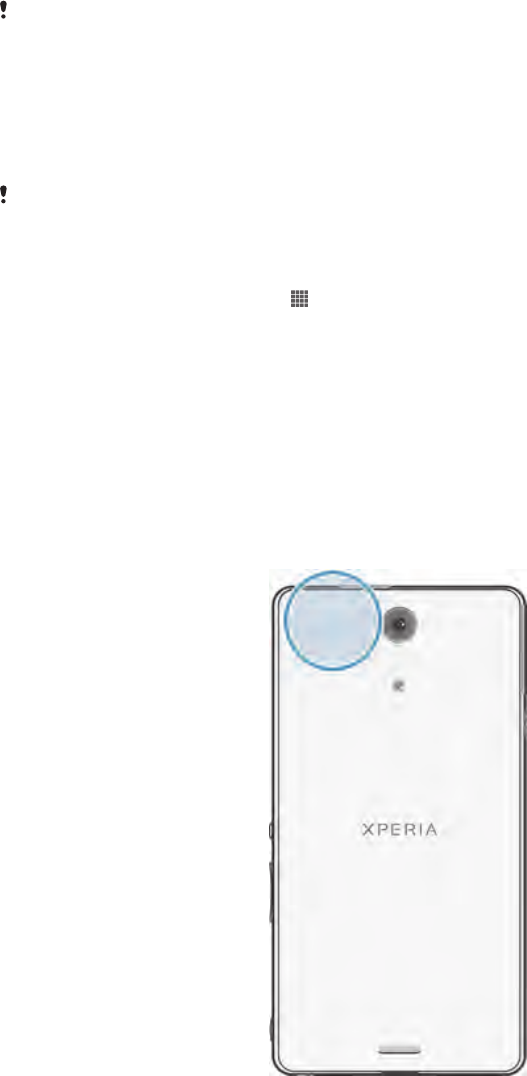
Maps and locations
About location services
Use your device to find out where you are. There are two methods: GPS and wireless
networks. Enable the wireless networks option if you only need your approximate
location, and want it fast. If you want a more exact position, and have a clear view of
the sky, enable the GPS option. In situations where the wireless network connection
is weak, you should enable both options to ensure that your location is found.
Sony does not warrant the accuracy of any location services including but not limited to
navigational services.
Using GPS
Your device has a global positioning system (GPS) receiver that uses satellite signals
to calculate your location.
When you use features that require the GPS receiver to find your location, make sure you have
a clear view of the sky.
To enable GPS
1From your Home screen, tap .
2Tap Settings > Location services.
3Mark the GPS satellites checkbox.
Getting the best performance
The first time you use the GPS it can take 5 to 10 minutes for your location to be
found. To help the search, make sure you have a clear view of the sky. Stand still and
don't cover the GPS antenna (the highlighted area in the image). The GPS signals can
pass through clouds and plastic, but not through most solid objects such as
buildings and mountains. If your location isn't found after a few minutes, move to
another location.
113
This is an Internet version of this publication. © Print only for private use.

Google Maps™
Track your current location, view real-time traffic situations and receive detailed
directions to your destination. Before taking trips, you can download and save maps
to your memory card to avoid high roaming costs.
The Google Maps™ application requires the use of an Internet connection. You may incur data
connection charges when you connect to the Internet from your device. Contact your network
operator for more information. The Google Maps™ application may not be available in every
market, country or region.
To use Google Maps™
1From your Home screen, tap .
2Find and tap Maps.
If you want to use Google Maps™, you have to enable one of the location methods available
under Settings > Location services.
To learn more about Google Maps™
•When you use Google Maps™, tap , then tap Help.
Viewing your friends’ locations with Google Latitude™
Join Google Latitude™ to view your friends’ locations on maps and share your
location and other information with them.
Using Google Maps™ to get directions
Use the Google Maps™ application to get directions when you travel by foot, public
transportation, or car. You can add a shortcut to a destination on your Home screen
to get quick directions from wherever you are.
When you view a map, you make an Internet connection, and data is transferred to
your device. So it's a good idea to download and save maps to your device before
you take a trip. This way, you can avoid high roaming costs.
Sony does not warrant the accuracy of any directional services.
Using the Navigation application
Use the Navigation application in your device to get turn-by-turn instructions on how
to get places. The directions are both spoken and displayed on the screen.
The Navigation application may not be available in every market.
To start Navigation
1From your Home screen, tap .
2Find and tap Navigation.
114
This is an Internet version of this publication. © Print only for private use.

Calendar and alarm clock
Calendar
Your device has a calendar application for managing your time schedule. If you have
a Google™ account, you can also synchronise the calendar application on your
device with your web calendar.
To set the calendar view
1From your Home screen, tap , then find and tap Calendar.
2Tap Month, Week or Day to select an option.
To view multiple calendars
1From your Home screen, tap , then find and tap Calendar.
2Press , then tap My calendars.
3Select the calendars you want to view.
To create a calendar event
1From your Home screen, tap , then tap Calendar.
2Tap .
3Enter the name, time, location and description for the event.
4Select a reminder for the event. To add a new reminder for the event, tap .
5If desired, tap More and select another option under Repetition.
6Tap Done.
When the appointment time approaches, your device plays a short sound to remind you. Also,
appears in the status bar.
To view a calendar event
1From your Home screen, tap , then tap Calendar.
2Tap the event you want to view.
To change the calendar settings
1From your Home screen, tap , then tap Calendar.
2Press , then tap Settings.
3Tap the setting you want to change, then edit as desired.
Alarm clock
Use your device as an alarm clock and select any sound saved on your device as
your alarm signal. The alarm does not sound if your device is turned off. But it does
sound when the device is set to silent mode.
To open the alarm clock
1From your Home screen, tap .
2Find and tap Alarm & clock.
To set a new alarm
1From your Home screen, tap .
2Find and tap Alarm & clock.
3Tap Add alarm.
4Tap Time and adjust the time by scrolling up and down.
5Tap Done.
6If desired, edit other alarm settings.
7Tap Done.
115
This is an Internet version of this publication. © Print only for private use.

To edit an existing alarm
1From your Home screen, tap .
2Find and tap Alarm & clock.
3Tap the alarm you want to edit.
4Tap Time and adjust the time by scrolling up and down.
5Tap Done.
6If desired, edit other alarm settings.
7Tap Done.
The alarm time format displayed is the same as the format you select for your general time
settings, for example, 12-hour or 24-hour.
To deactivate an alarm
1From your Home screen, tap .
2Find and tap Alarm & clock.
3Tap next to the alarm you want to deactivate.
To activate an existing alarm
1From your Home screen, tap .
2Find and tap Alarm & clock.
3Tap next to the alarm you want to activate.
To delete an alarm
1From your Home screen, tap .
2Find and tap Alarm & clock.
3Touch and hold the alarm you want to delete.
4Tap Delete alarm, then tap Yes.
To set the ringtone for an alarm
1From your Home screen, tap .
2Find and tap Alarm & clock.
3Tap the alarm you want to edit.
4Tap Advanced alarm settings and unmark the Style settings checkbox.
5Tap Alarm sound and select an option.
6Tap Done, then tap Done.
To set a recurring alarm
1From your Home screen, tap .
2Find and tap Alarm & clock.
3Tap the alarm you want to edit.
4Tap Repeat.
5Mark the checkboxes for the desired days, then tap OK.
6Tap Done.
To set the title for an alarm
1From your Home screen, tap .
2Find and tap Alarm & clock.
3Tap the alarm you want to edit.
4Tap Advanced alarm settings, then tap the Alarm text field and enter a name
for the alarm.
5Tap Done.
To activate the vibrate function for an alarm
1From your Home screen, tap .
2Find and tap Alarm & clock.
3Tap the alarm you want to edit.
4Tap Advanced alarm settings, then mark the Vibrate checkbox.
5Tap Done.
116
This is an Internet version of this publication. © Print only for private use.

To set alarms to sound when the device is in silent mode
1From your Home screen, tap .
2Find and tap Alarm & clock, then tap to select an alarm.
3Tap Advanced alarm settings, then mark the Alarm in silent mode checkbox.
4Tap Done.
To snooze an alarm when it sounds
•Tap Snooze - min.
To turn off an alarm when it sounds
•Slide to the right.
117
This is an Internet version of this publication. © Print only for private use.

Support and maintenance
Updating your device
Update your device to the most recent software version to get optimal performance
and the latest enhancements.
You can use the Update center application on your device to run a wireless update or
you can use the PC Companion application on a computer to run an update using a
USB cable connection. If you update wirelessly, then you can use either a mobile
network or a Wi-Fi® network connection. Just make sure you back up and save all
data stored on your device before you update.
When you run an update using the Update center application, a data connection is established
and related charges may be incurred. Also, the availability of updates over a mobile network
depends on your operator. Contact your network operator for more information.
Updating your device wirelessly
Use the Update center application to update your device wirelessly. You can
download software updates manually, or you can allow Update service to update
your device automatically whenever downloads become available. When the
automatic update feature is activated, a notification appears in the status bar every
time an update becomes available.
To download software updates manually from Update center
1From your Home screen, tap .
2Find and tap Update Centre.
3Select the desired application or system update and tap Download, or tap
Update all to download all application updates.
Application updates launch automatically after download. With system updates, wait for your
device to restart, then install the update manually. You may incur data connection charges
when downloading updates over mobile networks.
To activate automatic software updates using the Update Center application
1From your Home screen, tap .
2Find and tap Update Centre.
3Press , then tap Settings.
4Mark the Allow automatic downloads checkbox, then tap Agree. Updates are
now downloaded automatically as soon as they become available.
You may incur data connection charges when downloading updates over mobile networks.
To install system updates
1From your Home screen, tap .
2Find and tap Update Centre.
3Select a system update you want to install, then tap Install.
Updating your device using a USB cable connection
Some updates are not available for wireless download. Notifications appear in the
status bar to inform you of such updates. To download and run the updates, you
need a USB cable and a computer running the PC Companion application. You can
install PC Companion on the computer using installation files saved on your device,
or you can download the application directly from PC Companion.
118
This is an Internet version of this publication. © Print only for private use.

To download the PC Companion application from your device
1Connect your device to a computer using a USB cable.
2When prompted, follow the instructions in your device to launch the installation
of PC Companion on the computer.
PC Companion can also be downloaded from PC Companion.
To download software updates using a USB cable connection
1Install the PC Companion application on the computer you are using, if it is not
already installed.
2Connect your device to the computer using a USB cable.
3Computer: Launch the PC Companion application. After a few moments, PC
Companion detects your device and searches for new software for it.
4Device: When notifications appear in the status bar, follow the on-screen
instructions to carry out the relevant software updates.
To update your device using an Apple® Mac® computer
1Install Sony™ Bridge for Mac application on the Apple® Mac® computer you
are using, if it is not already installed.
2Using a USB cable, connect your device to the Apple® Mac® computer.
3Computer: Launch Sony™ Bridge for Mac application. After a few moments,
Sony™ Bridge for Mac application detects your device and searches for new
software for it.
4Computer: If a new software update is detected, a popup window appears.
Follow the on-screen instructions to carry out the relevant software updates.
Sony™ Bridge for Mac application is downloadable from Bridge for mac.
Backup and restore application
Use the Backup and restore application to make backups of content to a memory
card or a USB storage device. Such backups can be used to restore your content
and some settings in cases where your data gets lost or deleted.
Types of content you can back up
Use the Backup and restore application to back up the following types of data:
•Bookmarks
•Call log
•Contacts
•Applications downloaded from Google Play™
•Multimedia messages
•System settings (such as alarms, ringer volume, and language settings)
•Text messages
You do not need to back up music files and photos or videos taken with the camera. They are
backed up automatically to the device's memory card.
You may incur additional data transmission charges when you restore applications from
Google Play™.
Preparing to use the Backup and restore application
Before backing up your content, you can select the backup destination and the types
of data that you want to back up.
To select the backup destination
1From your Home screen, tap .
2Find and tap Back up & restore.
3Tap Back up.
4Tap the bar under Where to store data.
5Select the destination to which you want to back up your content.
119
This is an Internet version of this publication. © Print only for private use.

To select the data types to back up
1From your Home screen, tap .
2Find and tap Back up & restore.
3Tap Back up.
4Select the data types that you want to back up.
To back up content
1From your Home screen, tap .
2Find and tap Back up & restore.
3Tap Back up, then tap Back up now.
Restoring backed up content using the Backup and restore
application
When you restore backed up content, you must select a backup record to restore
from. If you have backed up content several times, you may have several backup
records. After you select a backup record, you can then select which types of data to
restore.
To restore content from a backup record
1From your Home screen, tap .
2Find and tap Back up & restore.
3Tap Restore.
4Select the record that you want to restore from, then tap Restore now.
Remember that any changes you make to your data and settings after you create a backup will
get deleted during a restore procedure.
Managing backup records
You can delete or rename records of the backups that you make using the Backup &
restore function.
To rename a backup record
1From your Home screen, tap .
2Find and tap Back up & restore.
3Press , then tap Manage backup records.
4Select the backup record that you want to rename.
5Tap .
6Enter a new name and tap Rename.
To delete backup records
1From your Home screen, tap .
2Find and tap Back up & restore.
3Press , then tap Manage backup records.
4Select the backup record that you want to delete, or tap if you want to delete
all records.
5Tap > Delete.
Resetting your device
About resetting your device
You can reset your device to its original settings, with or without deleting all of your
personal data. It is possible to reset your device to the state it was in before you first
turned it on. But before you perform a reset, make sure to back up any important
data saved on your device.
120
This is an Internet version of this publication. © Print only for private use.
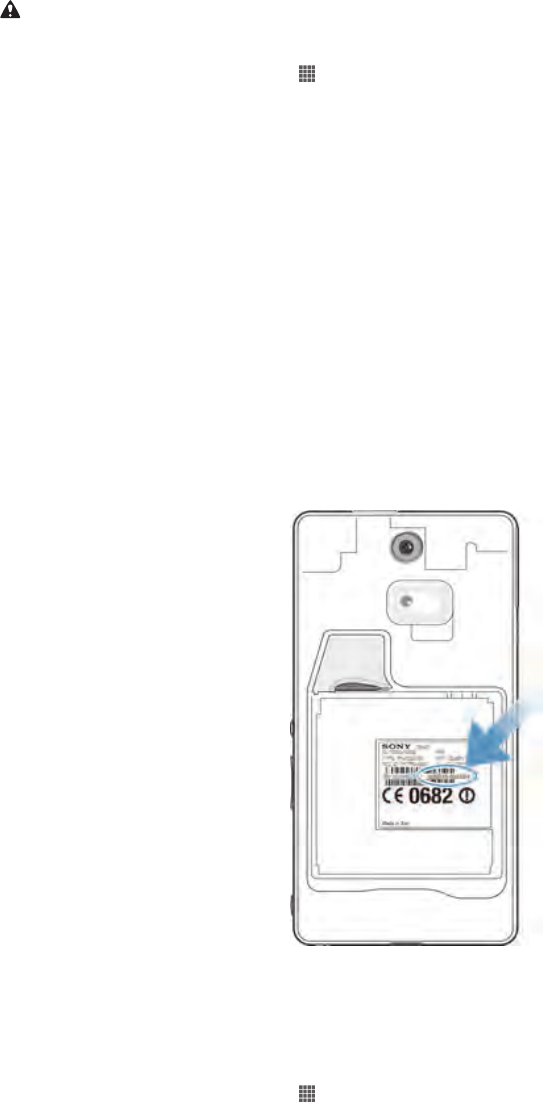
To perform a factory data reset
To avoid permanent damage to your device, do not restart your device while a reset
procedure is underway.
1From your Home screen, tap .
2Find and tap Settings > Backup & reset.
3Tap Factory data reset.
4If you also want to erase data such as pictures and music, which is saved to
your device's internal storage, mark the Erase internal storage checkbox.
5Tap Reset phone.
6To confirm, tap Erase everything.
Locking and protecting your device
IMEI number
Every device has a unique IMEI (International Mobile Equipment Identity) number.
You should keep a copy of this number. If your device is stolen, your network
provider can use your IMEI number to stop the device from accessing the network in
your country.
To view your IMEI number
•Turn off your phone, then remove the battery cover and battery to view your IMEI
number.
•Open the phone dialer on your device and enter *#06#*.
To view your IMEI number in the device
1From your Home screen, tap .
2Find and tap Settings > About phone > Status.
3Scroll to IMEI to view the IMEI number.
Setting a screen lock
There are several ways to lock the screen on your device. For example, you can use
the Face Unlock feature, which uses a picture of your face to unlock the screen. You
can also set a screen unlock pattern, a number-based PIN lock, or a text-based
password.
It is very important that you remember your screen unlock pattern, PIN or password.
If you forget this information, it may not be possible to restore important data such as
contacts and messages. Refer to Sony customer support for more information.
121
This is an Internet version of this publication. © Print only for private use.

To set a screen lock
1From your Home screen, tap > Settings > Security > Screen lock.
2Select an option.
To set up the Face Unlock feature
1From your Home screen, tap > Settings > Security > Screen lock.
2Tap Face Unlock, then follow the instructions in your device to capture your
face.
3After your face is successfully captured, tap Continue.
4Select a backup lock method and follow the instructions in the device to
complete the setup.
The Face Unlock feature is less secure than a screen lock pattern, PIN, or password. Someone
who looks similar to you could unlock your device.
For best results, capture your face in an indoor area that is well lit but not too bright, and hold
the device at eye level.
To unlock the screen using the Face Unlock feature
1Activate the screen.
2Look at your device from the same angle you used to capture your Face
Unlock photo.
If the Face Unlock feature fails to recognise your face, you need to draw the backup pattern
or enter the PIN to unlock the screen.
To disable the Face Unlock protection
1From your Home screen, tap > Settings > Security > Screen lock.
2Draw your backup screen unlock pattern or enter your PIN.
3Tap Swipe.
To create a screen unlock pattern
1From the Home screen, tap .
2Find and tap Settings > Security > Screen lock > Pattern.
3Follow the instructions in your device. You are asked to select a security
question that will be used to unlock the device if you forget your screen unlock
pattern.
To unlock the screen using a screen unlock pattern
1Activate the screen.
2Draw your screen unlock pattern.
If the unlock pattern you draw on the screen is rejected five times in a row, you can select to
either wait 30 seconds and then try again, or to answer the security question you have
selected.
To change the screen unlock pattern
1From your Home screen, tap .
2Find and tap Settings > Security > Screen lock.
3Draw your screen unlock pattern.
4Tap Pattern.
5Follow the instructions in your device.
To disable the screen unlock pattern
1From your Home screen, tap > Settings > Security > Screen lock.
2Draw the screen unlock pattern.
3Tap Swipe.
122
This is an Internet version of this publication. © Print only for private use.

To create a screen unlock PIN
1From your Home screen, tap > Settings > Security > Screen lock > PIN.
2Enter a numeric PIN.
3If necessary, tap to minimise the keyboard.
4Tap Continue.
5Re-enter and confirm your PIN.
6If necessary, tap to minimise the keyboard.
7Tap OK.
To disable the screen unlock PIN
1From your Home screen, tap > Settings > Security > Screen lock.
2Enter your PIN, then tap Next.
3Tap Swipe.
To create a screen lock password
1From your Home screen, tap > Settings > Security > Screen lock >
Password.
2Enter a password.
3If necessary, tap to minimise the keyboard.
4Tap Continue.
5Re-enter and confirm your password.
6If necessary, tap to minimise the keyboard.
7Tap OK.
To disable the screen unlock password
1From your Home screen, tap > Settings > Security > Screen lock.
2Enter your password and tap Continue.
3Tap Swipe.
Support application
To access the support application
1From your Application screen, find and tap .
2Find and tap the required support item.
Recycling your device
Got an old device lying around the house? Why not recycle it? By doing so, you will
help us reuse its materials and components, and you’ll protect the environment, too!
Find out more about the recycling options in your region at blogs.sonymobile.com/
about-us/sustainability/commitment/overview/.
123
This is an Internet version of this publication. © Print only for private use.

Reference
Settings overview
Get to know the settings in your device so that you can personalise them to your own
requirements.
Wi-Fi Turn Wi-Fi® on or off, scan for available Wi-Fi® networks, or add
a Wi-Fi® network.
Bluetooth Turn Bluetooth™ on or off, search for available Bluetooth™
devices, and make your device visible or invisible to other
Bluetooth™ devices.
Data usage Turn the mobile data traffic on or off, and keep track of your data
usage details over a specified period of time.
More… Turn Airplane mode on or off, configure settings for VPN and
mobile networks, and enable your device to share its mobile data
connection as a portable Wi-Fi® hotspot, or via USB tethering or
Bluetooth™ tethering. You can also enable or disable the NFC
function.
Call settings Manage and configure settings for fixed dialing numbers,
voicemail and Internet calls.
Sound Configure how your device rings, vibrates, or alerts you when you
receive communications. You can also use these settings to set
the volume level for music, video, games or other media with
audio, and to make related adjustments.
Display Enable the screen to switch orientation when you rotate your
device. You can also set the brightness, font size, wallpaper and
screen timeout.
Storage Check out the available space on the internal storage and on the
SD card. You can also erase the SD card, or unmount it for safe
removal.
Power
management Turn the power saving modes on or off. You can also view your
battery status and see how different applications consume
battery power.
Apps Manage running applications, downloaded applications and
applications on the SD card.
Xperia™ Access a range of settings tailored to your Xperia device, for
example, USB connection mode, Internet, screen mirroring,
security, and Throw settings.
Location
services Enable or disable access to your location information.
Security Protect your device by setting up different locks and passwords.
You can also allow the installation of applications not from
Google Play™.
Language &
input Select the device language, adjust text input options, add words
to the personal dictionary and configure speech settings.
Backup & reset Back up your data and reset your device.
Setup guide Get help setting up your device.
Add account Add an account on your device, for example, an email account or
a Google™ account.
124
This is an Internet version of this publication. © Print only for private use.

Date & time Set the time and date, or choose the network-provided values.
Select your preferred date and hour format.
Accessibility Enable your installed accessibility services and adjust related
settings.
Developer
options Set options for application development. For example, you can
display CPU usage on the Home screen or set your device to
enter debug mode when USB connections are active.
About phone View information about your device, such as the model number
and signal strength. You can also update your software to the
latest version.
Status and notification icons overview
Status icons
The following status icons may appear on your screen:
Signal strength
No signal
Roaming
GPRS is available
EDGE is available
NFC is activated
3G is available
Sending and downloading GPRS data
Sending and downloading EDGE data
Sending and downloading 3G data
Battery status
The battery is charging
GPS is activated
Airplane mode is activated
The Bluetooth™ function is activated
The SIM card is not inserted
The microphone is muted
The speakerphone is on
Silent mode
Vibrate mode
An alarm is set
Synchronisation is ongoing
Problem with sign-in or synchronisation
A Wi-Fi® connection is enabled and wireless networks are available
125
This is an Internet version of this publication. © Print only for private use.
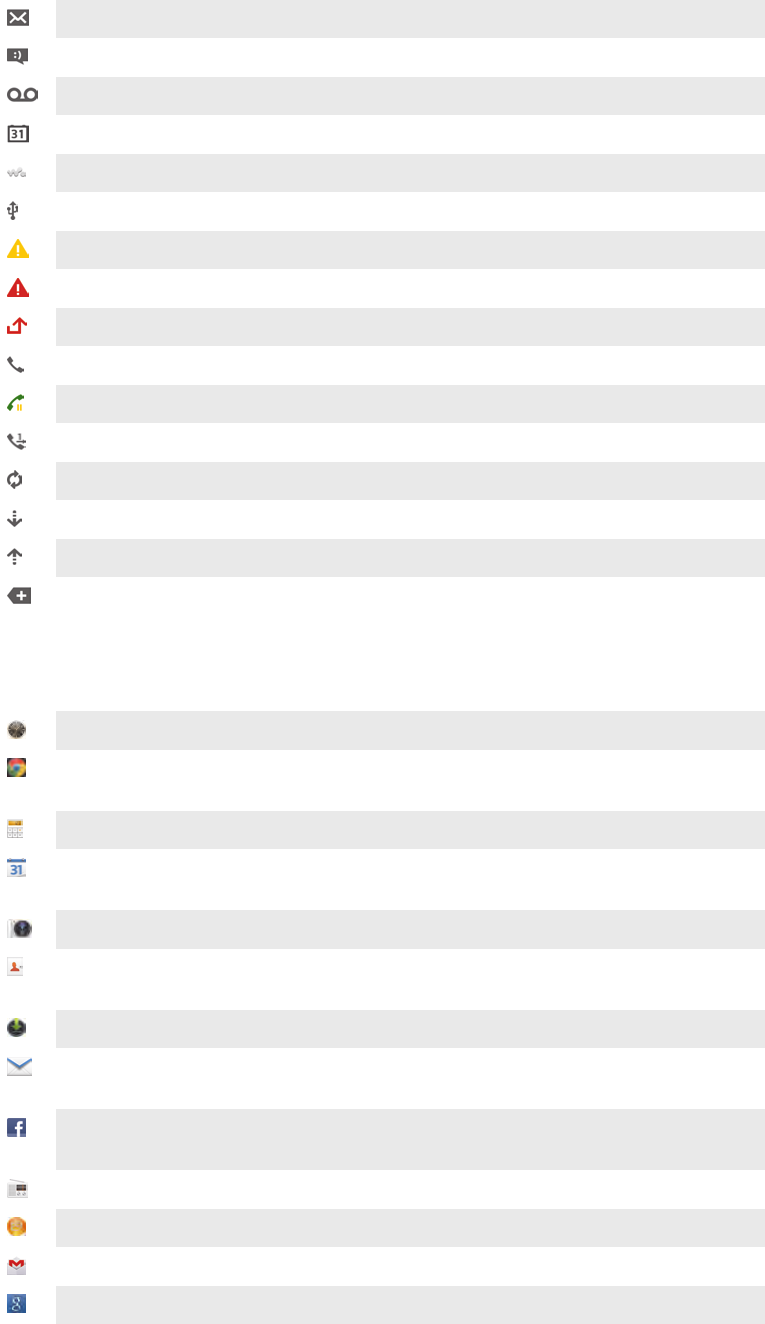
Notification icons
The following notification icons may appear on your screen:
New email message
New text message or multimedia message
New voicemail
An upcoming calendar event
A song is playing
The device is connected to a computer via a USB cable
Warning message
Error message
Missed call
Call ongoing
Call on hold
Call forwarding on
Software updates available
Downloading data
Uploading data
More (undisplayed) notifications
Application overview
Use the Alarm and clock application to set various kinds of alarms.
Use your web browser to navigate and view web pages, manage bookmarks,
and manage text and images.
Use the Calculator application to perform basic calculations.
Use the Calendar application to keep track of your events and manage your
appointments.
Use the camera to take photos and record video clips.
Use the Contact application to manage phone numbers, email address and
other information related to your contacts.
Access your downloaded applications.
Use the Email application to send and receive emails through both private
and corporate accounts.
Use the Facebook application to engage in social networking with friends,
family members and colleagues around the world.
Browse and listen to FM radio stations.
Use the Album application to view and to work with your photos and videos.
Use the Gmail™ application to read, write and organise email messages.
Search for information in your device and on the web.
126
This is an Internet version of this publication. © Print only for private use.
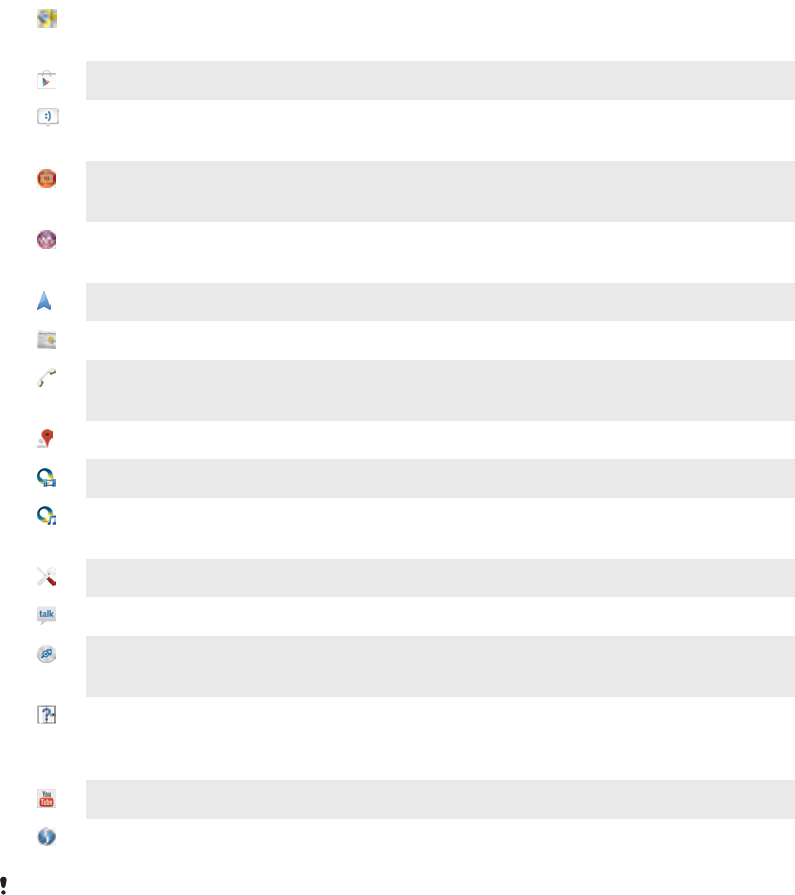
View your current location, find other locations, and calculate routes using
Google Maps™.
Go to Google Play™ to download free and paid applications for your device.
Use the Messaging application to send and receive text and multimedia
messages.
Use the Movies application to play videos in your device, and share videos
with your friends or on other devices using DLNA™.
Use the "WALKMAN" application to organise and play music, audio books
and podcasts.
Navigate your way using spoken, turn-by-turn instructions.
View news stories and weather forecasts.
Make phone calls by dialling the number manually or by using the smart dial
function.
Search for places, for example, restaurants and cafés.
Use the Video Unlimited™ application to rent and purchase videos.
Use the subscription-based Music Unlimited™ application to access millions
of songs over a mobile data connection or Wi-Fi® connection.
Optimise settings to suit your own requirements.
Use the Google Talk™ application to chat with friends online.
Identify music tracks that you hear playing in your surroundings, and get
artist, album and other info.
Use the Help application to access user support in the device. For example,
you can access a User guide, troubleshooting information, plus tips and
tricks.
Use YouTube™ to share and view videos from around the world.
Download and install new applications and updates.
Some applications are not supported all networks and/or service providers in all areas.
127
This is an Internet version of this publication. © Print only for private use.
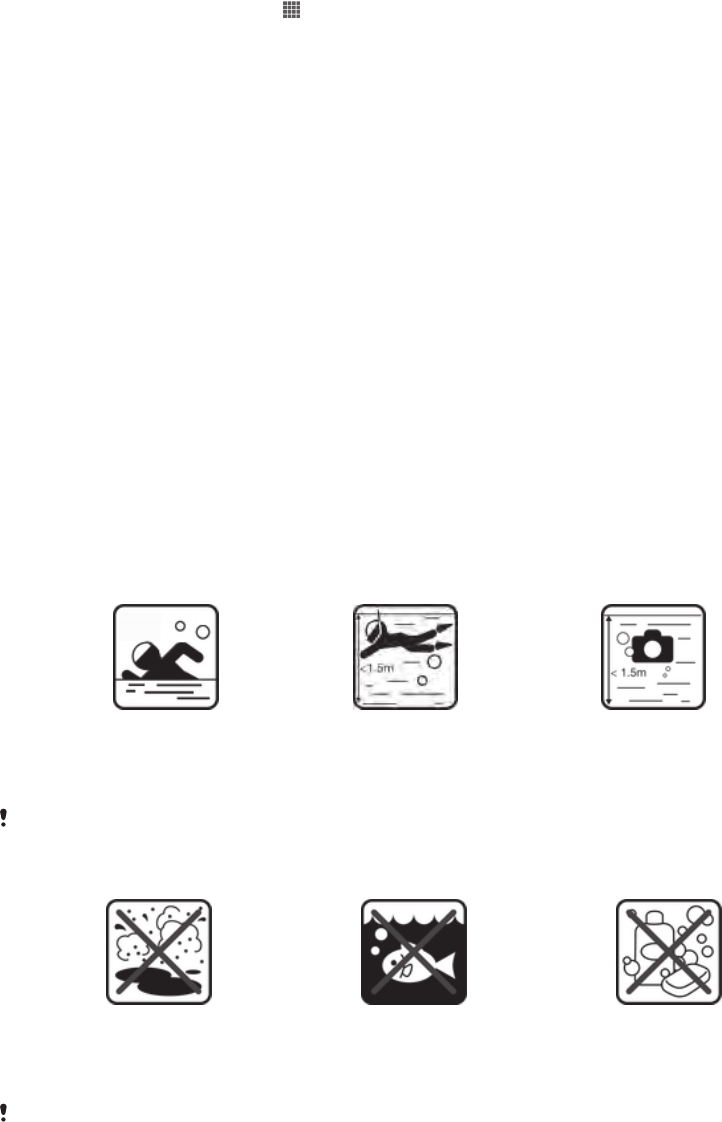
Important information
Important information leaflet
Before you use your device, please read the Important information leaflet provided in
the Setup guide in your device or in the box.
To access the setup guide manually
1From the Home screen, tap .
2Tap Settings > Setup guide.
Limitations to services and features
Some of the services and features described in this User guide are not supported in
all countries/regions or by all networks and/or service providers in all areas. Without
limitation, this applies to the GSM International Emergency Number, 112. Please
contact your network operator or service provider to determine availability of any
specific service or feature and whether additional access or usage fees apply.
Use of certain features and applications described in this guide may require access
to the Internet. You may incur data connection charges when you connect to the
Internet from your device. Contact your wireless service provider for more
information.
Protecting your device from water and dust
In order for your device to be waterproof, the covers for the micro USB port and the
headset jack must be firmly closed. Also, make sure that the battery cover is
attached correctly.
Avoid exposing your device to environments with excessive dust or moisture. Normal
wear and tear along with damage to your device can reduce its ability to resist dust
or moisture. You can use the device in the following fresh (non-saline) water
conditions:
Swimming pool Diving Shooting photos
and videos
You should only use the device in water depths of 1.5 metres or less.
Do not use your device in the following conditions:
Sand/mud Salt water Other liquid
chemicals
Water can sometimes cause unintended touch actions on the screen. So it is recommended to
activate the Touch Block function before using the device in water. You may need to first
download the Touch Block application by using the Update center application in your device.
128
This is an Internet version of this publication. © Print only for private use.

Your smartphone is waterproof and dust resistant in compliance with the Ingress
Protection ratings IP5X, IPX5 and IPX8 (see details below). Always firmly attach all
covers to ensure the water and dust resistance of the device. If liquid is detected
inside the device, for example, underneath one of the covers or on the battery, your
warranty will be void. Never submerge your device in salt water or let the micro USB
port or headset jack come in contact with salt water. Also, never expose the device
to any liquid chemicals, or to moist environments with extreme high or low
temperatures. The waterproof ability of the micro USB port and the headset jack is
not guaranteed in all environments or conditions. After using the device in water, dry
off the areas around the micro USB port cover and the headset jack cover.
If the speaker or microphone get wet, dry these areas and wait for three hours before
using them again. You can, however, use other features in the device that do not
utilise the speaker or microphone.
All compatible accessories, including batteries, chargers, handsfree devices and
micro USB cables, are not waterproof and dust resistant on their own.
Your warranty does not cover damage or defects caused by abuse or improper use
of your device. If you have any further questions about the use of your products, refer
to our Customer support service for help.
IP (Ingress Protection) rating
Your device has an IP rating, which means it has undergone certified tests to
measure its resistance levels to both dust and water. The first digit in the two-digit IP
rating indicates the level of protection against solid objects, including dust. The
second digit indicates how resistant the device is to water. The higher the numbers,
the higher the respective protection.
Your smartphone is waterproof and dust resistant in compliance with the Ingress
Protection ratings IP5X, IPX5 and IPX8 (see details below). These ratings mean that
your device is dust resistant and is protected against low pressure water stream as
well as against the effects of submersion for 30 minutes in fresh (non-saline) water up
to 1.5 metres deep. You can therefore use the device in dusty environments, when
your fingers are wet, and in extreme weather conditions, for example, when it’s
snowing or raining, or when humidity levels are high. You can also use the device in
fresh water conditions (for example, in a swimming pool) to take underwater photos
or shoot underwater videos using the Camera key. See the table below for more
details.
Resistance to solid objects and dust Resistance to water
IP0X. No special protection IPX0. No special protection
IP1X. Protected against solid objects > 50 mm in
diameter IPX1. Protected against dripping water
IP2X. Protected against solid objects > 12.5 mm in
diameter IPX2. Protected against dripping water when tilted
up to 15 degrees from normal position
IP3X. Protected against solid objects > 2.5 mm in
diameter IPX3. Protected against spraying water
IP4X. Protected against solid objects > 1 mm in
diameter IPX4. Protected against splashing water
IP5X. Protected against dust; limited ingress (no
harmful deposit) IPX5. Protected against water jet spray
IP6X. Dust tight IPX6. Protected against heavy jet spray
IPX7. Protected against the effects of immersion
IPX8. Protected against submersion
The IPX5 and IPX8 ratings are based on tests lasting 30 minutes in water depths of 1.5 metres.
Go to www.sonymobile.com/testresults for more information.
129
This is an Internet version of this publication. © Print only for private use.
Legal information
Sony C5503/C5502
This User guide is published by Sony Mobile Communications AB or its local affiliated company, without any
warranty. Improvements and changes to this User guide necessitated by typographical errors, inaccuracies of
current information, or improvements to programs and/or equipment, may be made by Sony Mobile
Communications AB at any time and without notice. Such changes will, however, be incorporated into new
editions of this User guide.
©Sony Mobile Communications AB, 2013.
All rights reserved.
Your mobile phone has the capability to download, store and forward additional content, for example,
ringtones. The use of such content may be restricted or prohibited by rights of third parties, including but not
limited to restriction under applicable copyright laws. You, and not Sony, are entirely responsible for additional
content that you download to or forward from your mobile phone. Prior to your use of any additional content,
please verify that your intended use is properly licensed or is otherwise authorized. Sony does not guarantee
the accuracy, integrity or quality of any additional content or any other third party content. Under no
circumstances will Sony be liable in any way for your improper use of additional content or other third party
content.
This User guide may reference services or applications provided by third parties. Use of such programming or
services may require separate registration with the third party provider and may be subject to additional terms
of use. For applications accessed on or through a third-party website, please review such websites’ terms of
use and applicable privacy policy in advance. Sony does not warrant or guarantee the availability or
performance of any third-party websites or offered services.
Remove the battery to see regulatory information such as the CE mark.
All product and company names mentioned herein are the trademarks or registered trademarks of their
respective owners. Any rights not expressly granted herein are reserved. All other trademarks are property of
their respective owners.
Visit www.sonymobile.com for more information.
All illustrations are for illustration purposes only and may not accurately depict the actual phone.
This product is protected by certain intellectual property rights of Microsoft. Use or distribution of such
technology outside of this product is prohibited without a license from Microsoft.
Content owners use Windows Media digital rights management technology (WMDRM) to protect their
intellectual property, including copyrights. This device uses WMDRM software to access WMDRM-protected
content. If the WMDRM software fails to protect the content, content owners may ask Microsoft to revoke the
software's ability to use WMDRM to play or copy protected content. Revocation does not affect unprotected
content. When you download licenses for protected content, you agree that Microsoft may include a
revocation list with the licenses. Content owners may require you to upgrade WMDRM to access their content.
If you decline an upgrade, you will not be able to access content that requires the upgrade.
This product is licensed under the MPEG-4 visual and AVC patent portfolio licenses for the personal and non-
commercial use of a consumer for (i) encoding video in compliance with the MPEG-4 visual standard
("MPEG-4 video") or the AVC standard ("AVC video") and/or (ii) decoding MPEG- 4 or AVC video that was
encoded by a consumer engaged in a personal and non-commercial activity and/or was obtained from a video
provider licensed by MPEG LA to provide MPEG-4 and/or AVC video. No license is granted or shall be implied
for any other use. Additional information including that relating to promotional, internal and commercial uses
and licensing may be obtained from MPEG LA, L.L.C. See http://www.mpegla.com. MPEG Layer-3 audio
decoding technology licensed from Fraunhofer IIS and Thomson.
130
This is an Internet version of this publication. © Print only for private use.
Index
A
accounts ..................................................................11
Exchange Active Sync® ..................................11
Facebook™ .....................................................11
Google™ .........................................................11
adjusting volume .....................................................59
Airplane mode .........................................................31
alarm ......................................................................115
Album ................................................................81, 82
map .................................................................86
My albums .......................................................83
online albums ..................................................87
opening ...........................................................81
pictures ............................................................82
SensMe™ slideshow .......................................84
thumbnail size .................................................82
viewing ..........................................82, 83, 86, 87
viewing local content .......................................81
viewing online photos ......................................88
Android Market™ - See Google Play™ ..................37
Android™ ..................................................................7
animated wallpaper .................................................20
answering service ....................................................41
applications
arranging .........................................................22
overview ........................................................126
screen ..............................................................20
sorting .............................................................22
audio ........................................................................62
adjusting volume .............................................59
playing .............................................................59
playing tracks in random order .......................62
audio content
related content ................................................60
B
back cover
attaching ............................................................9
removing ............................................................8
backing up
contacts ...................................................49, 119
content ..........................................................119
battery .....................................................................12
Bluetooth™ wireless technology ...........................102
BRAVIA® Engine .....................................................81
brightness ................................................................31
business cards
sending ............................................................48
C
calendar .................................................................115
create an event ..............................................115
calls ...................................................................39, 43
barring .............................................................42
diverting ...........................................................42
emergency .......................................................39
forwarding .......................................................42
log ....................................................................40
missed .............................................................40
multiple ............................................................41
reject ................................................................42
settings ............................................................42
waiting .............................................................41
camera .........................................................70, 72, 77
closing .............................................................70
controls ...........................................................70
face detection ..................................................71
geotagging ......................................................72
icons ................................................................77
overview ..........................................................70
recording videos ........................................76, 77
screen ..............................................................70
self-portraits ....................................................71
settings ......................................................72, 77
smile detection ................................................72
Smile Shutter™ ...............................................72
taking photos ......................................70, 71, 72
using the flash .................................................71
video ................................................................76
viewing photos ................................................71
viewing videos .................................................77
zoom ................................................................71
caps lock .................................................................25
charging ...................................................................12
chat ..........................................................................52
conference calls ......................................................41
connectivity .............................................................94
contacts ...................................................................44
backing up .......................................................49
copying ............................................................49
favourite ...........................................................48
groups .............................................................48
importing from SIM card .................................45
joining contact information ..............................47
picture .............................................................47
sending ............................................................48
sharing .............................................................48
transferring ................................................44, 45
corporate email, calendar and contacts ................110
cropping
photos .............................................................84
D
data traffic ...............................................................34
date
format ..............................................................30
deleting ....................................................................59
an alarm .........................................................115
music ...............................................................65
photos .............................................................85
tracks ...............................................................59
videos ..............................................................86
device
battery .............................................................13
performance ....................................................13
update ...........................................................118
download
Internet settings ...............................................33
driving directions ...................................................114
E
editing
photos .............................................................85
email ........................................................................53
more than one account ...................................53
emergency numbers ................................................39
equaliser ..................................................................59
events
calendar .........................................................115
extensions ...............................................................18
F
face detection ..........................................................71
Facebook™
"Like" a track on Facebook™ .........................60
synchronisation .............................................111
131
This is an Internet version of this publication. © Print only for private use.
Xperia™ with Facebook ................................111
favourites
removing radio channels as ............................68
saving radio channels as .................................68
fixed dialling ............................................................43
flash
using when taking photos ...............................71
Flight mode - See Airplane mode ............................31
FM radio
favourites .........................................................68
selecting a channel ..........................................67
Friends’ music .........................................................62
front camera ............................................................70
G
geotagging
of photos .........................................................72
gesture input ...........................................................27
Gmail™ ....................................................................53
Google Latitude™ .................................................114
Google Maps™ .....................................................114
Google Play™ .........................................................37
Google Talk™ ..........................................................52
Google™ account setup .........................................54
Google™ synchronisation .....................................110
GPS .......................................................................113
H
headset ....................................................................33
using ................................................................33
Home screen ...........................................................18
customising .....................................................19
I
icons ..............................................................125, 126
in the camera ...................................................77
importing SIM contacts ...........................................45
improving photos with Mobile BRAVIA® Engine ....81
infinite button ...........................................................60
instant messaging ...................................................52
Internet
settings ............................................................33
web browser ....................................................93
K
keyboard .................................................................25
settings ............................................................28
keys .........................................................................12
L
language ..................................................................31
writing ..............................................................28
Latitude .................................................................114
LCD backlight control ..............................................31
"Like" a photo on Facebook™ ................................88
"Like" a track on Facebook™ .................................60
"Like" a video on Facebook™ .................................88
live wallpaper ...........................................................20
location ............................................................72, 113
locks
activating the screen .......................................10
locking the screen ...........................................10
screen lock ......................................................10
M
maintenance ..........................................................118
Maps ..............................................................113, 114
marking options .......................................................15
Media Go™ ...........................................................106
messages
settings ............................................................33
MHL (Mobile High-Definition Link) ........................106
micro SIM card
inserting .............................................................9
Microsoft® Exchange synchronisation .................110
Mobile BRAVIA® Engine .........................................81
Movies .....................................................................89
clearing video information ...............................90
Multimedia Messaging Service (MMS)
settings ............................................................33
music ...........................................................33, 58, 63
adjusting volume .............................................59
changing tracks ...............................................59
deleting ............................................................65
downloading music information ......................61
hearing protection ...........................................63
My playlists ......................................................63
pausing a track ................................................59
playing .............................................................59
purchasing .......................................................64
searching using TrackID™ ..............................64
sending ............................................................60
sharing .............................................................64
shortcuts .........................................................61
transferring to your device ..............................58
transferring to/from a computer ......................58
using a headset ...............................................33
viewing artist info ............................................65
Visualiser .........................................................60
music services .........................................................64
Music Unlimited™ ...................................................65
My music .................................................................61
N
Navigation application ...........................................114
notification .............................................................126
light ..................................................................23
panel ..........................................................23, 24
ringtone ...........................................................30
setting ..............................................................24
O
on-screen keyboard ................................................25
overview ..................................................................61
P
pausing a track ........................................................59
personal information ................................................44
phone maintenance ...............................................118
phonebook ..............................................................44
Phonepad ..........................................................25, 27
photo albums
viewing ............................................................81
photos .....................................................................85
adding a geotag ..............................................85
adding the geographical position ....................72
associating with a contact ..............................47
cropping ..........................................................84
deleting ............................................................85
editing ..............................................................85
photo viewer ....................................................82
rotating ............................................................84
selecting ..........................................................82
SensMe™ slideshow .......................................84
sharing .............................................................85
slideshow ........................................................84
taking ...................................................70, 71, 72
transferring to/from a computer ......................58
using as ...........................................................84
viewing ................................................71, 81, 82
viewing on a map ............................................86
viewing same location .....................................72
zooming ...........................................................84
PIN .........................................................................121
132
This is an Internet version of this publication. © Print only for private use.
playing
music ...............................................................59
playlists ....................................................................62
adding a track .................................................62
deleting ............................................................63
playing your own .............................................63
removing tracks ...............................................63
powering off ............................................................10
powering on .............................................................10
presets
removing radio channels as ............................68
saving radio channels as .................................68
protective plastic sheet ...........................................15
PUK .......................................................................121
purchasing
music ...............................................................64
R
radio ........................................................................67
favourites .........................................................68
listening to with the speaker ...........................68
mono sound ....................................................68
moving between channels ..............................67
opening ...........................................................67
radio region .....................................................67
searching for channels ....................................68
selecting a channel ..........................................67
stereo sound ...................................................68
visualizer ..........................................................67
radio sound .............................................................68
receiving items using Bluetooth™ .........................103
recently used applications window .........................21
recommending music ..............................................60
recommending photos and videos ..........................88
recording videos ......................................................70
using the camera key ......................................76
recycling your device ............................................123
resetting .................................................................120
resizing
photos .............................................................84
ringtone .................................................................115
rotating
photos .............................................................84
S
scanning barcodes ................................................107
screen ......................................................................31
cracked ............................................................15
glass ................................................................15
screen unlock pattern ....................................121
warranty ...........................................................15
screen mirroring ....................................................107
searching
music using TrackID™ ....................................64
track information .............................................64
self-portrait ..............................................................70
sending
business cards ................................................48
contacts ...........................................................48
music ...............................................................60
sending items using Bluetooth™ ..................103
SensMe™ channels ................................................62
services ...................................................................11
settings
call ...................................................................42
camera ......................................................72, 77
data usage .......................................................34
Internet ............................................................33
messaging .......................................................33
MMS ................................................................33
quick settings ..................................................23
still camera ......................................................72
video camera ...................................................77
setup guide ..............................................................10
sharing
music ...............................................................64
photos .............................................................85
shuffle music ...........................................................62
silent mode ..............................................................29
SIM card ................................................................121
exporting contacts to ......................................49
importing contacts from ..................................45
slideshow ................................................................84
Smart Connect ......................................................108
smile detection ........................................................72
Smile Shutter™ .......................................................72
SOS - See emergency numbers ..............................39
STAMINA mode
changing settings ............................................14
standby time
estimating ........................................................14
status .....................................................................125
bar ...................................................................23
still camera ........................................................70, 72
settings ............................................................72
support ..................................................................118
Support application ...............................................123
surround sound feature ...........................................59
symbols ...................................................................25
synchronising ........................................................110
Facebook™ contacts, calendar, photos .......111
Google™ contacts, calendar, email ..............110
with Microsoft® Exchange ............................110
T
taking photos ...........................................................70
by tapping .......................................................71
self-portraits ....................................................71
using face detection ........................................71
using smile detection ......................................72
using Smile Shutter™ ......................................72
using the camera key ......................................70
telephony - See calls ...............................................39
tethering
USB tethering ..................................................95
with Xperia Link™ ...........................................95
text input method ....................................................25
themes .....................................................................20
time ..........................................................................30
time management ..................................................115
TrackID™ technology ..............................................64
buying a track ..................................................64
deleting a track ................................................65
opening ...........................................................64
searching for track information .......................64
sharing a track .................................................64
using results ....................................................64
using with the FM Radio .................................69
viewing artist info ............................................65
viewing charts .................................................64
transferring
contacts .....................................................44, 45
turning off ................................................................10
turning on ................................................................10
U
updating your device .............................................118
usage info ................................................................34
USB connection ....................................................104
using Movies ...........................................................89
using the equaliser ..................................................59
133
This is an Internet version of this publication. © Print only for private use.
V
vibration ...........................................................30, 115
video albums
viewing ............................................................81
video camera ...............................................70, 76, 77
recording videos ..............................................77
settings ............................................................77
Video Unlimited™ ....................................................91
buying videos ..................................................91
creating an account .........................................91
menu overview ..........................................91, 92
notifications .....................................................91
renting videos ..................................................91
watching a video .............................................92
videos ......................................................................85
adjusting volume .............................................85
deleting ............................................................86
fast forwarding and rewinding .........................85
pausing ............................................................85
playing .............................................................85
recording ...................................................76, 77
selecting ..........................................................82
sending ............................................................85
sharing .............................................................85
transferring to/from a computer ......................58
viewing ................................................77, 81, 82
viewing
Movies .............................................................89
photos .............................................................71
videos recorded using the camera ..................77
voice input ...............................................................29
voice recognition .....................................................29
voicemail .................................................................41
volume
adjusting for videos .........................................85
key ...................................................................29
W
"WALKMAN" application
adding tracks to playlists ................................62
deleting tracks .................................................59
minimising .......................................................59
overview ..........................................................58
playing tracks in random order .......................62
playlists ...........................................................62
using ................................................................59
using the equaliser ..........................................59
"WALKMAN" application widget .............................63
wallpaper .................................................................20
web browser ............................................................93
widgets ....................................................................19
resizing ............................................................19
wireless networks ..................................................113
Z
zoom ........................................................................71
zooming
photos .............................................................84
134
This is an Internet version of this publication. © Print only for private use.
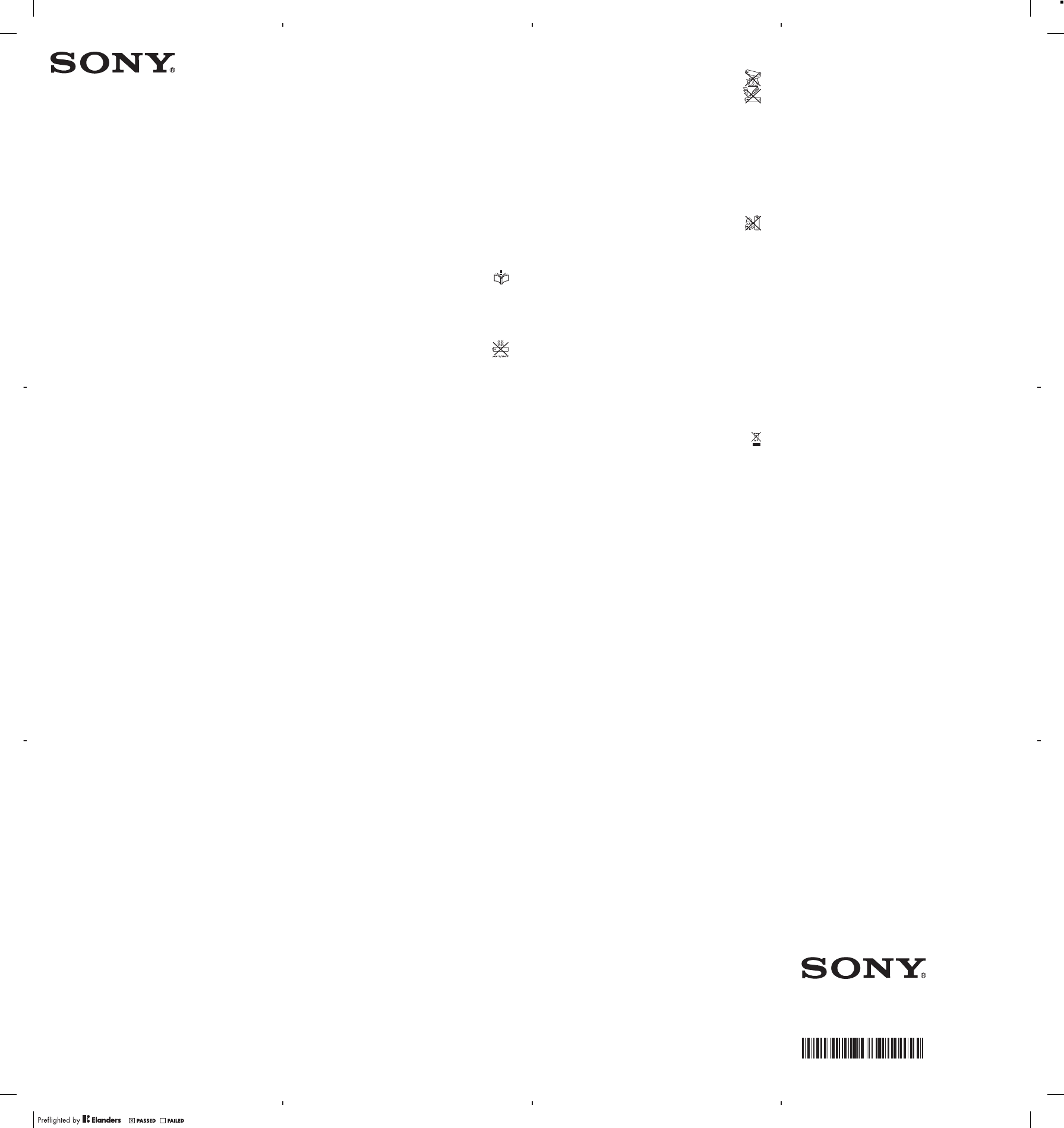
Important information
Sony Consumer Web site
At www.sonymobile.com/support there is a support section where
help and tips are only a few clicks away. Here you will find the latest
computer software updates and tips on how to use your product
more efficiently.
Service and support
You have access to a portfolio of exclusive service advantages
such as:
•Global and local Web sites providing support.
•A global network of Contact Centers.
•An extensive network of Sony service partners.
•A warranty period. Learn more about the warranty conditions in
theLimited warrantysection.
At www.sonymobile.com/support, you can find the latest support
tools and information. For operator-specific services and features,
please contact your network operator.
You can also contact our Contact Centers. If your country/region
is not represented in the list below, please contact your local
dealer. (Calls are charged according to national rates, including
local taxes, unless the phone number is a toll-free number.)
If your product needs service, please contact the dealer from
whom it was purchased, or one of our service partners. For
warranty claims, save proof of purchase.
Guidelines for Safe and Efficient Use
Please follow these guidelines. Failure to do so might entail a
potential health risk or product malfunction. If in doubt as to
its proper function, have the product checked by a certified service
partner before charging or using it.
Recommendations for care and safe use of our products
•Handle with care and keep in a clean and dust-free place.
•Warning! May explode if disposed of in fire.
•Do not expose to liquid or moisture or excess humidity.
•For optimum performance, the product should not be
operated in temperatures below -10°C(+14°F) or above
2
+45°C(+113°F). Do not expose the battery to
temperatures above +60°C(+140°F).
•Do not expose to flames or lit tobacco products.
•Do not drop, throw or try to bend the product.
•Do not paint or attempt to disassemble or modify the
product. Only Sony authorised personnel should perform
service.
•Consult with authorised medical staff and the instructions of the
medical device manufacturer before using the product near
pacemakers or other medical devices or equipment.
•Discontinue use of electronic devices, or disable the radio
transmitting functionality of the device, where required or
requested to do so.
•Do not use where a potentially explosive atmosphere exists.
•Do not place the product, or install wireless equipment, in the
area above an air bag in a car.
•Caution: Cracked or broken displays may create sharp edges or
splinters that could be harmful upon contact.
•Do not use the Bluetooth Headset in positions where it is
uncomfortable or will be subject to pressure.
Children
Warning! Keep out of the reach of children. Do not allow
children to play with mobile phones or accessories. They
could hurt themselves or others. Products may contain small parts
that could become detached and create a choking hazard.
Power supply (Charger)
Connect the charger to power sources as marked on the product.
Do not use outdoors or in damp areas. Do not alter or subject the
cord to damage or stress. Unplug the unit before cleaning it. Never
alter the plug. If it does not fit into the outlet, have a proper outlet
installed by an electrician. When a power supply is connected there
is a small drain of power. To avoid this small energy waste,
disconnect the power supply when the product is fully charged.
Use of charging devices that are not Sony branded may pose
increased safety risks.
3
Battery
New or idle batteries can have short-term reduced capacity. Fully
charge the battery before initial use. Use for the intended purpose
only. Charge the battery in temperatures between +5°C(+41°F) and
+45°C(+113°F). Do not put the battery into your mouth. Do not let
the battery contacts touch another metal object. Turn off the
product before removing the battery. Performance depends on
temperatures, signal strength, usage patterns, features selected
and voice or data transmissions. Only Sony service partners should
remove or replace built-in batteries. Use of batteries that are not
Sony branded may pose increased safety risks. Replace the battery
only with another Sony battery that has been qualified with the
product per the standard IEEE-1725. Use of an unqualified battery
may present a risk of fire, explosion, leakage or other hazard.
Personal medical devices
Mobile phones may affect implanted medical equipment. Reduce
risk of interference by keeping a minimum distance of
15 cm(6 inches) between the phone and the device. Use the phone
at your right ear. Do not carry the phone in your breast pocket. Turn
off the phone if you suspect interference. For use in proximity to
personal medical devices, please consult a physician and the
device manufacturer.
Driving
Some vehicle manufacturers forbid the use of phones in their
vehicles unless a handsfree kit with an external antenna supports
the installation. Check with the vehicle manufacturer's
representative to be sure that the mobile phone or Bluetooth
handsfree will not affect the electronic systems in the vehicle. Full
attention should be given to driving at all times and local laws and
regulations restricting the use of wireless devices while driving must
be observed.
GPS/Location based functions
Some products provide GPS/Location based functions. Location
determining functionality is provided “As is” and “With all faults”.
Sony does not make any representation or warranty as to the
accuracy of such location information.
4
Use of location-based information by the device may not be
uninterrupted or error free and may additionally be dependent on
network service availability. Please note that functionality may be
reduced or prevented in certain environments such as building
interiors or areas adjacent to buildings.
Caution: Do not use GPS functionality in a manner which causes
distraction from driving.
Emergency calls
Calls cannot be guaranteed under all conditions. Never rely solely
upon mobile phones for essential communication. Calls may not be
possible in all areas, on all networks, or when certain network
services and/or phone features are used.
Antenna
Use of antenna devices not marketed by Sony could damage the
phone, reduce performance, and produce SAR levels above the
established limits. Do not cover the antenna with your hand as this
affects call quality, power levels and can shorten talk and standby
times.
Radio Frequency (RF) exposure and Specific Absorption
Rate (SAR)
When the phone or Bluetooth handsfree is turned on, it emits low
levels of radio frequency energy. International safety guidelines
have been developed through periodic and thorough evaluation of
scientific studies. These guidelines establish permitted levels of
radio wave exposure. The guidelines include a safety margin
designed to assure the safety of all persons and to account for any
variations in measurements.
Specific Absorption Rate (SAR) is used to measure radio
frequency energy absorbed by the body when using a mobile
phone. The SAR value is determined at the highest certified power
level in laboratory conditions, but because the phone is designed to
use the minimum power necessary to access the chosen network,
the actual SAR level can be well below this value. There is no proof
of difference in safety based on difference in SAR value.
Products with radio transmitters sold in the US must be certified
by the Federal Communications Commission (FCC). When required,
tests are performed when the phone is placed at the ear and when
5
worn on the body. For body-worn operation, the phone has been
tested when positioned a minimum of 15 mm from the body without
any metal parts in the vicinity of the phone or when properly used
with an appropriate Sony accessory and worn on the body. When
operating with “Hotspot” functionality engaged, a separation
distance of 10mm was used.
For more information about SAR and radio frequency exposure,
go to: www.sonymobile.com/health.
Flight mode
Bluetooth and WLAN functionality, if available in the device, can be
enabled in Flight mode but may be prohibited onboard aircraft or in
other areas where radio transmissions are prohibited. In such
environments, please seek proper authorisation before enabling
Bluetooth or WLAN functionality even in Flight mode.
Malware
Malware (short for malicious software) is software that can harm the
mobile phone or other computers. Malware or harmful applications
can include viruses, worms, spyware, and other unwanted
programs. While the device does employ security measures to
resist such efforts, Sony does not warrant or represent that the
device will be impervious to the introduction of malware. You can
however reduce the risk of malware attacks by using care when
downloading content or accepting applications, refraining from
opening or responding to messages from unknown sources, using
trustworthy services to access the Internet, and only downloading
content to the mobile phone from known, reliable sources.
Accessories
Use only Sony branded original accessories and certified service
partners. Sony does not test third-party accessories. Accessories
may influence RF exposure, radio performance, loudness, electric
safety and other areas. Third-party accessories and parts may pose
a risk to your health or safety or decrease performance.
Accessible Solutions/Special Needs
In the US, compatible Sony Xperia phones may offer compatibility
with TTY terminals (with use of necessary accessory). For more
6
information call the Sony Special Needs Center on 877 878 1996
(TTY) or 877 207 2056 (voice), or go to www.sonyericsson-snc.com.
Disposal of old electrical and electronic equipment and
battery
This symbols on the electronic product or on its packaging
indicates that the electronic product inclusive the battery should
not be treated as household waste. Instead it should be handed
over to the applicable collection point for the recycling of electrical
and electronic equipment. Do not attempt to remove internal
batteries. Internal batteries shall be removed only by a waste
treatment facility or trained service professional.
By ensuring this product is disposed of correctly, you will help
prevent potential negative consequences for the environment and
human health, which could otherwise be caused by inappropriate
waste handling of this product. The recycling of materials will help
to conserve natural resources. For more detailed information about
recycling of this product, please contact your local city office, your
household waste disposal service or the shop where you
purchased the product, by calling a Sony Contact Center or at
www.sonymobile .com/recycling.
Memory card
If the product comes complete with a removable memory card, it is
generally compatible with the handset purchased but may not be
compatible with other devices or the capabilities of their memory
cards. Check other devices for compatibility before purchase or
use. If the product is equipped with a memory card reader, check
memory card compatibility before purchase or use.
Memory cards are generally formatted prior to shipping. To
reformat the memory card, use a compatible device. Do not use the
standard operating system format when formatting the memory
card on a PC. For details, refer to the operating instructions of the
device or contact customer support.
SIM card
If your phone is equipped with a standard-sized SIM card slot,
inserting an incompatible SIM card (for example, a micro SIM card,
a micro SIM card with a non-Sony adapter, or a standard SIM card
cut into a micro SIM card size) in the SIM card slot may damage
7
your SIM card or your phone permanently. Sony does not warrant
and will not be responsible for any damage caused by use of
incompatible or modified SIM cards.
For Devices Supporting 3D Viewing capabilities
In viewing 3D images shot with this phone on a 3D-compatible
monitor, you may experience discomfort in the form of eye strain,
fatigue, or nausea. To prevent these symptoms, we recommend
that you take regular breaks. However, you need to determine for
yourself the length and frequency of breaks you require, as they
vary according to the individual. If you experience any type of
discomfort, stop viewing the 3D images until you feel better, and
consult a physician as necessary. Also refer to the operating
instructions supplied with the device or software you have
connected or are using with this phone. Note that a child’s eyesight
is still at the development stage (particularly children below the age
of 6). Consult a pediatrician or ophthalmologist before letting your
child view 3D images, and make sure he/she observes the above
precautions when viewing such images.
Warning!
If the device requires an adapter for insertion into the handset or
another device, do not insert the card directly without the required
adapter.
Precautions on memory card use
•Do not expose the memory card to moisture.
•Do not touch terminal connections with your hand or any metal
object.
•Do not strike, bend, or drop the memory card.
•Do not attempt to disassemble or modify the memory card.
•Do not use or store the memory card in humid or corrosive
locations or in excessive heat such as a closed car in summer, in
direct sunlight or near a heater, etc.
•Do not press or bend the end of the memory card adapter with
excessive force.
•Do not let dirt, dust, or foreign objects get into the insert port of
any memory card adapter.
•Check you have inserted the memory card correctly.
8
•Insert the memory card as far as it will go into any memory card
adapter needed. The memory card may not operate properly
unless fully inserted.
•We recommend that you make a backup copy of important data.
We are not responsible for any loss or damage to content you
store on the memory card.
•Recorded data may be damaged or lost when you remove the
memory card or memory card adapter, turn off the power while
formatting, reading or writing data, or use the memory card in
locations subject to static electricity or high electrical field
emissions.
Protection of personal information
Erase personal data before disposing of the product. To delete
data, perform a master reset. Deleting data from the phone memory
does not ensure that it cannot be recovered. Sony does not warrant
against recovery of information and does not assume responsibility
for disclosure of any information even after a master reset.
Loudness warning!
Avoid volume levels that may be harmful to your hearing.
End User Licence Agreement
Software delivered with this device and its media is owned by Sony
Mobile Communications AB, and/or its affiliated companies and its
suppliers and licensors.
Sony grants you a non-exclusive limited licence to use the
Software solely in conjunction with the Device on which it is
installed or delivered. Ownership of the Software is not sold,
transferred or otherwise conveyed.
Do not use any means to discover the source code or any
component of the Software, reproduce and distribute the Software,
or modify the Software. You are entitled to transfer rights and
obligations to the Software to a third party, solely together with the
Device with which you received the Software, provided the third
party agrees in writing to be bound by the terms of this Licence.
This licence exists throughout the useful life of this Device. It can
be terminated by transferring your rights to the Device to a third
party in writing.
9
Failure to comply with any of these terms and conditions will
terminate the licence immediately.
Sony and its third party suppliers and licensors retain all rights,
title and interest in and to the Software. To the extent that the
Software contains material or code of a third party, such third
parties shall be beneficiaries of these terms.
This licence is governed by the laws of Sweden. When
applicable, the foregoing applies to statutory consumer rights.
In the event Software accompanying or provided in conjunction
with your device is provided with additional terms and conditions,
such provisions shall also govern your possession and usage of the
Software.
Export regulations
Export regulations: Goods delivered under this Agreement may be
the subject to import and export regulations of the European Union,
the United States and other countries. Purchaser will comply with
these applicable laws and regulations and will obtain and maintain
any export and import license required for the delivery of goods to
Purchaser under this Agreement. Without limiting the foregoing,
and as an example, Purchaser will not knowingly export or re-
export goods to destinations identified pursuant to Articles in
Chapter II of European Council Regulation (EC) 428/2009 and
specifically, and without limitation, Purchaser will also comply with
U.S. government Export Administration Regulations (“EAR”, 15
C.F.R. §§ 730-774, http://www.bis.doc.gov/) administered by
Department of Commerce, Bureau of Industry and Security and
economic sanctions regulations (30 C.F.R. §§ 500 et. seq., http://
www.treas.gov/offices/enforcement/ofac/) administered by the U.S.
Department of Treasury, Office of Foreign Assets Control.
Limited Warranty
Sony Mobile Communications AB, SE-221 88 Lund, Sweden,
(Sony) or its local affiliated company, provides this Limited Warranty
for your mobile phone, original accessory delivered with your
mobile phone, and/or your mobile computing product (hereinafter
referred to as “Product”).
10
Should your Product need warranty service, please return it to
the dealer from whom it was purchased, or contact your local Sony
Contact Center (national rates may apply) or visit
www.sonymobile.com to get further information.
Our warranty
Subject to the conditions of this Limited Warranty, Sony warrants
this Product to be free from defects in design, material and
workmanship at the time of its original purchase by a consumer.
This Limited Warranty will last for a period of two (2) years as from
the original date of purchase of the Product for your mobile phone,
and for a period of one (1) year following the original purchase date
of the Product for all original accessories (such as the battery,
charger or handsfree kit) which may be delivered with your mobile
phone.
What we will do
If, during the warranty period, this Product fails to operate under
normal use and service, due to defects in design, materials or
workmanship, Sony authorised distributors or service partners, in
the country/region* where you purchased the Product, will, at their
option, either repair or replace the Product in accordance with the
terms and conditions stipulated herein.
Sony and its service partners reserve the right to charge a
handling fee if a returned Product is found not to be under warranty
according to the conditions below.
Please note that some of your personal settings, downloads and
other information may be lost when your Sony Product is repaired
or replaced. At present, Sony may be prevented by applicable law,
other regulation or technical restrictions from making a backup
copy of certain downloads. Sony does not take any responsibility
for any lost information of any kind and will not reimburse you for
any such loss. You should always make backup copies of all the
information stored on your Sony Product such as downloads,
calendar and contacts before handing in your Sony Product for
repair or replacement.
Conditions
1. This Limited Warranty is valid only if the original proof of purchase
for this Product issued by a Sony authorised dealer specifying the
11
www.sonymobile.com
Sony Mobile Communications AB
SE-221 88 Lund, Sweden
1222-9269.9
June 27, 2012 15:00:07
Legal-Leaflets---Generic_EN (24M)_1222-9269.9.pdf 1 of 2

date of purchase and serial number**, is presented with the
Product to be repaired or replaced. Sony reserves the right to
refuse warranty service if this information has been removed or
changed after the original purchase of the Product from the
dealer.
2. If Sony repairs or replaces the Product, the repair for the defect
concerned, or the replaced Product shall be warranted for the
remaining time of the original warranty period or for ninety (90)
days from the date of repair, whichever is longer. Repair or
replacement may involve the use of functionally equivalent
reconditioned units. Replaced parts or components will become
the property of Sony.
3. This warranty does not cover any failure of the Product due to
normal wear and tear, or due to misuse, including but not limited
to use in other than the normal and customary manner, in
accordance with the Sony instructions for use and maintenance
of the Product. Nor does this warranty cover any failure of the
Product due to accident, software or hardware modification or
adjustment, acts of God or damage resulting from liquid.
A rechargeable battery can be charged and discharged more
than a hundred times. However, it will eventually wear out – this is
not a defect and corresponds to normal wear and tear. When the
talk-time or standby time is noticeably shorter, it is time to replace
the battery. Sony recommends that you use only batteries and
chargers approved by Sony.
Minor variations in display brightness and colour may occur
between phones. There may be tiny bright or dark dots on the
display. It occurs when individual dots have malfunctioned and
can not be adjusted. Two defective pixels are deemed
acceptable.
Minor variations in camera image appearance may occur
between phones. This is nothing uncommon and is not regarded
as a defective camera module.
4. Since the cellular system on which the Product is to operate is
provided by a carrier independent from Sony, Sony will not be
responsible for the operation, availability, coverage, services or
range of that system.
5. This warranty does not cover Product failures caused by
installations, modifications, or repair or opening of the Product
performed by a non-Sony authorised person.
12
6. The warranty does not cover Product failures which have been
caused by use of accessories or other peripheral devices which
are not Sony branded original accessories intended for use with
the Product.
Sony disclaims any and all warranties, whether express or
implied, for failures caused to the Product or peripheral devices
as a result of viruses, trojan horses, spyware, or other malicious
software. Sony strongly recommends that you install appropriate
virus protection software on your Product and any peripheral
devices connected to it, as available, and update it regularly, to
better protect your device. It is understood, however, that such
software will never fully protect your Product or its peripheral
devices and Sony disclaims all warranties, whether express or
implied, in case of failure by such antivirus software to fulfil its
intended purpose.
7. Tampering with any of the seals on the Product will void the
warranty.
8. THERE ARE NO EXPRESS WARRANTIES, WHETHER WRITTEN
OR ORAL, OTHER THAN THIS PRINTED LIMITED WARRANTY.
ALL IMPLIED WARRANTIES, INCLUDING WITHOUT LIMITATION
THE IMPLIED WARRANTIES OF MERCHANTABILITY OR
FITNESS FOR A PARTICULAR PURPOSE, ARE LIMITED TO THE
DURATION OF THIS LIMITED WARRANTY. IN NO EVENT SHALL
SONY OR ITS LICENSORS BE LIABLE FOR INCIDENTAL OR
CONSEQUENTIAL DAMAGES OF ANY NATURE WHATSOEVER,
INCLUDING BUT NOT LIMITED TO LOST PROFITS OR
COMMERCIAL LOSS TO THE FULL EXTENT THOSE DAMAGES
CAN BE DISCLAIMED BY LAW.
Some countries/states do not allow the exclusion or limitation of
incidental or consequential damages, or limitation of the duration of
implied warranties, so the preceding limitations or exclusions may
not apply to you.
The warranty provided does not affect the consumer’s statutory
rights under applicable legislation in force, nor the consumer’s
rights against the dealer arising from their sales / purchase
contract.
*Geographical scope of the warranty
If you have purchased your Product in a country member of the
European Economic Area (EEA) or in Switzerland or the Republic of
13
Turkey, and such Product was intended for sale in the EEA or in
Switzerland or in Turkey, you can have your Product serviced in any
EEA country or in Switzerland or in Turkey, under the warranty
conditions prevailing in the country in which you require servicing,
provided that an identical Product is sold in such country by an
authorised Sony distributor. To find out if your Product is sold in the
country you are in, please call the local Sony Contact Center.
Please observe that certain services may not be available outside
the country of original purchase, for example, due to the fact that
your Product may have an interior or exterior which is different from
equivalent models sold in other countries. Please note in addition
that it may sometimes not be possible to repair SIM-locked
Products.
Our goods come with guarantees that cannot be excluded under
the Australian Consumer Law. If you purchased your product in
Australia, you are entitled to a replacement or refund for a major
failure and compensation for any other reasonably foreseeable loss
or damage. You are also entitled to have the goods repaired or
replaced if the goods fail to be of acceptable quality and the failure
does not amount to a major failure. For warranty service in
Australia, please contact 1300 650 050 or Sony Service Centre, 320
Princes Hwy, ROCKDALE NSW 2216.
** In some countries/regions additional information (such as a
valid warranty card) may be requested.
Trademarks and acknowledgements
The Liquid Identity logo and Xperia are trademarks or registered
trademarks of Sony Mobile Communications AB.
Sony is a trademark or a registered trademark of Sony Corporation.
Ericsson is a trademark or registered trademark of
Telefonaktiebolaget LM Ericsson.
Bluetooth is a trademark or a registered trademark of Bluetooth SIG
Inc. and any use of such mark by Sony is under license.
Other product and company names mentioned herein may be the
trademarks of their respective owners.
Any rights not expressly granted herein are reserved.
14
Anguilla 1-800-080-9518
(Toll Free)
questions.CO@support.sonymobile.co
m
Antigua and
Barbuda
1-800-081-9518
(Toll Free)
questions.CO@support.sonymobile.co
m
Argentina 0800-333-7427
(número gratuito)
questions.CO@support.sonymobile.co
m
Australia 1300 650-050
(Toll Free)
questions.AU@support.sonymobile.co
m
The
Bahamas
1-800-205-6062
(Toll Free)
questions.CO@support.sonymobile.co
m
Barbados 1-800-082-9518
(Toll Free)
questions.CO@support.sonymobile.co
m
Belgique/
België
02-0745 1611 questions.BE@support.sonymobile.co
m
Belize AN 815, PIN
5597 (Toll Free)
questions.CO@support.sonymobile.co
m
Bermuda 1-800-083-9518
(Toll Free)
questions.CO@support.sonymobile.co
m
Bolivia 800-100-542
(número gratuito)
questions.CO@support.sonymobile.co
m
Brasil 4001-0444
(Capitais e
regiões
metropolitanas)
0800 884 0444
(Demais regiões)
questions.BR@support.sonymobile.co
m
Canada 1 866 766 9374
(Toll Free / sans
frais)
questions.CA@support.sonymobile.co
m
Cayman
Islands
1-800-084-9518
(Toll Free)
questions.CO@support.sonymobile.co
m
15
Central and
Southern
Africa
+27 11 506 0123 questions.CF@support.sonymobile.co
m
Česká
republika 844 550 055 questions.CZ@support.sonymobile.co
m
Chile 800-646-425
(número gratuito)
questions.CO@support.sonymobile.co
m
Colombia 01800-0966-080
(número gratuito)
questions.CO@support.sonymobile.co
m
Costa Rica 0 800 011 0400
(número gratuito)
questions.CO@support.sonymobile.co
m
Danmark 3331 2828 questions.DK@support.sonymobile.co
m
Deutschland 0180 534 2020
(ortsübliche
Gebühren)
questions.DE@support.sonymobile.co
m
Dominica 1-800-085-9518
(Toll Free)
questions.CO@support.sonymobile.co
m
Ecuador 1-800-0102-50
(número gratuito)
questions.CO@support.sonymobile.co
m
Eesti 06 032 032 questions.EE@support.sonymobile.co
m
Egypt/رصم 16727 questions.EG@support.sonymobile.co
m
Ελλάδα 801 11 810 810
+30 210 899 19 19
(από κινητό
τηλέφωνο)
questions.GR@support.sonymobile.co
m
El Salvador 800-6323
(número gratuito)
questions.CO@support.sonymobile.co
m
España 902 180 576
(tarifa local)
questions.ES@support.sonymobile.co
m
16
France 09 69 32 21 21
09 69 32 21 22
(Xperia™
uniquement)
questions.FR@support.sonymobile.co
m
Guatemala 1-800-300-0057
(número gratuito)
questions.CO@support.sonymobile.co
m
Haïti/Ayiti AN 193, PIN
5598 (numéro
gratuit / nimewo
gratis)
questions.CO@support.sonymobile.co
m
Honduras AN 8000122,
PIN 5599
(número gratuito)
questions.CO@support.sonymobile.co
m
Hong Kong/
香港
+852 8203 8863 questions.HK@support.sonymobile.co
m
Hrvatska 062 000 000 questions.HR@support.sonymobile.co
m
India/भारत 1800 11 1800
(Toll Free)
+91 (011)
39011111
questions.IN@support.sonymobile.com
Indonesia +62 21 2935
7669
questions.ID@support.sonymobile.com
Ireland 1850 545 888
(Local rate)
questions.IE@support.sonymobile.com
Italia 06 48895206
(tariffa locale)
questions.IT@support.sonymobile.com
Jamaica 1-800-442-3471
(Toll Free)
questions.CO@support.sonymobile.co
m
Κύπρος/
Kıbrıs
0800 90 909 questions.CY@support.sonymobile.co
m
Latvija 67 21 43 01 questions.LV@support.sonymobile.co
m
Lietuva 8 700 55030 questions.LT@support.sonymobile.co
m
17
Magyarorsz
ág
01 880 47 47 questions.HU@support.sonymobile.co
m
Malaysia 1 800-88-7666 questions.MY@support.sonymobile.co
m
Maroc/
+212 2 2958 344 questions.MA@support.sonymobile.co
m
México 0 1800 000 4722
(número gratuito)
questions.MX@support.sonymobile.co
m
Nederland 0900 8998318 questions.NL@support.sonymobile.co
m
Nederlandse
Antillen
001-866-509-86
60 (gratis
nummer)
questions.CO@support.sonymobile.co
m
New
Zealand
0800-100-150
(Toll Free)
questions.NZ@support.sonymobile.co
m
Nicaragua AN 1800-0166,
PIN 5600
(número gratuito)
questions.CO@support.sonymobile.co
m
Norge 815 00 840
(lokaltakst)
questions.NO@support.sonymobile.co
m
Österreich 0810 200 245 questions.AT@support.sonymobile.co
m
Pakistan/
021 - 111 22 55
73
questions.PK@support.sonymobile.co
m
Panamá 00800-787-0009
(número gratuito)
questions.CO@support.sonymobile.co
m
Paraguay 009 800 54
20032 (número
gratuito)
questions.CO@support.sonymobile.co
m
Perú 0800-532-38
(número gratuito)
questions.CO@support.sonymobile.co
m
Philippines/
Pilipinas
+632 479 9777
or 1800 1 853
7669
questions.PH@support.sonymobile.co
m
18
Polska +48 22 22 77
444
questions.PL@support.sonymobile.co
m
Portugal 808 204 466
(chamada local)
questions.PT@support.sonymobile.co
m
República
Dominicana
1-800-751-3370
(número gratuito)
questions.CO@support.sonymobile.co
m
România +40 21 401 0401 questions.RO@support.sonymobile.co
m
Saint Kitts
and Nevis
1-800-087-9518
(Toll Free)
questions.CO@support.sonymobile.co
m
Saint
Vincent and
the
Grenadines
1-800-088-9518
(Toll Free)
questions.CO@support.sonymobile.co
m
Schweiz/
Suisse/
Svizzera
0848 824 040 questions.CH@support.sonymobile .co
m
Singapore +65 6744 0733 questions.SG@support.sonymobile.co
m
Slovenia 0800 81291 questions.si@support.sonymobile.com
Slovensko 02 5443 6443 questions.SK@support.sonymobile.co
m
South Africa 0861 632222 questions.ZA@support.sonymobile.co
m
South
Κorea/대한
민국
(+82) 1588 4170 questions.KO@support.sonymobile.co
m
Suomi 09 299 2000 questions.FI@support.sonymobile.com
Sverige 013 24 45 00
(lokal taxa)
questions.SE@support.sonymobile.co
m
Thailand 001 800 852
7663 or 02401
3030
questions.CO@support.sonymobile.co
m
19
Trinidad and
Tobago
1-800-080-9521
(Toll Free)
questions.CO@support.sonymobile.co
m
Türkiye +90 212 473 77
77
questions.TR@support.sonymobile.co
m
United
Kingdom
08705 237 237
(Local rate)
questions.GB@support.sonymobile.co
m
United
States
1 866 766 9374 questions.US@support.sonymobile.co
m
Uruguay 000-401-787-01
3 (número
gratuito)
questions.CO@support.sonymobile.co
m
Venezuela 0-800-1-00-2250
(número gratuito)
questions.CO@support.sonymobile.co
m
Việt Nam 1900 1525 (miễn
phí)
questions.VN@support.sonymobile .co
m
България 0800 1 8778 questions.BG@support.sonymobile.co
m
Россия 8-800-1008022 questions.RU@support.sonymobile.co
m
Україна +38 044 590
1515
questions.UA@support.sonymobile.co
m
+971 4 3919 880 questions.JO@support.sonymobile.co
m
+971 4 3919 880
(UAE)
questions.AE@support.sonymobile.co
m
+971 4 3919 880 questions.KW@support.sonymobile.co
m
800-8200-727 questions.SA@support.sonymobile.co
m
20
中国 +86 400 810
0000
questions.CN@sonymobile.com
台灣 +886 2
25625511
questions.TW@support.sonymobile.co
m
ไทย 02 2483 030 questions.TH@support.sonymobile.co
m
21
June 27, 2012 15:00:08
Legal-Leaflets---Generic_EN (24M)_1222-9269.9.pdf 2 of 2
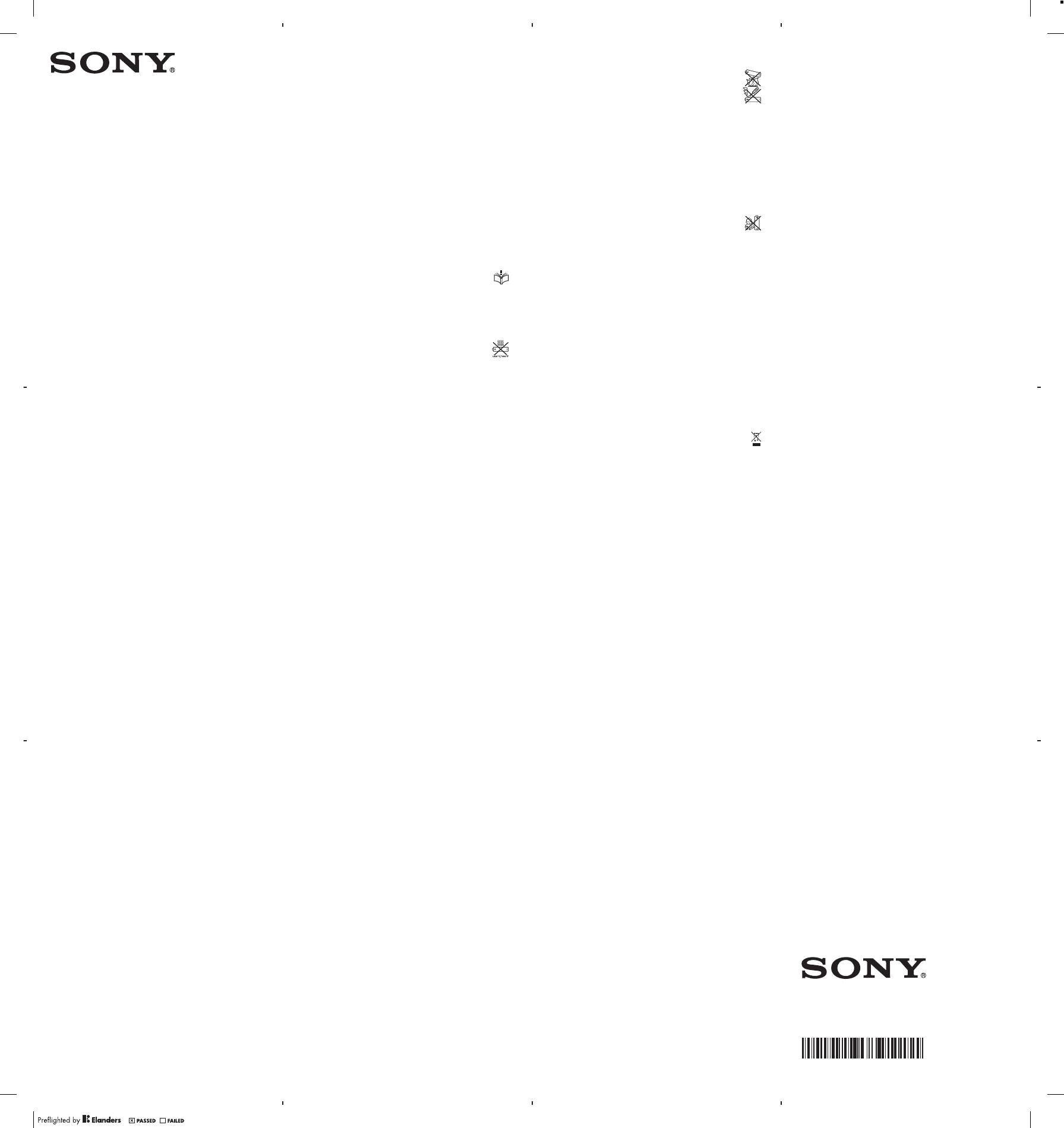
Important information
Sony Consumer Web site
At www.sonymobile.com/support there is a support section where
help and tips are only a few clicks away. Here you will find the latest
computer software updates and tips on how to use your product
more efficiently.
Service and support
You have access to a portfolio of exclusive service advantages
such as:
•Global and local Web sites providing support.
•A global network of Contact Centers.
•An extensive network of Sony service partners.
•A warranty period. Learn more about the warranty conditions in
theLimited warrantysection.
At www.sonymobile.com/support, you can find the latest support
tools and information. For operator-specific services and features,
please contact your network operator.
You can also contact our Contact Centers. If your country/region
is not represented in the list below, please contact your local
dealer. (Calls are charged according to national rates, including
local taxes, unless the phone number is a toll-free number.)
If your product needs service, please contact the dealer from
whom it was purchased, or one of our service partners. For
warranty claims, save proof of purchase.
Guidelines for Safe and Efficient Use
Please follow these guidelines. Failure to do so might entail a
potential health risk or product malfunction. If in doubt as to
its proper function, have the product checked by a certified service
partner before charging or using it.
Recommendations for care and safe use of our products
•Handle with care and keep in a clean and dust-free place.
•Warning! May explode if disposed of in fire.
•Do not expose to liquid or moisture or excess humidity.
•For optimum performance, the product should not be
operated in temperatures below -10°C(+14°F) or above
2
+45°C(+113°F). Do not expose the battery to
temperatures above +60°C(+140°F).
•Do not expose to flames or lit tobacco products.
•Do not drop, throw or try to bend the product.
•Do not paint or attempt to disassemble or modify the
product. Only Sony authorised personnel should perform
service.
•Consult with authorised medical staff and the instructions of the
medical device manufacturer before using the product near
pacemakers or other medical devices or equipment.
•Discontinue use of electronic devices, or disable the radio
transmitting functionality of the device, where required or
requested to do so.
•Do not use where a potentially explosive atmosphere exists.
•Do not place the product, or install wireless equipment, in the
area above an air bag in a car.
•Caution: Cracked or broken displays may create sharp edges or
splinters that could be harmful upon contact.
•Do not use the Bluetooth Headset in positions where it is
uncomfortable or will be subject to pressure.
Children
Warning! Keep out of the reach of children. Do not allow
children to play with mobile phones or accessories. They
could hurt themselves or others. Products may contain small parts
that could become detached and create a choking hazard.
Power supply (Charger)
Connect the charger to power sources as marked on the product.
Do not use outdoors or in damp areas. Do not alter or subject the
cord to damage or stress. Unplug the unit before cleaning it. Never
alter the plug. If it does not fit into the outlet, have a proper outlet
installed by an electrician. When a power supply is connected there
is a small drain of power. To avoid this small energy waste,
disconnect the power supply when the product is fully charged.
Use of charging devices that are not Sony branded may pose
increased safety risks.
3
Battery
New or idle batteries can have short-term reduced capacity. Fully
charge the battery before initial use. Use for the intended purpose
only. Charge the battery in temperatures between +5°C(+41°F) and
+45°C(+113°F). Do not put the battery into your mouth. Do not let
the battery contacts touch another metal object. Turn off the
product before removing the battery. Performance depends on
temperatures, signal strength, usage patterns, features selected
and voice or data transmissions. Only Sony service partners should
remove or replace built-in batteries. Use of batteries that are not
Sony branded may pose increased safety risks. Replace the battery
only with another Sony battery that has been qualified with the
product per the standard IEEE-1725. Use of an unqualified battery
may present a risk of fire, explosion, leakage or other hazard.
Personal medical devices
Mobile phones may affect implanted medical equipment. Reduce
risk of interference by keeping a minimum distance of
15 cm(6 inches) between the phone and the device. Use the phone
at your right ear. Do not carry the phone in your breast pocket. Turn
off the phone if you suspect interference. For use in proximity to
personal medical devices, please consult a physician and the
device manufacturer.
Driving
Some vehicle manufacturers forbid the use of phones in their
vehicles unless a handsfree kit with an external antenna supports
the installation. Check with the vehicle manufacturer's
representative to be sure that the mobile phone or Bluetooth
handsfree will not affect the electronic systems in the vehicle. Full
attention should be given to driving at all times and local laws and
regulations restricting the use of wireless devices while driving must
be observed.
GPS/Location based functions
Some products provide GPS/Location based functions. Location
determining functionality is provided “As is” and “With all faults”.
Sony does not make any representation or warranty as to the
accuracy of such location information.
4
Use of location-based information by the device may not be
uninterrupted or error free and may additionally be dependent on
network service availability. Please note that functionality may be
reduced or prevented in certain environments such as building
interiors or areas adjacent to buildings.
Caution: Do not use GPS functionality in a manner which causes
distraction from driving.
Emergency calls
Calls cannot be guaranteed under all conditions. Never rely solely
upon mobile phones for essential communication. Calls may not be
possible in all areas, on all networks, or when certain network
services and/or phone features are used.
Antenna
Use of antenna devices not marketed by Sony could damage the
phone, reduce performance, and produce SAR levels above the
established limits. Do not cover the antenna with your hand as this
affects call quality, power levels and can shorten talk and standby
times.
Radio Frequency (RF) exposure and Specific Absorption
Rate (SAR)
When the phone or Bluetooth handsfree is turned on, it emits low
levels of radio frequency energy. International safety guidelines
have been developed through periodic and thorough evaluation of
scientific studies. These guidelines establish permitted levels of
radio wave exposure. The guidelines include a safety margin
designed to assure the safety of all persons and to account for any
variations in measurements.
Specific Absorption Rate (SAR) is used to measure radio
frequency energy absorbed by the body when using a mobile
phone. The SAR value is determined at the highest certified power
level in laboratory conditions, but because the phone is designed to
use the minimum power necessary to access the chosen network,
the actual SAR level can be well below this value. There is no proof
of difference in safety based on difference in SAR value.
Products with radio transmitters sold in the US must be certified
by the Federal Communications Commission (FCC). When required,
tests are performed when the phone is placed at the ear and when
5
worn on the body. For body-worn operation, the phone has been
tested when positioned a minimum of 15 mm from the body without
any metal parts in the vicinity of the phone or when properly used
with an appropriate Sony accessory and worn on the body. When
operating with “Hotspot” functionality engaged, a separation
distance of 10mm was used.
For more information about SAR and radio frequency exposure,
go to: www.sonymobile.com/health.
Flight mode
Bluetooth and WLAN functionality, if available in the device, can be
enabled in Flight mode but may be prohibited onboard aircraft or in
other areas where radio transmissions are prohibited. In such
environments, please seek proper authorisation before enabling
Bluetooth or WLAN functionality even in Flight mode.
Malware
Malware (short for malicious software) is software that can harm the
mobile phone or other computers. Malware or harmful applications
can include viruses, worms, spyware, and other unwanted
programs. While the device does employ security measures to
resist such efforts, Sony does not warrant or represent that the
device will be impervious to the introduction of malware. You can
however reduce the risk of malware attacks by using care when
downloading content or accepting applications, refraining from
opening or responding to messages from unknown sources, using
trustworthy services to access the Internet, and only downloading
content to the mobile phone from known, reliable sources.
Accessories
Use only Sony branded original accessories and certified service
partners. Sony does not test third-party accessories. Accessories
may influence RF exposure, radio performance, loudness, electric
safety and other areas. Third-party accessories and parts may pose
a risk to your health or safety or decrease performance.
Accessible Solutions/Special Needs
In the US, compatible Sony Xperia phones may offer compatibility
with TTY terminals (with use of necessary accessory). For more
6
information call the Sony Special Needs Center on 877 878 1996
(TTY) or 877 207 2056 (voice), or go to www.sonyericsson-snc.com.
Disposal of old electrical and electronic equipment and
battery
This symbols on the electronic product or on its packaging
indicates that the electronic product inclusive the battery should
not be treated as household waste. Instead it should be handed
over to the applicable collection point for the recycling of electrical
and electronic equipment. Do not attempt to remove internal
batteries. Internal batteries shall be removed only by a waste
treatment facility or trained service professional.
By ensuring this product is disposed of correctly, you will help
prevent potential negative consequences for the environment and
human health, which could otherwise be caused by inappropriate
waste handling of this product. The recycling of materials will help
to conserve natural resources. For more detailed information about
recycling of this product, please contact your local city office, your
household waste disposal service or the shop where you
purchased the product, by calling a Sony Contact Center or at
www.sonymobile .com/recycling.
Memory card
If the product comes complete with a removable memory card, it is
generally compatible with the handset purchased but may not be
compatible with other devices or the capabilities of their memory
cards. Check other devices for compatibility before purchase or
use. If the product is equipped with a memory card reader, check
memory card compatibility before purchase or use.
Memory cards are generally formatted prior to shipping. To
reformat the memory card, use a compatible device. Do not use the
standard operating system format when formatting the memory
card on a PC. For details, refer to the operating instructions of the
device or contact customer support.
SIM card
If your phone is equipped with a standard-sized SIM card slot,
inserting an incompatible SIM card (for example, a micro SIM card,
a micro SIM card with a non-Sony adapter, or a standard SIM card
cut into a micro SIM card size) in the SIM card slot may damage
7
your SIM card or your phone permanently. Sony does not warrant
and will not be responsible for any damage caused by use of
incompatible or modified SIM cards.
For Devices Supporting 3D Viewing capabilities
In viewing 3D images shot with this phone on a 3D-compatible
monitor, you may experience discomfort in the form of eye strain,
fatigue, or nausea. To prevent these symptoms, we recommend
that you take regular breaks. However, you need to determine for
yourself the length and frequency of breaks you require, as they
vary according to the individual. If you experience any type of
discomfort, stop viewing the 3D images until you feel better, and
consult a physician as necessary. Also refer to the operating
instructions supplied with the device or software you have
connected or are using with this phone. Note that a child’s eyesight
is still at the development stage (particularly children below the age
of 6). Consult a pediatrician or ophthalmologist before letting your
child view 3D images, and make sure he/she observes the above
precautions when viewing such images.
Warning!
If the device requires an adapter for insertion into the handset or
another device, do not insert the card directly without the required
adapter.
Precautions on memory card use
•Do not expose the memory card to moisture.
•Do not touch terminal connections with your hand or any metal
object.
•Do not strike, bend, or drop the memory card.
•Do not attempt to disassemble or modify the memory card.
•Do not use or store the memory card in humid or corrosive
locations or in excessive heat such as a closed car in summer, in
direct sunlight or near a heater, etc.
•Do not press or bend the end of the memory card adapter with
excessive force.
•Do not let dirt, dust, or foreign objects get into the insert port of
any memory card adapter.
•Check you have inserted the memory card correctly.
8
•Insert the memory card as far as it will go into any memory card
adapter needed. The memory card may not operate properly
unless fully inserted.
•We recommend that you make a backup copy of important data.
We are not responsible for any loss or damage to content you
store on the memory card.
•Recorded data may be damaged or lost when you remove the
memory card or memory card adapter, turn off the power while
formatting, reading or writing data, or use the memory card in
locations subject to static electricity or high electrical field
emissions.
Protection of personal information
Erase personal data before disposing of the product. To delete
data, perform a master reset. Deleting data from the phone memory
does not ensure that it cannot be recovered. Sony does not warrant
against recovery of information and does not assume responsibility
for disclosure of any information even after a master reset.
Loudness warning!
Avoid volume levels that may be harmful to your hearing.
End User Licence Agreement
Software delivered with this device and its media is owned by Sony
Mobile Communications AB, and/or its affiliated companies and its
suppliers and licensors.
Sony grants you a non-exclusive limited licence to use the
Software solely in conjunction with the Device on which it is
installed or delivered. Ownership of the Software is not sold,
transferred or otherwise conveyed.
Do not use any means to discover the source code or any
component of the Software, reproduce and distribute the Software,
or modify the Software. You are entitled to transfer rights and
obligations to the Software to a third party, solely together with the
Device with which you received the Software, provided the third
party agrees in writing to be bound by the terms of this Licence.
This licence exists throughout the useful life of this Device. It can
be terminated by transferring your rights to the Device to a third
party in writing.
9
Failure to comply with any of these terms and conditions will
terminate the licence immediately.
Sony and its third party suppliers and licensors retain all rights,
title and interest in and to the Software. To the extent that the
Software contains material or code of a third party, such third
parties shall be beneficiaries of these terms.
This licence is governed by the laws of Sweden. When
applicable, the foregoing applies to statutory consumer rights.
In the event Software accompanying or provided in conjunction
with your device is provided with additional terms and conditions,
such provisions shall also govern your possession and usage of the
Software.
Export regulations
Export regulations: Goods delivered under this Agreement may be
the subject to import and export regulations of the European Union,
the United States and other countries. Purchaser will comply with
these applicable laws and regulations and will obtain and maintain
any export and import license required for the delivery of goods to
Purchaser under this Agreement. Without limiting the foregoing,
and as an example, Purchaser will not knowingly export or re-
export goods to destinations identified pursuant to Articles in
Chapter II of European Council Regulation (EC) 428/2009 and
specifically, and without limitation, Purchaser will also comply with
U.S. government Export Administration Regulations (“EAR”, 15
C.F.R. §§ 730-774, http://www.bis.doc.gov/) administered by
Department of Commerce, Bureau of Industry and Security and
economic sanctions regulations (30 C.F.R. §§ 500 et. seq., http://
www.treas.gov/offices/enforcement/ofac/) administered by the U.S.
Department of Treasury, Office of Foreign Assets Control.
Limited Warranty
Sony Mobile Communications AB, SE-221 88 Lund, Sweden,
(Sony) or its local affiliated company, provides this Limited Warranty
for your mobile phone, original accessory delivered with your
mobile phone, and/or your mobile computing product (hereinafter
referred to as “Product”).
10
Should your Product need warranty service, please return it to
the dealer from whom it was purchased, or contact your local Sony
Contact Center (national rates may apply) or visit
www.sonymobile.com to get further information.
Our warranty
Subject to the conditions of this Limited Warranty, Sony warrants
this Product to be free from defects in design, material and
workmanship at the time of its original purchase by a consumer.
This Limited Warranty will last for a period of two (2) years as from
the original date of purchase of the Product for your mobile phone,
and for a period of one (1) year following the original purchase date
of the Product for all original accessories (such as the battery,
charger or handsfree kit) which may be delivered with your mobile
phone.
What we will do
If, during the warranty period, this Product fails to operate under
normal use and service, due to defects in design, materials or
workmanship, Sony authorised distributors or service partners, in
the country/region* where you purchased the Product, will, at their
option, either repair or replace the Product in accordance with the
terms and conditions stipulated herein.
Sony and its service partners reserve the right to charge a
handling fee if a returned Product is found not to be under warranty
according to the conditions below.
Please note that some of your personal settings, downloads and
other information may be lost when your Sony Product is repaired
or replaced. At present, Sony may be prevented by applicable law,
other regulation or technical restrictions from making a backup
copy of certain downloads. Sony does not take any responsibility
for any lost information of any kind and will not reimburse you for
any such loss. You should always make backup copies of all the
information stored on your Sony Product such as downloads,
calendar and contacts before handing in your Sony Product for
repair or replacement.
Conditions
1. This Limited Warranty is valid only if the original proof of purchase
for this Product issued by a Sony authorised dealer specifying the
11
www.sonymobile.com
Sony Mobile Communications AB
SE-221 88 Lund, Sweden
1222-9269.9
June 27, 2012 15:00:07
Legal-Leaflets---Generic_EN (24M)_1222-9269.9.pdf 1 of 2

date of purchase and serial number**, is presented with the
Product to be repaired or replaced. Sony reserves the right to
refuse warranty service if this information has been removed or
changed after the original purchase of the Product from the
dealer.
2. If Sony repairs or replaces the Product, the repair for the defect
concerned, or the replaced Product shall be warranted for the
remaining time of the original warranty period or for ninety (90)
days from the date of repair, whichever is longer. Repair or
replacement may involve the use of functionally equivalent
reconditioned units. Replaced parts or components will become
the property of Sony.
3. This warranty does not cover any failure of the Product due to
normal wear and tear, or due to misuse, including but not limited
to use in other than the normal and customary manner, in
accordance with the Sony instructions for use and maintenance
of the Product. Nor does this warranty cover any failure of the
Product due to accident, software or hardware modification or
adjustment, acts of God or damage resulting from liquid.
A rechargeable battery can be charged and discharged more
than a hundred times. However, it will eventually wear out – this is
not a defect and corresponds to normal wear and tear. When the
talk-time or standby time is noticeably shorter, it is time to replace
the battery. Sony recommends that you use only batteries and
chargers approved by Sony.
Minor variations in display brightness and colour may occur
between phones. There may be tiny bright or dark dots on the
display. It occurs when individual dots have malfunctioned and
can not be adjusted. Two defective pixels are deemed
acceptable.
Minor variations in camera image appearance may occur
between phones. This is nothing uncommon and is not regarded
as a defective camera module.
4. Since the cellular system on which the Product is to operate is
provided by a carrier independent from Sony, Sony will not be
responsible for the operation, availability, coverage, services or
range of that system.
5. This warranty does not cover Product failures caused by
installations, modifications, or repair or opening of the Product
performed by a non-Sony authorised person.
12
6. The warranty does not cover Product failures which have been
caused by use of accessories or other peripheral devices which
are not Sony branded original accessories intended for use with
the Product.
Sony disclaims any and all warranties, whether express or
implied, for failures caused to the Product or peripheral devices
as a result of viruses, trojan horses, spyware, or other malicious
software. Sony strongly recommends that you install appropriate
virus protection software on your Product and any peripheral
devices connected to it, as available, and update it regularly, to
better protect your device. It is understood, however, that such
software will never fully protect your Product or its peripheral
devices and Sony disclaims all warranties, whether express or
implied, in case of failure by such antivirus software to fulfil its
intended purpose.
7. Tampering with any of the seals on the Product will void the
warranty.
8. THERE ARE NO EXPRESS WARRANTIES, WHETHER WRITTEN
OR ORAL, OTHER THAN THIS PRINTED LIMITED WARRANTY.
ALL IMPLIED WARRANTIES, INCLUDING WITHOUT LIMITATION
THE IMPLIED WARRANTIES OF MERCHANTABILITY OR
FITNESS FOR A PARTICULAR PURPOSE, ARE LIMITED TO THE
DURATION OF THIS LIMITED WARRANTY. IN NO EVENT SHALL
SONY OR ITS LICENSORS BE LIABLE FOR INCIDENTAL OR
CONSEQUENTIAL DAMAGES OF ANY NATURE WHATSOEVER,
INCLUDING BUT NOT LIMITED TO LOST PROFITS OR
COMMERCIAL LOSS TO THE FULL EXTENT THOSE DAMAGES
CAN BE DISCLAIMED BY LAW.
Some countries/states do not allow the exclusion or limitation of
incidental or consequential damages, or limitation of the duration of
implied warranties, so the preceding limitations or exclusions may
not apply to you.
The warranty provided does not affect the consumer’s statutory
rights under applicable legislation in force, nor the consumer’s
rights against the dealer arising from their sales / purchase
contract.
*Geographical scope of the warranty
If you have purchased your Product in a country member of the
European Economic Area (EEA) or in Switzerland or the Republic of
13
Turkey, and such Product was intended for sale in the EEA or in
Switzerland or in Turkey, you can have your Product serviced in any
EEA country or in Switzerland or in Turkey, under the warranty
conditions prevailing in the country in which you require servicing,
provided that an identical Product is sold in such country by an
authorised Sony distributor. To find out if your Product is sold in the
country you are in, please call the local Sony Contact Center.
Please observe that certain services may not be available outside
the country of original purchase, for example, due to the fact that
your Product may have an interior or exterior which is different from
equivalent models sold in other countries. Please note in addition
that it may sometimes not be possible to repair SIM-locked
Products.
Our goods come with guarantees that cannot be excluded under
the Australian Consumer Law. If you purchased your product in
Australia, you are entitled to a replacement or refund for a major
failure and compensation for any other reasonably foreseeable loss
or damage. You are also entitled to have the goods repaired or
replaced if the goods fail to be of acceptable quality and the failure
does not amount to a major failure. For warranty service in
Australia, please contact 1300 650 050 or Sony Service Centre, 320
Princes Hwy, ROCKDALE NSW 2216.
** In some countries/regions additional information (such as a
valid warranty card) may be requested.
Trademarks and acknowledgements
The Liquid Identity logo and Xperia are trademarks or registered
trademarks of Sony Mobile Communications AB.
Sony is a trademark or a registered trademark of Sony Corporation.
Ericsson is a trademark or registered trademark of
Telefonaktiebolaget LM Ericsson.
Bluetooth is a trademark or a registered trademark of Bluetooth SIG
Inc. and any use of such mark by Sony is under license.
Other product and company names mentioned herein may be the
trademarks of their respective owners.
Any rights not expressly granted herein are reserved.
14
Anguilla 1-800-080-9518
(Toll Free)
questions.CO@support.sonymobile.co
m
Antigua and
Barbuda
1-800-081-9518
(Toll Free)
questions.CO@support.sonymobile.co
m
Argentina 0800-333-7427
(número gratuito)
questions.CO@support.sonymobile.co
m
Australia 1300 650-050
(Toll Free)
questions.AU@support.sonymobile.co
m
The
Bahamas
1-800-205-6062
(Toll Free)
questions.CO@support.sonymobile.co
m
Barbados 1-800-082-9518
(Toll Free)
questions.CO@support.sonymobile.co
m
Belgique/
België
02-0745 1611 questions.BE@support.sonymobile.co
m
Belize AN 815, PIN
5597 (Toll Free)
questions.CO@support.sonymobile.co
m
Bermuda 1-800-083-9518
(Toll Free)
questions.CO@support.sonymobile.co
m
Bolivia 800-100-542
(número gratuito)
questions.CO@support.sonymobile.co
m
Brasil 4001-0444
(Capitais e
regiões
metropolitanas)
0800 884 0444
(Demais regiões)
questions.BR@support.sonymobile.co
m
Canada 1 866 766 9374
(Toll Free / sans
frais)
questions.CA@support.sonymobile.co
m
Cayman
Islands
1-800-084-9518
(Toll Free)
questions.CO@support.sonymobile.co
m
15
Central and
Southern
Africa
+27 11 506 0123 questions.CF@support.sonymobile.co
m
Česká
republika 844 550 055 questions.CZ@support.sonymobile.co
m
Chile 800-646-425
(número gratuito)
questions.CO@support.sonymobile.co
m
Colombia 01800-0966-080
(número gratuito)
questions.CO@support.sonymobile.co
m
Costa Rica 0 800 011 0400
(número gratuito)
questions.CO@support.sonymobile.co
m
Danmark 3331 2828 questions.DK@support.sonymobile.co
m
Deutschland 0180 534 2020
(ortsübliche
Gebühren)
questions.DE@support.sonymobile.co
m
Dominica 1-800-085-9518
(Toll Free)
questions.CO@support.sonymobile.co
m
Ecuador 1-800-0102-50
(número gratuito)
questions.CO@support.sonymobile.co
m
Eesti 06 032 032 questions.EE@support.sonymobile.co
m
Egypt/رصم 16727 questions.EG@support.sonymobile.co
m
Ελλάδα 801 11 810 810
+30 210 899 19 19
(από κινητό
τηλέφωνο)
questions.GR@support.sonymobile.co
m
El Salvador 800-6323
(número gratuito)
questions.CO@support.sonymobile.co
m
España 902 180 576
(tarifa local)
questions.ES@support.sonymobile.co
m
16
France 09 69 32 21 21
09 69 32 21 22
(Xperia™
uniquement)
questions.FR@support.sonymobile.co
m
Guatemala 1-800-300-0057
(número gratuito)
questions.CO@support.sonymobile.co
m
Haïti/Ayiti AN 193, PIN
5598 (numéro
gratuit / nimewo
gratis)
questions.CO@support.sonymobile.co
m
Honduras AN 8000122,
PIN 5599
(número gratuito)
questions.CO@support.sonymobile.co
m
Hong Kong/
香港
+852 8203 8863 questions.HK@support.sonymobile.co
m
Hrvatska 062 000 000 questions.HR@support.sonymobile.co
m
India/भारत 1800 11 1800
(Toll Free)
+91 (011)
39011111
questions.IN@support.sonymobile.com
Indonesia +62 21 2935
7669
questions.ID@support.sonymobile.com
Ireland 1850 545 888
(Local rate)
questions.IE@support.sonymobile.com
Italia 06 48895206
(tariffa locale)
questions.IT@support.sonymobile.com
Jamaica 1-800-442-3471
(Toll Free)
questions.CO@support.sonymobile.co
m
Κύπρος/
Kıbrıs
0800 90 909 questions.CY@support.sonymobile.co
m
Latvija 67 21 43 01 questions.LV@support.sonymobile.co
m
Lietuva 8 700 55030 questions.LT@support.sonymobile.co
m
17
Magyarorsz
ág
01 880 47 47 questions.HU@support.sonymobile.co
m
Malaysia 1 800-88-7666 questions.MY@support.sonymobile.co
m
Maroc/
+212 2 2958 344 questions.MA@support.sonymobile.co
m
México 0 1800 000 4722
(número gratuito)
questions.MX@support.sonymobile.co
m
Nederland 0900 8998318 questions.NL@support.sonymobile.co
m
Nederlandse
Antillen
001-866-509-86
60 (gratis
nummer)
questions.CO@support.sonymobile.co
m
New
Zealand
0800-100-150
(Toll Free)
questions.NZ@support.sonymobile.co
m
Nicaragua AN 1800-0166,
PIN 5600
(número gratuito)
questions.CO@support.sonymobile.co
m
Norge 815 00 840
(lokaltakst)
questions.NO@support.sonymobile.co
m
Österreich 0810 200 245 questions.AT@support.sonymobile.co
m
Pakistan/
021 - 111 22 55
73
questions.PK@support.sonymobile.co
m
Panamá 00800-787-0009
(número gratuito)
questions.CO@support.sonymobile.co
m
Paraguay 009 800 54
20032 (número
gratuito)
questions.CO@support.sonymobile.co
m
Perú 0800-532-38
(número gratuito)
questions.CO@support.sonymobile.co
m
Philippines/
Pilipinas
+632 479 9777
or 1800 1 853
7669
questions.PH@support.sonymobile.co
m
18
Polska +48 22 22 77
444
questions.PL@support.sonymobile.co
m
Portugal 808 204 466
(chamada local)
questions.PT@support.sonymobile.co
m
República
Dominicana
1-800-751-3370
(número gratuito)
questions.CO@support.sonymobile.co
m
România +40 21 401 0401 questions.RO@support.sonymobile.co
m
Saint Kitts
and Nevis
1-800-087-9518
(Toll Free)
questions.CO@support.sonymobile.co
m
Saint
Vincent and
the
Grenadines
1-800-088-9518
(Toll Free)
questions.CO@support.sonymobile.co
m
Schweiz/
Suisse/
Svizzera
0848 824 040 questions.CH@support.sonymobile .co
m
Singapore +65 6744 0733 questions.SG@support.sonymobile.co
m
Slovenia 0800 81291 questions.si@support.sonymobile.com
Slovensko 02 5443 6443 questions.SK@support.sonymobile.co
m
South Africa 0861 632222 questions.ZA@support.sonymobile.co
m
South
Κorea/대한
민국
(+82) 1588 4170 questions.KO@support.sonymobile.co
m
Suomi 09 299 2000 questions.FI@support.sonymobile.com
Sverige 013 24 45 00
(lokal taxa)
questions.SE@support.sonymobile.co
m
Thailand 001 800 852
7663 or 02401
3030
questions.CO@support.sonymobile.co
m
19
Trinidad and
Tobago
1-800-080-9521
(Toll Free)
questions.CO@support.sonymobile.co
m
Türkiye +90 212 473 77
77
questions.TR@support.sonymobile.co
m
United
Kingdom
08705 237 237
(Local rate)
questions.GB@support.sonymobile.co
m
United
States
1 866 766 9374 questions.US@support.sonymobile.co
m
Uruguay 000-401-787-01
3 (número
gratuito)
questions.CO@support.sonymobile.co
m
Venezuela 0-800-1-00-2250
(número gratuito)
questions.CO@support.sonymobile.co
m
Việt Nam 1900 1525 (miễn
phí)
questions.VN@support.sonymobile .co
m
България 0800 1 8778 questions.BG@support.sonymobile.co
m
Россия 8-800-1008022 questions.RU@support.sonymobile.co
m
Україна +38 044 590
1515
questions.UA@support.sonymobile.co
m
+971 4 3919 880 questions.JO@support.sonymobile.co
m
+971 4 3919 880
(UAE)
questions.AE@support.sonymobile.co
m
+971 4 3919 880 questions.KW@support.sonymobile.co
m
800-8200-727 questions.SA@support.sonymobile.co
m
20
中国 +86 400 810
0000
questions.CN@sonymobile.com
台灣 +886 2
25625511
questions.TW@support.sonymobile.co
m
ไทย 02 2483 030 questions.TH@support.sonymobile.co
m
21
June 27, 2012 15:00:08
Legal-Leaflets---Generic_EN (24M)_1222-9269.9.pdf 2 of 2
user guide - all parts

User guide
Xperia™ ZR
C5503/C5502
Contents
Xperia™ ZR User guide..................................................................6
Getting started...............................................................................7
Android™ – what and why?...............................................................7
Device overview.................................................................................7
Assembly...........................................................................................8
Turning the device on and off .........................................................10
Screen lock......................................................................................10
Setup guide......................................................................................10
Accounts and services.....................................................................11
Getting to know your device........................................................12
Using the keys.................................................................................12
Battery..............................................................................................12
Using the touchscreen.....................................................................15
Using the lockscreen.......................................................................17
Home screen....................................................................................18
Accessing and using applications...................................................20
Status and notifications...................................................................23
Settings menu..................................................................................24
Typing text.......................................................................................25
Customising your device.................................................................29
Enhancing the sound output............................................................32
Memory............................................................................................32
Using a headset ..............................................................................33
Internet and messaging settings......................................................33
Controlling data usage.....................................................................34
Mobile network settings...................................................................35
Google Play™..............................................................................37
Getting started with Google Play™.................................................37
Downloading from Google Play™....................................................37
Clearing your application data.........................................................37
Permissions......................................................................................38
Installing applications not from Google Play™ ...............................38
Calling..........................................................................................39
Emergency calls...............................................................................39
Call handling....................................................................................39
Voicemail..........................................................................................41
Multiple calls....................................................................................41
Conference calls..............................................................................41
Call settings.....................................................................................42
2
This is an Internet version of this publication. © Print only for private use.
Contacts ......................................................................................44
About Contacts................................................................................44
Transferring contacts to your new device.......................................44
Contacts screen overview...............................................................46
Managing your contacts..................................................................46
Communicating with your contacts.................................................48
Sharing your contacts......................................................................48
Backing up contacts........................................................................49
Messaging....................................................................................50
Using text and multimedia messaging.............................................50
Text and multimedia message options............................................51
Google Talk™ .................................................................................52
Email.............................................................................................53
Getting started with Email................................................................53
Using email......................................................................................54
Socialife™....................................................................................57
Using the Socialife™ application.....................................................57
"WALKMAN" application .............................................................58
About the "WALKMAN" application.................................................58
Transferring media files to your device ...........................................58
Using the "WALKMAN" application ................................................59
Visualiser .........................................................................................60
Getting more information about a track or artist.............................60
Using My music to organise your tracks ........................................60
Managing playlists...........................................................................62
"WALKMAN" application widget ....................................................63
Protecting your hearing....................................................................63
Music services..............................................................................64
TrackID™ technology......................................................................64
Music Unlimited™............................................................................65
About the PlayNow™ service..........................................................65
FM radio.......................................................................................67
About the FM radio..........................................................................67
Using your favourite radio channels................................................68
Sound settings.................................................................................68
Identifying radio tracks using TrackID™..........................................68
Camera.........................................................................................70
About the camera............................................................................70
Using the still camera......................................................................70
Face detection.................................................................................71
Using Smile Shutter™ to capture smiling faces..............................71
Adding the geographical position to your photos...........................72
3
This is an Internet version of this publication. © Print only for private use.
Using still camera settings...............................................................72
Using the video camera...................................................................76
Album...........................................................................................81
About Album....................................................................................81
Mobile BRAVIA® Engine..................................................................81
Viewing photos and videos in the Pictures tab ...............................81
Viewing photos and videos in the My albums tab ..........................82
Viewing your photos on a map........................................................86
Viewing online albums.....................................................................87
Movies..........................................................................................89
About Movies...................................................................................89
Using Movies...................................................................................89
Video Unlimited™........................................................................91
About Video Unlimited™..................................................................91
Renting or buying a video................................................................91
Watching a video from Video Unlimited™.......................................92
Web browser................................................................................93
About the web browser....................................................................93
Connectivity.................................................................................94
Connecting to wireless networks.....................................................94
Sharing content with DLNA Certified™ devices..............................97
NFC..................................................................................................99
Bluetooth™ wireless technology...................................................102
Connecting your device to a computer.........................................104
Connecting your device to a TV set...............................................106
Screen mirroring............................................................................107
Scanning barcodes with the NeoReader™ application.................107
Smart Connect...............................................................................108
Synchronising data on your device............................................110
About synchronising data on your device.....................................110
Synchronising with Google™........................................................110
Synchronising your corporate email, calendar and contacts........110
Synchronising with Facebook™....................................................111
Maps and locations....................................................................113
About location services..................................................................113
Using GPS.....................................................................................113
Google Maps™..............................................................................114
Using Google Maps™ to get directions.........................................114
Calendar and alarm clock..........................................................115
Calendar.........................................................................................115
Alarm clock....................................................................................115
4
This is an Internet version of this publication. © Print only for private use.
Support and maintenance..........................................................118
Updating your device.....................................................................118
Backup and restore application.....................................................119
Resetting your device....................................................................120
Locking and protecting your device..............................................121
Support application.......................................................................123
Recycling your device....................................................................123
Reference...................................................................................124
Settings overview...........................................................................124
Status and notification icons overview..........................................125
Application overview......................................................................126
Important information.................................................................128
Important information leaflet..........................................................128
Limitations to services and features..............................................128
Protecting your device from water and dust.................................128
Legal information...........................................................................130
Index...........................................................................................131
5
This is an Internet version of this publication. © Print only for private use.
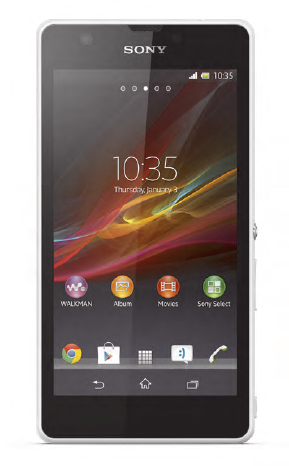
Xperia™ ZR User guide
6
This is an Internet version of this publication. © Print only for private use.
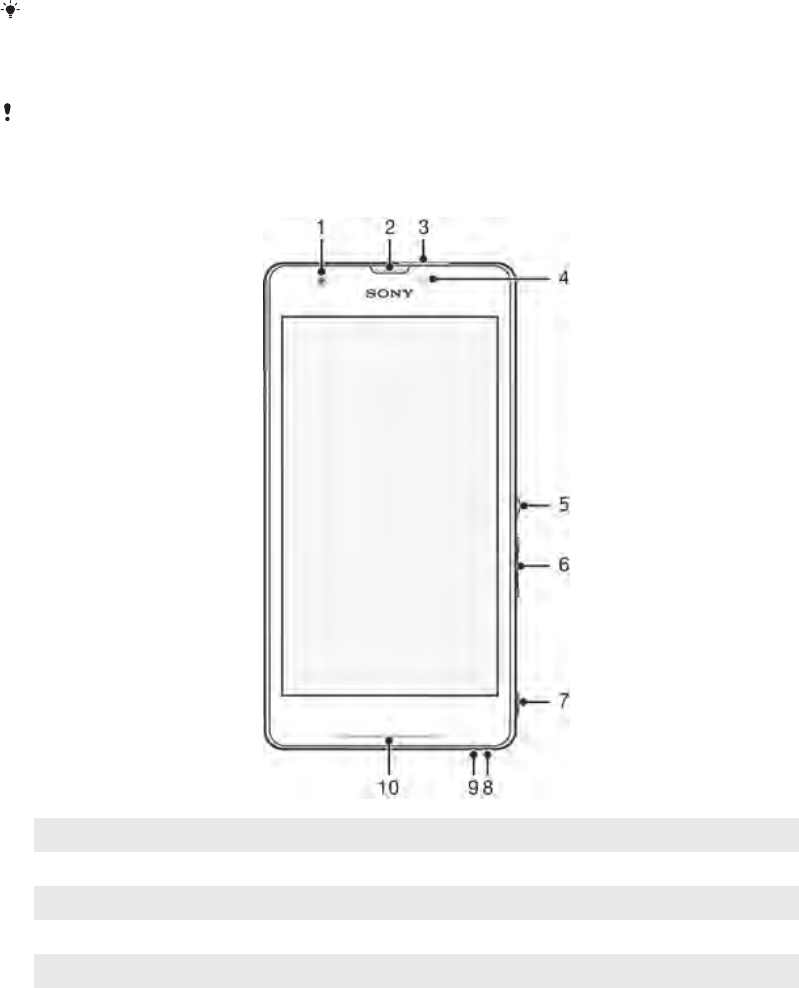
Getting started
Android™ – what and why?
Your Xperia™ from Sony runs on the Android platform. Android devices can perform
many of the same functions as a computer and you can customise them to your own
needs. For example, you can add and delete applications, or enhance existing
applications to improve functionality. On Google Play™ you can download a range of
applications and games from a constantly growing collection. You can also integrate
applications on your Android™ device with other applications and with online
services that you use. For example, you can back up your contacts, access your
different email accounts and calendars from one place, keep track of your
appointments, and engage in social networking.
Android™ devices are constantly evolving. When a new software version is available
and your device supports this new software, you can update your device to get new
features and the latest improvements.
Your Android™ device is pre-loaded with Google™ services. To get the most out of the
provided Google™ services, you should have a Google™ account and sign in to it when you
first start your device. You also need to have Internet access to use many of the features in
Android™.
New software releases may not be compatible with all devices.
Device overview
1Front camera lens
2 Ear speaker
3 Headset jack
4 Light sensor
5 Power key
7
This is an Internet version of this publication. © Print only for private use.
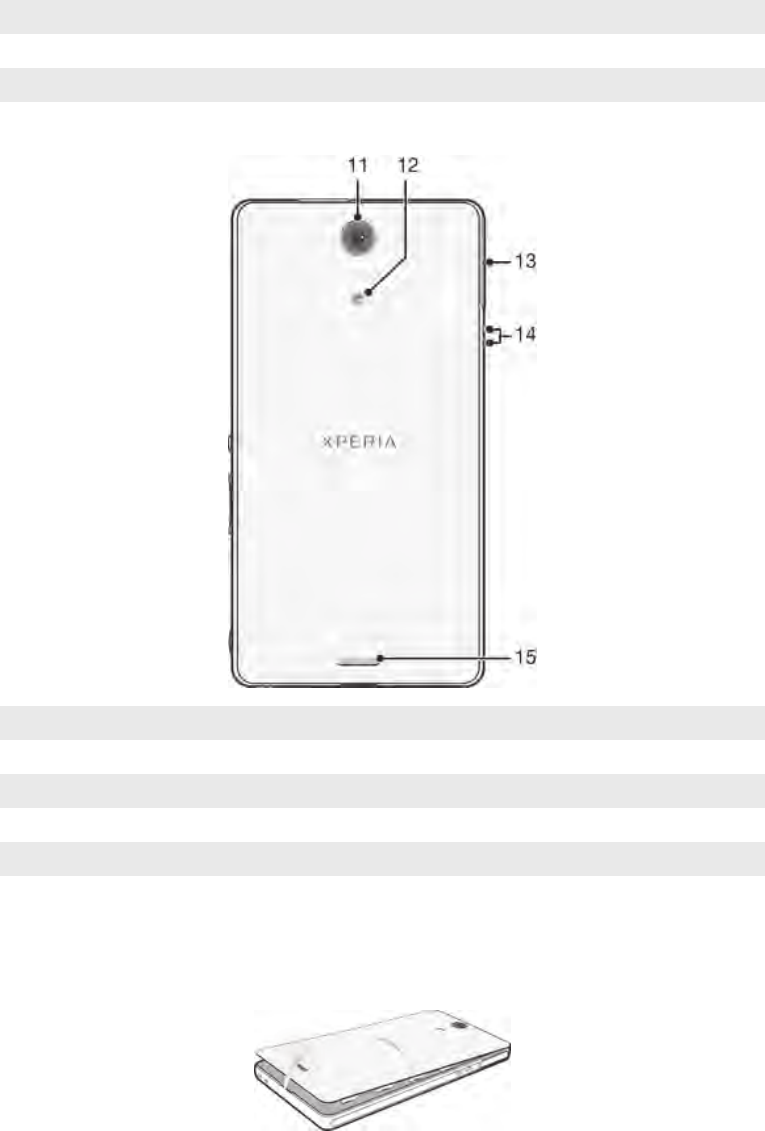
6 Volume/Zoom key
7 Camera key
8 Strap hole
9 Microphone
10 Notification light
11 Camera lens
12 Camera light
13 Port for charger/USB cable
14 Connector for charging dock
15 Speaker
Assembly
To remove the back cover
•Insert a thumbnail into the gap between the back cover and the bottom side of
your device, then lift up the cover.
8
This is an Internet version of this publication. © Print only for private use.
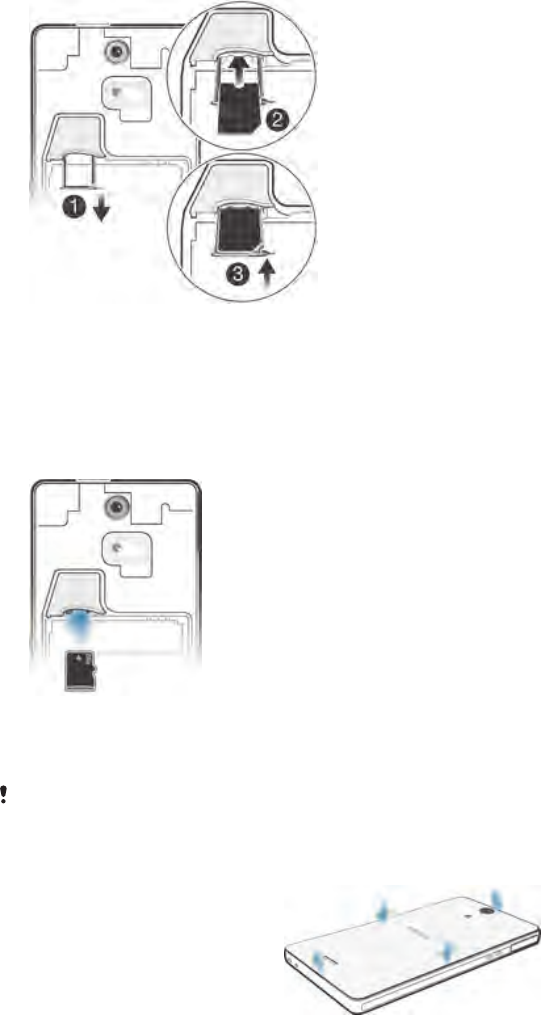
To insert the micro SIM card
1Remove the battery cover and the battery, then pull out the micro SIM card
holder.
2Place the micro SIM card into the micro SIM card holder, with the gold-
coloured contacts facing down.
3Push the micro SIM card and the holder back into the phone.
To insert a memory card
1Remove the back cover and the battery.
2Insert the memory card into the memory card slot, with the gold-coloured
contacts facing down.
The memory card may not be included at purchase in all markets.
To attach the back cover
1Place the back cover over the back of the device, then press down on the top
corners to lock them into place.
2Moving from top to bottom, press down the sides of the cover. The clips on the
inside of the cover make clicking noises as they lock into place.
9
This is an Internet version of this publication. © Print only for private use.
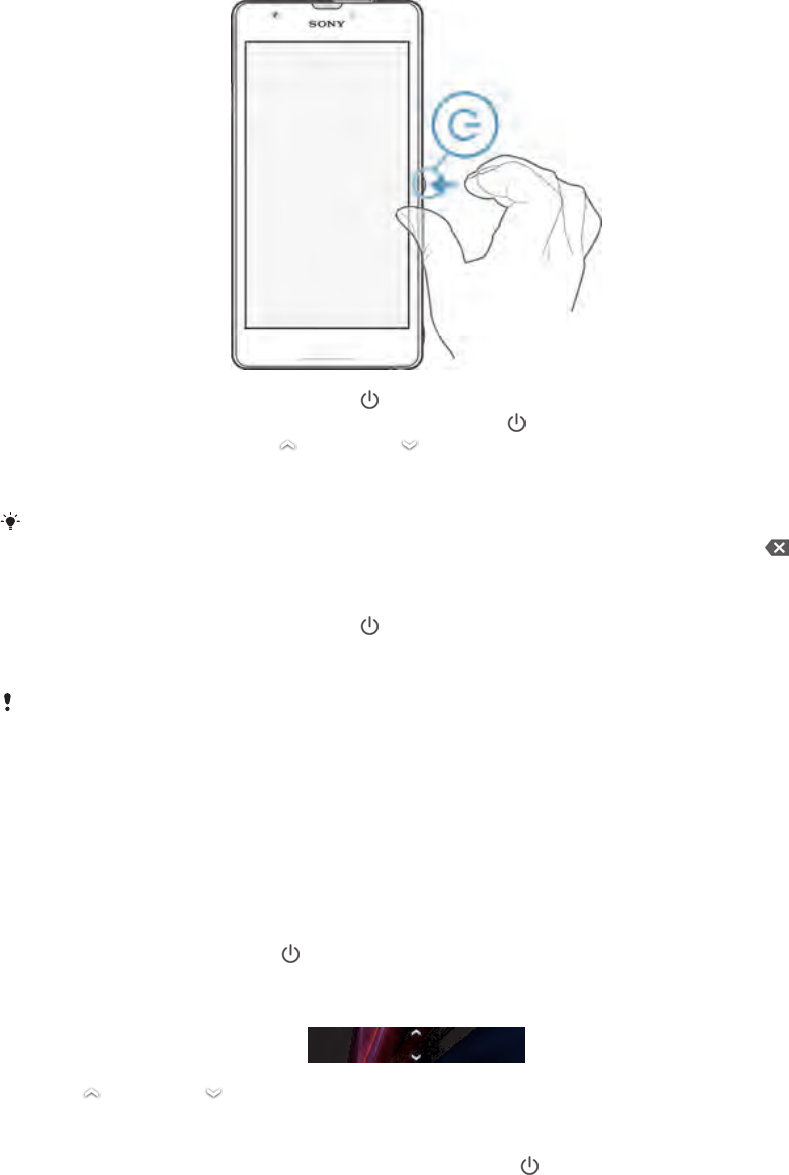
Turning the device on and off
To turn on the device
1Press and hold down the power key until the device vibrates.
2If your screen goes dark, briefly press the power key to activate the screen.
3To unlock the screen, drag up or drag down.
4Enter your SIM card PIN when requested, then select OK.
5Wait a while for the device to start.
Your SIM card PIN is initially supplied by your network operator, but you can change it later
from the Settings menu. To correct a mistake made while entering your SIM card PIN, tap .
To turn off the device
1Press and hold down the power key until the options menu opens.
2In the options menu, tap Power off.
3Tap OK.
It may take a while for the device to shut down.
Screen lock
When your device is on and left idle for a set period of time, the screen darkens to
save battery power, and locks automatically. This lock prevents unwanted actions on
the touchscreen when you are not using it. On the lockscreen, you can still take
photos and play audio tracks.
To activate the screen
•Briefly press the power key .
To unlock the screen
•Drag up or drag down.
To lock the screen manually
•When the screen is active, briefly press the power key .
Setup guide
The first time you start your device, a setup guide opens to explain basic functions
and help you enter essential settings. This is a good time to configure the device to
10
This is an Internet version of this publication. © Print only for private use.

your specific needs. You can also access the setup guide later from the settings
menu.
To access the setup guide manually
1From the Home screen, tap .
2Tap Settings > Setup guide.
Accounts and services
Sign in to your online service accounts from your device to get easy access when
you're on the move. For example, you can integrate contacts from your Google™
account into your phonebook, so you have everything in one place. You can sign up
to new online services from your device as well as from a computer.
Google™ account
Having a Google™ account is key to using a range of applications and services with
your Android device. You need a Google™ account, for example, to use the Gmail™
application in your device, to chat with friends using Google Talk™, and to
synchronise the calendar application on your device with your Google Calendar™.
You also need a Google™ account to download applications and games, music,
movies and books from Google Play™.
Microsoft® Exchange ActiveSync® account
Synchronise your device with your corporate Microsoft® Exchange ActiveSync®
account. This way, you keep your work email, contacts and calendar events with you
at all times.
Facebook™ account
Facebook™ is a social networking service that connects you with friends, family and
colleagues around the world. Set up Facebook to work on your device so that you
can stay in touch from anywhere.
11
This is an Internet version of this publication. © Print only for private use.
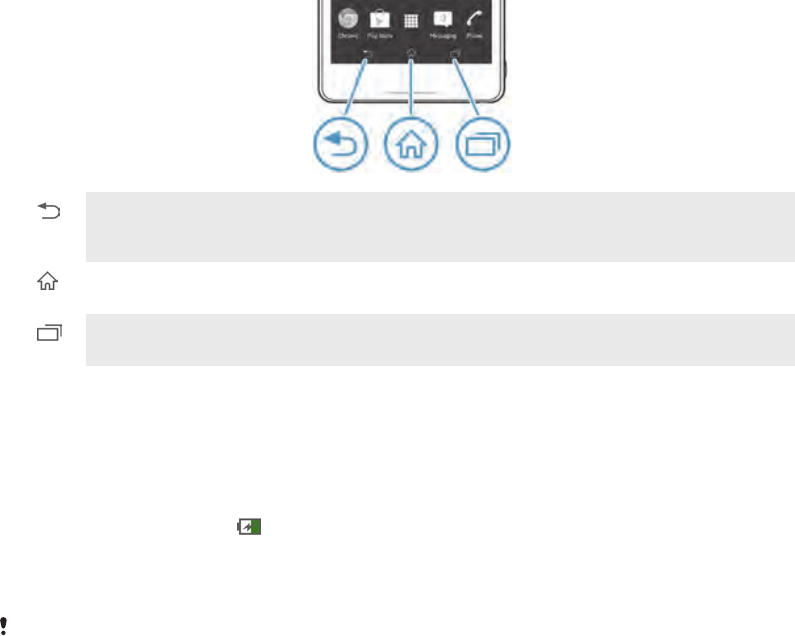
Getting to know your device
Using the keys
Back
•Go back to the previous screen
•Close the on-screen keypad, a dialog box, an options menu, or the Notification panel
Home
•Go to the Home screen
Task
•Tap to open a window showing your most recently used applications and a small apps bar
Battery
Charging the battery
Your battery is partly charged when you buy the device. It may take a few minutes
before the battery icon appears on the screen when you connect the charger
cable to a power source, such as a USB port or a charger. You can still use your
device while it is charging. Charging your device over a long period of time, for
example, overnight, does not damage the battery or the device.
The battery will start to discharge a little after it is fully charged and then charges again after a
certain time when the charger is connected. This is to extend battery life and may result in the
charge status showing a level below 100 percent.
12
This is an Internet version of this publication. © Print only for private use.
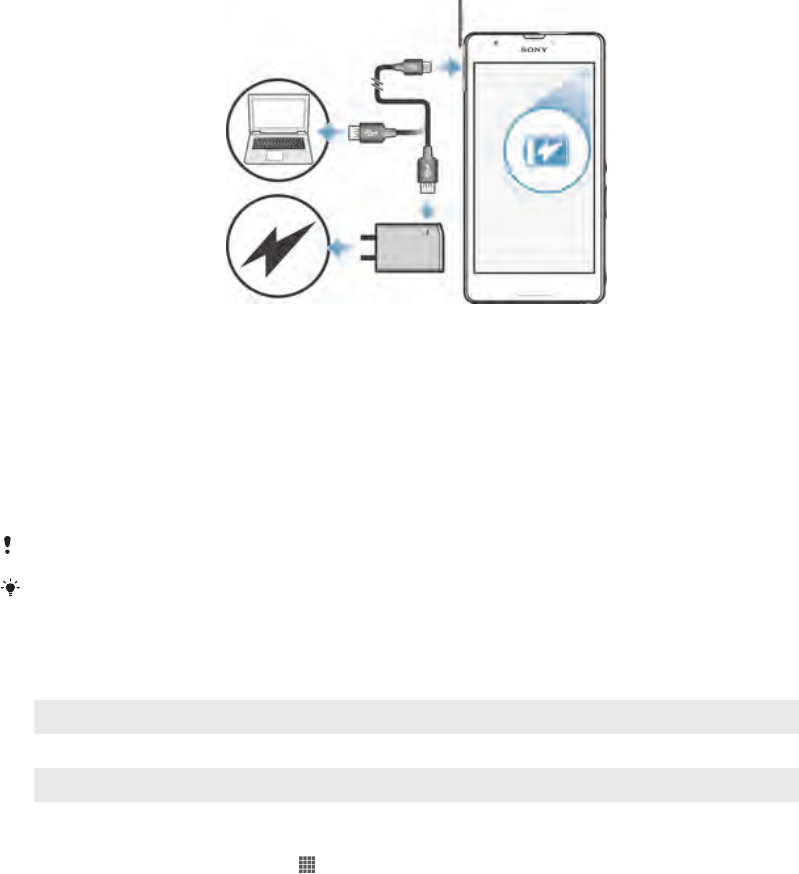
To charge your device
1Plug the charger into a power outlet.
2Plug one end of the USB cable into the charger (or into the USB port of a
computer).
3Plug the other end of the cable into the micro USB port on your device, with
the USB symbol facing up. The battery status LED lights up when charging
starts.
4When the battery status LED is green, the device is fully charged. Disconnect
the USB cable from your device by pulling it straight outwards. Make sure not
to bend the connector when removing the cable from the device.
Use the charger and USB cable provided with the device to ensure faster charging.
If the battery is completely discharged, it may take a few minutes before the LED lights up
after you connect the charger cable to a power source.
Battery LED status
Green The battery is fully charged
Red The battery level is low
Orange The battery is charging. The battery level is between low and full
To check the battery level
1From your Home screen, tap .
2Find and tap Settings > About phone > Status > Battery level.
Improving battery performance
The following tips can help you improve battery performance:
•Charge your device often. This will not affect the lifetime of the battery.
•Downloading data from the Internet is power consuming. When you're not using the
Internet, you can save power by disabling all data connections over mobile networks.
This setting does not prevent your device from transmitting data over other wireless
networks.
•Turn off Bluetooth™ and Wi-Fi® when you don't need these features. You can turn
them on and off more easily by adding the Quick settings widget to your Home
screen.
•Use the STAMINA mode and Low battery mode features to reduce battery
consumption. You can select the power saving mode that best suits the way you use
your device. You can also customise the settings of each power saving mode.
•Set your synchronisation applications (used to synchronise your email, calendar and
contacts) to synchronise manually. You can also synchronise automatically, but
increase the synchronisation intervals.
•Check the battery usage menu in your device to see which applications use the most
power. Your battery consumes more power when you use video and music streaming
13
This is an Internet version of this publication. © Print only for private use.

applications, such as YouTube™. Some applications downloaded from Google
Play™ may also consume more power.
•Close and exit applications that you are not using.
•Lower the screen display brightness level.
•Turn off your device or activate the Airplane mode setting if you are in an area with
no network coverage. Otherwise, your device repeatedly scans for available
networks, and this consumes power.
•Use a Sony original handsfree device to listen to music. Handsfree devices demand
less battery power than your device's own loudspeakers.
•Keep your device in standby mode whenever possible. Standby time refers to the
time during your device is connected to the network and is not being used.
•Disable any live wallpaper.
To access the battery usage menu
1From your Home screen, tap .
2Find and tap Settings > Power management > Battery usage.
To add the Data traffic widget to your Home screen
1Tap and hold an empty area of your Home screen.
2Tap Widgets > Tools.
3Tap and hold the Mobile data widget, then drag it to an empty area of your
Home screen.
To add the Quick settings widget to your Home screen
1Tap and hold an empty area of your Home screen.
2Tap Widgets > Tools.
3Tap and hold the Quick settings widget, then drag it to an empty area of your
Home screen.
Using STAMINA mode
Activate the STAMINA mode feature to pause your Wi-Fi® connection, data traffic
and several power consuming applications when your screen is inactive. When
STAMINA mode is active, you can still receive phone calls, and text and multimedia
messages. You can also set up an applications list to allow some applications to
keep running when your screen is inactive. Once the screen becomes active again, all
paused functions are resumed.
To activate STAMINA mode
1From your Home screen, tap .
2Find and tap Settings > Power management.
3Tap next to STAMINA mode, then tap Activate.
To deactivate STAMINA mode
1From your Home screen, tap .
2Find and tap Settings > Power management.
3Tap next to STAMINA mode.
To change the settings for STAMINA mode
1From your Home screen, tap .
2Find and tap Settings > Power management.
3To open the settings menu, tap STAMINA mode.
4Add or remove applications, as desired.
5When you're finished, tap Done.
Estimating the standby time of your device
Standby time refers to the amount of time the battery can last when your device is
connected to the network but is not in active use, for example, to receive or make
phone calls. STAMINA mode, when activated, continuously evaluates the remaining
standby time, which can vary depending on how you use your device. STAMINA
mode is more effective in lengthening the standby time if you keep the screen of your
14
This is an Internet version of this publication. © Print only for private use.

device locked. If you rarely lock the screen, you may not see much improvement in
battery performance.
When you use your device for the first time, the estimated standby time may not be accurate
since there is no previous usage history to estimate from.
To view the estimated standby time
1From your Home screen, tap .
2Find and tap Settings > Power management.
Using Low battery mode
You can activate the Low battery mode feature when the battery level is low. This
feature helps you to adjust the settings for screen brightness, data traffic and the
vibrate function so that you can reduce battery consumption.
To activate Low battery mode
1From your Home screen, tap .
2Find and tap Settings > Power management.
3Tap next to Low battery mode, then tap Activate.
To deactivate Low battery mode
1From your Home screen, tap .
2Find and tap Settings > Power management.
3Tap next to Low battery mode.
To change the settings for Low battery mode
1From your Home screen, tap .
2Find and tap Settings > Power management.
3To open the settings menu, tap Low battery mode.
4Adjust the settings as desired.
5When you're finished, tap .
Using the touchscreen
A protective plastic sheet is already attached to the screen of your device when you
buy it. You should peel off this sheet before using the touchscreen. Otherwise, the
touchscreen might not function properly.
When your device is on and left idle for a set period of time, the screen darkens to
save battery power, and locks automatically. This lock prevents unwanted actions on
the touchscreen when you are not using it. You can also set personal locks to protect
your subscription and make sure only you can access content on your device.
The device screen is made from glass. Do not touch the screen if the glass is cracked or
shattered. Avoid trying to repair a damaged screen yourself. Glass screens are sensitive to
drops and mechanical shocks. Cases of negligent care are not covered by the Sony warranty
service.
To open or highlight an item
•Tap the item.
Marking options
Marked checkbox
Unmarked checkbox
Marked list option
Unmarked list option
15
This is an Internet version of this publication. © Print only for private use.
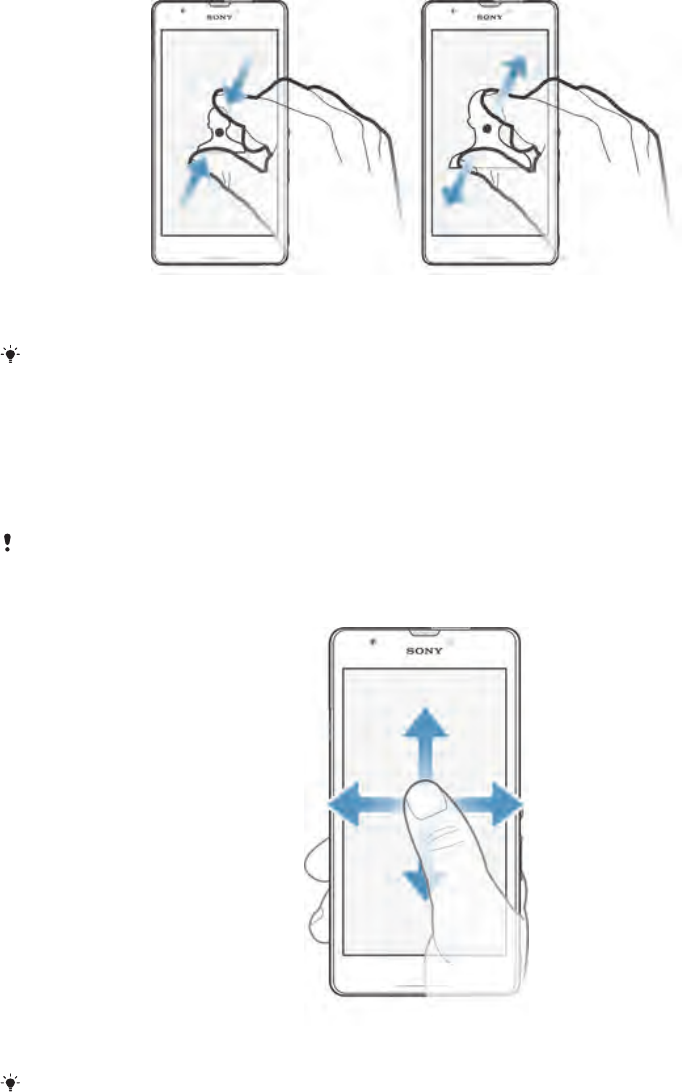
To mark or unmark options
•Tap the relevant checkbox or list option.
Zooming
The zoom options available depend on the application you are using.
To zoom
•Place two fingers on the screen at once and pinch them together (to zoom out)
or spread them apart (to zoom in).
When you use two fingers on the screen to zoom, it is only possible to zoom if both fingers
are within the zoomable area. If you, for example, want to zoom in on a photo, make sure that
both fingers are within the photo frame area.
Scrolling
Scroll by moving your finger up or down on the screen. On some web pages you can
also scroll to the sides.
Dragging or flicking will not activate anything on the screen.
To scroll
•Drag or flick your finger in the direction you want to scroll on the screen.
To scroll more quickly, flick your finger in the direction you want to go on the screen.
16
This is an Internet version of this publication. © Print only for private use.
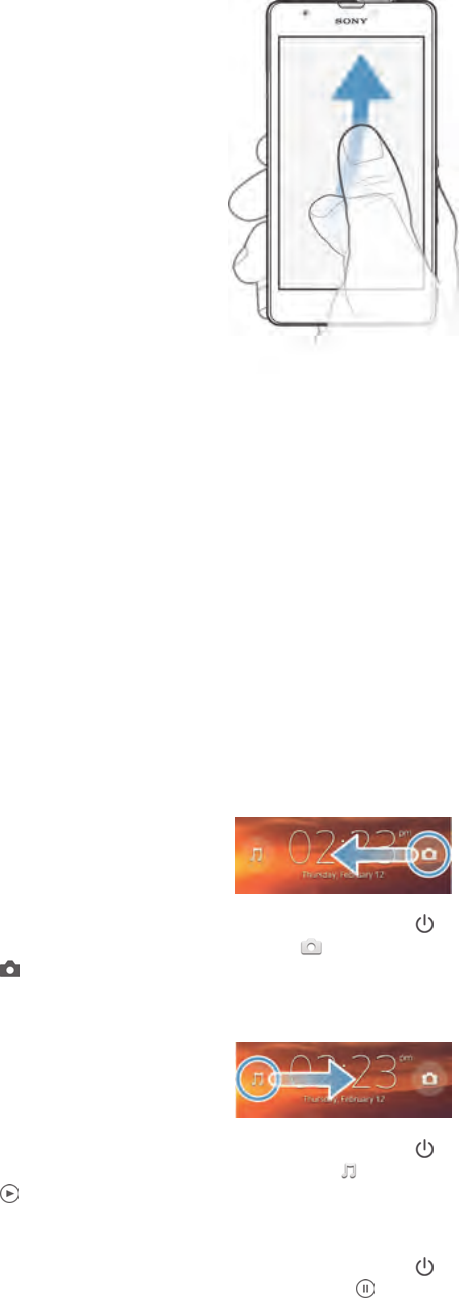
To flick
•To scroll more quickly, flick your finger in the direction you want to go on the
screen. You can wait for the scrolling movement to stop by itself, or you can
stop it immediately by tapping the screen.
Sensors
Your device has sensors that detect both light and proximity. The light sensor detects
the ambient light level and adjusts the brightness of the screen accordingly. The
proximity sensor turns the touch screen off during voice calls when your ear is close
to the screen. This prevents you from unintentionally activating other functions on
your device when you are engaged in a call.
Using the lockscreen
On the lockscreen, you can play tracks, take photos and record videos without
unlocking the screen.
To take a photo from the lockscreen
1To activate the screen, briefly press the power key .
2To activate the camera controls, drag to the left across the screen.
3Tap .
To play an audio track from the lockscreen
1To activate the screen, briefly press the power key .
2To display the music player controls, drag to the right across the screen.
3Tap .
To pause an audio track from the lockscreen
1To activate the screen, briefly press the power key .
2When the music player controls appear, tap .
17
This is an Internet version of this publication. © Print only for private use.
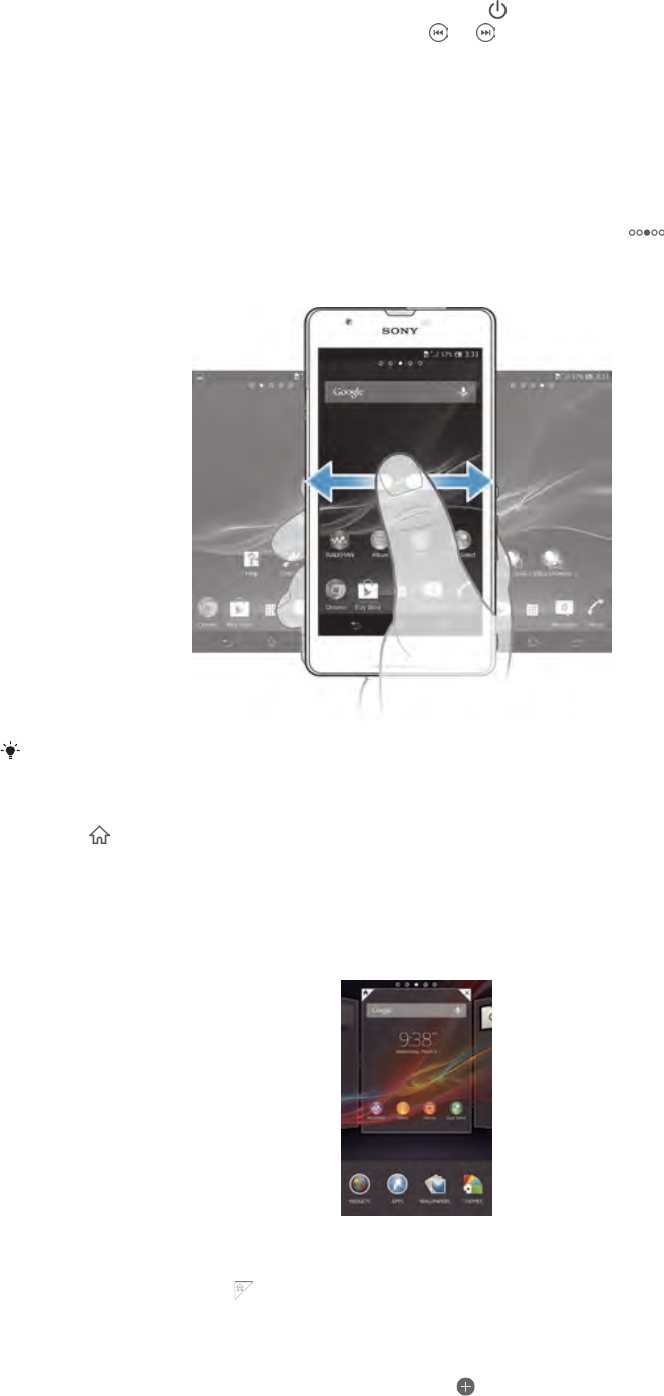
To change the currently playing audio track from the lockscreen
1To activate the screen, briefly press the power key .
2When the music player controls appear, tap or .
Home screen
The Home screen is your gateway to the main features on your device. You can
customise your Home screen with widgets, shortcuts, folders, themes, wallpaper and
other items.
The Home screen extends beyond the regular screen display width, so you need to
flick left or right to view content in all of the Home screen's panes. shows which
part of the Home screen you are in. You can set a pane as the main Home screen
pane, and add or delete panes.
The items in the bar at the bottom of the screen are always available for quick access.
To go to the Home screen
•Press .
To browse the Home screen
•Flick right or left.
To set a pane as the main Home screen pane
1Touch and hold an empty area on your Home screen until the device vibrates.
2Flick left or right to browse to the pane that you want to set as your main Home
screen pane, then tap .
To add a pane to your Home screen
1Touch and hold an empty area on your Home screen until the device vibrates.
2Flick left or right to browse the panes, then tap .
18
This is an Internet version of this publication. © Print only for private use.

To delete a pane from your Home screen
1Touch and hold an empty area on your Home screen until the device vibrates.
2Flick left or right to browse to the pane that you want to delete, then tap .
Widgets
Widgets are small applications that you can use directly on your Home screen. For
example, the “WALKMAN” widget allows you to start playing music directly.
Some widgets are resizable, so you can expand them to view more content or shrink
them to save space on your Home screen.
To add a widget to the Home screen
1Touch and hold an empty area on your Home screen until the device vibrates,
then tap Widgets.
2Find and tap the widget that you want to add.
To resize a widget
1Touch and hold a widget until it magnifies and the device vibrates, then release
the widget. If the widget can be resized, for example, the Calendar widget,
then a highlighted frame and resizing dots appear.
2Drag the dots inward or outward to shrink or expand the widget.
3To confirm the new size of the widget, tap anywhere on the Home screen.
Rearranging your Home screen
Customise the appearance of your Home screen and change the features that you
can access from it. Change the screen background, move items around, create
folders, and add shortcuts and widgets.
Customisation options
When you touch and hold an empty area of your Home screen, the following
customisation options appear:
Add widgets to your Home screen.
Add applications and shortcuts.
Set a wallpaper for your Home screen.
Set a background theme.
To view customisation options from the Home screen
•Touch and hold an empty area on your Home screen until the device vibrates
and customisation options appear at the bottom of the screen.
To add a shortcut to your Home screen
1Touch and hold an empty area on your Home screen until the device vibrates.
2Tap Apps > Shortcuts.
3Select a shortcut.
You can add an application shortcut directly from the Application screen by touching and
holding the application.
To move an item on the Home screen
•Touch and hold the item until it magnifies and the device vibrates, then drag
the item to the new location.
To delete an item from the Home screen
•Touch and hold an item until it magnifies and the device vibrates, then drag the
item to .
19
This is an Internet version of this publication. © Print only for private use.
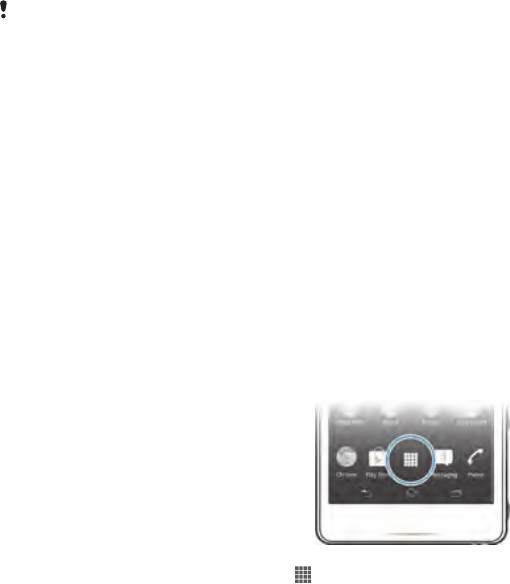
To create a folder on the Home screen
1Touch and hold an application icon or a shortcut until it magnifies and the
device vibrates, then drag and drop it on top of another application icon or
shortcut.
2Enter a name for the folder and tap Done.
To add items to a folder on the Home screen
•Touch and hold an item until it magnifies and the device vibrates, then drag the
item to the folder.
To rename a folder on the Home screen
1Tap the folder to open it.
2Tap the folder's title bar to show the Folder name field.
3Enter the new folder name and tap Done.
Changing the background of your Home screen
Adapt the Home screen to your own style using wallpapers and different themes.
To change your Home screen wallpaper
1Touch and hold an empty area on your Home screen until the device vibrates.
2Tap Wallpapers and select an option.
To set a theme for your Home screen
1Touch and hold an empty area on your Home screen until the device vibrates.
2Tap Themes, then select a theme.
When you change a theme, the background also changes in some applications.
Accessing and using applications
Open applications from shortcuts on your Home screen or from the Application
screen.
Application screen
The Application screen, which you open from your Home screen, contains the
applications that come pre-installed on your device as well as the applications you
download.
The Application screen extends beyond the regular screen width, so you need to flick
left and right to view all content.
To open the Application screen
•From your Home screen, tap .
To browse the Application screen
•From the Application screen, flick right or left.
20
This is an Internet version of this publication. © Print only for private use.
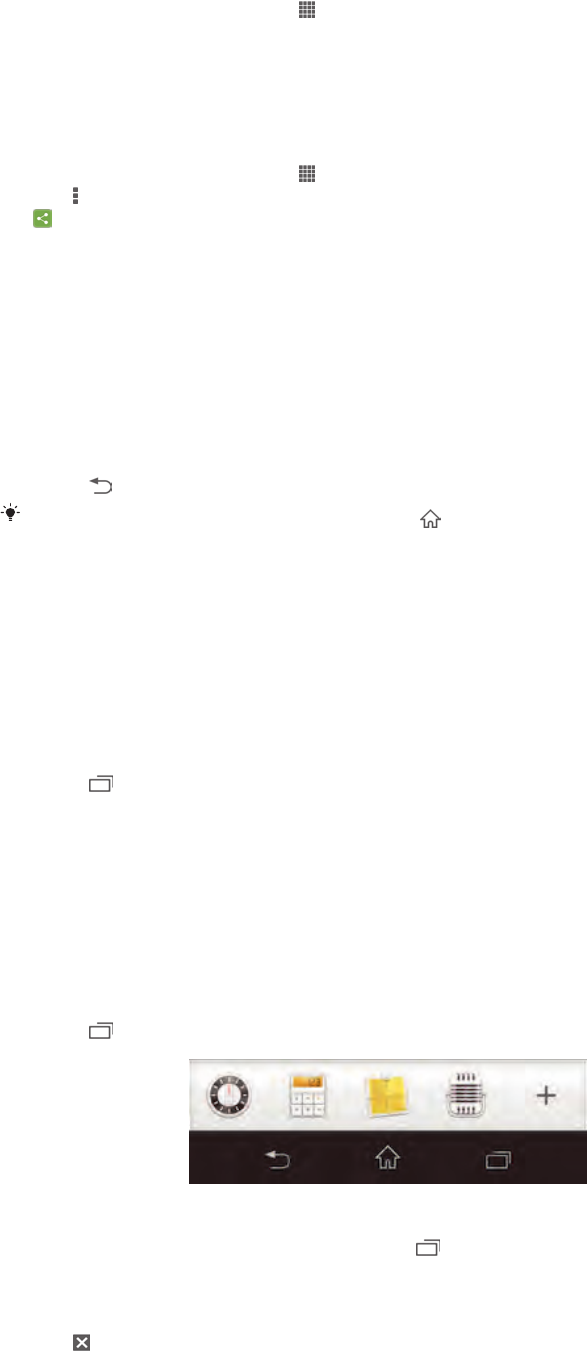
To create a shortcut to an application on the Home screen
1From your Home screen, tap .
2Touch and hold an application icon until the screen vibrates, then drag the icon
to the top of the screen. The Home screen opens.
3Drag the icon to the desired location on the Home screen, then release your
finger.
To share an application from your Application screen
1From your Home screen, tap .
2Tap , then tap Share. All applications which can be shared are indicated by
.
3Tap the application that you want to share, then select an option and confirm,
if necessary. A link to a download of the application is sent to the people you
have selected.
Opening and closing applications
To open an application
•From your Home screen or the Application screen, tap the application.
To close an application
•Press .
Some applications are paused when you press to exit, while other applications may
continue to run in the background. In the first case, the next time you open the application,
you can continue where you left off. Remember that some applications may cause data
connection charges when they are running in the background, for example, social networking
services.
Recently used applications window
You can switch between recently used applications from this window. You can also
open small apps.
To open the recently used applications window
•Press . The recently used applications window appears on the right of the
screen.
Using small apps
From the recently used applications window, you can get quick access to several
small apps at any time using the small apps bar. A small app only takes up a small
area of your screen. So you can interact with a small app and another application at
the same time on the same screen.
To open the small apps bar
•Press . The small apps bar appears at the bottom of the screen.
To open a small app
1To make the small apps bar appear, press .
2Tap the small app that you want to open. A small app window appears.
To close a small app
•Tap on the small app window.
21
This is an Internet version of this publication. © Print only for private use.

To move a small app
•When the small app is open, touch and hold the top left corner of the small
app, then move it to the desired location.
To minimise a small app
•When the small app is open, touch and hold the top left corner of the small
app, then drag it to the right edge or to the bottom edge of the screen.
To rearrange your small apps
1To make the small apps bar appear, press .
2Touch and hold a small app and drag it to the desired position in the small
apps bar.
To remove a small app from the small apps bar
1To make the small apps bar appear, press .
2Touch and hold a small app icon and drag it away from the small apps bar.
To restore a previously removed small app
1To make the small apps bar appear, press .
2Tap > Installed small apps.
3Select the small app that you want to restore.
To download a small app
1To make the small apps bar appear, press .
2Tap > .
3Find a small app that you want to download, then follow the instructions to
complete the installation.
Application menu
You can open a menu at any time when you are using an application. The menu will
look different depending on which application you are using.
To open a menu in an application
•While using the application, press .
A menu is not available in all applications.
Rearranging your Application screen
Move the applications around on the Application screen according to your
preferences.
To arrange applications on the Application screen
1From your Home screen, tap to go to the Application screen.
2Tap the drop-down list on the top left of the screen and select an option.
To move an application on the Application screen
1Open the Application screen.
2Touch and hold an item until it magnifies and the device vibrates, then drag the
item to the new location.
You can only move your applications when Own order is selected.
To uninstall an application from the Application screen
1From your Home screen, tap .
2Tap , then tap Uninstall. All uninstallable applications are indicated by .
3Tap the application that you want to uninstall, then tap Uninstall.
22
This is an Internet version of this publication. © Print only for private use.

Status and notifications
The status bar at the top of your screen shows what's going on in your device. To the
left you get notifications when there is something new or ongoing. For example, new
message and calendar notifications appear here. The right side shows the signal
strength, battery status, and other information.
The status bar allows you to adjust basic settings on your device, for example,
Wi-Fi®, Bluetooth™, data traffic, and sound. You can also open the settings menu
from the Notification panel to change other settings.
A notification light also gives you battery status information and some notifications.
For example, a flashing blue light means there is a new message or a missed call.
The notification light may not work when the battery level is low.
Checking notifications and ongoing activities
You can drag down the status bar to open the Notification panel and get more
information. For example, you can use the panel to open a new message or view a
calendar event. You can also open some applications that run in the background,
such as the music player.
To open the Notification panel
•Drag the status bar downwards.
23
This is an Internet version of this publication. © Print only for private use.
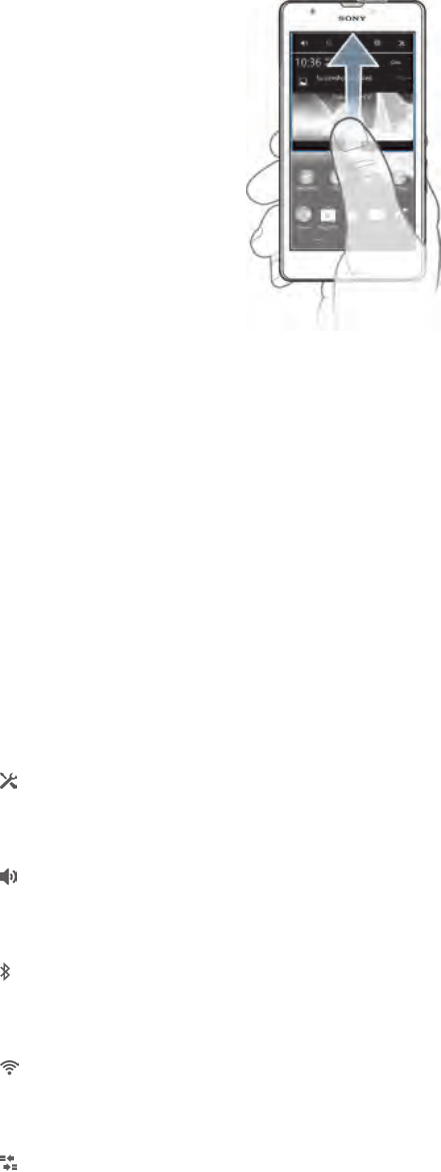
To close the Notification panel
•Drag the tab at the bottom of the Notification panel upwards.
To open a running application from the Notification panel
•Tap the icon for the running application to open it.
To dismiss a notification from the Notification panel
•Place your finger on a notification and flick left or right.
To clear the Notification panel
•From the Notification panel, tap Clear.
Setting your device from the Notification panel
You can open the settings menu from the Notification panel to adjust basic device
settings. For example, you can turn on Wi-Fi®.
To open the device settings menu from the Notification panel
1Drag the status bar downwards.
2Tap .
To adjust sound settings from the Notification panel
1Drag the status bar downwards.
2Tap .
To control the Bluetooth™ function from the Notification panel
1Drag the status bar downwards.
2Tap .
To control the Wi-Fi® function from the Notification panel
1Drag the status bar downwards.
2Tap .
To enable or disable data traffic from the Notification panel
1Drag the status bar downwards.
2Tap .
Settings menu
View and change settings for your device from the Settings menu.
24
This is an Internet version of this publication. © Print only for private use.
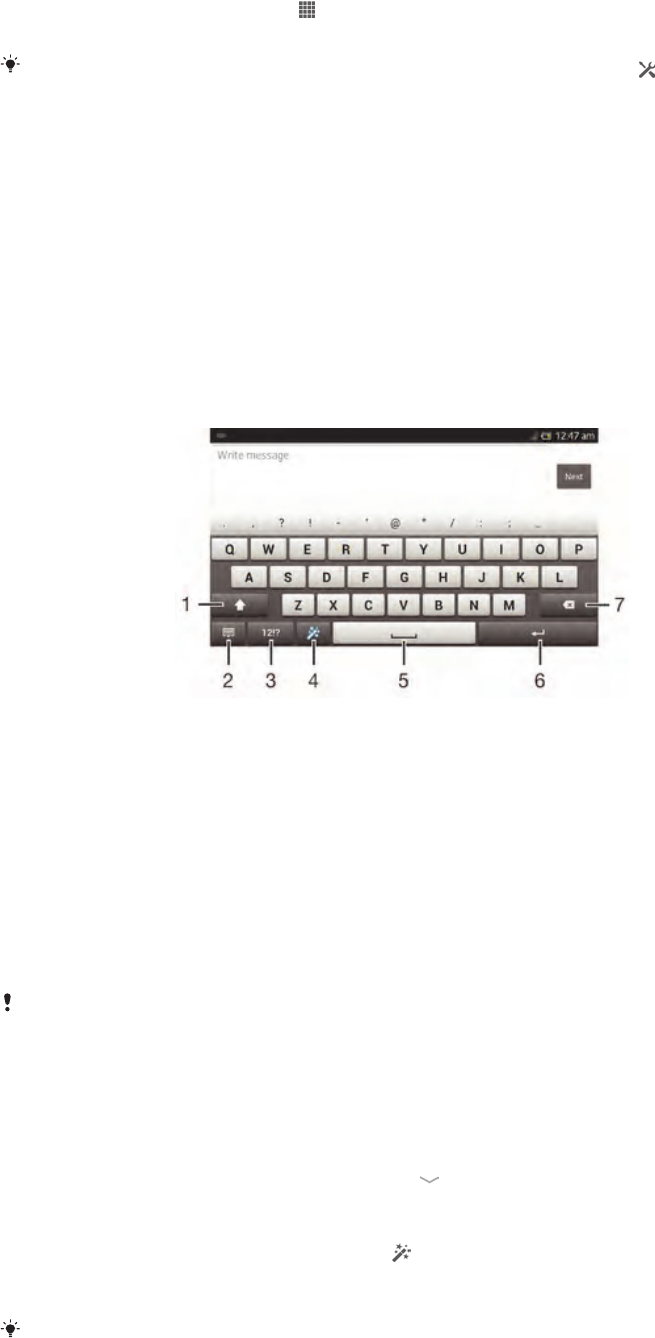
To access your device settings
1From your Home screen, tap .
2Tap Settings.
You can also drag the status bar downwards on the Home screen and tap to access your
device settings.
Typing text
You can select from a number of keyboards and input methods to type text
containing letters, numbers and other characters.
On-screen keyboard
Tap the keys of the on-screen QWERTY keyboard to enter text conveniently. Some
applications open the on-screen keyboard automatically. You can also open this
keyboard by touching a text field.
Using the on-screen keyboard
1Change the character case and turn on the caps lock. For some languages, this key is used to access
extra characters in the language.
2 Close the on-screen keyboard view. Note that this icon does not appear in portrait mode.
3 Display numbers and symbols.
4 Personalise your keyboard. This key disappears after the keyboard is personalised.
5 Enter a space.
6 Enter a carriage return or confirm text input.
7 Delete a character before the cursor.
All illustrations are for illustration purposes only and may not accurately depict the actual
device.
To display the on-screen keyboard to enter text
•Tap a text entry field.
To hide the on-screen keyboard
•When the on-screen keyboard is open, tap .
To personalise the on-screen keyboard
1Open the on-screen keyboard, then tap .
2Follow the instructions to personalise your on-screen keyboard, for example,
mark the Smiley key checkbox.
If you don't mark the Smiley key checkbox when you personalise the on-screen keyboard, the
smiley icon will not appear.
25
This is an Internet version of this publication. © Print only for private use.
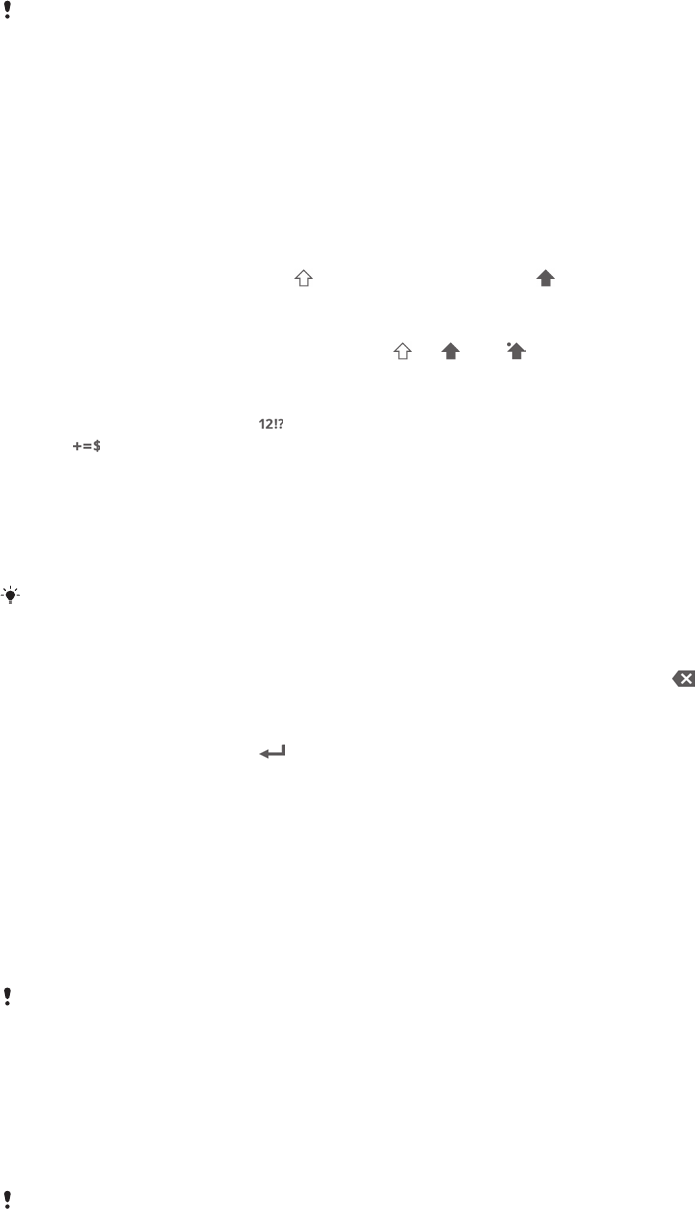
To use the on-screen keyboard in landscape orientation
•When you enter text, turn the device sideways.
For the keyboard to support this feature, landscape mode must be supported by the
application you are using, and your screen orientation settings must be set to automatic.
To enter text using the on-screen keyboard
1To enter a character visible on the keyboard, tap the character.
2To enter a character variant, touch and hold a regular keyboard character to
get a list of available options, then select from the list. For example, to enter
"é", touch and hold "e" until other options appear, then, while keeping your
finger pressed on the keyboard, drag to and select "é".
To shift between upper-case and lower-case letters
•Before you enter a letter, tap to switch to upper-case , or vice versa.
To turn on the caps lock
•Before you type a word, touch and hold or until appears.
To enter numbers or symbols
•When you enter text, tap . A keyboard with numbers and symbols appears.
Tap to view more options.
To enter common punctuation marks
1When you finish entering a word, tap the space bar.
2Select a punctuation mark from the candidate bar. The selected mark is
inserted before the space.
To quickly enter a full stop, tap the space bar twice when you finish entering a word.
To delete characters
•Tap to place the cursor after the character you want to delete, then tap .
To enter a carriage return
•When you enter text, tap to enter a carriage return.
To select text
1Enter some text, then double-tap the text. The word you tap gets highlighted
by tabs on both sides.
2Drag the tabs left or right to select more text.
To edit text in landscape orientation
1Enter some text, then double-tap the entered text.
2Select the text you want to work with, then tap Edit... and select an option.
To paste text from the clipboard, double-tap the text field to make Paste appear, then tap
Paste.
To edit text in portrait orientation
1Enter some text, then double-tap the entered text to make the application bar
appear.
2Select the text you want to edit, then use the application bar to make your
desired changes.
To paste text from the clipboard, double-tap the text field to make Paste appear, then tap
Paste.
26
This is an Internet version of this publication. © Print only for private use.
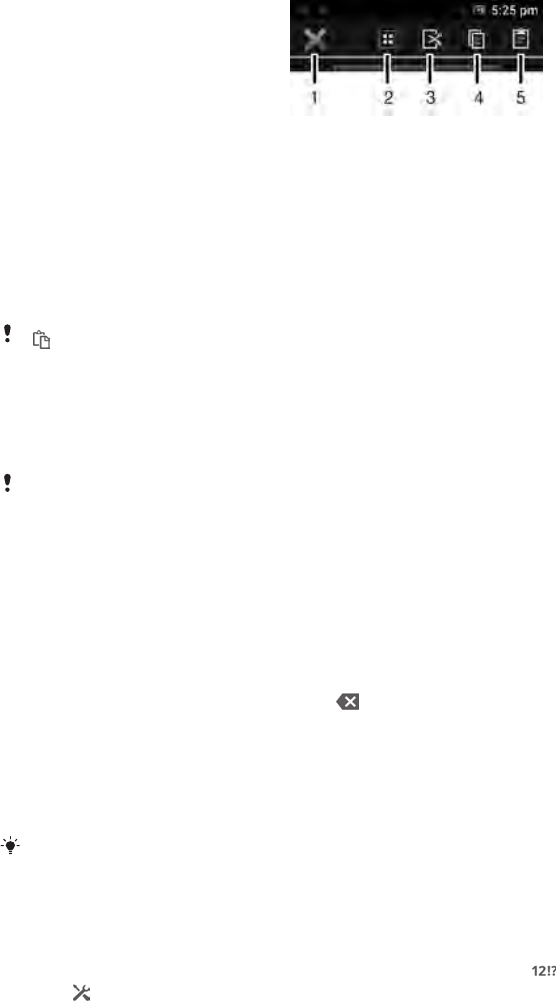
Application bar
1 Close the application bar
2 Select all text
3 Cut text
4 Copy text
5 Paste text
only appears when you have text stored on the clipboard.
Using the Gesture input function to write words
You can input text by sliding your finger from letter to letter on the on-screen
keyboard.
Gesture input is only available when you use the on-screen keyboard.
To enter text using the Gesture input function
1When you enter text using the on-screen keyboard, slide your finger from letter
to letter to trace the word you want to write.
2Lift up your finger when you’ve finished entering a word. A word is suggested
based on the letters you have traced. If necessary, select the correct word in
the candidate bar.
3To view more options, scroll right or left in the word candidate bar. If you
cannot find the desired word, tap once to delete the entire word. Then try
again to trace the word using the Gesture input function, or tap each letter to
enter the word.
4If the Space between gestures setting is activated, trace the next word that
you want to enter. If not, tap the space bar and then trace the next word you
want to enter.
To enter joined compound words when the Space between gestures setting is activated, you
may need to slide to enter the first part of the word, then tap each letter to enter the rest of
the word.
To change the Gesture input settings
1When you enter text using the on-screen keyboard, tap .
2Tap , then tap Keyboard settings.
3Tap Text input settings.
4Mark or unmark the Gesture input checkbox.
5If you want to automatically add a space between gestures without having to
tap the space bar each time, mark the Space between gestures checkbox.
Phonepad
The Phonepad is similar to a standard 12-key telephone keypad. It gives you
predictive text and multi-tap input options. You can activate the Phonepad text input
method via the keyboard settings. The Phonepad is only available in portrait
orientation.
27
This is an Internet version of this publication. © Print only for private use.
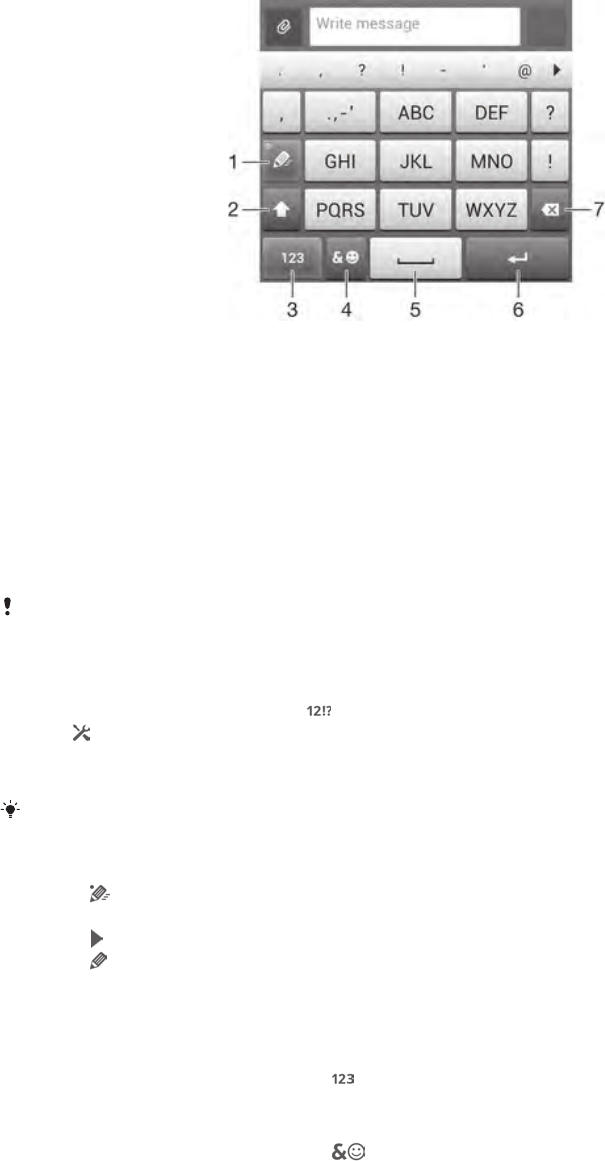
Using the Phonepad
1 Choose a text input option
2 Change the character case and turn on the caps lock
3 Display numbers
4 Display symbols and smileys
5 Enter a space
6 Enter a carriage return or confirm text input
7 Delete a character before the cursor
All illustrations are for illustration purposes only and may not accurately depict the actual
device.
To open the Phonepad for the first time
1Tap a text entry field, then tap .
2Tap , then tap Keyboard settings.
3Tap Keyboard appearance > Keyboard layout.
4Select the Phonepad.
The Phonepad can only be used in portrait mode.
To enter text using the Phonepad
•When appears in the Phonepad, tap each character key only once, even if
the letter you want is not the first letter on the key. Tap the word that appears
or tap to view more word suggestions and select a word from the list.
•When appears in the Phonepad, tap the on-screen key for the character you
want to enter. Keep pressing this key until the desired character is selected.
Then do the same for the next character you want to enter, and so on.
To enter numbers using the Phonepad
•When the Phonepad is open, tap . A Phonepad with numbers appears.
To insert symbols and smileys using the Phonepad
1When the Phonepad is open, tap . A grid with symbols and smileys
appears.
2Scroll up or down to view more options. Tap a symbol or smiley to select it.
Keyboard and Phonepad settings
You can select settings for the on-screen keyboard and the Phonepad, such as
writing language and automatic correction.
28
This is an Internet version of this publication. © Print only for private use.

To access the on-screen keyboard and Phonepad settings
1When you enter text using the on-screen keyboard or Phonepad, tap or .
2Tap , then tap Keyboard settings.
To add a writing language for text input
1When you enter text using the on-screen keyboard or Phonepad, tap or .
2Tap , then tap Keyboard settings.
3Tap Languages > Writing languages and mark the relevant checkboxes. Tap
OK to confirm.
Text input settings
When entering text using the on-screen keyboard or the Phonepad, you can access a
text input settings menu that helps you set options for text prediction, automatic
spacing and quick fixes. For example, you can decide how word options are
presented and how words get corrected as you type. You can also set the text input
application to remember new words that you write.
To change the text input settings
1When you enter text using the on-screen keyboard or the Phonepad, tap or
.
2Tap , then tap Keyboard settings > Text input settings and select the
relevant settings.
Entering text using voice input
When you enter text, you can use the voice input function instead of typing the
words. Just speak the words that you want to enter. Voice input is an experimental
technology from Google™, and is available for a number of languages and regions.
To enable voice input
1When you enter text using the on-screen keyboard or the Phonepad, tap or
.
2Tap , then tap Keyboard settings .
3Mark the Google voice typing key checkbox.
4Press to save your settings. A microphone icon appears on your on-
screen keyboard or Phonepad.
To enter text using voice input
1Open the on-screen keyboard or the Phonepad.
2If is available, tap it. If not, touch and hold the input language key, for
example, .
3When appears, speak to enter text. When you're finished, tap again. The
suggested text appears.
4Edit the text manually if necessary.
Customising your device
You can adjust several device settings to suit your own needs. For example, you can
change the language, add a personal ringtone, or change the screen brightness.
Adjusting the volume
You can adjust the ringtone volume for incoming calls and notifications as well as for
music and video playback.
To adjust the ring volume with the volume key
•Press the volume key up or down.
To adjust the media playing volume with the volume key
•When playing music or watching video, press the volume key up or down.
29
This is an Internet version of this publication. © Print only for private use.

Adjusting the sound settings
You can adjust several sound settings. For example, you can set your device to silent
mode so that it doesn't ring when you're in a meeting.
To set your device to vibrate mode
•Press the volume key down until appears in the status bar.
You can also press and hold down the power key and then tap in the menu that opens
to set your device to vibrate mode.
To set your device to silent mode
1Press the volume key down until the device vibrates and appears in the
status bar.
2Press the volume key down again. appears in the status bar.
You can also press and hold down the power key and then tap in the menu that opens
to set your device to silent mode.
To set your device to vibrate and ring mode
1From your Home screen, tap .
2Find and tap Settings > Sound.
3Mark the Vibrate when ringing checkbox.
Time and date
You can change the time and date on your device.
To set the date manually
1From the Home screen, tap .
2Find and tap Settings > Date & time.
3Unmark the Automatic date & time checkbox, if it is marked.
4Tap Set date.
5Adjust the date by scrolling up and down.
6Tap Done.
To set the time manually
1From your Home screen, tap .
2Find and tap Settings > Date & time.
3Unmark the Automatic date & time checkbox if it is marked.
4Tap Set time.
5Scroll up or down to adjust the hour and minute.
6If applicable, scroll up to change am to pm, or vice versa.
7Tap Done.
To set the time zone
1From your Home screen, tap .
2Find and tap Settings > Date & time.
3Unmark the Automatic time zone checkbox, if it is marked.
4Tap Select time zone.
5Select an option.
Ringtone settings
To set a ringtone
1From your Home screen, tap .
2Find and tap Settings > Sound > Phone ringtone.
3Select a ringtone.
4Tap Done.
30
This is an Internet version of this publication. © Print only for private use.

To enable touch tones
1From your Home screen, tap .
2Find and tap Settings > Sound.
3Mark the Dial pad touch tones and Touch sounds checkboxes.
To select the notification sound
1From your Home screen, tap .
2Find and tap Settings > Sound > Default notification.
3Select the sound to be played when notifications arrive.
4Tap Done.
Screen settings
To adjust the screen brightness
1From your Home screen, tap .
2Find and tap Settings > Display > Brightness.
3Drag the slider to adjust the brightness.
4Tap OK.
The brightness level affects your battery performance. For tips on how to improve battery
performance, see Improving battery performance.
To set the screen to vibrate
1From your Home screen, tap .
2Find and tap Settings > Sound.
3Mark the Vibrate on touch checkbox. The screen now vibrates when you tap
soft keys and certain applications.
To adjust the idle time before the screen turns off
1From your Home screen, tap .
2Find and tap Settings > Display > Sleep.
3Select an option.
To turn off the screen quickly, briefly press the power key .
To keep the screen active while your device is charging
1From the Home screen, tap .
2Find and tap Settings > Developer options.
3Mark the Stay awake checkbox.
Language settings
You can select a default language for your device and change it again at a later time.
To change the language
1From the Home screen, tap .
2Find and tap Settings > Language & input > Language.
3Select an option.
4Tap OK.
If you select the wrong language and cannot read the menu texts, find and tap . Then select
the text beside and select the first entry in the menu that opens. You can then select the
language you want.
Airplane mode
In Airplane mode, the network and radio transceivers are turned off to prevent
disturbance to sensitive equipment. However, you can still play games, listen to
music, watch videos and other content, as long as all this content is saved on your
31
This is an Internet version of this publication. © Print only for private use.

memory card or internal storage. You can also be notified by alarms, if alarms are
activated.
Turning on Airplane mode reduces battery consumption.
To turn on Airplane mode
1From your Home screen, tap .
2Find and tap Settings > More….
3Mark the Airplane mode checkbox.
You can also press and hold down the power key and then select Airplane mode in the
menu that opens.
Enhancing the sound output
You can enhance the sound output that comes from the speakers in your device
using features such as Clear Phase™ and xLOUD™ technology.
Using Clear Phase™ technology
Use Clear Phase™ technology from Sony to automatically adjust the sound quality
coming from your device's internal speakers and get a cleaner, more natural sound.
To enhance the speaker sound quality using Clear Phase™
1From your Home screen, tap .
2Find and tap Settings > Sound.
3Mark the Clear Phase™ checkbox.
The activation of the Clear Phase™ feature has no effect on voice communication
applications. For example, there is no change in the voice call sound quality.
Using xLOUD™ technology
Use xLOUD™ audio filter technology from Sony to enhance the speaker volume
without sacrificing quality. Get a more dynamic sound as you listen to your favourite
songs.
To enhance the speaker volume using xLOUD™
1From your Home screen, tap .
2Find and tap Settings > Sound.
3Mark the xLOUD™ checkbox.
The activation of the xLOUD™ feature has no effect on voice communication applications. For
example, there is no change in the voice call sound quality.
Memory
You can save content to your device's internal storage and to a memory card.
Memory card
Your device supports a microSD™ memory card, which is used for storing content.
This type of card can also be used as a portable memory card with other compatible
devices.
You may have to purchase a memory card separately.
Formatting the memory card
You can format the memory card in your device, for example, to free up memory.
This means that you erase all data on the card.
All content on the memory card gets erased when you format it. Make sure you make backups
of everything you want to save before formatting the memory card. To back up your content,
32
This is an Internet version of this publication. © Print only for private use.
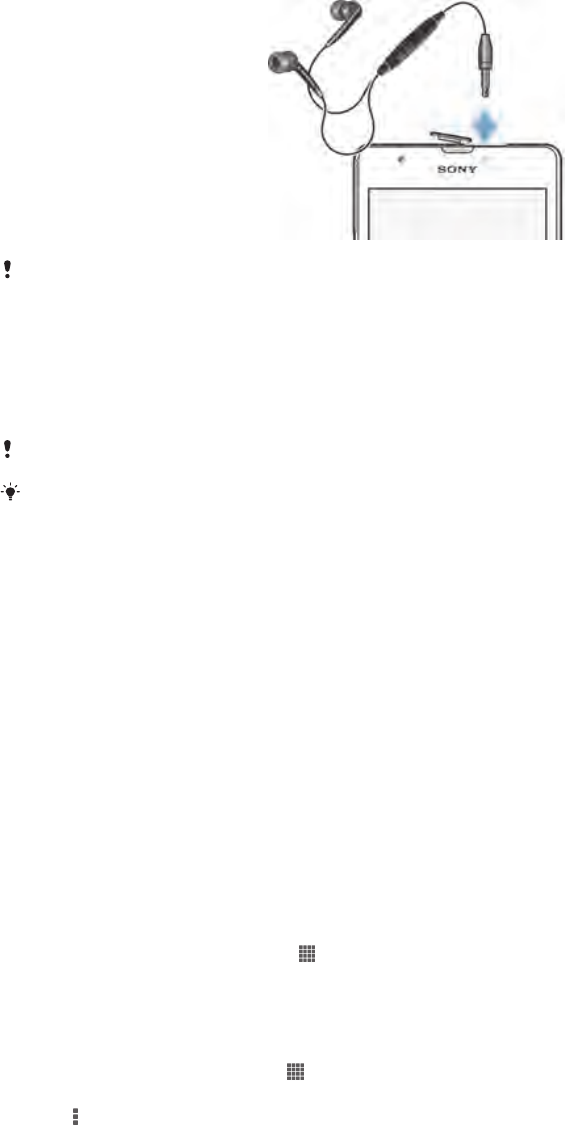
you can copy it to your computer. For more information, refer to the chapter Connecting your
device to a computer on page 104.
Using a headset
Use the accessories provided with your device, or other compatible accessories, for optimal
performance.
To use a headset
1Connect the headset to your device.
2To answer a call, press the call handling key.
3To end the call, press the call handling key.
If a headset is not included with the device, you may purchase one separately.
If you are listening to music, the music stops when you answer a call and resumes after you
end the call.
Internet and messaging settings
To send text and multimedia messages and to access the Internet, you must have a
mobile data connection and the correct settings. There are different ways to get
these settings:
•For most mobile networks and operators, Internet and messaging settings come
preinstalled on your device. You can then start using the Internet and send messages
right away.
•In some cases you will get the option to download Internet and messaging settings
the first time you turn on your device. It is also possible to download these settings
later from the Settings menu.
•You can manually add and change Internet and network settings on your device at
any time. Contact your network operator for detailed information about Internet and
messaging settings.
To download Internet and messaging settings
1From your Home screen, tap .
2Find and tap Settings > Xperia™ > Internet settings.
3Tap Accept.
To reset the default Internet settings
1From the Home screen, tap .
2Tap Settings > More… > Mobile networks > Access Point Names.
3Tap .
4Tap Reset to default.
Access Point Names (APNs)
An APN is used to establish data connections between your device and the Internet.
The APN defines which type of IP address to use, which security methods to invoke,
and which fixed-end connections to use. Checking the APN is useful when you
33
This is an Internet version of this publication. © Print only for private use.

cannot access the Internet, have no data connection, or cannot send or receive
multimedia messages.
To view the current APN
1From your Home screen, tap .
2Find and tap Settings > More… > Mobile networks.
3Tap Access Point Names.
If you have several available connections, the active network connection is indicated by a
marked button.
To add Internet settings manually
1From the Home screen, tap .
2Find and tap Settings > More… > Mobile networks > Access Point Names.
3Tap .
4Tap New APN.
5Tap Name and enter the name of the network profile that you want to create.
6Tap APN and enter the access point name.
7Enter all other information required by your network operator.
8Tap , then tap Save.
Usage info
For quality purposes, Sony collects anonymous bug reports and statistics regarding
your device. None of the information gathered includes personal data.
To allow the sending of usage info
1From your Home screen, tap .
2Find and tap Settings > Xperia™ > Usage info settings.
3Mark the Send usage info checkbox if it is not already marked.
4Tap Agree to allow the sending of usage information.
Controlling data usage
Keep track of and control the amount of data transferred to and from your device
during a given period. For example, you can set data usage warnings and limits for
your device to avoid additional charges. You can also limit the amount of data used
by individual applications.
Adjusting data usage settings can help you keep greater control over data usage but cannot
guarantee the prevention of additional charges.
To access data usage settings
1From your Home screen, tap .
2Find and tap Settings > Data usage.
To turn data traffic on or off
1From your Home screen, tap .
2Find and tap Settings > Data usage.
3To turn data traffic on or off, tap the on-off switch beside Mobile data
accordingly.
You can also turn data traffic on or off by marking or unmarking the Mobile data traffic
checkbox under Settings > More… > Mobile networks.
To set a data usage warning
1Make sure that you have turned on data traffic.
2From your Home screen, tap .
3Find and tap Settings > Data usage.
4To set the warning level, drag the lines to the desired values. You receive a
warning notification when the amount of data traffic approaches the level you
set.
34
This is an Internet version of this publication. © Print only for private use.

To set a data usage limit
1Make sure that you have turned on data traffic.
2From your Home screen, tap .
3Find and tap Settings > Data usage.
4Mark the Set mobile data limit checkbox if it is not marked, then tap OK.
5To set the data usage limit, drag the lines to the desired values.
Once your data usage reaches the set limit, data traffic on your device will be turned off
automatically.
To control the data usage of individual applications
1From your Home screen, tap .
2Find and tap Settings > Data usage.
3Find and tap the desired application.
4Make the necessary adjustments to change the data usage limit, restrict
background data, or restrict all data traffic for the application.
5To access more specific settings for the application, tap View app settings
and make the desired changes.
Specific settings for an application may not always be accessible.
The performance of individual applications may be affected if you change the related data
usage settings.
Mobile network settings
Your device automatically switches between mobile networks depending on what
mobile networks are available in different areas. You can also manually set your
device to use a particular mobile network mode, for example, WCDMA or GSM.
To select a network mode
1From your Home screen, tap .
2Find and tap Settings > More… > Mobile networks.
3Tap Network Mode.
4Select a network mode.
To select another network manually
1From the Home screen, tap .
2Find and tap Settings > More… > Mobile networks > Network operators.
3Tap Search mode > Manual.
4Select a network.
If you select a network manually, your device will not search for other networks, even if you
move out of range of the manually selected network.
To activate automatic network selection
1From the Home screen, tap .
2Find and tap Settings > More… > Mobile networks > Network operators.
3When a pop-up window appears, tap Search mode.
4Tap Automatic.
Turning off data traffic
You can disable all data connections over mobile networks to avoid any unwanted
data downloads and synchronisations. Contact your network operator if you need
detailed information about your subscription plan and data traffic charges.
When data traffic is turned off, you can still use Wi-Fi® and Bluetooth™ connections. You can
also send and receive multimedia messages.
35
This is an Internet version of this publication. © Print only for private use.

To turn off all data traffic
1From your Home screen, tap .
2Find and tap Settings > More… > Mobile networks.
3Unmark the Mobile data traffic checkbox.
Data roaming
Some network operators allow mobile data connections via mobile networks when
you are outside of your home network (roaming). Note that data transmission charges
may apply. Contact your network operator for more information.
Applications may sometimes use the Internet connection in your home network without any
notification, for example, when sending search and synchronisation requests. Additional
charges may apply when such Internet connections are established while you are roaming.
Consult your network operator for more information.
To activate data roaming
1From the Home screen, tap .
2Find and tap Settings > More… > Mobile networks.
3Mark the Data roaming checkbox.
You can’t activate data roaming when data connections have been deactivated.
36
This is an Internet version of this publication. © Print only for private use.

Google Play™
Getting started with Google Play™
Open Google Play™ and enter a world of applications and games. You can browse
these applications and games through different categories. You can also rate an
application or game and send feedback on it.
To use Google Play™, you need to have a Google™ account. See To set up a
Google™ account on your device on page 54.
Google Play™ may not be available in all countries or regions
To open Google Play™
1From the Home screen, tap .
2Find and tap Play Store.
Downloading from Google Play™
You can download all kinds of applications from Google Play™, including free
applications.
Before you download applications
Before you start downloading from Google Play™, make sure that you have a
working Internet connection.
Also, remember that you might incur data traffic charges when you download content
to your device. Contact your operator for more information.
To download a free application
1In Google Play™, find an item you wish to download by browsing categories,
or by using the search function.
2Tap the item to view its details, and follow the instructions to complete the
installation.
To download a paid application
1In Google Play™, find an item you wish to download by browsing categories,
or by using the search function.
2Tap the item to view its details, and follow the instructions to complete your
purchase.
To open a downloaded application
1In Google Play™, press , then tap My Apps.
2Tap the downloaded application.
You can also access downloaded applications from the Application screen.
Clearing your application data
You may sometimes need to clear data for an application. This might happen if, for
example, the application memory becomes full, or you want to clear high scores for a
game. You might also want to erase incoming email, text and multimedia messages
in some applications.
37
This is an Internet version of this publication. © Print only for private use.

To clear all cache for an application
1From your Home screen, tap .
2Find and tap Settings.
3Tap Apps.
4Tap the application for which you want to clear all cache.
5Tap Clear cache.
It is not possible to clear the cache for some applications.
To delete an installed application
1From your Home screen, tap .
2Find and tap Settings.
3Tap Apps.
4Select the application that you want to delete.
5Tap Uninstall.
It is not possible to delete some preinstalled applications.
Permissions
Some applications may need to access data, settings and various functions on your
device in order to work properly. If so, then they need the relevant permissions from
you. For example, a navigation application needs permissions to send and receive
data traffic, and access your location. Some applications might misuse their
permissions by stealing or deleting data, or by reporting your location. Make sure you
only install and give permissions to applications you trust.
To view permissions of an application
1From your Home screen, tap .
2Find and tap Settings.
3Tap Apps.
4Tap the desired application.
5Scroll down to view the relevant details under Permissions.
Installing applications not from Google Play™
Installing applications of unknown or unreliable origin can damage your device. By
default, your device is set to block such installations. However, you can change this
setting and allow installations from unknown sources.
Sony does not warrant or guarantee the performance of any third-party applications or content
transferred via download or other interface to your device. Similarly, Sony is not responsible
for any damage or reduced performance of your device attributable to the transfer of third-
party content. Only use content from reliable sources. Contact the content provider if you have
any questions or concerns.
To allow the installation of applications not from Google Play™
1From your Home screen, tap .
2Find and tap Settings > Security.
3Mark the Unknown sources checkbox.
4Tap OK.
38
This is an Internet version of this publication. © Print only for private use.

Calling
Emergency calls
Your device supports international emergency numbers, for example, 112 or 911.
You can normally use these numbers to make emergency calls in any country, with or
without the SIM card inserted if you are within range of a network.
To make an emergency call
1From your Home screen, tap .
2Find and Tap Phone.
3Enter the emergency number and tap Call. To delete a number, tap .
You can make emergency calls when no SIM card is inserted or when outgoing calls are
barred.
To make an emergency call while the SIM card is locked
1Tap Emergency call.
2Enter the emergency number and tap Call. To delete a number, tap .
Call handling
You can make a call by manually dialling a phone number, by tapping a number
saved in your contact list, or by tapping the phone number in your call log view. You
can also use the smart dial feature to quickly find numbers from your contact list and
call logs.
To dial a phone number
1From your Home screen, tap .
2Find and tap .
3If the call log appears, tap to enter the dialpad view.
4Enter the phone number and tap .
To delete a digit entered by mistake, tap .
To make a call using smart dial
1From your Home screen, tap .
2Find and tap Phone.
3Use the dialpad to enter letters or numbers that correspond to the contact you
want to call. As you enter each letter or number, a list of possible matches
appears.
4Tap the contact you want to call.
To end a call
•Tap End call.
To make an international call
1From your Home screen, tap .
2Find and tap Phone.
3Touch and hold 0 until a “+” sign appears.
4Enter the country code, area code (without the first 0) and phone number, then
tap Call.
39
This is an Internet version of this publication. © Print only for private use.
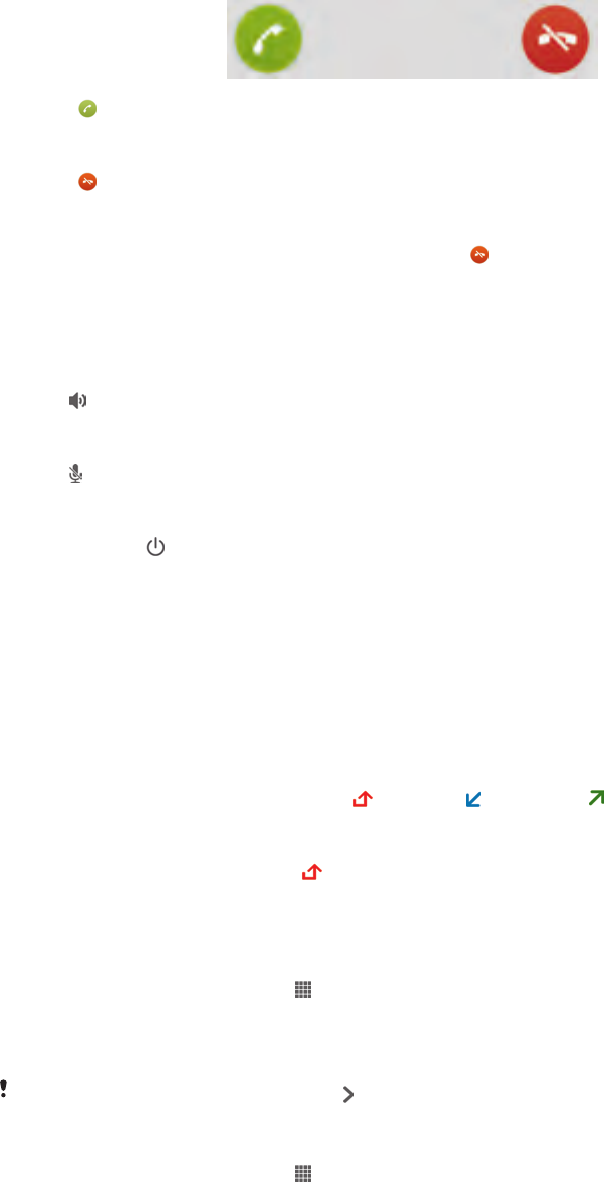
To answer a call
•Drag to the right across the screen.
To decline a call
•Drag to the left across the screen.
To reject a second call
•When you hear repeated beeps during a call, tap .
To change the ear speaker volume during a call
•Press the volume key up or down.
To turn on the loudspeaker during a call
•Tap .
To mute the microphone during a call
•Tap .
To activate the screen during a call
•Briefly press .
To enter numbers during a call
1During the call, tap Dialpad. A keypad appears.
2Tap the numbers you want to enter.
To mute the ringtone for an incoming call
•When you receive the call, press the volume key.
Recent calls
In the call log, you can view missed , received and dialled calls.
To view your missed calls
1When you have missed a call, appears in the status bar. Drag the status bar
downwards.
2Tap Missed call.
To call a number from your call log
1From your Home screen, tap .
2Find and tap Phone.The call log view appears on the upper part of the screen.
3To call a number directly, tap the number. To edit a number before calling,
touch and hold the number, then tap Edit number before call.
You can also call a number by tapping > Call back.
To add a number from the call log to your contacts
1From your Home screen, tap .
2Find and tap Phone.The call log view appears on the upper part of the screen.
3Touch and hold the number, then tap Add to Contacts.
4Tap the desired contact, or tap Create new contact.
5Edit the contact details and tap Done.
40
This is an Internet version of this publication. © Print only for private use.

Voicemail
If your subscription includes a voicemail service, callers can leave voice messages for
you when you can't answer calls. Your voicemail service number is normally saved on
your SIM card. If not, you can get the number from your service provider and enter it
manually.
To enter your voicemail number
1From the Home screen, tap .
2Find and tap Settings > Call settings > Voicemail >Voicemail settings >
Voicemail number.
3Enter your voicemail number.
4Tap OK.
To call your voicemail service
1From your Home screen, tap .
2Find and tap Phone.
3Touch and hold 1.
Multiple calls
If you have activated call waiting, you can handle multiple calls at the same time.
When it is activated, you will be notified by a beep if you receive another call.
To activate or deactivate call waiting
1From the Home screen, tap .
2Find and tap Settings > Call settings > Additional settings.
3To activate or deactivate call waiting, tap Call waiting.
To answer a second call and put the ongoing call on hold
•When you hear repeated beeps during a call, tap .
To make a second call
1During an ongoing call, tap Dialpad.
2Enter the number of the recipient and tap Call.
3The first call is put on hold.
The same procedure applies to subsequent calls.
To switch between multiple calls
•To switch to another call and put the current call on hold, tap .
To end the ongoing call and return to the next call on hold
•Tap End call.
Conference calls
With a conference or multiparty call, you can have a joint conversation with two or
more persons.
For details on the number of participants you can add to a conference call, contact your
network operator.
To make a conference call
1During an ongoing call, tap Dialpad.
2Dial the number of the second participant and tap Call. After the second
participant answers, the first participant is put on hold.
3Tap to add the second participant to the conference call.
4Repeat steps 1 to 3 to add more call participants.
41
This is an Internet version of this publication. © Print only for private use.

To have a private conversation with a conference call participant
1During an ongoing conference call, tap {0} participants.
2Tap the telephone number of the participant with whom you want to talk
privately.
3To end the private conversation and return to the conference call, tap .
To release a participant from a conference call
1During an ongoing conference call, tap the button showing the number of
participants. For example, tap 3 participants if there are three participants.
2Tap next to the participant you want to release.
To end a conference call
•During the conference call, tap End conference call.
Call settings
Barring calls
You can bar all or certain categories of incoming and outgoing calls. When you use
call barring for the first time, you need to enter your PUK (Personal Unblocking Key)
and then a new password to activate the call barring function.
To bar incoming or outgoing calls
1From your Home screen, tap .
2Find and tap Settings > Call settings > Call barring.
3Select an option.
4Enter the password and tap Enable.
Rejecting a call with a message
You can reject a call with a predefined message. When you reject a call with such a
message, the message is automatically sent to the caller and saved on your device.
Six messages are predefined on your device. You can select from these predefined
messages, which can also be edited if necessary.
To reject a call with a predefined message
•Drag Reject with message upward, then select a message.
To reject a second call with a predefined message
•When you hear repeated beeps during a call, drag Reject with message
upward, then select a message.
To edit the message used to reject a call
1From your Home screen, tap .
2Find and tap Settings > Call settings > Reject call with message.
3Tap the message you want to edit, then make the necessary changes.
4When you're done, tap OK.
Forwarding calls
You can forward calls, for example, to another phone number, or to an answering
service.
To forward calls
1From your Home screen, tap .
2Find and tap Settings > Call settings > Call forwarding.
3Select an option.
4Enter the number you want to forward the calls to, then tap Enable.
42
This is an Internet version of this publication. © Print only for private use.

To turn off call forwarding
1From your Home screen, tap .
2Find and tap Settings > Call settings > Call forwarding.
3Select an option, then tap Disable.
Showing or hiding your phone number
You can select to show or hide your phone number on call recipients' devices when
you call them.
To show or hide your phone number
1From your Home screen, tap .
2Find and tap Settings > Call settings > Additional settings > Caller ID.
Fixed Dialling Numbers
If you have received a PIN2 code from your service provider, you can use a list of
Fixed Dialling Numbers (FDN) to restrict outgoing calls.
To enable or disable fixed dialling
1From your Home screen, tap .
2Find and tap Settings > Call settings > Fixed dialling numbers.
3Tap Activate fixed dialling or Deactivate fixed dialling.
4Enter your PIN2 and tap OK.
To access the list of accepted call recipients
1From your Home screen, tap .
2Find and tap Settings > Call settings > Fixed dialling numbers > Fixed
dialling numbers.
43
This is an Internet version of this publication. © Print only for private use.
Contacts
About Contacts
Use the Contacts application to store and manage all your numbers, email
addresses, and other contact data in one place. Just tap on a contact to see all
communications with that contact in one easy overview.
You can add new contacts in your device and synchronise them with contacts saved
in your Google™ account, Microsoft® Exchange ActiveSync® account, or other
accounts that support synchronisation. The Contacts application automatically
creates new entries and also helps you match data such as email addresses with
existing entries.
Transferring contacts to your new device
There are several ways to transfer contacts to your new device. Select a transfer
method that best suits your situation.
Transferring contacts using a PC
You can use a PC to transfer contacts from several device brands, including iPhone,
Samsung, HTC and Nokia.
You need:
•An Internet-connected PC running Windows®
•A USB cable for your old device
•A USB cable for your new Android™ device
•Your old device
•Your new Android™ device
Using the PC Companion program to transfer contacts
If you are transferring contacts using a PC, use the PC Companion program. It's free,
and the installation files are already saved on your new device. PC Companion also
offers a range of other features, including help to update your device software.
To install PC Companion
1New device: Turn on your new Android™ device and connect it to a PC using
a USB cable.
2New device: Tap Install to install PC Companion on the PC.
3Computer: If a popup window appears to notify you about available PC
software, select Run Startme.exe.
4Computer: Click Install to start the installation and then follow the instructions
to complete the installation.
To transfer contacts to your new device using PC Companion
1Make sure that PC Companion is installed on your PC.
2Open the PC Companion program on the PC, then click Contacts Setup and
follow the instructions to transfer your contacts.
Transferring contacts using an Apple® Mac® computer
For detailed instructions on how to use an Apple Mac computer to transfer contacts
from your old device, go to Transfer your contacts.
Transferring contacts using synchronisation accounts
Your device works with popular online synchronisation accounts such as Google
Sync™, Microsoft® Exchange ActiveSync®or Facebook™. If you have synced the
contacts in your old device or your computer with an online account, you can transfer
44
This is an Internet version of this publication. © Print only for private use.

your contacts to your new device using that account. For more detailed information
about synchronisation, see Synchronising your corporate email, calendar and
contacts on page 110.
To synchronise contacts on your device with a synchronisation account
1From your Home screen, tap , then tap .
2Tap , then tap Settings > Accounts & sync.
3If you have already set up a synchronisation account and you want to sync
with that account, tap the account, then tap , and tap Sync now.
Transferring contacts from a SIM card
To import contacts from a SIM card
1From your Home screen, tap , then tap .
2Press , then tap Import contacts > SIM card.
3If you have set up a synchronisation account, you can choose to add the SIM
card contacts under that account. Or you can choose to only use these
contacts on your device. Select your desired option.
4To import an individual contact, find and tap the contact. To import all
contacts, tap Import all.
Transferring contacts from a memory card
To import contacts from a memory card
1From your Home screen, tap , then tap .
2Press , then tap Import contacts > SD card.
3If you have set up a synchronisation account, you can add the imported
memory card contacts under that account. Or you can choose to only use the
imported contacts on your device. Select your desired option.
4If you have more than one vCard file on the SD card, a list appears showing
different batches of contacts saved on your device, with the corresponding
dates for when they were created. Select the batch that you want to import.
Receiving contacts from other devices
To receive contact data sent using Bluetooth™ technology
1Make sure you have the Bluetooth™ function turned on and your device set to
visible. If not, then you cannot receive data from other devices.
2When you are asked to confirm whether you want to receive the file, tap
Accept.
3Drag down the Notification panel and tap the file you received to import the
contact data.
To receive contacts sent using a messaging service
1When you receive a new text message, multimedia message, or email
message, open the message.
2The received contact data appears as a vCard attachment. Tap, or touch and
hold the vCard file to open a menu so you can save the contact data.
45
This is an Internet version of this publication. © Print only for private use.
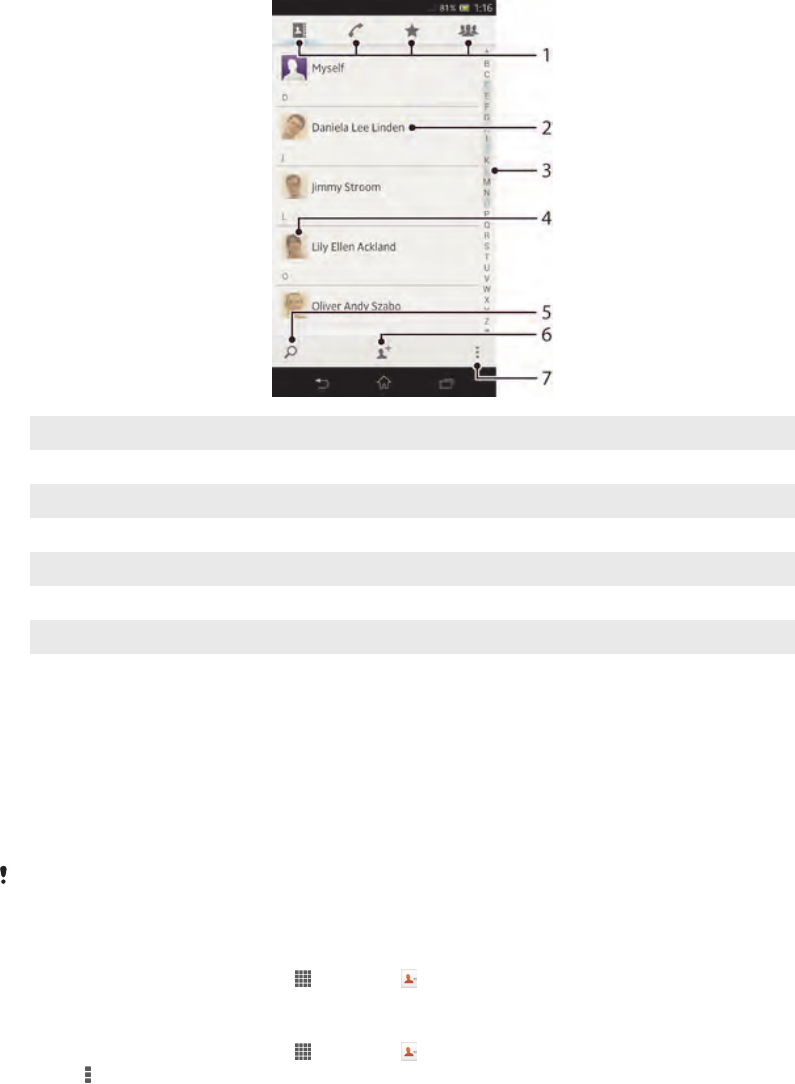
Contacts screen overview
1 Shortcut tabs
2 Tap a contact to view its details
3 Alphabetical index for browsing contacts
4 Tap a contact thumbnail to access the quick contact menu
5 Search for contacts
6 Create a contact
7 Open more options
Managing your contacts
You can create, edit and synchronise your contacts in a few simple steps. You can
select contacts saved in different accounts and manage how you display them on
your device.
If you synchronise your contacts with more than one account, you can join contacts
on your device to avoid duplicates.
Some synchronisation services, for example, some social networking services, do not allow
you to edit contact details.
To view your contacts
•From your Home screen, tap , then tap . Your contacts are listed here.
To select which contacts to display in the Contacts application
1From your Home screen, tap , then tap .
2Press , then tap Filter.
3In the list that appears, mark and unmark the desired options. If you have
synchronised your contacts with a synchronisation account, that account
appears in the list. To further expand the list of options, tap the account.
4When you are finished, tap OK.
46
This is an Internet version of this publication. © Print only for private use.

To add a contact
1From your Home screen, tap , then tap .
2Tap .
3If you have synchronised your contacts with one or more accounts, select the
account to which you want to add this contact, or tap Phone contact if you
only want to use this contact on your device.
4Enter or select the desired information for the contact.
5When you are finished, tap Done.
If you add a plus sign and the country code before a contact's phone number, you do not
have to edit the number again when you make calls from other countries.
To edit a contact
1From the Home screen, tap , then tap .
2Tap the contact you want to edit, then tap .
3Edit the desired information. When you are finished, tap Done.
To associate a picture with a contact
1From your Home screen, tap , then tap .
2Tap the contact you want to edit, then tap .
3Tap and select the desired method for adding the contact picture.
4When you have added the picture, tap Done.
You can also add a picture to a contact directly from the Album application.
To view your communication with a contact
1From the Home screen, tap , then tap .
2Tap the contact you want to view.
3To view your communication with the contact for different media, tap or flick
through the filter items at the bottom of the screen.
To delete contacts
1From your Home screen, tap , then tap .
2Touch and hold the contact you want to delete. To delete all contacts, press ,
then tap Mark several.
3Tap the downwards arrow to open the drop down menu, then select Mark all.
4Tap , then tap OK.
To edit contact information about yourself
1From your Home screen, tap , then tap .
2Tap Myself, then tap .
3Enter the new information or make the changes you want.
4When you are done, tap Done.
Avoiding duplicate entries in the Contacts application
If you synchronise your contacts with a new account or import contact information in
other ways, you could end up with duplicate entries in the Contacts application. If this
happens, you can join such duplicates to create a single entry. And if you join entries
by mistake, you can separate them again later.
To link contacts
1From your Home screen, tap , then tap .
2Tap the contact you want to link with another contact.
3Press , then tap Link contact.
4Tap the contact whose information you want to join with the first contact, then
tap OK to confirm. The information from the first contact is merged with the
second contact, and the first contact is no longer displayed in the Contacts list.
47
This is an Internet version of this publication. © Print only for private use.

To separate linked contacts
1From your Home screen, tap , then tap .
2Tap the linked contact you want to edit, then tap .
3Tap Unlink contact.
4Tap OK.
Favourites
You can mark contacts as favourites so that you can get quick access to them from
the Contacts application.
To mark or unmark a contact as a favourite
1From the Home screen, tap , then tap .
2Tap the contact you want to add to or remove from your favourites.
3Tap .
To view your favourite contacts
1From your Home screen, tap , then tap .
2Tap .
Groups
You can assign contacts to groups to get quicker access to them from within the
Contacts application.
To assign a contact to a group
1In the Contacts application, tap the contact that you want to assign to a group.
2Tap , then tap the bar directly under Assign to group.
3Mark the checkboxes for the groups to which you want to add the contact,
then tap Done.
4Tap Done.
Communicating with your contacts
To search for a contact
1From your Home screen, tap , then tap .
2Tap and enter the first few letters of the contact name in the Search
contacts field. All contacts beginning with those letters appear.
The quick contact menu
Tap a contact's thumbnail to view quick communication options for a particular
contact. Options include calling the contact, sending a text or multimedia message,
and starting a chat using the Google Talk™ application.
For an application to appear as an option in the quick contact menu, you may need to set up
the application in your device and be logged in to the application. For example, you need to
start the Gmail™ application and enter your login details before you can use Gmail™ from the
quick contact menu.
Sharing your contacts
To send your business card
1From your Home screen, tap , then tap .
2Tap Myself.
3Press , then tap Send contact > OK.
4Select an available transfer method and follow the on-screen instructions.
48
This is an Internet version of this publication. © Print only for private use.

To send a contact
1From your Home screen, tap , then tap .
2Tap the contact whose details you want to send.
3Press , then tap Send contact > OK.
4Select an available transfer method and follow the on-screen instructions.
To send several contacts at once
1From your Home screen, tap , then tap .
2Press , then tap Mark several.
3Mark the contacts you want to send, or select all if you want to send all
contacts.
4Tap , then select an available transfer method and follow the on-screen
instructions.
Backing up contacts
You can use a memory card, a SIM card or an online synchronisation tool such as
Microsoft® Exchange ActiveSync® to back up contacts.
To export all contacts to a memory card
1From your Home screen, tap , then tap .
2Press , then tap Back up contacts > Memory Card.
3Tap OK.
To export contacts to a SIM card
1From your Home screen, tap , then tap .
2Press , then tap Back up contacts > SIM card.
3Mark the contacts you want to export, or tap Mark all if you want to export all
your contacts.
4Tap Back up.
5Select Add contacts if you want to add the contacts to existing contacts on
your SIM card, or select Replace all contacts if you want to replace the
existing contacts on your SIM card.
When you export contacts to a SIM card, not all information may get exported. This is due to
memory limitations on SIM cards.
49
This is an Internet version of this publication. © Print only for private use.

Messaging
Using text and multimedia messaging
You can send and receive text messages from your device using SMS (Short
Message Service). If your subscription includes MMS (Multimedia Messaging
Service), you can also send and receive messages that contain media files, for
example, pictures and videos. The number of characters you can send in a single text
message varies depending on the operator and the language you use. If you exceed
the character limit, then all your single messages are linked together and sent as one
message. You are charged for each single text message you send. When you view
your messages, they appear as conversations, which means that all messages to and
from a particular person are grouped together.
To send multimedia messages, you need the correct MMS settings on your device. See
Internet and messaging settings.
To create and send a message
1From your Home screen, tap , then find and tap .
2Tap .
3Tap , then select the desired recipients from the Contacts list. If the recipient
is not listed as a contact, enter the contact's number manually and tap .
4When you are finished adding recipients, tap Done.
5Tap Write message and enter your message text.
6If you want to add a media file, tap and select an option.
7To send the message, tap Send.
If you exit a message before sending, it gets saved as a draft. The conversation gets tagged
with the word Draft:.
To read a received message
1From your Home screen, tap , then find and tap .
2Tap the desired conversation.
3If the message is not yet downloaded, tap and hold the message, then tap
Download message.
You can also open messages from the status bar when appears there. Just drag down the
bar and tap the message.
To reply to a message
1From your Home screen, tap , then find and tap .
2Tap the conversation containing the message.
3Enter your reply and tap Send.
To forward a message
1From your Home screen, tap , then find and tap .
2Tap the conversation containing the message you want to forward.
3Touch and hold the message you want to forward, then tap Forward message.
4Tap , then select a recipient from the Contacts list. If the recipient is not
listed as a contact, enter the contact's number manually and tap .
5When you are finished adding recipients, tap Done.
6Edit the message, if necessary, and tap Send.
In step 4, you can also tap To and enter the recipient's phone number manually.
To delete a message
1From your Home screen, tap , then find and tap .
2Tap the conversation containing the message you want to delete.
3Touch and hold the message you want to delete, then tap Delete message >
Delete.
50
This is an Internet version of this publication. © Print only for private use.

To delete conversations
1From your Home screen, tap , then find and tap .
2Tap , then tap Delete conversations.
3Mark the checkboxes for the conversations that you want to delete, then tap
> Delete.
To save a sender's number
1From your Home screen, tap , then find and tap .
2Tap > Save.
3Select an existing contact, or tap Create new contact.
4Edit the contact information and tap Done.
To call a message sender
1From your Home screen, tap , then find and tap .
2Tap a conversation.
3Tap the recipient name or number at the top of the screen, then select the
recipient name or number from the list that appears.
4If the recipient is saved in your contacts, tap the phone number that you want
to call. If you have not saved the recipient in your contacts, tap .
To save a file contained in a message you receive
1From your Home screen, tap , then find and tap .
2Tap the conversation you want to open.
3If the message has not been downloaded yet, tap and hold the message, then
tap Download message.
4Touch and hold the file you want to save, then select the desired option.
To star a message
1From your Home screen, tap , then find and tap .
2Tap the conversation you want to open.
3In the message you want to star, tap .
4To unstar a message, tap .
To view starred messages
1From your Home screen, tap , then find and tap .
2Tap , then tap Starred messages.
3All starred messages appear in a list.
To search for messages
1From your Home screen, tap , then find and tap .
2Tap , then tap Search.
3Enter your search keywords, then tap the confirm key.
Text and multimedia message options
To change your message notification settings
1From your Home screen, tap , then find and tap .
2Tap , then tap Settings.
3To set a notification sound, tap Notification tone and select an option.
4For other notification settings, check or uncheck the relevant checkboxes.
To change the delivery report settings for outgoing messages
1From your Home screen, tap , then find and tap .
2Tap , then tap Settings.
3Tap Delivery report to activate or deactivate delivery reports.
To view messages saved on the SIM card
1From your Home screen, tap , then find and tap .
2Tap , then tap Settings > SIM messages.
51
This is an Internet version of this publication. © Print only for private use.

Google Talk™
The Google Talk™ application lets you chat with your friends using text, voice and
video.
To start Google Talk™
1From your Home screen, tap .
2Find and tap Talk.
To reply to an instant message with Google Talk™
1When someone contacts you on Google Talk™, appears in the status bar.
2Drag the status bar downwards, then tap the message and begin to chat.
52
This is an Internet version of this publication. © Print only for private use.

Email
Getting started with Email
You can handle several email accounts at the same time using the Email application,
including corporate Microsoft Exchange Active Sync accounts. Emails you receive to
your Gmail™ account can be accessed on your device from both the Email and the
Gmail™ applications.
Using email accounts
To set up an email account on your device
1From your Home screen, tap .
2Find and tap Email.
3Follow the instructions that appear on the screen to complete the setup.
For some email services, you may need to contact your email service provider for information
on detailed settings for the email account.
To set an email account as your default account
1From your Home screen, tap .
2Find and tap Email.
3Press , then tap Settings.
4Select the account you want to use as the default account for composing and
sending emails.
5Mark the Default account checkbox. The inbox of the default account appears
every time you open the email application.
If you only have one email account, this account is automatically the default account.
To add an extra email account on your device
1From your Home screen, tap .
2Find and tap Email.
3Tap at the top of the screen, then tap Add account.
4Enter the email address and password, then tap Next. If the settings for the
email account cannot be downloaded automatically, complete the setup
manually.
5When prompted, enter a name for your email account so that it is easily
identifiable. The same name shows in the emails you send from this account.
6When you are finished, tap Next.
To remove an email account from your device
1From your Home screen, tap .
2Find and tap Email.
3Press , then tap Settings.
4Select the account you want to remove.
5Tap Delete account > OK.
Gmail™ and other Google™ services
If you have a Google™ account, you can use the Gmail™ application on your device
to read, write and organise email messages. After you set up your Google™ account
to work on your device, you can also chat to friends using the Google Talk™
application, synchronise your calendar application with your Google Calendar™, and
download applications and games from Google Play™.
The services and features described in this chapter may not be supported in all countries or
regions, or by all networks and/or service providers in all areas.
53
This is an Internet version of this publication. © Print only for private use.

To set up a Google™ account on your device
1From your Home screen, tap .
2Find and tap Settings > Add account > Google.
3Follow the registration wizard to create a Google™ account, or sign in if you
already have an account.
You can also sign in to or create a Google™ account from the setup guide the first time you
start your device. Or you can go online and create an account at www.google.com/accounts.
To open the Gmail™ application
1From the Home screen, tap .
2Find and tap Gmail .
Using email
To create and send an email message
1Make sure that you have set up an email account.
2From your Home screen, tap , then find and tap Email.
3If you are using several email accounts, tap at the top of the screen and
select the account that you want to use.
4Tap , then tap To and start typing the recipient's name or email address, or
tap and select one or more recipients from your Contacts list.
5Enter the email subject and message text, then tap .
To receive email messages
1From your Home screen, tap .
2Find and tap Email.
3If you are using several email accounts, tap at the top of the screen and
select the account that you want to check. If you want to check all your email
accounts at once, tap Combined view.
4To download new messages, tap .
If you have set up a corporate email account, you can set the check frequency to Automatic
(Push).
To read your email messages
1From your Home screen, tap .
2Find and tap Email.
3If you are using several email accounts, tap at the top of the screen and
select the account you want to check. If you want to check all your email
accounts at once, tap Combined view.
4In the email inbox, scroll up or down and tap the email you want to read.
To use the email preview pane
1From your Home screen, tap , then find and tap Email.
2If you are using several email accounts, tap and select the account you want
to check. If you want to check all your email accounts at once, tap Combined
view.
3Hold your device horizontally. The email preview pane appears.
4Scroll up or down in the email inbox and tap the email you want to read. The
email opens in the preview pane. To view more information about the email,
tap the downward arrow next to the sender's name. In the body text field,
pinch two fingers together, or spread them apart, to zoom out or in.
5To view the email in fullscreen format, tap the split bar (located between the
email list and email body) accordingly. In fullscreen format, use the leftward
and rightward arrows to read your previous or next message.
6To return to the inbox view, tap the split bar accordingly.
Before using the preview pane, activate it in the preview pane settings.
To hide the preview pane, hold your device vertically, or change the preview pane settings.
54
This is an Internet version of this publication. © Print only for private use.

To change email preview pane settings
1From your Home screen, tap , then find and tap Email.
2Press , then tap Settings.
3Tap General > Preview pane, then select an option.
To view an email message attachment
1From your Home screen, tap .
2Find and tap Email.
3Find and tap the email message containing the attachment that you want to
view. Emails with attachments are indicated by .
4After the email message opens, tap , then tap View.
To save a sender's email address to your contacts
1From your Home screen, tap .
2Find and tap Email.
3Find and tap a message in your email inbox.
4Tap the name of the sender, then tap OK.
5Select an existing contact, or tap Create new contact.
6Edit the contact information, if desired, then tap Done.
To reply to an email message
1From your Home screen, tap .
2Find and tap Email.
3In your email inbox, find and tap the message you want to reply to, then tap .
4Tap Reply or Reply all.
5Enter your reply, then tap .
To forward an email message
1From your Home screen, tap .
2Find and tap Email.
3In your email inbox, find and tap the message you want to forward, then tap .
4Tap Forward.
5Tap To and enter the recipient's email address manually, or tap to select a
recipient from your contacts.
6Enter your message text, then tap .
To delete an email message
1From your Home screen, tap .
2Find and tap Email.
3In your email inbox, find and tap the message you want to delete, then tap .
4Tap Yes.
To sort your emails
1From your Home screen, tap .
2Find and tap Email.
3If you are using several email accounts, tap at the top of the screen and
select the account that you want to check. If you want to check all your email
accounts at once, tap Combined view.
4Press , then tap Sort.
5Select a sorting option.
To search for emails
1From your Home screen, tap , then find and tap Email.
2Tap at the top of the screen and select the account that you want to search.
3Tap .
4Enter your search text, then tap Go on your keyboard.
5The search result appears in a list sorted by date. Tap the email that you want
to open.
To change search options, tap and select a different option.
55
This is an Internet version of this publication. © Print only for private use.

To view all folders for one email account
1From your Home screen, tap . Then find and tap Email.
2Tap at the top of the screen and select the account you want to check, then
tap again and select Show all folders to view all the folders in this account.
To change the inbox check frequency
1From your Home screen, tap .
2Find and tap Email.
3Press , then tap Settings.
4Select the account for which you want to change the inbox check frequency.
5Tap Inbox check frequency and select an option.
To set an Out of Office auto-reply in an Exchange Active Sync account
1From your Home screen, tap , then find and tap Email.
2Press , then tap Settings.
3Select the EAS (Exchange Active Sync) account for which you want to set an
Out of Office auto-reply.
4Tap Out of office.
5Tap beside Out of office so that changes to .
6If needed, mark the Set time range checkbox and set the time range for the
auto reply.
7Enter your Out of Office message in the body text field.
8Tap OK to confirm.
56
This is an Internet version of this publication. © Print only for private use.

Socialife™
Using the Socialife™ application
Use the Socialife™ application from Sony to get your favourite news, videos and
social networking feeds in one place. The Socialife™ home screen gives a clear
overview of friends’ Facebook and Twitter activity, plus news feeds that you have
subscribed to. It colour-codes and sizes articles for easy reading, adding photos and
cropping images of your friends’ faces to illustrate each story.
The Socialife™ application is not available in all markets.
To open the Socialife™ application
1From your Home screen, tap .
2Find and tap .
57
This is an Internet version of this publication. © Print only for private use.
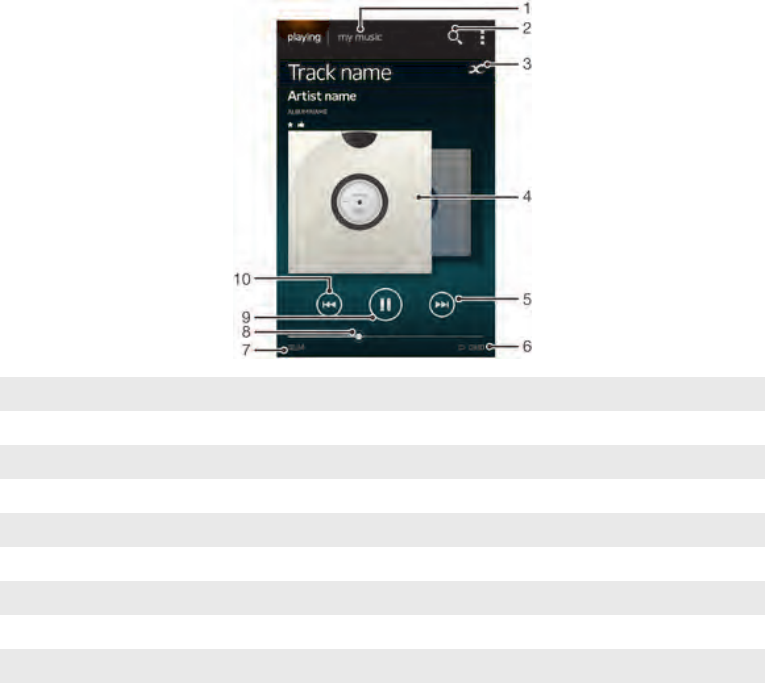
"WALKMAN" application
About the "WALKMAN" application
Get the most out of your "WALKMAN" application. Listen to and organise music and
audio books that you have transferred to your device from a computer, or purchased
and downloaded from online stores.
To make content easily available to the "WALKMAN" application, you can use the
Media Go™ application. Media Go™ helps transfer music content between a
computer and your device. For more information, see Connecting your device to a
computer on page 104.
"WALKMAN" application overview
1Browse your music
2 Search all tracks saved on your device
3 Tap the infinite button to find related information online and plug-ins on Google Play™
4 Album art (if available)
5 Go to the next track in the current play queue, or fast forward
6 Total time length of the track
7 Elapsed time of current track
8 Progress indicator – drag the indicator or tap along the line to fast forward or rewind
9 Play/Pause button
10 Go to the previous track in the current play queue, or rewind
Transferring media files to your device
Before using the "WALKMAN" application, it's a good idea to transfer all your
favourite media content from a computer to your device and then play or view this
content on your device. Media content can include music, photos and videos. The
easiest way to transfer files is with a USB cable. After you connect your device and
the computer using the USB cable, you can use the file manager application on the
computer or the Media Go™ application to transfer the files.
58
This is an Internet version of this publication. © Print only for private use.

Using the "WALKMAN" application
To play audio content
1From your Home screen, tap , then find and tap .
2In My music, select a music category and browse to the track that you want to
open.
3Tap a track to play it.
You might not be able to play copyright-protected items. Please verify that you have
necessary rights in material that you intend to share.
To change tracks
•When a track is playing, tap or .
•When a track is playing, swipe the album art left or right.
To pause a track
•Tap .
To fast forward and rewind music
•Touch and hold or .
You can also drag the progress indicator marker right or left.
To adjust the audio volume
•Press the volume key.
To improve the sound quality using the equaliser
1When the "WALKMAN" application is open, tap .
2Tap Settings > Sound enhancements.
3To adjust the sound manually, drag the frequency band buttons up or down.
To adjust the sound automatically, tap and select a style.
To turn on the surround sound feature
1When the "WALKMAN" application is open, tap .
2Tap Settings > Sound enhancements > Settings > Surround sound (VPT).
3Select a setting, then tap OK to confirm.
To view the current play queue
1While a track is playing in the "WALKMAN" application, tap .
2Tap Play queue.
To minimise the "WALKMAN" application
•When the "WALKMAN" application is playing, tap to go to the previous
screen, or tap to go to the Home screen. The "WALKMAN" application
stays playing in the background.
To open the "WALKMAN" application when it is playing in the background
1While a track is playing in the background, drag the status bar downwards to
open the Notification panel.
2Tap the track title to open the "WALKMAN" application.
Alternatively, you can press and then select the "WALKMAN" application.
To delete a track
1In My music, browse to the track that you want to delete.
2Touch and hold the track title, then tap Delete.
You can also delete albums this way.
59
This is an Internet version of this publication. © Print only for private use.

To send a track
1In My music, when browsing your tracks , touch and hold a track title.
2Tap Send.
3Select an application from the list, and follow the on-screen instructions.
You can also send albums and playlists in the same way.
To "Like" a track on Facebook™
1While the track is playing in the "WALKMAN" application, tap the album art.
2Tap to show that you "Like" the track on Facebook™. If desired, add a
comment in the comments field.
3Tap Share to send the track to Facebook™. If the track is received
successfully, you will get a confirmation message from Facebook™.
Visualiser
The Visualiser adds visual effects to your music tracks as you play them. The effects
for each track are based on the characteristics of the music. They change, for
example, in response to changes in the music’s loudness, rhythm and frequency
level. You can also change the background theme.
To turn on the Visualiser
1In the "WALKMAN" application, tap .
2Tap Visualiser.
Tap to switch to full screen view.
To change the background theme
1In the "WALKMAN" application, tap .
2Tap Visualiser.
3Tap > Theme and select a theme.
Getting more information about a track or artist
In the "WALKMAN" application, you can get more information about the artist that
you are listening to by tapping the infinite button .
The infinite button also gives you access to related content such as:
•Music videos on YouTube™
•Artist info on Wikipedia
•Lyrics on Google
•Karaoke videos on YouTube™
•Extension searches on the web
•Content from the PlayNow™ service
The accuracy of search results may vary.
To get more information about an artist or track
•When a track is playing in the "WALKMAN" application, tap .
Using My music to organise your tracks
Tap the My music tab in the "WALKMAN" application to get an overview of all the
tracks that are available from your device. In My music, you can manage your albums
and playlists, create shortcuts, and arrange your music by mood and tempo.
60
This is an Internet version of this publication. © Print only for private use.

Overview of My music
1 Go back to the current track
2 Picture of the currently playing artist (if available)
3 Browse your music by artist
4 Categorise your music using SensMe™ channels
5 Manage and edit your music using Music Unlimited™
6 Browse your favourite playlists
7 Collect links to music and related content that you and friends have shared using online services
8 Browse all playlists
9 Browse audio by track
10 Browse by album
To add a shortcut to a track
1In My music, tap , , or , then browse to the track for which you want to
create a shortcut.
2Touch and hold the track title.
3Tap Add as shortcut. The shortcut now appears in the My music main view.
To rearrange shortcuts
•In My music, touch and hold a shortcut until it magnifies and your device
vibrates, then drag the item to a new location.
To delete a shortcut
•In My music, touch and hold a shortcut until it magnifies and your device
vibrates, then drag the item to .
You can only delete shortcuts that you create yourself.
To update your music with the latest information
1In My music, tap .
2Tap Download music info > Start. Your device searches online and downloads
the latest available album art and track information for your music.
The SensMe™ channels application is activated when you download music information.
61
This is an Internet version of this publication. © Print only for private use.

Categorising your music using SensMe™ channels
The SensMe™ channels application helps you arrange your music by mood and
tempo. SensMe™ groups all your tracks into several categories, or channels, so you
can select music that matches your mood or suits the time of day.
To enable the SensMe™ channels application
•In My music, tap , then tap Download music info.
This application requires a mobile or Wi-Fi® network connection.
Using the Friends' music function to share music
The Friends’ music function collects links to music and music-related content that
you and your friends have shared using Facebook™.
To manage music from your friends
1In My music, tap Friends' music > Recent.
2Tap an item to open it, then work on it as desired.
3Tap to show that you "Like" the track on Facebook™. If desired, add a
comment in the comments field.
To view your shared music
1In My music, tap Friends' music > My shares.
2Scroll to an item you want to open, then tap it. All comments about the item, if
any, are displayed.
Playing music in random order
You can play tracks in playlists in random order. A playlist can be, for example, a
playlist you have created yourself or an album.
To play tracks in random order
1In My music, tap and navigate to an album, or tap and browse to a
playlist.
2Tap the album art, then tap to turn on Shuffle mode.
To turn off shuffle mode
•When tracks are playing in random order, tap the album art > .
Managing playlists
In My music, you can create your own playlists from the music that is saved on your
device.
In addition, you can install the Media Go™ application on a computer and use it to
copy playlists from the computer to your device.
To create your own playlists
1In the WALKMAN player, tap the MY MUSIC tab.
2Tap Playlists.
3In the menu that opens, tap Create new playlist.
4Enter a name for the playlist and tap OK.
5Select your music and tap the Save icon at the top right of the screen.
To add tracks to a playlist
1In My music, when browsing your tracks, touch and hold the name of the artist
or the title of the album or track that you want to add.
2Tap Add to playlist.
3Tap the name of the playlist to which you want to add the artist, album or
track. The artist, album or track is added to the playlist.
62
This is an Internet version of this publication. © Print only for private use.

To play your own playlists
1In My music, tap .
2Under Playlists, tap a playlist.
3Tap a track to play it.
To remove a track from a playlist
1In a playlist, touch and hold the title of the track you want to delete.
2Tap Delete from playlist from the list that appears.
To delete a playlist
1In My music, then select Playlists.
2Touch and hold the playlist you want to delete.
3Tap Delete.
4Tap Delete again to confirm.
You cannot delete default playlists.
"WALKMAN" application widget
The "WALKMAN" application widget is a miniature application that gives you direct
access to the "WALKMAN" application from your Home screen. You need to add this
widget to your Home screen before you can use it.
To add the "WALKMAN" application widget to your Home screen
1Tap an empty area on your Home screen, then tap Widgets.
2Find and tap WALKMAN.
Protecting your hearing
Listening to the "WALKMAN" application or other media players at excessive volume
or for a prolonged period of time can damage your hearing, even when the volume is
at a moderate level. To alert you to such risks, a volume level warning appears when
the volume is too high, and after the "WALKMAN" application is used for over 20
hours.
To turn off the volume level warning
•When appears, tap OK to dismiss the warning.
Every time you restart your device, the media volume is automatically set to a moderate level.
63
This is an Internet version of this publication. © Print only for private use.

Music services
TrackID™ technology
Identifying music using TrackID™ technology
Use the TrackID™ music recognition service to identify a music track you hear
playing in your surroundings. Just record a short sample of the song and you’ll get
artist, title and album info within seconds. You can purchase tracks identified by
TrackID™ and you can view TrackID™ charts to see what TrackID™ users around
the globe are searching for. For best results, use TrackID™ technology in a quiet
area.
The TrackID™ application and the TrackID™ service are not supported in all countries/regions,
or by all networks and/or service providers in all areas.
To open the TrackID™ application
1From your Home screen, tap .
2Find and tap TrackID™.
You can also use the TrackID™ widget to open the TrackID™ application.
To search for track information using TrackID™
1Open the TrackID™ application, then hold your device towards the music
source.
2Tap . If the track is recognised by the TrackID™ service, the results appear
on the screen.
To return to the TrackID™ start screen, press .
To view TrackID™ charts
1Open the TrackID™ application, then tap Charts. The first time you view a
chart, it is set to your own region.
2To see charts of the most popular searches in other regions, tap > Regions.
3Select a country or region.
Using TrackID™ technology results
Track information appears when the TrackID™ application recognises a track. You
can select to purchase the track or share it using email, SMS or a social networking
service. You can also get more information about the track's artist.
To buy a track recognised by the TrackID™ application
1After a track has been recognised by the TrackID™ application, tap Download.
2Follow the instructions on your device to complete your purchase.
You can also select a track to buy by opening the History or Charts tabs from the TrackID™
start screen.
The track purchase feature may not be supported in all countries/regions, or by all networks
and/or service providers in all areas.
To share a track
1After a track has been recognised by the TrackID™ application, tap Share,
then select a sharing method.
2Follow the instructions on your device to complete the procedure.
You can also select a track to share by opening the History or Charts tabs from the TrackID™
start screen.
64
This is an Internet version of this publication. © Print only for private use.

To view the artist information for a track
•After a track has been recognised by the TrackID™ application, tap Artist info.
You can also view the artist information for a track by opening the History or Charts tabs from
the TrackID™ start screen.
To delete a track from the track history
1Open the TrackID™ application, then tap History.
2Tap a track title, then tap Delete.
3Tap Yes to confirm.
Music Unlimited™
Using Music Unlimited™
Music Unlimited™ is a subscription-based service that offers access to millions of
songs over a mobile network or Wi-Fi® connection. You can manage and edit your
personal music library in the cloud from a variety of devices, or sync your playlists
and music using a PC that runs the Windows® operating system. Go to
www.sonyentertainmentnetwork.com for more information.
Music Unlimited™ might not be available in all countries or regions.
To open Music Unlimited™
1From your Home screen, tap .
2Find and tap .
About the PlayNow™ service
You can use the PlayNow™ service to download applications, music, games,
ringtones and wallpapers. The PlayNow™ service offers both free and non-free
downloads. Note that payment options for non-free applications may vary per
country.
The PlayNow™ service is not available in all countries.
Before you download content
Before you download, make sure that you have an Internet connection. Also, you may
need to have a memory card inserted in your device to download content.
When you download content to your device, you might be charged for the amount of data
transferred. Contact your operator for information about data transfer rates in your country.
To start PlayNow™
1From the Home screen, tap .
2Find and tap .
Downloading from the PlayNow™ service
Download a range of content from the PlayNow™ service direct to your device.
Choose from a variety of applications, games, music, ringtones and other content.
Note that payment options for non-free applications may vary per country.
65
This is an Internet version of this publication. © Print only for private use.

To download a PlayNow item to your device
1From your Home screen, tap .
2Find and tap PlayNow™.
3Find an item you want to download by browsing categories, or by using the
search function.
4Tap the item to view its details.
5Click “Buy now!” to start the purchase process. After your purchase has been
validated, you can start to download your content.
66
This is an Internet version of this publication. © Print only for private use.
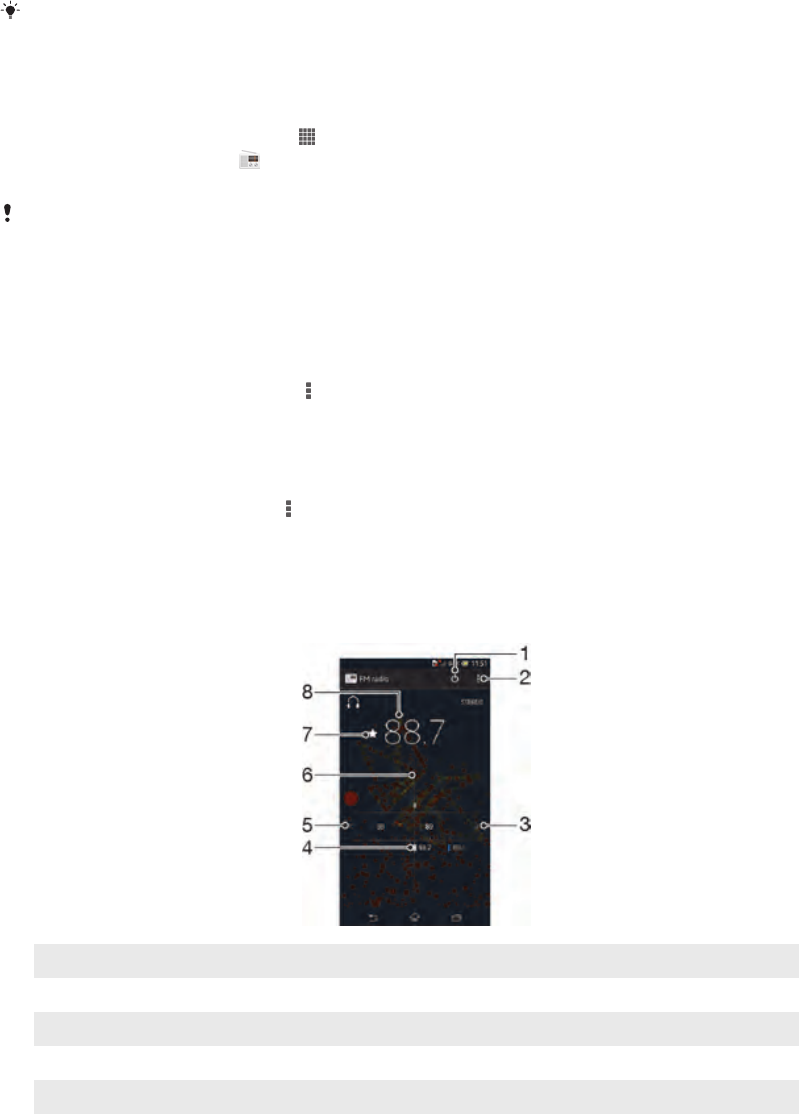
FM radio
About the FM radio
The FM radio in your device works like any FM radio. For example, you can browse
and listen to FM radio stations and save them as favourites. You must connect a
wired headset or headphones to your device before you can use the radio. This is
because the headset or headphones act as an antenna. After one of these devices is
connected, you can then switch the radio sound to the speaker, if desired.
When you open the FM radio, available channels appear automatically. If a channel has RDS
information, it appears a few seconds after you start listening to the channel.
To start the FM radio
1Connect a headset or a set of headphones to your device.
2From your Home screen, tap .
3Find and tap FM radio . The available channels appear as you scroll through
the frequency band.
When you start the FM radio, available channels appear automatically. If a channel has RDS
information, it appears a few seconds after you start listening to the channel.
To move between radio channels
•Flick your finger up or down along the frequency band.
To select the radio region
1When the radio is open, press .
2Tap Set radio region.
3Select an option.
To adjust the visualizer
1When the radio is open, tap .
2Tap Visualiser.
3Select an option.
FM radio overview
1Radio on/off button
2 View menu options
3 Move up the frequency band to search for a channel
4 A saved favourite channel
5 Move down the frequency band to search for a channel
6 Tuning dial
67
This is an Internet version of this publication. © Print only for private use.

7 Save or remove a channel as a favourite
8 Tuned frequency
Using your favourite radio channels
You can save the radio channels you most frequently listen to as favourites. By using
favourites you can quickly return to a radio channel.
To save a channel as a favourite
1When the radio is open, navigate to the channel that you want to save as a
favourite.
2Tap .
3Enter a name and select a colour for the channel, then press Save.
To remove a channel as a favourite
1When the radio is open, navigate to the channel that you want to remove.
2Tap , then tap Delete.
Making a new search for radio channels
If you have moved to a new location or the reception has improved in your current
location, you can start a new scan for radio channels.
Any favourites you have saved are not affected by a new scan.
To start a new search for radio channels
1When the radio is open, press .
2Tap Search for channels. The radio scans the whole frequency band, and all
available channels are displayed.
Sound settings
Switching the radio sound between devices
You can listen to the radio through a wired headset or through wired headphones.
Once either device is connected, you can switch the sound to the speaker, if desired.
To switch the radio sound to the speaker
1When the radio is open, press .
2Tap Play in speaker.
To switch the sound back to the wired headset or headphones, press and tap Play in
headphones.
Switching between mono and stereo sound mode
You can listen to your FM radio in either mono or stereo mode. In some situations,
switching to mono mode can reduce noise and improve sound quality.
To switch between mono and stereo sound mode
1When the radio is open, press .
2Tap Enable stereo sound.
3To listen to the radio in mono sound mode again, press and tap Force mono
sound.
Identifying radio tracks using TrackID™
Use TrackID™ technology to identify music tracks as they play on your device's FM
radio.
68
This is an Internet version of this publication. © Print only for private use.

To identify a song on the FM radio using TrackID™
1While the song is playing on your device's FM radio, tap TrackID™.
2A progress indicator appears while the TrackID™ application samples the
song. If successful, you are presented with a track result or a list of possible
tracks.
3Press to return to the FM Radio.
The TrackID™ application and the TrackID™ service are not supported in all countries/regions,
or by all networks and/or service providers in all areas.
69
This is an Internet version of this publication. © Print only for private use.
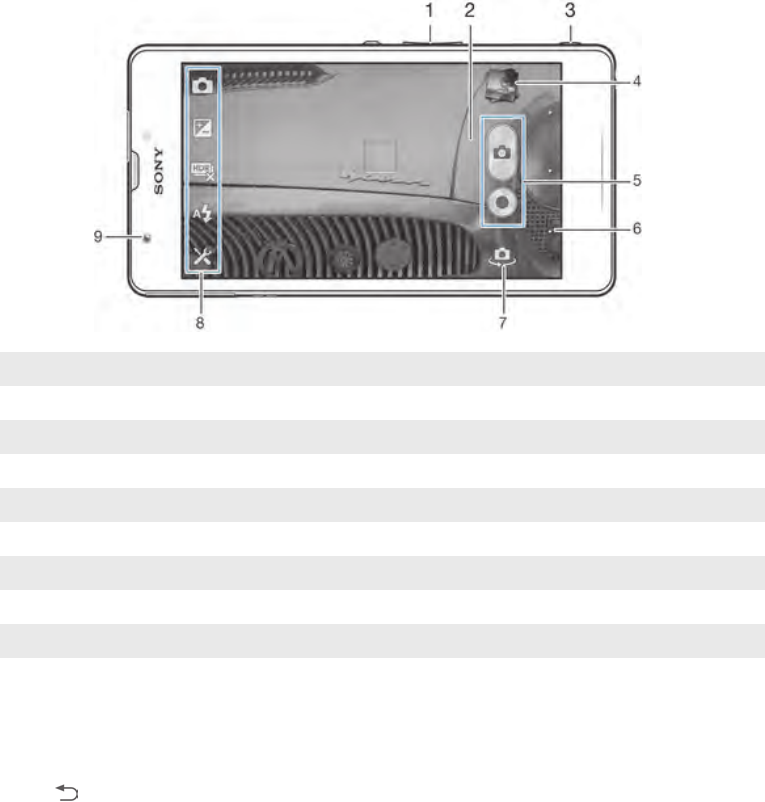
Camera
About the camera
The camera in your device is equipped with the highly sensitive Exmor R sensor,
which helps you capture sharp photos and videos even in low lighting conditions.
From the camera, you can, for example, send your photos and videos to friends as
messages, or upload them to a web service. Your device also has a front camera,
which is useful for self-portraits.
Camera controls overview
1Zoom in or out
2 Main camera screen
3 Camera key – Activate the camera/Take photos/Record videos
4 View photos and videos
5 Take photos or record video clips
6 Go back a step or exit the camera
7 Switch between front and main camera
8 Camera setting icons
9 Front camera
To open the camera
•When the screen is active, press and hold down the camera key.
To close the camera
•Press from the main camera screen.
Using the still camera
There are three ways to take photos with the still camera. You can press the camera
key, tap the on-screen camera button, or touch a spot on the screen.
To take a photo using the camera key
1Activate the camera.
2Press the camera key fully down.
70
This is an Internet version of this publication. © Print only for private use.

To take a photo by tapping the on-screen camera button
1Activate the camera.
2Point the camera towards the subject.
3Tap the on-screen camera button . The photo is taken as soon as you release
your finger.
To take a self-portrait using the front camera
1Activate the camera.
2Tap the icon on the top left of the screen, then find and select Front camera.
3To take the photo, press the camera key. The photo is taken as soon as you
release your finger.
To use the zoom function
•When the camera is open, press the volume key up or down to zoom in or out.
To use the still camera flash
1When the camera is open, tap .
2Tap Flash, and select your desired flash setting.
3Take the photo.
To view your photos and videos
1Open the camera, then tap a thumbnail at the top right of the screen to open a
photo or video.
2Flick left or right to view your photos and videos. Videos are identified by .
To delete a photo
1Open the photo that you want to delete.
2Tap an empty area of the screen to make appear.
3Tap .
4Tap OK to confirm.
Face detection
You can use face detection to bring an off-centre face into focus. The camera
automatically detects up to five faces, indicated by white frames. A yellow frame
shows which face has been selected for focus. Focus is set to the face closest to the
camera. You can also tap one of the frames to select which face should be in focus.
To turn on face detection
1Activate the camera.
2Tap the icon on the top left of the screen, then select Normal.
3To display all settings, tap .
4Tap Focus mode > Face detection.
To take a photo using face detection
1When the camera is open and Face detection turned on, point the camera at
your subject. Up to five faces can be detected, and each detected face is
framed.
2Press the camera key halfway down. A yellow frame shows which face is in
focus.
3To take the photo, press the camera key fully down.
Using Smile Shutter™ to capture smiling faces
Use Smile Shutter™ technology to photograph a face just as it smiles. The camera
detects up to five faces and selects one face for smile detection and auto focus.
When the selected face smiles, the camera automatically takes a photo.
71
This is an Internet version of this publication. © Print only for private use.

To turn on Smile Shutter™
1Activate the camera.
2To display all settings, tap .
3Tap Smile Shutter and select a smile level.
To take a photo using Smile Shutter™
1When the camera is open and Smile Shutter is turned on, point the camera at
your subject. The camera selects which face to focus on.
2The face selected appears inside a green frame and the photo is taken
automatically.
3If no smile is detected, press the camera key to take the photo manually.
Adding the geographical position to your photos
Turn on geotagging to add the approximate geographical location (a geotag) to
photos when you take them. The geographical location is determined either by
wireless networks (mobile or Wi-Fi® networks) or GPS technology.
When appears on the camera screen, geotagging is turned on but the
geographical position has not been found. When appears, geotagging is turned on
and the geographical location is available, so your photo can get geotagged. When
neither of these two symbols appears, geotagging is turned off.
To turn on geotagging
1Activate the camera.
2Tap , then tap Geotagging > On.
3Tap OK to agree to enable GPS and/or wireless networks.
4Check the options that you want to select under Location services.
5After you confirm your settings, press to return to the camera screen.
6If appears on the camera screen, your location is available and your photo
can get geotagged. If not, check your GPS and/or wireless network
connection.
Using still camera settings
To adjust the still camera settings
1Activate the camera.
2To display all settings, tap .
3Select the setting that you want to adjust, then edit as desired.
To customise the still camera settings panel
1When the camera is open, tap to display all settings.
2Touch and hold the setting you want to move and drag it to the desired
position.
If you drag the setting outside of the settings panel, the change is cancelled.
Still camera settings overview
Superior auto
Optimise your settings to suit any scene.
Burst
Use the Burst speed shooting mode to capture several photos in quick succession by keeping
your finger pressed on the shutter button. You can choose between three burst speeds, which
come with different resolution levels, that is, different picture sizes.
Normal
Front camera
Select the front camera if you want to take self-portrait photos.
72
This is an Internet version of this publication. © Print only for private use.

Picture effect
Apply effects to photos.
Scene selection
Use a pre-programmed scene type to quickly set the camera for common situations.
Sweep Panorama
Use this setting to take wide-angle, panoramic photos. Just press the camera key and move the
camera steadily from one side to the other.
Resolution
Choose between several picture sizes and aspect ratios before taking a photo. A
photo with a higher resolution requires more memory.
13 MP 4:3
13 megapixel picture size with 4:3 aspect ratio. Suitable for photos you want to view on non-
widescreen displays or print in high resolution. 13MP is available in the following conditions: select
Normal capturing mode and HDR is off; select Scene mode except in Backlight Correction HDR
mode.
12 MP 4:3
12 megapixel picture size with 4:3 aspect ratio. Suitable for photos you want to view on non-
widescreen displays or print in high resolution. 12MP is maximum resoluted in Superior Auto mode.
9 MP 16:9
9 megapixel picture size with 16:9 aspect ratio. A high resolution widescreen format. Has a higher
resolution than full HD. Suitable for photos you want to view on widescreen displays.
5MP 4:3
5 megapixel picture size with 4:3 aspect ratio. Suitable for photos you want to view on non-
widescreen displays or print in high resolution.
2MP 16:9
2 megapixel picture size with 16:9 aspect ratio. Suitable for photos you want to view on widescreen
displays.
VGA
VGA format with 4:3 aspect ratio. 640x480 pixels.
12 MP is the maximum resolution available when photos are taken using Superior auto mode;
when HDR is turned on in Normal mode; or when Scenes (Backlight correction HDR mode)
mode is selected.
The 13 MP resolution is only available when Normal capturing mode is selected and HDR is
turned off, and when Scenes mode is selected (except in Backlight correction HDR mode).
Flash
Use the flash to take photos when lighting conditions are poor or when there is a
backlight.
Auto
The camera automatically determines if the lighting conditions require the use of a flash.
Fill flash
Use this setting when the background is brighter than the subject. This removes unwanted dark
shadows.
Off
The flash is turned off. Sometimes photo quality can be better without the flash, even if lighting
conditions are poor. Taking a good photo without using the flash requires a steady hand. Use the
self-timer to avoid blurred photos.
Red-eye reduction
Reduces the red colour of eyes when taking a photo.
Self-timer
With the self-timer you can take a photo without holding the device. Use this function
to take self-portraits, or group photos where everyone can be in the photo. You can
also use the self-timer to avoid shaking the camera when taking photos.
73
This is an Internet version of this publication. © Print only for private use.

On (10 s.)
Set a 10-second delay from when you tap the camera screen until the photo is taken.
On (2 s.)
Set a 2-second delay from when you tap the camera screen until the photo is taken.
Off
The photo is taken as soon as you tap the camera screen.
Smile Shutter™
Use the smile shutter function to determine what kind of smile the camera reacts to
before taking a photo.
Quick launch
Use Quick launch settings to launch the camera from the lock screen. If the device is
in sleep mode of camera, press the camera key.
Launch and capture
By pressing and holding down the camera key, the first photo is captured immediately after the
camera is launched from sleep mode.
Launch only (still camera)
By pressing and holding down the camera key, the still camera is launched from sleep mode.
Launch and record video
By pressing and holding down the camera key, the first video is shot immediately after the camera
video camera is launched from sleep mode.
Launch only (video camera)
By pressing and holding down the camera key, the video camera is launched from sleep mode.
Off
Focus mode
The focus function controls which part of a photo should be sharp. When continuous
autofocus is on, the camera keeps adjusting focus so that the area within the yellow
focus frame stays sharp.
Single auto focus
The camera automatically focuses on the selected subject. Continuous autofocus is on. Touch and
hold the camera screen until the yellow focus frame turns blue, indicating that the focus is set. The
photo is taken when you release your finger.
Multi auto focus
The focus is automatically set on several areas of the image. Touch and hold the camera screen
until the yellow focus frame turns blue, indicating that the focus is set. The photo is taken when you
release your finger. Continuous autofocus is off.
Face detection
The camera automatically detects up to five human faces, indicated by frames on the screen. The
camera automatically focuses on the nearest face. You can also select which face to focus on by
tapping it on the screen. When you tap the camera screen, a blue frame shows which face is
selected and in focus. Face detection cannot be used for all scene types. Continuous autofocus is
on.
Touch focus
Touch a specific area on the camera screen to set the area of focus. Continuous autofocus is off.
Touch and hold the camera screen until the yellow focus frame turns blue, indicating that the focus
is set. The photo is taken when you release your finger.
Object tracking
When you select an object by touching it in the viewfinder, the camera tracks it for you.
This setting is only available in Normal capturing mode.
Exposure value
74
This is an Internet version of this publication. © Print only for private use.

Determine the amount of light in the photo you want to take. A higher value indicates an increased
amount of light.
This setting is only available in Normal capturing mode.
HDR
Use the HDR (High Dynamic Range) setting to take a photo against strong back light
or in conditions where the contrast is sharp. HDR compensates for the loss of detail
and produces a picture that is representative of both dark and bright areas.
This setting is only available in Normal capturing mode.
White balance
The white balance setting adjusts the colour balance according to the lighting
conditions.
Auto
Adjusts the colour balance automatically to suit the lighting conditions.
Incandescent
Adjusts the colour balance for warm lighting conditions, such as under light bulbs.
Fluorescent
Adjusts the colour balance for fluorescent lighting.
Daylight
Adjusts the colour balance for sunny outdoor conditions.
Cloudy
Adjusts the colour balance for a cloudy sky.
This setting is only available in Normal capturing mode.
ISO
You can reduce image blurring caused by dark conditions or moving subjects by
increasing the ISO sensitivity.
Auto
Sets the ISO sensitivity automatically.
100
Sets the ISO sensitivity to 100.
200
Sets the ISO sensitivity to 200.
400
Sets the ISO sensitivity to 400.
800
Sets the ISO sensitivity to 800.
1600
Sets the ISO sensitivity to 1600.
This setting is only available in Normal capturing mode.
Metering
This function automatically determines a well-balanced exposure by measuring the
amount of light striking the image you want to capture.
Centre
Adjusts the exposure to the centre of the image.
Average
Calculates the exposure based on the amount of light striking the whole image.
75
This is an Internet version of this publication. © Print only for private use.

Spot
Adjusts the exposure in a very small part of the image that you want to capture.
This setting is only available in Normal capturing mode.
Image stabiliser
When taking a photo, it can be difficult to hold the device steady. The stabiliser helps
you by compensating for small movements of the hand.
Geotagging
Tag photos with details of where you took them.
On
When geotagging is turned on, the approximate geographical location is added to photos when you
take them. To use geotagging, you must enable location features from the Settings menu. For
geotags to be added to a photo, the location must be determined before you take the photo. Your
location is determined when appears on the camera screen. When your device is searching for
your position, appears.
Off
When geotagging is turned off, you cannot view the location where you took a photo.
Auto upload
Automatically upload updates to photos to a pre-selected social networking service
(SNS).
Touch capture
Identify a particular focus area by touching the camera screen with your finger. The
photo is taken as soon as you release your finger. This setting is only available when
focus mode is set to touch focus.
On
Off
Shutter sound
Choose to turn on or turn off the shutter sound when you record a video.
Data storage
You can choose to save your data either to a removable SD card or to your device's
internal storage.
Internal storage
Photos or videos are saved on the device memory.
SD card
Photos or videos are saved on the SD card.
Using the video camera
To record a video using the camera key
1Activate the camera.
2To start recording a video, press the camera key.
3To stop recording, press the camera key again.
Shoot your videos in landscape orientation to get the best results.
76
This is an Internet version of this publication. © Print only for private use.

To record a video by tapping the screen
1Activate the camera.
2Point the camera towards the subject.
3Tap to start recording.
4Tap to stop recording.
Shoot your videos in landscape orientation to get the best results.
To play recorded videos
1Activate the camera.
2Tap the thumbnails at the top right of the screen.
3Flick left or right to browse all photo and video files. Videos are identified by .
4Tap to play a video.
5To stop playing the video, tap or .
To delete a recorded video
1Browse to the video that you want to delete.
2Tap an empty area of the screen to make appear.
3Tap .
4Tap OK to confirm.
Using video camera settings
To adjust the video camera settings
1Activate the camera.
2Tap one of the settings icons on the screen.
3To display all settings, tap .
4Select the setting that want to adjust, then make your changes.
To customise the video camera settings panel
1When the video camera is open, tap to display all settings.
2Touch and hold the setting that you want to move, then drag it to the desired
position.
If you drag the setting outside of the settings panel, the change is cancelled.
Video camera settings overview
Scenes
The Scenes feature helps you to quickly set up the camera for common situations
using pre-programmed scenes. The camera determines a number of settings for you
to fit the selected scene, ensuring the best possible video.
Off
The Scenes feature is off and you can shoot videos manually.
Soft snap
Use for shooting videos against soft backgrounds.
Landscape
Use for videos of landscapes. The camera focuses on distant objects.
Night
When turned on, light sensitivity is increased. Use in poorly lit environments. Videos of fast-moving
objects may get blurred. Hold your hand steady, or use a support. Turn off night mode when lighting
conditions are good, to improve the video quality.
Beach
Use in bright environments to avoid overexposed videos.
Snow
Use in bright environments to avoid overexposed videos.
Sports
77
This is an Internet version of this publication. © Print only for private use.

Use for videos of fast-moving objects. Short exposure time minimises motion blurring.
Party
Use for indoor videos in poorly lit environments. This scene picks up indoor background lighting or
candlelight. Videos of fast-moving objects may get blurred. Hold your hand steady, or use a
support.
Video resolution
Adjust the video resolution for different formats.
1920×1080(16:9)
Full HD (Full High Definition) format with 16:9 aspect ratio. 1920×1080 pixels.
1280×720(16:9)
HD (High Definition) format with 16:9 aspect ratio. 1280×720 pixels.
640×480(4:3)
VGA format with 4:3 aspect ratio. 640x480 pixels.
176×144(11:9)
Record videos suitable for sending in multimedia messages. The recording time of this video format
is limited to fit in a multimedia message.
Photo light
Use the light to record videos when lighting conditions are poor or when there is a
backlight.
On
Off
Sometimes the video quality can be better without a light, even if lighting conditions are poor.
Self-timer
With the self-timer you can record a video without holding the device. Use it to record
group videos where everyone can be in the video. You can also use the self-timer to
avoid shaking the camera when recording videos.
On (10 s.)
Set a 10-second delay from when you tap the camera screen until the video begins to record.
On (2 s.)
Set a 2-second delay from when you tap the camera screen until the video begins to record.
Off
The video begins to record as soon as you tap the camera screen.
Quick launch
Use Quick launch settings to launch the camera from the lock screen. If the device is
in sleep mode of camera, press the camera key.
Launch and capture
By pressing and holding down the camera key, the first photo is captured immediately after the
camera is launched from sleep mode.
Launch only (still camera)
By pressing and holding down the camera key, the still camera is launched from sleep mode.
Launch and record video
By pressing and holding down the camera key, the first video is shot immediately after the camera
video camera is launched from sleep mode.
Launch only (video camera)
By pressing and holding down the camera key, the video camera is launched from sleep mode.
Off
78
This is an Internet version of this publication. © Print only for private use.

Focus mode
The focus setting controls which part of a video should be sharp. When continuous
autofocus is on, the camera keeps adjusting focus so that the area within the white
focus frame stays sharp.
Single auto focus
The camera automatically focuses on the selected subject. Continuous autofocus is on.
Face detection
The camera automatically detects up to five human faces, indicated by frames on the screen. The
camera automatically focuses on the nearest face. You can also select which face to focus on by
tapping it on the screen. When you tap the camera screen, a yellow frame shows which face is
selected and in focus. Face detection cannot be used for all scene types. Continuous autofocus is
on.
Object tracking
When you select an object by touching it in the viewfinder, the camera tracks it for you.
Exposure value
This setting allows you to determine the amount of light in the image you capture. A higher value
indicates an increased amount of light.
White balance
The white balance setting adjusts the colour balance according to the lighting
conditions.
Auto
Adjust the colour balance automatically to the lighting conditions.
Incandescent
Adjusts the colour balance for warm lighting conditions, such as under light bulbs.
Fluorescent
Adjust the colour balance for fluorescent lighting.
Daylight
Adjust the colour balance for sunny outdoor conditions.
Cloudy
Adjust the colour balance for a cloudy sky.
Metering
This function automatically determines a well-balanced exposure by measuring the
amount of light striking the image that you want to capture.
Centre
Adjust the exposure to the centre of the image.
Average
Calculate the exposure based on the amount of light striking the whole image.
Spot
Adjust the exposure in a very small part of the image that you want to capture.
Geotagging
Tag photos with details of where you took them.
On
When geotagging is turned on, the approximate geographical location is added to photos when you
take them. To use geotagging, you must enable location features from the Settings menu. For
geotags to be added to a photo, the location must be determined before you take the photo. Your
location is determined when appears on the camera screen. When your device is searching for
your position, appears.
Off
When geotagging is turned off, you cannot view the location where you took a photo.
79
This is an Internet version of this publication. © Print only for private use.

Microphone
Select whether to pick up the surrounding sound when recording videos.
Touch capture
Identify a particular focus area by touching the camera screen with your finger. The
photo is taken as soon as you release your finger. This setting is only available when
focus mode is set to touch focus.
On
Off
Shutter sound
Choose to turn on or turn off the shutter sound when you record a video.
Data storage
You can choose to save your data either to a removable SD card or to your device's
internal storage.
Internal storage
Photos or videos are saved on the device memory.
SD card
Photos or videos are saved on the SD card.
80
This is an Internet version of this publication. © Print only for private use.

Album
About Album
Use Album to view photos and play videos that you’ve taken with your camera, or to
view similar content that you've saved to your device. You can add geotags to your
photos and videos, and then view them on a world map. In Album, you can also view
photos and videos that you've uploaded to an online service, for example, to a
Picasa™ web album or to Facebook™.
From Album, you can share your favourite photos and videos with friends via
Bluetooth™ wireless technology, email, messaging and various online services. You
can also perform basic editing tasks on photos and set them as wallpaper or contact
pictures. For more information, see Connecting your device to a computer
on page 104.
Album tab overview
The following tabs are available in Album:
•Pictures – view all photos and videos saved on your device.
•My albums – view your online albums, and your geotagged photos and video clips on
a world map .
To open Album
1From your Home screen, tap .
2Find and tap Album.
If the screen orientation does not change automatically when you turn your device sideways,
mark the Auto-rotate screen checkbox under Settings > Display.
Mobile BRAVIA® Engine
Sony's Mobile BRAVIA® Engine technology improves the viewing quality of photos
and videos after you take them, giving you clearer, sharper and more natural images.
Mobile BRAVIA Engine is turned on by default, but you can turn it off if you want to
reduce battery consumption.
To turn on Mobile BRAVIA® Engine
1From your Home screen, tap .
2Find and tap Settings > Display.
3Mark the Mobile BRAVIA Engine 2 checkbox if it is not marked.
Viewing photos and videos in the Pictures tab
In the Pictures tab in Album, you can view your photos and videos in thumbnails in a
grid view.
81
This is an Internet version of this publication. © Print only for private use.
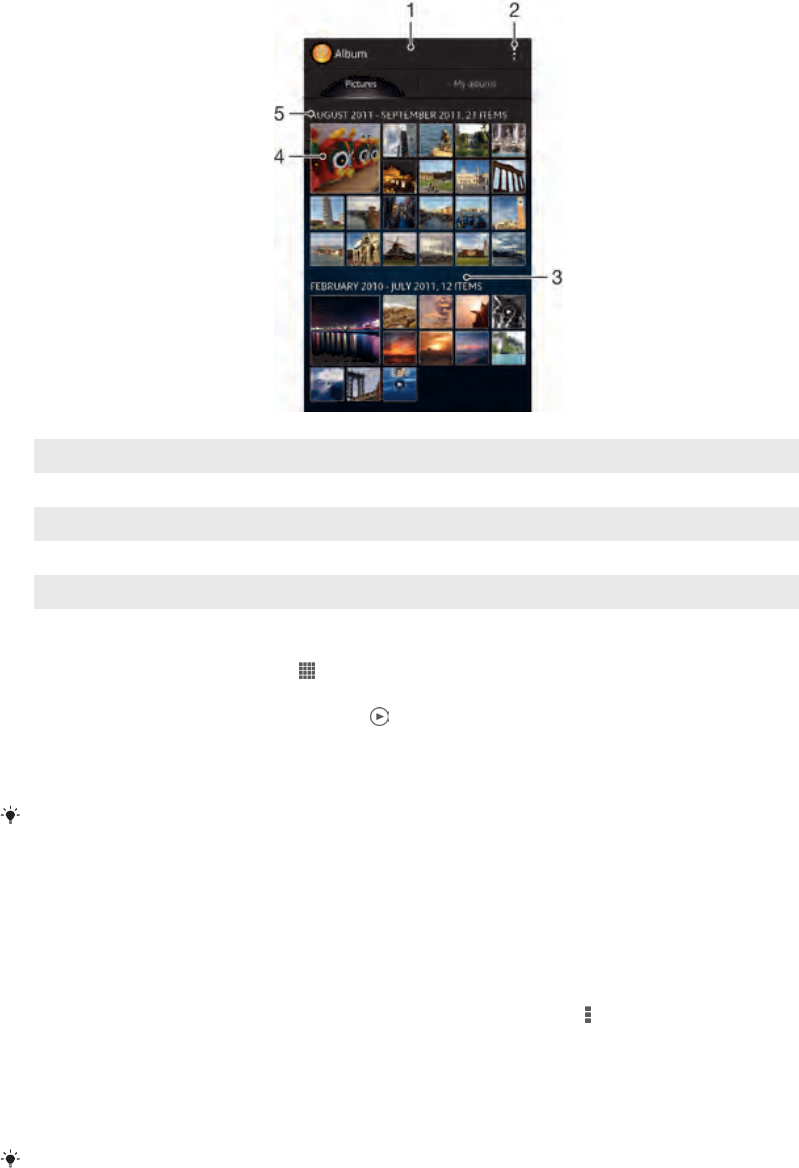
Overview of Pictures tab
1 Grid view of photos and videos.
2 View menu options.
3 Scroll up or down to view content.
4 Tap a photo or video to view it.
5 The date and number of items in the group below.
To view photos and videos in grid view
1From your Home screen, tap .
2Find and tap Album. All photos and videos are displayed in a chronologically
ordered grid. Videos are indicated by .
3Tap a photo or video to view it.
4Flick left to view the next photo or video. Flick right to view the previous photo
or video.
If the screen orientation does not change automatically when you turn your device sideways,
mark the Auto-rotate screen checkbox under Settings > Display.
To change the size of the thumbnails in Album
•When viewing thumbnails of photos and videos in Album, spread two fingers
apart to zoom in, or pinch two fingers together to zoom out.
To work with batches of photos or videos in Album
1When viewing thumbnails of photos and videos in Album, tap , then tap Select
items.
2Tap the items you want to work with. Selected items are indicated by a blue
frame.
3Use the tools in the toolbar at the top of the screen to work with your selected
items.
To activate selection mode, you can also touch and hold an item until its frame turns blue.
Then you can tap other items to select them.
Viewing photos and videos in the My albums tab
The following tiles are available in My albums:
•Camera albums – view all photos and videos taken with your device’s camera.
•Internal memory – view all photos and videos saved to your device's internal storage.
82
This is an Internet version of this publication. © Print only for private use.

•My SD card – view all photos and videos saved to a removable memory card in your
device.
Overview of My albums tab
1 View photos and videos using the PlayMemories online service.
2 View photos and videos on Facebook™.
3 View photos and videos in Picasa™.
4 View your photos on a map.
5 View all photos and videos saved to your device's internal storage.
6 View all photos and videos saved to the removable memory card.
7 View your photos in globe mode.
8 View all photos and videos taken with your device’s camera.
To view content in list view in the Camera albums tile
1From your Home screen, tap .
2Find and tap Album > My albums > Camera albums.
3Tap a folder that you want to open. The folder's content appears in a
chronologically ordered grid. Videos are indicated by .
4Tap a photo or video to view it.
5Flick left to view the next photo or video. Flick right to view the previous photo
or video.
If the screen orientation does not change automatically when you turn your device sideways,
mark the Auto-rotate screen checkbox under Settings > Display.
To view content in list view in the Internal memory tile
1From your Home screen, tap .
2Find and tap Album > My albums > Internal memory.
3Tap a folder that you want to open. The folder's content appears in a
chronologically ordered grid. Videos are indicated by .
4Tap a photo or video to view it.
5Flick left to view the next photo or video. Flick right to view the previous photo
or video.
If the screen orientation does not change automatically when you turn your device sideways,
mark the Auto-rotate screen checkbox under Settings > Display.
83
This is an Internet version of this publication. © Print only for private use.

To view content in list view in the My SD card tile
1From your Home screen, tap .
2Find and tap Album > My albums > My SD card.
3Tap a folder that you want to open. The folder's content appears in a
chronologically ordered grid. Videos are indicated by .
4Tap a photo or video to view it.
5Flick left to view the next photo or video. Flick right to view the previous photo
or video.
If the screen orientation does not change automatically when you turn your device sideways,
mark the Auto-rotate screen checkbox under Settings > Display.
Working with photos in Album
You can edit photos in Album. For example, you can crop photos, associate them
with contacts, or use them as wallpaper.
To zoom a photo
•When you are viewing a photo, double-tap the screen to zoom in. Double-tap again
to zoom out.
•When you are viewing a photo, spread two fingers apart to zoom in, or pinch two
fingers together to zoom out.
To watch a slideshow of your photos
1When you are viewing a photo, tap the screen to display the toolbars, then tap
> Slideshow to start playing all the photos in an album.
2Tap a photo to end the slideshow.
To watch a slideshow of your photos with music
1When you are viewing a photo, tap the screen to display the toolbars, then tap
> SensMe™ slideshow.
2Select the music and theme that you want to use for the slideshow, then tap
. The Album application analyses your photos and uses SensMe™ music
data to play a slideshow.
3To pause playing, tap the screen to display the controls, then tap .
For more information about SensMe™, see Categorising your music using SensMe™
channels on page 62.
To rotate a photo
1When you are viewing a photo, tap the screen to display the toolbars, then tap
.
2Select Rotate left or Rotate right. The photo is saved in the new orientation.
To crop a photo
1When you are viewing a photo, tap the screen to display the toolbars, then tap
> Edit photo > Crop.
2To adjust the crop frame, touch and hold the edge of the crop frame. When the
squares at the edges disappear, drag inward or outward to resize the frame.
3To resize all sides of the crop frame at the same time, touch and hold one of
the four corners to make the squares at the edges disappear, then drag the
corner accordingly.
4To move the crop frame to another area of the photo, touch and hold inside the
frame, then drag it to the desired position.
5To save a copy of the photo as you cropped it, tap Save. The original
uncropped version remains on your device.
To use a photo
1When you are viewing a photo, tap the screen to display the toolbars, then tap
> Use as.
2Select an option from the list that appears.
3Follow the relevant steps to use the photo.
84
This is an Internet version of this publication. © Print only for private use.

To edit a photo
•When you are viewing a photo, tap the screen to display the toolbars, then tap
> Edit photo.
To share a photo
1When you are viewing a photo, tap the screen to display the toolbars, then tap
.
2In the menu that opens, tap the application that you want to use to share the
photo, then follow the steps to send it.
To add a geotag to a photo
1When you are viewing a photo, tap the screen to display the toolbars, then tap
to open the map screen.
2Find and tap the desired location to put the photo on the map.
3To adjust the location of the photo, tap the location on the map to where you
want to move the photo.
4When you are finished, tap OK to save the geotag and return to the photo
viewer.
When a photo is geotagged, appears along with location information. You can tap this icon
to view the photo on a map.
To delete a photo
1When you are viewing a photo, tap the screen to display the toolbars, then tap
.
2Tap OK.
Working with videos in Album
Use Album to watch videos that you’ve taken with the camera, downloaded, or
copied to your device. You can also share your videos with friends, for example, by
uploading them to online services.
To play a video
1Open the Pictures tab or the My albums tab in Album.
2Using grid view or list view, locate the video that you want to open.
3Tap the video to play it.
4If the playback controls are not displayed, tap the screen to display them. To
hide the controls, tap the screen again.
To pause a video
1When a video is playing, tap the screen to display the controls.
2Tap .
To fast forward and rewind a video
1When a video is playing, tap the screen to display the controls.
2Drag the progress bar marker left to rewind, or right to fast forward.
To adjust the volume of a video
•Press the volume key.
To share a video
1When a video is playing, tap the screen to display the toolbars, then tap >
Share.
2In the menu that opens, tap the application that you want to use to share the
selected video, then follow the relevant steps to send it.
You might not be able to copy, send or transfer copyright-protected items. Also, some items
may not send if the file size is too large.
85
This is an Internet version of this publication. © Print only for private use.
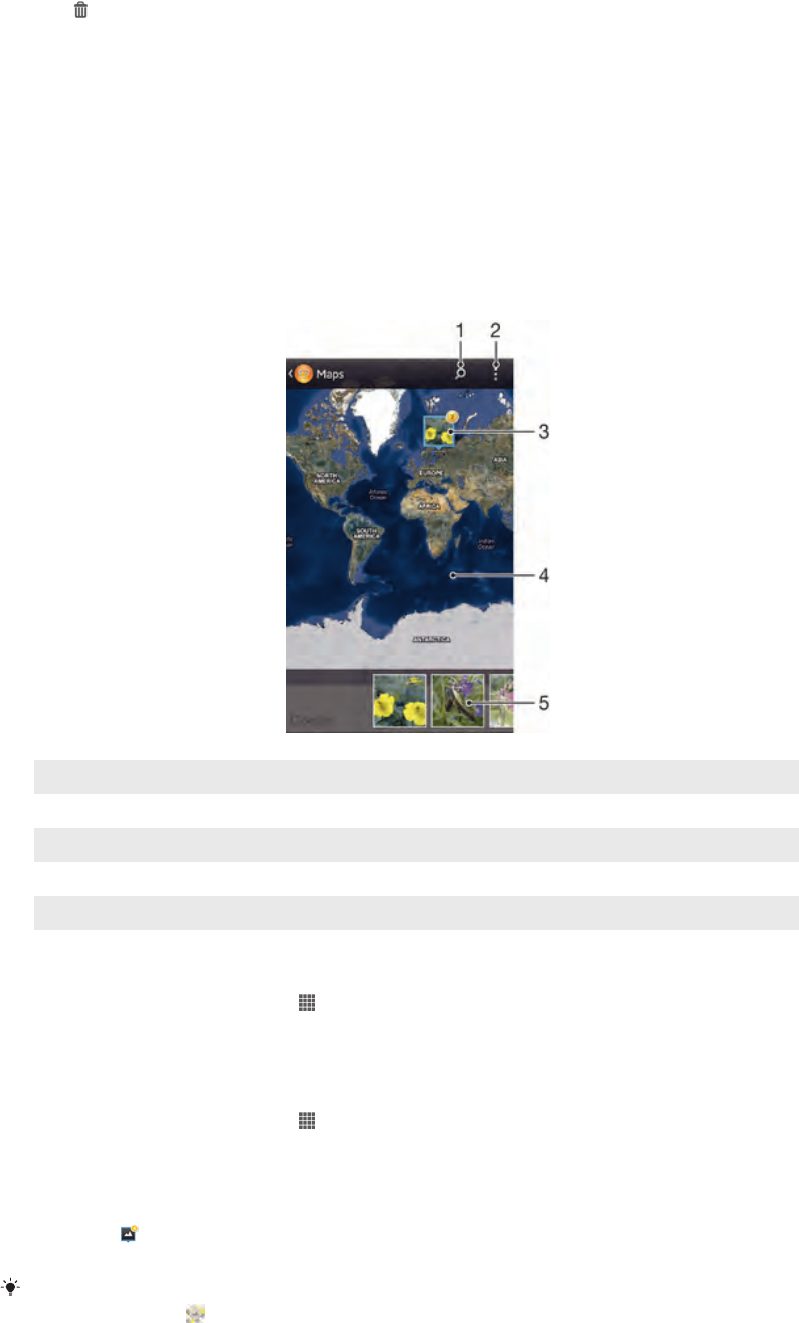
To delete a video
1In Album, find the video you want to delete.
2Touch and hold the video to activate selection mode. The frame of the video
thumbnail turns blue when it is selected.
3Tap , then tap OK.
Viewing your photos on a map
If you enable location detection when taking photos, you can use the information
gathered at a later stage. For example, you can view your photos on a map and show
friends and family where you were when you took the photo. Adding location
information is also referred to as geotagging. When you enable location detection,
you can select to use either GPS satellites or wireless networks, or both, to find your
position.
Overview of Maps tile
1Search a location on the map.
2 View menu options.
3 A group of photos and/or videos geotagged with the same location.
4 Double tap to zoom in. Pinch to zoom out. Drag to view different parts of the map.
5 Thumbnails of the selected group of photos and/or videos. Tap an item to view it in full screen.
To enable location detection
1From your Home screen, tap .
2Find and tap Settings > Location services.
3Mark the GPS satellites and/or Google's location service checkboxes.
To view geotagged photos on a map in Album
1From your Home screen, tap .
2Find and tap Album > My albums > Maps.
3Tap a photo to view it in full screen.
4If several photos were taken at the same location, only one of them appears on
the map. The total number of photos appears in the top right corner, for
example, . To view these photos, tap the cover photo and then tap one of the
thumbnails at the bottom of the screen.
When viewing a geotagged photo in the photo viewer, you can touch the screen to display the
toolbars, then tap to view the photo on the map.
86
This is an Internet version of this publication. © Print only for private use.
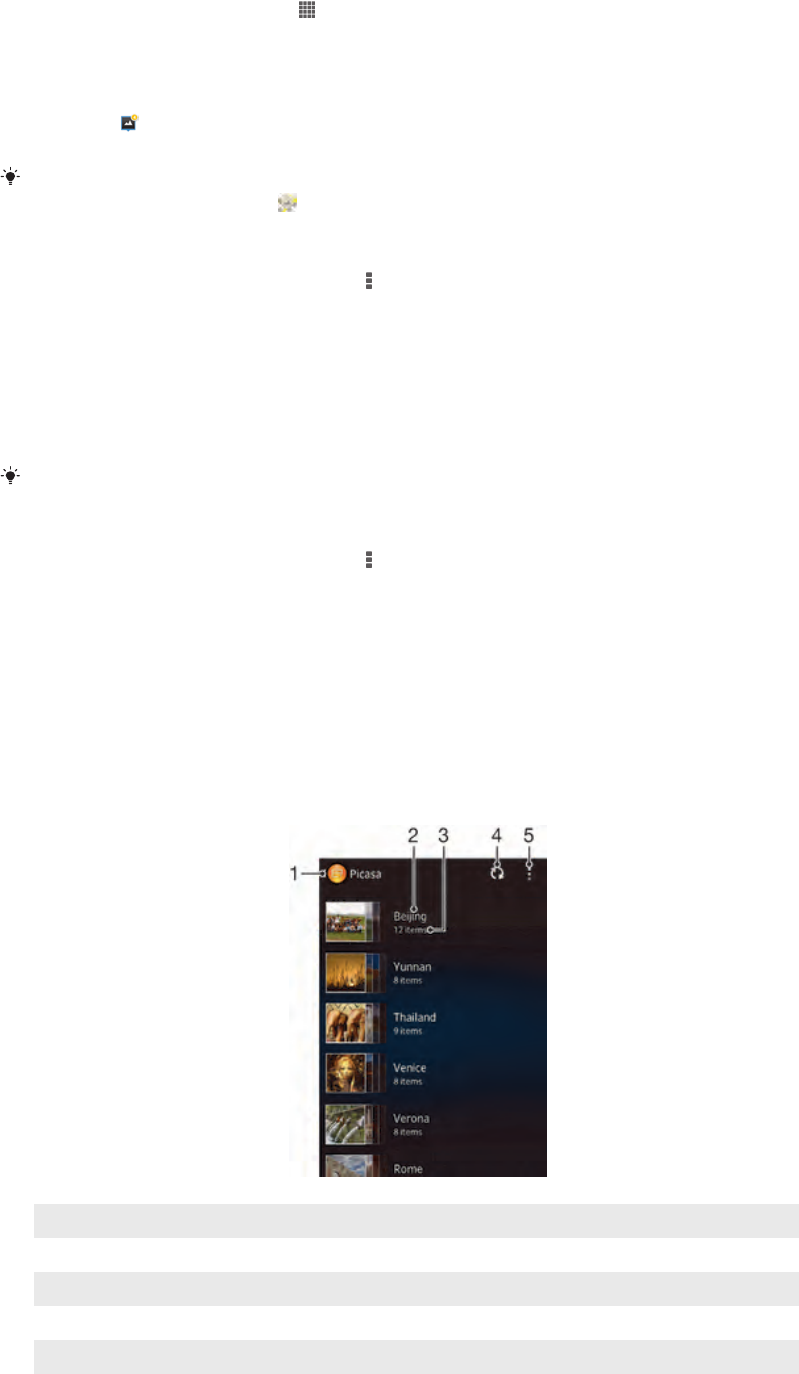
To view geotagged photos on a globe in Album
1From your Home screen, tap .
2Find and tap Album > My albums > Globe.
3Tap a photo to view it in full screen.
4If several photos were taken at the same location, only one of them appears on
the map. The total number of photos appears in the top right corner, for
example, . To view these photos, tap the cover photo and then tap one of the
thumbnails at the bottom of the screen.
When viewing a geotagged photo from the camera application, you can touch the screen to
display the toolbars, then tap to view the photo on the map.
To add a geotag when viewing the map in Album
1When viewing the map in Album, tap , then tap Add geotag.
2Find and tap the photo to which you want to add the geotag.
3Tap the desired location on the map to set the geotag, then tap OK.
To edit the geotag of a photo in Album
1When viewing a photo on the map in Album, touch and hold the photo until its
frame turns blue.
2Drag the photo to the new location.
You can also tap the desired location on the map instead of dragging.
To change the map view in Album
•When viewing the map in Album, tap , then select Classic view, Globe view or
Satellite view.
Viewing online albums
In Album, view the photos and videos that you and your friends have uploaded to
online services, such as Picasa™ and Facebook™. You can view comments from
your friends and add your own comments as well.
Overview of online services
1Active online service.
2 Name of online album.
3 Number of items in the online album.
4 Refresh.
5 View menu options.
87
This is an Internet version of this publication. © Print only for private use.

To view photos from online services in Album
1From your Home screen, tap .
2Find and tap Album > My albums.
3Tap the desired online service.
4Tap Connect. All available online albums that you have uploaded to the service
are displayed.
5Tap any album to view its content, then tap a photo in the album.
6Flick left to view the next photo or video. Flick right to view the previous photo
or video.
To view and add comments to online album content
1When viewing a photo from an online album, tap the screen to display the
toolbars, then tap to view the comments.
2To view more comments, scroll down the screen.
3To add your own comments, enter your comments at the bottom of the screen,
then tap Post.
To "Like" a photo or video on Facebook™
•While viewing a photo or video from one of your Facebook™ albums, tap the
screen to display the toolbars, then tap to show that you "Like" the item on
Facebook™.
88
This is an Internet version of this publication. © Print only for private use.
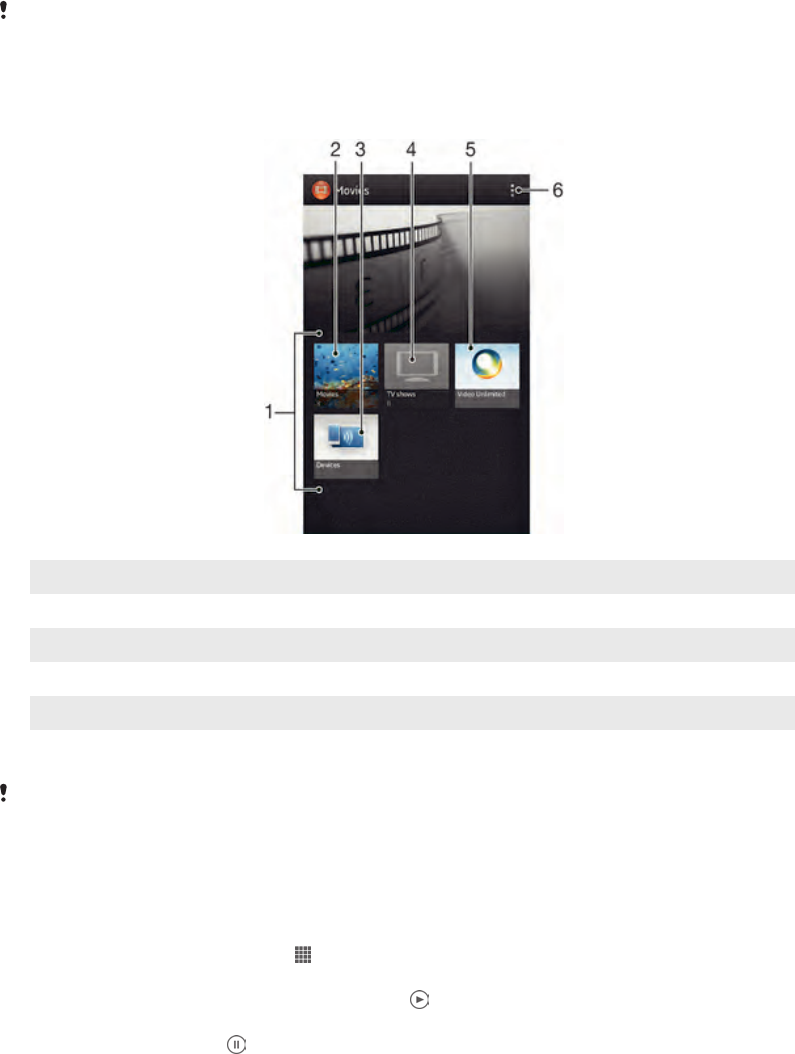
Movies
About Movies
Use the Movies application to play movies and other video content that you’ve saved
on your device. The Movies application also helps you get poster art, plot summaries,
genre info and director details for each movie. You can also play your movies on
other devices that are connected to the same network.
Videos taken with your device's camera are displayed in the Album application, not in the
Movies application.
Overview of Movies
1All video categories available on your device.
2 Browse all movies.
3 Browse content on other connected DLNA Certified™ devices.
4 Browse all TV shows.
5 Manage video content from Video Unlimited™.
6 View menu options.
Video Unlimited™ may not be available in all countries or regions.
Using Movies
To play a video in Movies
1From your Home screen, tap , then find and tap Movies.
2Select a video category and browse to the video that you want to play.
3Tap the video you want to select, then tap to play it.
4To display or hide the controls, tap the screen.
5To pause playing, tap .
6To rewind, drag the progress bar marker left. To fast forward, drag the
progress bar marker right.
89
This is an Internet version of this publication. © Print only for private use.

To play a video in full screen
1When a video is playing, tap the screen to display the controls.
2Tap .
To play the video in its original size, tap .
To share a video
1When a video saved under Movies or TV shows is playing, tap , then tap
Share.
2Tap the application that you want to use to share the selected video, then
follow the relevant steps to send it.
To get movie information manually
1Make sure that your device has an active data connection.
2From your Home screen, tap , then find and tap Movies.
3Tap , then make sure that the Get video details checkbox is marked.
4Open the Movies or TV shows tab and browse to the thumbnail of a file that
you want to get information about.
5Touch and hold the thumbnail for the video, then tap Search for info.
6In the search field, enter keywords for the video, then tap the confirm key on
the keyboard. All matches are displayed in a list.
7Select a search result, then tap Done. The download of the information begins.
You also get information about newly added videos automatically when the Movies application
is opened and the Get video details checkbox is marked. Data transmission charges may
apply.
If the downloaded information is not correct, tap and search again using different
keywords.
To clear information about a video
1From your Home screen, tap , then find and tap Movies.
2Select a video category and browse to the video that you want to edit.
3Touch and hold the video thumbnail, then tap Clear info.
To play a video on an external device
1Make sure the devices that you want to share files with are connected to the
same Wi-Fi® network as your device.
2From your Home screen, tap , then find and tap Movies > .
3Tap Throw, then select a device from the list.
4Select the video that you want to play.
To change the sound settings while a video is playing
1While a video is playing, tap the screen to display the controls.
2Tap , then tap Sound settings.
3Mark the checkboxes for the sound settings that you want to activate.
4When you're finished, tap OK.
To delete a video
1From your Home screen, tap , then find and tap Movies.
2Select a video category and browse to the video that you want to delete.
3Touch and hold the video thumbnail, then tap Delete from the list that appears.
4Tap Delete again to confirm.
90
This is an Internet version of this publication. © Print only for private use.
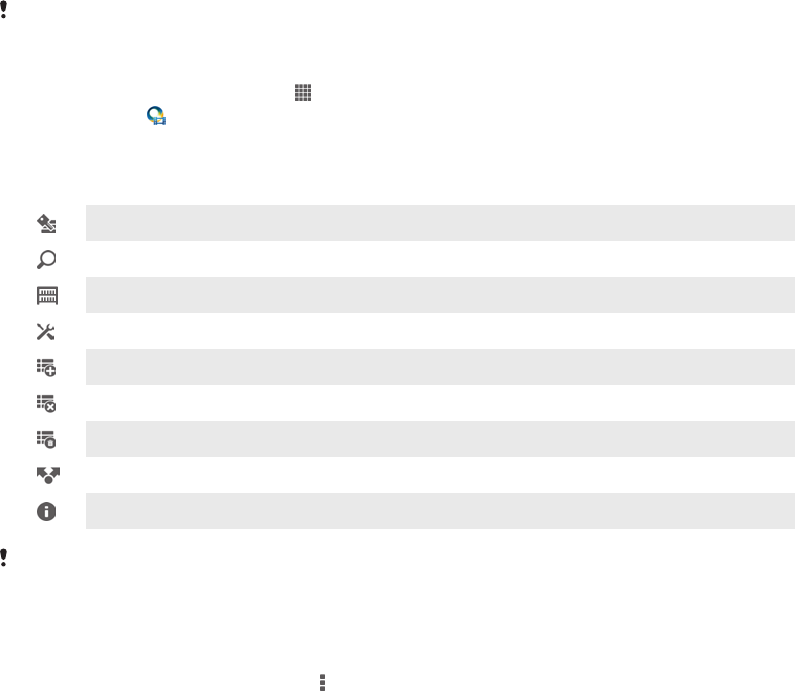
Video Unlimited™
About Video Unlimited™
Use the Video Unlimited™ service to rent and purchase videos that you can view not
only on your Android device, but also on a PC, PlayStation® Portable (PSP®) or
PlayStation® 3. Select your pick from the latest Hollywood releases, action movies,
comedies, classics, and a range of other categories.
Video Unlimited™ might not be available in all countries or regions.
To open Video Unlimited™
1From your Home screen, tap .
2Find and tap .
Video Unlimited™ menu overview
View your account information
Search for a video
View the download status for all your items
View and change settings for your account, purchases, and downloads
Add the current video to a wish list
Delete all items in your wish list
Delete the video you're currently viewing from the wish list
Share information about the current video via a social network, email, Bluetooth or other method
View legal information
The Video Unlimited™ menu is dynamic, which means that all options are not always available.
For example, the option to delete all items in your wish list is only available when you are
viewing the list.
To open the Video Unlimited™ menu
•Open Video Unlimited, then tap .
Creating a Video Unlimited™ account
You need to create a Video Unlimited™ account if you want to buy or rent movies
through the Video Unlimited™ service.
Exploring the Video Unlimited™ selection
Browse videos by category, or enter text to search for a particular item. You can also
choose to preview videos you're interested in.
Renting or buying a video
When you rent a video, you have a fixed amount of time in which to view it. This time
period varies from market to market. You can also choose to download a purchased
video to most Sony™ devices that are connected to your Video Unlimited™ account.
Video Unlimited™ notifications overview
When you buy or rent videos, the following notifications may appear:
91
This is an Internet version of this publication. © Print only for private use.

Downloading of video is completed
Downloading has failed. You need to check that, for example, your device is
connected to a Wi-Fi® network, and that you have enough free space on your
memory card.
Downloading of video is ongoing
Downloading is paused
Confirmation of successful purchase
Rental countdown period has started
Watching a video from Video Unlimited™
You can watch your rented or purchased videos on most Sony™ device that are
connected to your Video Unlimited™ account.
Video menu overview
When you watch a video from Video Unlimited™, you can open a menu to get the
following options:
Delete the current video
View information about the current video
Change the audio language
Change the language of subtitles, or remove subtitles
92
This is an Internet version of this publication. © Print only for private use.

Web browser
About the web browser
The Google Chrome™ web browser for Android™ devices comes pre-installed in
most markets. Go to http://support.google.com/chrome and click the "Chrome for
Mobile" link to get more detailed information about how to use this web browser.
Google Chrome™ is not available in all markets.
To open the web browser
1From your Home screen, tap .
2Find and tap .
93
This is an Internet version of this publication. © Print only for private use.
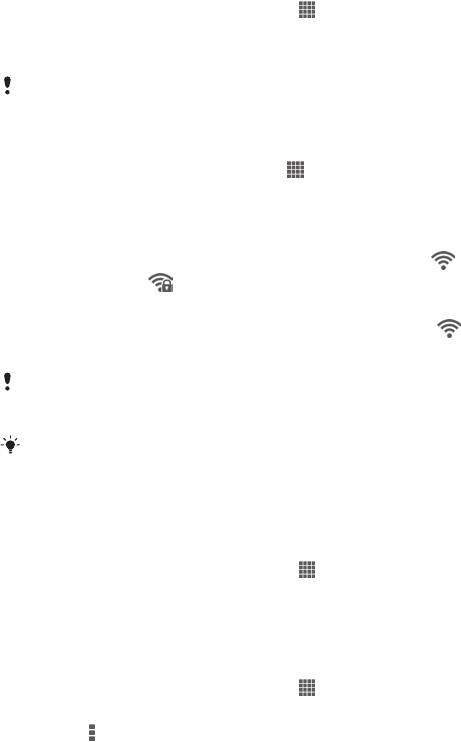
Connectivity
Connecting to wireless networks
You can access the Internet wirelessly from your device using Wi-Fi® technology.
This way you can browse the web and share media files over the same Wi-Fi®
network with other DLNA Certified™ devices, for example, TVs and computers.
If your company or organisation has a virtual private network (VPN), you can connect
to this network using your device. You can use a VPN to access intranets and other
internal services at your company.
Before using Wi-Fi®
To browse the Internet using a Wi-Fi® connection, you need to search for and
connect to an available Wi-Fi® network and then open the Internet browser. The
signal strength of the Wi-Fi® network may differ depending on your device's location.
Move closer to the Wi-Fi® access point to increase the signal strength.
To turn on Wi-Fi®
1From your Home screen, tap .
2Find and tap Settings.
3Drag the slider beside Wi-Fi® to the right to turn on the Wi-Fi® function.
It may take a few seconds before Wi-Fi® is enabled.
To connect to a Wi-Fi® network
1From the Home screen, tap .
2Find and tap Settings.
3Make sure that the Wi-Fi® function is on. Tap Wi-Fi .
4Available Wi-Fi® networks are displayed. The available networks may be open
or secured. Open networks are indicated by and secured networks are
indicated by next to the Wi-Fi® network name.
5Tap a Wi-Fi® network to connect to it. If you are trying to connect to a secure
network, you are asked to enter a password. is displayed in the status bar
once you are connected.
Your device remembers Wi-Fi® networks you connect to. The next time you come within
reach of a previously connected Wi-Fi® network, your device automatically connects to it.
In some locations, open Wi-Fi® networks require you to log in to a web page before you can
get access to the network. Contact the relevant Wi-Fi® network administrator for more
information.
To connect to another Wi-Fi® network
1From your Home screen, tap .
2Find and tap Settings > Wi-Fi. Detected Wi-Fi® networks are displayed.
3Tap another Wi-Fi® network to connect to it.
To scan for Wi-Fi® networks manually
1From your Home screen, tap to go to the Application screen.
2Find and tap Settings > Wi-Fi.
3Press , then tap Scan. Your device now scans for all available Wi-Fi®
networks.
4To connect to a Wi-Fi® network, tap the network name from the list of
available networks.
94
This is an Internet version of this publication. © Print only for private use.

To add a Wi-Fi® network manually
1Make sure that Wi-Fi® is turned on.
2From the Home screen, tap .
3Find and tap Settings > Wi-Fi .
4Tap .
5Enter the Network SSID for the network.
6Tap the Security field to select a security type.
7If required, enter a password.
8Tap Save.
The Wi-Fi® network name may be indicated as SSID, ESSID or Access Point. Contact your
Wi-Fi® network administrator to get the Network SSID and password.
Advanced Wi-Fi® settings
Wi-Fi® network status
When you are connected to a Wi-Fi® network or when there are Wi-Fi® networks
available in your vicinity, it is possible to see the status of these Wi-Fi® networks.
You can also enable your device to notify you whenever an open Wi-Fi® network is
detected.
To enable Wi-Fi® network notifications
1Turn on Wi-Fi®, if it is not already on.
2From your Home screen, tap .
3Find and tap Settings > Wi-Fi.
4Press .
5Tap Advanced.
6Mark the Network notification checkbox.
To view detailed information about a connected Wi-Fi® network
1From the Home screen, tap .
2Find and tap Settings > Wi-Fi.
3Tap the Wi-Fi® network that you are currently connected to. Detailed network
information is displayed.
Wi-Fi® sleep policy
By adding a Wi-Fi® sleep policy, you can specify when to switch from Wi-Fi® to
mobile data.
If you are not connected to a Wi-Fi® network, your device uses a mobile data connection to
access the Internet (if you have set up and enabled a mobile data connection on your device).
To add a Wi-Fi® sleep policy
1From the Home screen, tap .
2Find and tap Settings > Wi-Fi.
3Press .
4Tap Advanced.
5Tap Keep Wi-Fi on during sleep.
6Select an option.
Sharing your mobile data connection
You can share your device's mobile data connection with a single computer using a
USB cable. This process is called USB tethering. You can also share your device's
data connection with up to eight other devices at once, by turning your device into a
portable Wi-Fi® hotspot.
When your device is sharing its data connection, the following icons may appear in
the status bar or in the Notification panel:
USB tethering is active
95
This is an Internet version of this publication. © Print only for private use.

Portable Wi-Fi® hotspot is active
To share your data connection using a USB cable
1Deactivate all USB cable connections to your device.
2Using the USB cable that came with your device, connect your device to a
computer.
3From your Home screen, tap .
4Find and tap Settings > More… > Tethering & portable hotspot.
5Mark the USB tethering checkbox.
6To stop sharing your data connection, unmark the USB tethering checkbox or
disconnect the USB cable.
You cannot share your device's data connection and SD card over a USB cable at the same
time.
You may need to prepare your computer to establish a network connection via USB cable. Go
to www.android.com/tether to get the most current information.
To use your device as a portable Wi-Fi® hotspot
1From the Home screen, tap .
2Find and tap Settings > More… > Tethering & portable hotspot.
3Tap Portable Wi-Fi hotspot settings > Set up Wi-Fi hotspot.
4Enter the Network SSID for the network. Tap the Security field to select a
security type.
5If required, enter a password.
6Tap Save.
7Mark the Portable Wi-Fi hotspot checkbox. Your device starts broadcasting its
Wi-Fi network name (SSID). Up to eight computers or other devices can now
connect to this network.
8Unmark the Portable Wi-Fi hotspot checkbox when you want to stop sharing
your data connection via Wi-Fi®.
To rename or secure your portable hotspot
1From the Home screen, tap .
2Find and tap Settings > More… > Tethering & portable hotspot.
3Tap Portable Wi-Fi hotspot settings > Set up Wi-Fi hotspot.
4Enter the Network SSID for the network.
5To select a security type, tap the Security field.
6If required, enter a password.
7Tap Save.
Virtual private networks (VPNs)
Use your device to connect to virtual private networks (VPNs), which allow you to
access resources inside a secured local network from outside the actual network. For
example, VPN connections are commonly used by corporations and educational
institutions for users who need to access intranets and other internal services when
they are outside of the internal network, for example, when they are travelling.
VPN connections can be set up in many ways, depending on the network. Some
networks may require you to transfer and install a security certificate in your device.
For detailed information on how to set up a connection to your virtual private
network, please contact the network administrator of your company or organisation.
To add a virtual private network
1From your Home screen, tap .
2Find and tap Settings > More… > VPN.
3Tap Add VPN profile.
4Select the type of VPN to add.
5Enter your VPN settings.
6Tap Save.
96
This is an Internet version of this publication. © Print only for private use.

To connect to a virtual private network
1From your Home screen, tap .
2Find and tap Settings > More… > VPN.
3In the list of available networks, tap the VPN that you want to connect to.
4Enter the required information.
5Tap Connect.
To disconnect from a virtual private network
1Drag the status bar downwards.
2Tap the notification for the VPN connection to turn it off.
Sharing content with DLNA Certified™ devices
You can view or play media content saved to your device on other devices such as,
for example, a TV, or a computer. Such devices must be DLNA Certified™ by the
Digital Living Network Alliance and all devices must be connected to the same Wi-
Fi® network in order for content to be shared. You can also view or play content from
other DLNA Certified™ devices on your device.
After you set up the sharing of content between devices, you can, for example, listen
to music files stored on your home computer from your device, or view photos taken
with your device's camera on a large-screen TV.
Playing files from DLNA Certified™ devices on your device
When you play files from another DLNA Certified™ device on your device, this other
device acts as a server. In other words, it shares content over a network. The server
device must have its content sharing function enabled and give access permission to
your device. It also must be connected to the same Wi-Fi® network as your device.
To play a shared track on your device
1Make sure the devices that you want to share files with are connected to the
same Wi-Fi® network as your device.
2From your Home screen, tap , then find and tap WALKMAN.
3Tap My music to open the music library.
4Select a device from the list of connected devices.
5Browse the folders of the connected device and select the track that you want
to play. The track starts playing automatically.
To play a shared video on your device
1Make sure the devices that you want to share files with are connected to the
same Wi-Fi® network as your device.
2From your Home screen, tap , then find and tap Movies > Devices.
3Select a device from the list of connected devices.
4Browse the folders of the connected device and select the video that you want
to play.
To view a shared photo on your device
1Make sure the devices that you want to share files with are connected to the
same Wi-Fi® network as your device.
2From your Home screen, tap .
3Find and tap Album > My albums. All your available online albums and
connected devices are displayed.
4Select a device from the list of connected devices.
5Browse the folders of the connected device and select a photo to view it.
Preparing to play content from your device on DLNA Certified™
devices
Before you can view or play media files from your device on other DLNA Certified™
devices, you must set up file sharing on your device. The devices that you share
content with are called client devices. For example, a TV, computer or tablet can act
97
This is an Internet version of this publication. © Print only for private use.

as client devices. Your device works as a media server when it makes content
available to client devices. When you set up file sharing on your device, you must
also give access permission to client devices. After you do so, such devices appear
as registered devices. Devices that are waiting for access permission are listed as
pending devices.
To set up file sharing with other DLNA Certified™ devices
1Connect your device to a Wi-Fi® network.
2From your Home screen, tap , then find and tap .
3Tap My music to open the music library.
4Press , then tap Media server.
5To turn on the Share content function, drag the slider. appears in the status
bar. Your device can now work as a media server.
6Connect your computer or other devices to the same Wi-Fi® network as your
device.
7A notification appears in the status bar of your device. Open the notification
and set the relevant access permissions for other devices.
The instructions described above may differ depending on the client devices used. Refer to
your client device User guide for more information. If the device cannot connect, check that
your Wi-Fi® network is working.
You can also access the Media server menu under Settings > More… > Media server
settings. If you close the Media server view, file sharing function function stays running in the
background.
To stop sharing files with other DLNA Certified™ devices
1From your Home screen, tap , then find and tap .
2Tap My music to open the music library.
3Press , then tap Media server.
4Drag the slider to turn off the Share content function.
To set access permissions for a pending device
1From your Home screen, tap , then find and tap .
2Tap My music to open the music library.
3Press , then tap Media server.
4Select a device from the Pending devices list.
5Select an access permission level.
To change the name of a registered device
1From your Home screen, tap , then find and tap .
2Tap My music to open the music library.
3Press , then tap Media server.
4Select a device from the Registered devices list, then select Change name.
5Enter a new name for the device.
To change the access level of a registered device
1From your Home screen, tap , then find and tap .
2Tap My music to open the music library.
3Press , then tap Media server.
4Select a device from the Registered devices list.
5Tap Change access level and select an option.
To get help about sharing content with other DLNA Certified™ devices
1From your Home screen, tap , then find and tap .
2Tap My music to open the music library.
3Press , then tap Media server.
4Tap .
98
This is an Internet version of this publication. © Print only for private use.

Playing files on a Digital Media Renderer device
Using DLNA™ technology, you can push media content saved on your device to
another device connected to the same Wi-Fi® network. The other device must be
able to function as a Digital Media Renderer (DMR) device, which means that it can
render, or play, content received from your device. A DMR device can be, for
example, a TV with DLNA function, or a PC running Windows® 7 or higher.
The settings for enabling the Digital Media Renderer may vary depending on the device used.
Refer to the user guide for the respective device for more detailed information.
To view photos or videos from your device on a DMR device
1Make sure that you have correctly set up the DMR device and that it is
connected to the same Wi-Fi® network as your device.
2From your Home screen, tap .
3Find and tap Album.
4Browse to and open the file that you want to view.
5Tap the screen to display the toolbars, then tap and select a DMR device to
share your content with. The selected files start playing in chronological order
on the device that you select.
6To disconnect from the DMR device, tap and select My phone. The file stops
playing on the DMR device but continues playing on your device.
You can also share a video from the Movies application on your device by tapping the video
and then tapping .
To play a music track from your device on a DMR device
1Make sure that you have correctly set up the DMR device and that it is
connected to the same Wi-Fi® network as your device.
2From your Home screen, tap , then find and tap WALKMAN.
3Tap My music to open the music library.
4Select a music category and browse to the track that you want to share, then
tap the track.
5Tap and select a DMR device to share your content with. The track plays
automatically on the device that you select.
6To disconnect from the DMR device, tap and select My phone. The track
stops playing on the DMR device but continues playing on your device.
NFC
Use Near Field Communications (NFC) to share data with other devices, such as a
video, photo, web page address, music file or contact. You can also use NFC to scan
tags that give you more information about a product or service as well as tags that
activate certain functions on your device.
NFC is a wireless technology with a maximum range of one centimetre, so the
devices sharing data must be held close to each other. Before you can use NFC, you
must first turn on the NFC function, and the device's screen must be active.
NFC may not be available in all countries and/or regions.
To turn on the NFC function
1From your Home screen, tap .
2Find and tap Settings > More….
3Mark the NFC checkbox.
99
This is an Internet version of this publication. © Print only for private use.
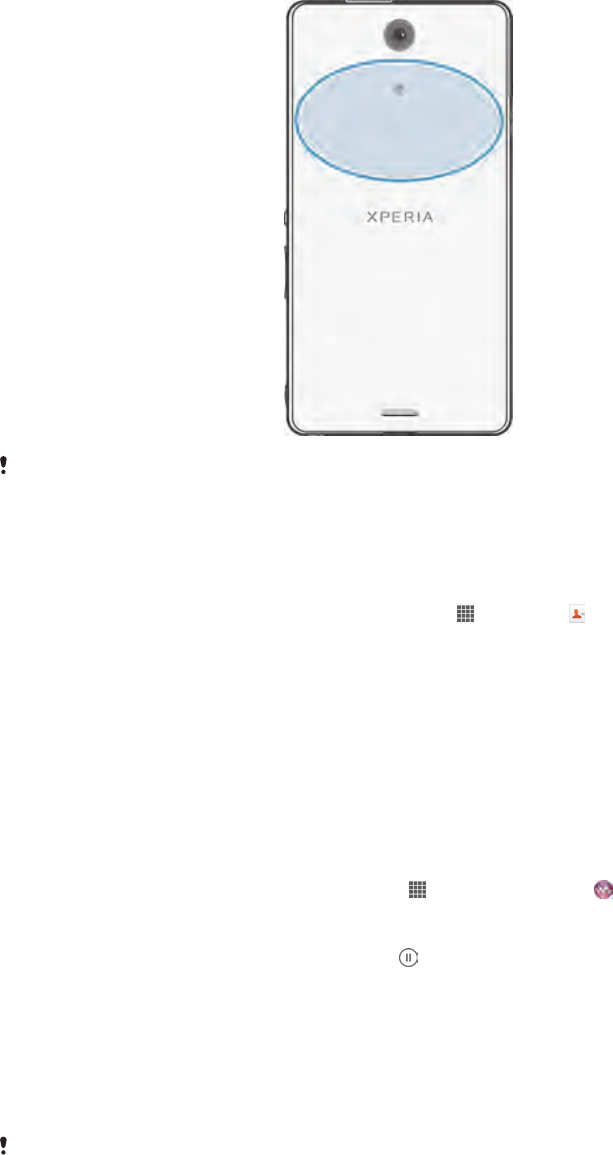
NFC detection area
The location of the NFC detection area is not the same on all devices. When sharing data with
another device using NFC, refer to the User guide of the other device for more information.
To share a contact with another device using NFC
1Make sure that both devices have the NFC function turned on, and that both
screens are active.
2To view contacts, go to your Home screen, tap , then tap .
3Tap the contact that you want to share.
4Hold your device and the receiving device back to back so that the NFC
detection areas of each device touch each other. When the devices connect,
they vibrate and play a short sound. A thumbnail of the contact appears.
5Tap the thumbnail to start the transfer.
6When the transfer is done, the contact information is displayed on the screen
of the receiving device and is also saved on the receiving device.
To share a music file with another device using NFC
1Make sure that both your device and the receiving device have the NFC
function turned on, and that both screens are active.
2To open the "WALKMAN" application, tap , then find and tap .
3Tap the My music tab to open the music library.
4Select a music category and browse to the track you want to share.
5Tap the track to play it. You can then tap to pause the track. The transfer
works whether the track is playing or paused.
6Hold your device and the receiving device back to back so that the NFC
detection areas of each device touch each other. When the devices connect,
they vibrate and play a short sound. A thumbnail of the track appears.
7Tap the thumbnail to start the transfer.
8When the transfer is done, the music file plays immediately on the receiving
device. At the same time, the file is saved on the receiving device.
You might not be able to copy, send or transfer copyright-protected items.
100
This is an Internet version of this publication. © Print only for private use.

To share a photo or video with another device using NFC
1Make sure that both devices have the NFC function turned on, and that both
screens are active.
2To view photos and videos in your device, go to your Home screen, tap ,
then find and tap Album.
3Tap the photo or video that you want to share.
4Hold your device and the receiving device back to back so that the NFC
detection areas touch each other. When the devices connect, they vibrate and
play a short sound. A thumbnail of the photo or video appears.
5Tap the thumbnail to start the transfer.
6When the transfer is done, the photo or video is displayed on the screen of the
receiving device. At the same time, the item is saved on the receiving device.
You can also use NFC to share a video from the Movies application.
To share a web address with another device using NFC
1Make sure that both devices have the NFC function turned on, and that both
screens are active.
2From your Home screen, tap .
3To open the web browser, find and tap .
4Load the web page that you want to share.
5Hold your device and the receiving device back to back so that the NFC
detection areas touch each other. When the devices connect, they vibrate and
play a short sound. A thumbnail of the web page appears.
6Tap the thumbnail to start the transfer.
7When the transfer is done, the web page is displayed on the screen of the
receiving device.
Scanning NFC tags
Your device can scan various kinds of NFC tags. For example, it can scan embedded
tags on a poster, on a billboard advertisement, or beside a product in a retail store.
You can receive additional information, such as a web address.
To scan an NFC tag
1Make sure that your device has the NFC function turned on and that the screen
is active.
2Place your device over the tag so that the NFC detection area touches it. Your
device scans the tag and displays the content collected. Tap the content of the
tag to open it.
3To open the tag, tap it.
Paying for items with your device
You can use the Operator wallet application on your device to pay for items in stores
that support NFC payment methods. Just tap your device on specially enabled
electronic payment pads to pay for your purchases. Payments are backed by a credit
or debit card, or by prepaid cards or vouchers. Your payment information is stored in
the payment application, so you don’t need to enter it every time.
To use Operator wallet, your SIM card must have a secure element embedded. Contact your
network operator for more details.
Google Wallet™
Use the Google Wallet™ application to pay for goods at checkouts. If there is a
supported NFC terminal at the checkout, you can just tap your device on the terminal
to pay. Google Wallet™ stores details of your credit and debit cards as well as details
of coupons and other special offers. Most major credit card types are supported.
Security features include a PIN, encrypted storage and the ability to remotely disable
a lost wallet.
101
This is an Internet version of this publication. © Print only for private use.

Operator wallet
The Operator wallet application lets you access a variety of services provided by your
network operator, such as the option to pay for items in underground trains and
stores. Contact your network operator for more information about such services.
To select a wallet for use on your device
1Make sure that the NFC function is on.
2From your Home screen, tap .
3Find and tap Settings > More….
4Tap Wallet and select an option.
Connecting to an NFC compatible device
You can connect your device to other NFC compatible devices produced by Sony,
such as a speaker or a headphone. When establishing this kind of connection, refer
to the User guide of the compatible device for more information.
You may need to have Wi-Fi® or Bluetooth™ activated on both devices for the connection to
work.
Bluetooth™ wireless technology
Use the Bluetooth™ function to send files to other Bluetooth™ compatible devices,
or to connect to handsfree accessories. Turn on the Bluetooth™ function in your
device and create wireless connections to other Bluetooth™ compatible devices
such as computers, handsfree accessories, and phones. Bluetooth™ connections
work better within 10 metres (33 feet), with no solid objects in between. In some
cases you have to manually pair your device with other Bluetooth™ devices.
Interoperability and compatibility among Bluetooth™ devices can vary.
To turn on the Bluetooth™ function and make your device visible
1From your Home screen, tap .
2Find and tap Settings.
3Tap the on-off switch beside Bluetooth to turn on the Bluetooth™ function.
4Tap Bluetooth. Your device and a list of available Bluetooth™ devices appear.
5Tap your device name to make your device visible to other Bluetooth™
devices.
To adjust your device's visibility time to other Bluetooth™ devices
1From your Home screen, tap .
2Find and tap Settings > Bluetooth.
3Press and select Visibility timeout.
4Select an option.
Naming your device
You can give your device a name. This name is shown to other devices after you
have turned on the Bluetooth™ function and your device is set to visible.
To give your device a name
1Make sure that the Bluetooth™ function is turned on.
2From your Home screen, tap .
3Find and tap Settings > Bluetooth.
4Press and select Rename phone.
5Enter a name for your device.
6Tap Rename.
102
This is an Internet version of this publication. © Print only for private use.

Pairing with another Bluetooth™ device
When you pair your device with another device, you can, for example, connect your
device to a Bluetooth™ headset or a Bluetooth™ car kit and use these other devices
to make and receive calls.
Once you have paired your device with a Bluetooth™ device, your device will
remember this pairing. When pairing your device with a Bluetooth™ device, you may
need to enter a passcode. Your device will automatically try the generic passcode
0000. If this does not work, refer to the user guide for your Bluetooth™ device to get
the device passcode. You do not need to re-enter the passcode the next time you
connect to a paired Bluetooth™ device.
Some Bluetooth™ devices, for example, most Bluetooth™ headsets, require you to
both pair and connect with the other device.
You can pair your device with several Bluetooth™ devices, but you can only connect
to one Bluetooth™ profile at the same time.
To pair your device with another Bluetooth™ device
1Make sure that the device you want to pair your device with has the
Bluetooth™ function activated and is visible to other Bluetooth™ devices.
2From the Home screen, tap .
3Find and tap Settings > Bluetooth. All available Bluetooth™ devices appear in
a list.
4Tap the Bluetooth™ device that you want to pair with your device.
5Enter a passcode, if required, or confirm the same passcode on both devices.
Your device and the Bluetooth™ device are now paired.
To connect your device to another Bluetooth™ device
1If you are connecting to a Bluetooth device that requires you to first pair your
device before connecting, follow the relevant steps to pair your device with
that device.
2From your Home screen, tap .
3Find and tap Settings > Bluetooth.
4Tap the Bluetooth™ device to which you want to connect your device.
To unpair a Bluetooth™ device
1From the Home screen, tap .
2Find and tap Settings > Bluetooth.
3Under Paired devices, tap beside the name of the device that you want to
unpair.
4Tap Unpair.
Sending and receiving items using Bluetooth™ technology
Share items with other Bluetooth™ compatible devices such as phones or
computers. You can send and receive several kinds of items using the Bluetooth™
function, such as:
•Photos and videos
•Music and other audio files
•Contacts
•Web pages
103
This is an Internet version of this publication. © Print only for private use.

To send items using Bluetooth™
1Receiving device: Make sure the Bluetooth™ function is turned on and that
the device is visible to other Bluetooth™ devices.
2Sending device: Open the application which contains the item that you want to
send, and scroll to the item.
3Depending on the application and the item you want to send, you may need to,
for example, touch and hold the item, open the item or press . Other ways to
send an item may exist.
4Select Share or Send.
5Select Bluetooth.
6Turn on Bluetooth™, if you are asked to do so.
7Tap the name of the receiving device.
8Receiving device: If asked, accept the connection.
9Sending device: If asked, confirm the transfer to the receiving device.
10 Receiving device: Accept the incoming item.
To receive items using Bluetooth™
1Make sure that the Bluetooth™ function is on and is visible to other
Bluetooth™ devices.
2The sending device now starts sending data to your device.
3If prompted, enter the same passcode on both devices, or confirm the
suggested passcode.
4When you are notified of an incoming file to your device, drag the status bar
downwards and tap the notification to accept the file transfer.
5Tap Accept to start the file transfer.
6To view the progress of the transfer, drag the status bar downwards.
7To open a received item, drag the status bar downwards and tap the relevant
notification.
To view files you have received using Bluetooth™
1From your Home screen, tap .
2Find and tap Settings > Bluetooth.
3Press and select Show received files.
Connecting your device to a computer
Connect your device to a computer and start transferring pictures, music and other
file types. The easiest ways to connect are using a USB cable or Bluetooth wireless
technology.
When you connect your device to the computer using a USB cable, you are
prompted to install the PC Companion application on your computer. PC Companion
helps you access additional computer applications to transfer and organise media
files, update your device, synchronise device content, and more.
You might not be able to transfer some copyright-protected material between your device and
a computer.
Transferring and handling content using a USB cable
Use a USB cable connection between a computer and your device for easy transfer
and management of your files. Once the two devices are connected, you can drag
and drop content between your device and the computer, or between your device's
internal storage and SD card, using the computer's file explorer.
If you're transferring music, video, pictures or other media files to your device, it's
best to use the Media Go™ application on your computer. Media Go™ converts
media files so that you can use them on your device.
104
This is an Internet version of this publication. © Print only for private use.

To transfer content between your device and computer using a USB cable
1Using a USB cable, connect your device to a computer. Internal storage & SD
card connected appears in the status bar on the screen of your device.
2Computer: Open Microsoft® Windows® Explorer from the desktop and wait
until your device's internal storage and your SD card appear as external disks
in Microsoft® Windows® Explorer.
3Computer: Drag and drop the desired files between your device and the
computer.
To transfer content between internal storage and an SD card via USB
1Using a USB cable, connect your device to a computer. Internal storage & SD
card connected appears in the status bar on the screen of your device.
2Computer: Open Microsoft® Windows® Explorer from the desktop and wait
until your device's internal storage and your SD card appear as external disks
in Microsoft® Windows® Explorer.
3Computer: Drag and drop the desired files between the device's internal
storage and the SD card.
To transfer files directly from internal storage to an SD card in the device
1From your Home screen, tap .
2Find and tap Settings > Storage > Transfer data to SD card.
3Mark the file types you want to transfer to the SD card.
4Tap Transfer.
The direct transfer method means that a USB cable connection to a computer is not
necessary.
Transferring files using Media transfer mode via Wi-Fi®
You can transfer files between your device and other MTP compatible devices, such
as a computer, using a Wi-Fi® connection. Before connecting, you first need to pair
the two devices. If you're transferring music, video, pictures or other media files
between your device and a computer, it's best to use the Media Go™ application on
the computer. Media Go™ converts media files so that you can use them on your
device.
In order to use this feature, you need a Wi-Fi® enabled device that supports Media transfer,
for example, a computer running Microsoft® Windows Vista® or Windows® 7.
To pair your device wirelessly with a computer using Media transfer mode
1Make sure Media transfer mode is enabled on your device. It is normally
enabled by default.
2Connect your device to the computer using a USB cable.
3Computer: Once the name of your device appears on the screen, click
Network configuration and follow the instructions to pair the computer.
4When you are finished pairing, disconnect the USB cable from both devices.
The above instructions only work if Windows® 7 is installed on your computer and the
computer is connected to a Wi-Fi® Access Point via a network cable.
To connect paired devices wirelessly in Media transfer mode
1Make sure Media transfer mode is enabled on your device. It is normally
enabled by default.
2From your Home screen, tap .
3Find and tap Settings > Xperia™ > USB Connectivity.
4Tap the paired device that you want to connect to under Trusted devices.
5Tap Connect.
Make sure the Wi-Fi® function is turned on.
105
This is an Internet version of this publication. © Print only for private use.

To disconnect a wirelessly paired device in Media transfer mode
1From your Home screen, tap .
2Find and tap Settings > Xperia™ > USB Connectivity.
3Tap the paired device that you want to disconnect from under Trusted
devices.
4Tap Disconnect.
To remove a pairing with another device
1From your Home screen, tap .
2Find and tap Settings > Xperia™ > USB Connectivity.
3Tap the paired device that you want to remove.
4Tap Forget.
PC Companion
PC Companion is a computer application that gives you access to additional features
and services which help you transfer music, video and pictures to and from your
device. You can also use PC Companion to update your device and get the latest
software version available. The installation files for PC Companion are saved on your
device and the installation is launched from the device when you connect it to a
computer via USB cable.
You need an internet connected computer running one of the following operating
systems to use the PC Companion application:
•Microsoft® Windows® 7
•Microsoft® Windows Vista®
•Microsoft® Windows® XP (Service Pack 3 or higher)
To start PC Companion
1Make sure that PC Companion is installed on your PC.
2Open the PC Companion application on the PC, then click Start to open one of
the features that you want to use.
Media Go™
The Media Go™ computer application helps you transfer and manage media content
in your device and computer. You can install and access Media Go™ from within the
PC Companion application.
You need one of these operating systems to use the Media Go™ application:
•Microsoft® Windows® 7
•Microsoft® Windows Vista®
•Microsoft® Windows® XP, Service Pack 3 or higher
To transfer content using the Media Go™ application
1Connect your device to a computer using a supported USB cable.
2Device: In the status bar, Internal storage connected appears.
3Computer: Open the PC Companion application on the PC first. In
PC Companion, click Media Go to start the Media Go™ application. In some
cases, you may have to wait for Media Go™ to install.
4Using Media Go™, drag and drop files between your computer and device.
Connecting your device to a TV set
Connect your device to a TV set and start viewing content saved in your device on a
larger screen. When you connect your device to the TV set, the TV launcher
application opens. This application helps you to play media files from your device on
TVs and other devices.
You may have to purchase an MHL cable separately.
106
This is an Internet version of this publication. © Print only for private use.

To view content from your device on a TV which supports MHL input
1Connect your device to the TV using an MHL cable. appears in your
device's status bar after a connection is established.
2The TV launcher application starts automatically. Follow the instructions to
view your media files on the TV.
To view content from your device on a TV which supports HDMI™ input
1Connect your device to an MHL-HDMI adaptor, and connect the adaptor to a
USB power supply.
2Connect the adaptor to a TV using a HDMI™ cable. appears in your
device's status bar after a connection is established.
3The TV launcher application starts automatically. Follow the instructions to
view your media files on the TV.
To view help about using the TV remote control
1While your device is connected to the TV set, drag the status bar downwards
to open the Notification panel.
2Tap MHL connected.
You can also press the yellow button on the TV remote control to open the Notification panel.
To disconnect your device from the TV set
•Disconnect the MHL™ cable or the MHL-HDMI adaptor from your device.
Screen mirroring
Use Screen mirroring to show the screen of your device on a TV or other large display
without using a cable connection. Wi-Fi Direct™ technology creates a wireless
connection between the two devices, so you can sit back and enjoy your favourite
photos from the comfort of your couch. You can also use this feature to listen to
music from your phone via the TV's speakers.
Your TV must support screen mirroring based on Wi-Fi CERTIFIED Miracast™ for the
functionality described above to work. If your TV does not support screen mirroring, you need
to purchase a wireless display adapter separately.
When using screen mirroring, the image quality may sometimes be negatively impacted if there
is interference from other Wi-Fi® networks.
To mirror the screen of your device on a TV screen
1Follow the instructions in the User guide for your TV to turn on the screen
mirroring function.
2From your Home screen, tap .
3Find and tap Settings > Xperia™ > Screen mirroring.
4Tap Turn on Screen mirroring and select a device.
When using screen mirroring, do not cover the Wi-Fi antenna area of your device.
Scanning barcodes with the NeoReader™ application
About scanning with the NeoReader™ application
Use your device as a barcode scanner to find out more about items you scan. For
example, you see a coat in a magazine ad and want to find the nearest retail outlet to
buy it. If the ad contains a readable barcode, the NeoReader™ application uses this
code to access mobile web content, such as a web page with more product
information or a map of nearby outlets. NeoReader™ supports most standard
barcode types.
107
This is an Internet version of this publication. © Print only for private use.

To start the NeoReader™ application
1From the Home screen, tap .
2Find and tap NeoReader™.
To scan a barcode
1When the NeoReader™ application is open, hold your device over the barcode
until the complete barcode is visible in the viewfinder.
2Your device automatically scans the barcode, and vibrates when the barcode
is recognised.
To enter a barcode manually
1When the NeoReader™ application is open, tap .
2Enter the numbers of the barcode in the text field, then tap GO!.
NeoReader™ application menu overview
The following menu options are available in the NeoReader™ application:
Tap to open more options
Enter the barcode numbers manually. This option can be used if your camera has difficulty
reading the barcode
View a list of previously scanned barcodes
View information about the NeoReader™ application. Read more about different barcode types,
and about how to use NeoReader™
Select your personal settings, such as language or country. This information is used to
personalise barcode content. Also, you can select preferences for how you use the NeoReader™
application
Send a text message to invite a friend to download the NeoReader™ application
Smart Connect
About Smart Connect
Use the Smart Connect application to set what happens in your device when you
connect or disconnect an accessory. You can also use it to set a specific action or a
group of actions to launch on your device at certain times of the day.
For example, when you connect your headset or headphones, you can set an event
so that the following actions are launched on your device:
•Between 7am and 9am, when you commute to work, the WALKMAN player starts,
and the web browser opens the morning paper. The ring volume is set to vibrate.
•Between office hours, a conference call app opens on your device.
•On the way back from work, the FM radio starts, and a notes app with your shopping
list opens.
To start the Smart Connect application
1From your Home screen, tap .
2Find and tap Smart Connect.
108
This is an Internet version of this publication. © Print only for private use.

To create a Smart Connect event
1Start the Smart Connection application. If you are opening Smart Connect for
the first time, tap OK to close the introduction screen.
2On the Events tab, tap .
3Give the event a name, then tap Create.
4Under When, add either an accessory or a time interval, or both.
5Under Do this, add what you want to happen in your device.
6Under At the end, add what you want to happen when you disconnect the
accessory or when the time interval comes to an end. If both these conditions
are set, the actions start either when you disconnect the accessory, or when
the time interval comes to an end.
7To save the event, press .
To add a Bluetooth™ accessory, you have to first pair it with your device.
To edit a Smart Connect event
1Start the Smart Connection application.
2On the Events tab, tap an event.
3If the event is switched off, tap .
4Adjust the settings as desired.
5To save the event, press .
To delete an incorrect entry, touch and hold the entry and then tap Delete.
109
This is an Internet version of this publication. © Print only for private use.

Synchronising data on your device
About synchronising data on your device
You can sync contacts, email, calendar events, and other information with your
device from multiple email accounts, synchronisation services and other kinds of
accounts, depending on the applications installed on your device. Synchronising your
device with other information sources is an easy and practical way to stay up to date.
Synchronising with Google™
Synchronise your device with different Google™ services to keep your information up
to date, regardless of which device you're using your Google™ account from. For
example, you can synchronise your contacts, Gmail™, calendar and web browser
data.
To set up a Google™ account for synchronisation
1From your Home screen, tap .
2Tap Settings > Add account > Google.
3Follow the registration wizard to create a Google™ account, or sign in if you
already have an account.
4Mark the Back up & restore checkbox if you want to back up data to your
Google™ account, then tap Next.
5Tap your newly created Google™ account, then tap the items you that want to
synchronise.
To synchronise manually with your Google™ account
1From the Home screen, tap .
2Tap Settings > Google.
3Tap the Google™ account that you want to synchronise.
4Press , then tap Sync now.
To synchronise an application with a Google™ account
1From your Home screen, tap .
2Tap Settings > Google.
3Tap the Google™ account that you want to synchronise with. A list appears of
applications that can be synchronised with the Google account.
4Tap the application that you want to synchronise with the selected Google
account.
To synchronise the web browser data
1From your Home screen, tap .
2Tap Settings > Google.
3Tap the Google™ account that you want to synchronise with, then tap Sync
Browser.
To remove a Google™ account
1From your Home screen, tap .
2Tap Settings > Google.
3Tap the Google™ account that you want to remove from the accounts list.
4Press , then tap Remove account.
5Tap Remove account again to confirm.
Synchronising your corporate email, calendar and contacts
Access your corporate email messages, calendar appointments and contacts directly
from your device. View and manage them just as easily as you would from a
110
This is an Internet version of this publication. © Print only for private use.

computer. After setup, you can find your information in the Email, Calendar and
Contacts applications.
For you to access the functionality described above, your corporate information must be
stored on a Microsoft® Exchange server.
To set up corporate email, calendar and contacts
1From your Home screen, tap .
2Tap Settings > Add account > Exchange ActiveSync.
3Enter your corporate email address and password.
4Tap Next. Your device begins to retrieve your account information. If a failure
occurs, contact your corporate network administrator for more information.
5Tap OK to allow your corporate server to control your device.
6Select what data you want to sync with your device, such as contacts and
calendar entries.
7If desired, activate the device administrator to allow your corporate server to
control certain security features on your device. For example, you can allow
your corporate server to set password rules and set storage encryption.
8When the setup is done, enter a name for the corporate account.
To edit the setup of corporate email, calendar and contacts
1From your Home screen, tap .
2Tap Email, then tap .
3Tap Settings and select a corporate account.
4Change the desired settings.
To set a synchronisation interval for a corporate account
1From your Home screen, tap .
2Tap Email, then tap .
3Tap Settings and select a corporate account.
4Tap Inbox check frequency and select an interval option.
To remove a corporate account
1From your Home screen, tap .
2Tap Settings > Exchange ActiveSync, then select the corporate account.
3Tap , then tap Remove account.
4Tap Remove account again to confirm.
Synchronising with Facebook™
There are two ways to use Facebook™ on your device. You can use the standard
Facebook application to access your online Facebook account, or you can
synchronise your Facebook account with your device and share content between
Facebook™ and a range of other applications. For example, you can share music in
the "WALKMAN" application on your device via Facebook. To synchronise your
device with Facebook, you must first set up an "Xperia™ with Facebook" account —
a solution developed by Sony to enable easy integration.
To set up an "Xperia™ with Facebook" account on your device
1From your Home screen, tap .
2Tap Settings > Add account > Xperia™ with Facebook.
3Follow the on-screen instructions to sign in to your Facebook™ account, or
create a new account.
To synchronise manually with an "Xperia™ with Facebook" account
1From your Home screen, tap .
2Tap Settings > Xperia™ with Facebook.
3Select the account that you want to synchronise.
4Press , then tap Sync now.
111
This is an Internet version of this publication. © Print only for private use.

To remove an "Xperia™ with Facebook" account
When you remove an "Xperia™ with Facebook" account from your device, the associated
online Facebook account is not deleted and you can still access it from a computer.
1From your Home screen, tap .
2Tap Settings > Xperia™ with Facebook.
3Select the account that you want to remove.
4Press , then tap Remove account.
5Tap Remove account again to confirm.
112
This is an Internet version of this publication. © Print only for private use.
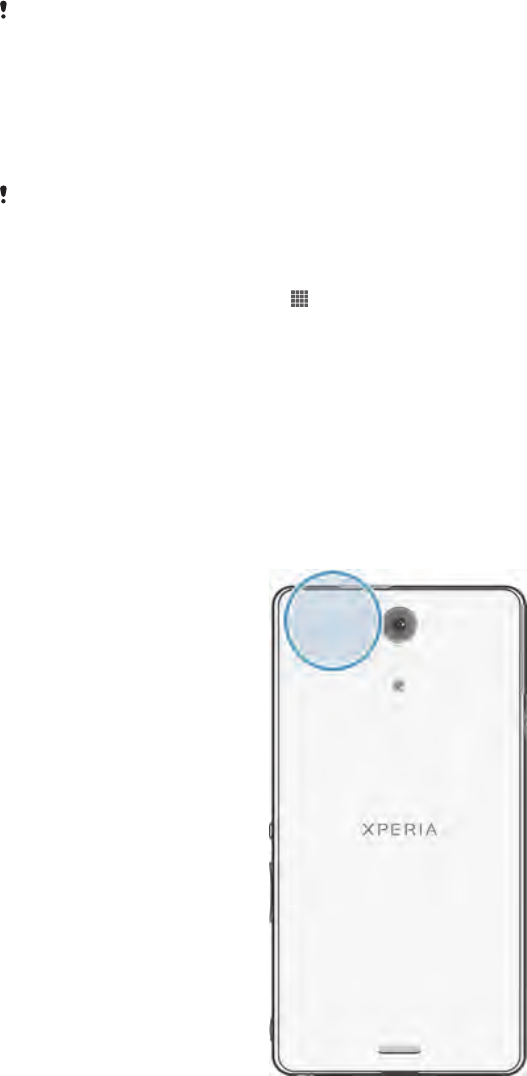
Maps and locations
About location services
Use your device to find out where you are. There are two methods: GPS and wireless
networks. Enable the wireless networks option if you only need your approximate
location, and want it fast. If you want a more exact position, and have a clear view of
the sky, enable the GPS option. In situations where the wireless network connection
is weak, you should enable both options to ensure that your location is found.
Sony does not warrant the accuracy of any location services including but not limited to
navigational services.
Using GPS
Your device has a global positioning system (GPS) receiver that uses satellite signals
to calculate your location.
When you use features that require the GPS receiver to find your location, make sure you have
a clear view of the sky.
To enable GPS
1From your Home screen, tap .
2Tap Settings > Location services.
3Mark the GPS satellites checkbox.
Getting the best performance
The first time you use the GPS it can take 5 to 10 minutes for your location to be
found. To help the search, make sure you have a clear view of the sky. Stand still and
don't cover the GPS antenna (the highlighted area in the image). The GPS signals can
pass through clouds and plastic, but not through most solid objects such as
buildings and mountains. If your location isn't found after a few minutes, move to
another location.
113
This is an Internet version of this publication. © Print only for private use.

Google Maps™
Track your current location, view real-time traffic situations and receive detailed
directions to your destination. Before taking trips, you can download and save maps
to your memory card to avoid high roaming costs.
The Google Maps™ application requires the use of an Internet connection. You may incur data
connection charges when you connect to the Internet from your device. Contact your network
operator for more information. The Google Maps™ application may not be available in every
market, country or region.
To use Google Maps™
1From your Home screen, tap .
2Find and tap Maps.
If you want to use Google Maps™, you have to enable one of the location methods available
under Settings > Location services.
To learn more about Google Maps™
•When you use Google Maps™, tap , then tap Help.
Viewing your friends’ locations with Google Latitude™
Join Google Latitude™ to view your friends’ locations on maps and share your
location and other information with them.
Using Google Maps™ to get directions
Use the Google Maps™ application to get directions when you travel by foot, public
transportation, or car. You can add a shortcut to a destination on your Home screen
to get quick directions from wherever you are.
When you view a map, you make an Internet connection, and data is transferred to
your device. So it's a good idea to download and save maps to your device before
you take a trip. This way, you can avoid high roaming costs.
Sony does not warrant the accuracy of any directional services.
Using the Navigation application
Use the Navigation application in your device to get turn-by-turn instructions on how
to get places. The directions are both spoken and displayed on the screen.
The Navigation application may not be available in every market.
To start Navigation
1From your Home screen, tap .
2Find and tap Navigation.
114
This is an Internet version of this publication. © Print only for private use.

Calendar and alarm clock
Calendar
Your device has a calendar application for managing your time schedule. If you have
a Google™ account, you can also synchronise the calendar application on your
device with your web calendar.
To set the calendar view
1From your Home screen, tap , then find and tap Calendar.
2Tap Month, Week or Day to select an option.
To view multiple calendars
1From your Home screen, tap , then find and tap Calendar.
2Press , then tap My calendars.
3Select the calendars you want to view.
To create a calendar event
1From your Home screen, tap , then tap Calendar.
2Tap .
3Enter the name, time, location and description for the event.
4Select a reminder for the event. To add a new reminder for the event, tap .
5If desired, tap More and select another option under Repetition.
6Tap Done.
When the appointment time approaches, your device plays a short sound to remind you. Also,
appears in the status bar.
To view a calendar event
1From your Home screen, tap , then tap Calendar.
2Tap the event you want to view.
To change the calendar settings
1From your Home screen, tap , then tap Calendar.
2Press , then tap Settings.
3Tap the setting you want to change, then edit as desired.
Alarm clock
Use your device as an alarm clock and select any sound saved on your device as
your alarm signal. The alarm does not sound if your device is turned off. But it does
sound when the device is set to silent mode.
To open the alarm clock
1From your Home screen, tap .
2Find and tap Alarm & clock.
To set a new alarm
1From your Home screen, tap .
2Find and tap Alarm & clock.
3Tap Add alarm.
4Tap Time and adjust the time by scrolling up and down.
5Tap Done.
6If desired, edit other alarm settings.
7Tap Done.
115
This is an Internet version of this publication. © Print only for private use.

To edit an existing alarm
1From your Home screen, tap .
2Find and tap Alarm & clock.
3Tap the alarm you want to edit.
4Tap Time and adjust the time by scrolling up and down.
5Tap Done.
6If desired, edit other alarm settings.
7Tap Done.
The alarm time format displayed is the same as the format you select for your general time
settings, for example, 12-hour or 24-hour.
To deactivate an alarm
1From your Home screen, tap .
2Find and tap Alarm & clock.
3Tap next to the alarm you want to deactivate.
To activate an existing alarm
1From your Home screen, tap .
2Find and tap Alarm & clock.
3Tap next to the alarm you want to activate.
To delete an alarm
1From your Home screen, tap .
2Find and tap Alarm & clock.
3Touch and hold the alarm you want to delete.
4Tap Delete alarm, then tap Yes.
To set the ringtone for an alarm
1From your Home screen, tap .
2Find and tap Alarm & clock.
3Tap the alarm you want to edit.
4Tap Advanced alarm settings and unmark the Style settings checkbox.
5Tap Alarm sound and select an option.
6Tap Done, then tap Done.
To set a recurring alarm
1From your Home screen, tap .
2Find and tap Alarm & clock.
3Tap the alarm you want to edit.
4Tap Repeat.
5Mark the checkboxes for the desired days, then tap OK.
6Tap Done.
To set the title for an alarm
1From your Home screen, tap .
2Find and tap Alarm & clock.
3Tap the alarm you want to edit.
4Tap Advanced alarm settings, then tap the Alarm text field and enter a name
for the alarm.
5Tap Done.
To activate the vibrate function for an alarm
1From your Home screen, tap .
2Find and tap Alarm & clock.
3Tap the alarm you want to edit.
4Tap Advanced alarm settings, then mark the Vibrate checkbox.
5Tap Done.
116
This is an Internet version of this publication. © Print only for private use.

To set alarms to sound when the device is in silent mode
1From your Home screen, tap .
2Find and tap Alarm & clock, then tap to select an alarm.
3Tap Advanced alarm settings, then mark the Alarm in silent mode checkbox.
4Tap Done.
To snooze an alarm when it sounds
•Tap Snooze - min.
To turn off an alarm when it sounds
•Slide to the right.
117
This is an Internet version of this publication. © Print only for private use.

Support and maintenance
Updating your device
Update your device to the most recent software version to get optimal performance
and the latest enhancements.
You can use the Update center application on your device to run a wireless update or
you can use the PC Companion application on a computer to run an update using a
USB cable connection. If you update wirelessly, then you can use either a mobile
network or a Wi-Fi® network connection. Just make sure you back up and save all
data stored on your device before you update.
When you run an update using the Update center application, a data connection is established
and related charges may be incurred. Also, the availability of updates over a mobile network
depends on your operator. Contact your network operator for more information.
Updating your device wirelessly
Use the Update center application to update your device wirelessly. You can
download software updates manually, or you can allow Update service to update
your device automatically whenever downloads become available. When the
automatic update feature is activated, a notification appears in the status bar every
time an update becomes available.
To download software updates manually from Update center
1From your Home screen, tap .
2Find and tap Update Centre.
3Select the desired application or system update and tap Download, or tap
Update all to download all application updates.
Application updates launch automatically after download. With system updates, wait for your
device to restart, then install the update manually. You may incur data connection charges
when downloading updates over mobile networks.
To activate automatic software updates using the Update Center application
1From your Home screen, tap .
2Find and tap Update Centre.
3Press , then tap Settings.
4Mark the Allow automatic downloads checkbox, then tap Agree. Updates are
now downloaded automatically as soon as they become available.
You may incur data connection charges when downloading updates over mobile networks.
To install system updates
1From your Home screen, tap .
2Find and tap Update Centre.
3Select a system update you want to install, then tap Install.
Updating your device using a USB cable connection
Some updates are not available for wireless download. Notifications appear in the
status bar to inform you of such updates. To download and run the updates, you
need a USB cable and a computer running the PC Companion application. You can
install PC Companion on the computer using installation files saved on your device,
or you can download the application directly from PC Companion.
118
This is an Internet version of this publication. © Print only for private use.

To download the PC Companion application from your device
1Connect your device to a computer using a USB cable.
2When prompted, follow the instructions in your device to launch the installation
of PC Companion on the computer.
PC Companion can also be downloaded from PC Companion.
To download software updates using a USB cable connection
1Install the PC Companion application on the computer you are using, if it is not
already installed.
2Connect your device to the computer using a USB cable.
3Computer: Launch the PC Companion application. After a few moments, PC
Companion detects your device and searches for new software for it.
4Device: When notifications appear in the status bar, follow the on-screen
instructions to carry out the relevant software updates.
To update your device using an Apple® Mac® computer
1Install Sony™ Bridge for Mac application on the Apple® Mac® computer you
are using, if it is not already installed.
2Using a USB cable, connect your device to the Apple® Mac® computer.
3Computer: Launch Sony™ Bridge for Mac application. After a few moments,
Sony™ Bridge for Mac application detects your device and searches for new
software for it.
4Computer: If a new software update is detected, a popup window appears.
Follow the on-screen instructions to carry out the relevant software updates.
Sony™ Bridge for Mac application is downloadable from Bridge for mac.
Backup and restore application
Use the Backup and restore application to make backups of content to a memory
card or a USB storage device. Such backups can be used to restore your content
and some settings in cases where your data gets lost or deleted.
Types of content you can back up
Use the Backup and restore application to back up the following types of data:
•Bookmarks
•Call log
•Contacts
•Applications downloaded from Google Play™
•Multimedia messages
•System settings (such as alarms, ringer volume, and language settings)
•Text messages
You do not need to back up music files and photos or videos taken with the camera. They are
backed up automatically to the device's memory card.
You may incur additional data transmission charges when you restore applications from
Google Play™.
Preparing to use the Backup and restore application
Before backing up your content, you can select the backup destination and the types
of data that you want to back up.
To select the backup destination
1From your Home screen, tap .
2Find and tap Back up & restore.
3Tap Back up.
4Tap the bar under Where to store data.
5Select the destination to which you want to back up your content.
119
This is an Internet version of this publication. © Print only for private use.

To select the data types to back up
1From your Home screen, tap .
2Find and tap Back up & restore.
3Tap Back up.
4Select the data types that you want to back up.
To back up content
1From your Home screen, tap .
2Find and tap Back up & restore.
3Tap Back up, then tap Back up now.
Restoring backed up content using the Backup and restore
application
When you restore backed up content, you must select a backup record to restore
from. If you have backed up content several times, you may have several backup
records. After you select a backup record, you can then select which types of data to
restore.
To restore content from a backup record
1From your Home screen, tap .
2Find and tap Back up & restore.
3Tap Restore.
4Select the record that you want to restore from, then tap Restore now.
Remember that any changes you make to your data and settings after you create a backup will
get deleted during a restore procedure.
Managing backup records
You can delete or rename records of the backups that you make using the Backup &
restore function.
To rename a backup record
1From your Home screen, tap .
2Find and tap Back up & restore.
3Press , then tap Manage backup records.
4Select the backup record that you want to rename.
5Tap .
6Enter a new name and tap Rename.
To delete backup records
1From your Home screen, tap .
2Find and tap Back up & restore.
3Press , then tap Manage backup records.
4Select the backup record that you want to delete, or tap if you want to delete
all records.
5Tap > Delete.
Resetting your device
About resetting your device
You can reset your device to its original settings, with or without deleting all of your
personal data. It is possible to reset your device to the state it was in before you first
turned it on. But before you perform a reset, make sure to back up any important
data saved on your device.
120
This is an Internet version of this publication. © Print only for private use.
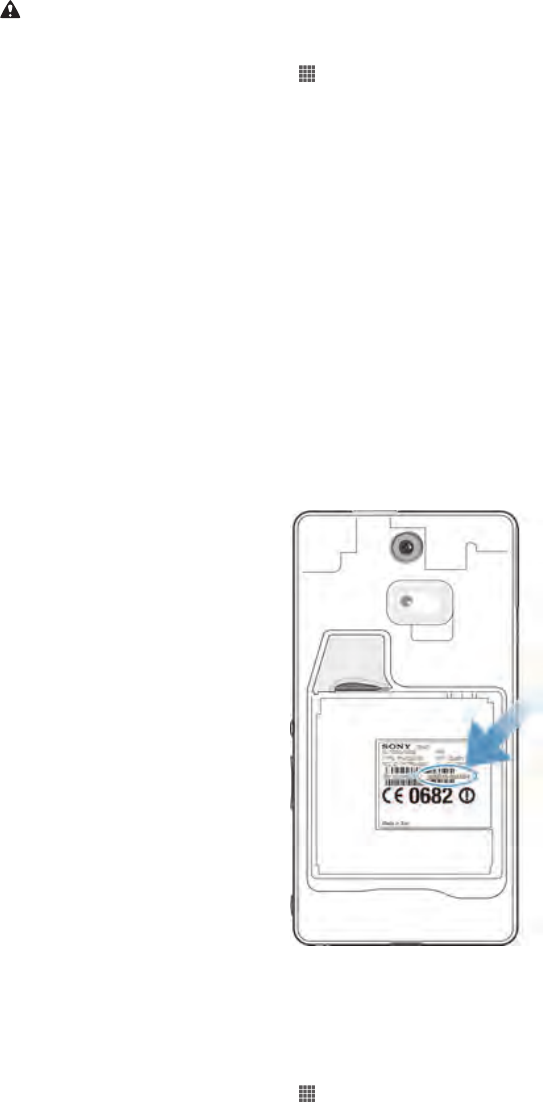
To perform a factory data reset
To avoid permanent damage to your device, do not restart your device while a reset
procedure is underway.
1From your Home screen, tap .
2Find and tap Settings > Backup & reset.
3Tap Factory data reset.
4If you also want to erase data such as pictures and music, which is saved to
your device's internal storage, mark the Erase internal storage checkbox.
5Tap Reset phone.
6To confirm, tap Erase everything.
Locking and protecting your device
IMEI number
Every device has a unique IMEI (International Mobile Equipment Identity) number.
You should keep a copy of this number. If your device is stolen, your network
provider can use your IMEI number to stop the device from accessing the network in
your country.
To view your IMEI number
•Turn off your phone, then remove the battery cover and battery to view your IMEI
number.
•Open the phone dialer on your device and enter *#06#*.
To view your IMEI number in the device
1From your Home screen, tap .
2Find and tap Settings > About phone > Status.
3Scroll to IMEI to view the IMEI number.
Setting a screen lock
There are several ways to lock the screen on your device. For example, you can use
the Face Unlock feature, which uses a picture of your face to unlock the screen. You
can also set a screen unlock pattern, a number-based PIN lock, or a text-based
password.
It is very important that you remember your screen unlock pattern, PIN or password.
If you forget this information, it may not be possible to restore important data such as
contacts and messages. Refer to Sony customer support for more information.
121
This is an Internet version of this publication. © Print only for private use.

To set a screen lock
1From your Home screen, tap > Settings > Security > Screen lock.
2Select an option.
To set up the Face Unlock feature
1From your Home screen, tap > Settings > Security > Screen lock.
2Tap Face Unlock, then follow the instructions in your device to capture your
face.
3After your face is successfully captured, tap Continue.
4Select a backup lock method and follow the instructions in the device to
complete the setup.
The Face Unlock feature is less secure than a screen lock pattern, PIN, or password. Someone
who looks similar to you could unlock your device.
For best results, capture your face in an indoor area that is well lit but not too bright, and hold
the device at eye level.
To unlock the screen using the Face Unlock feature
1Activate the screen.
2Look at your device from the same angle you used to capture your Face
Unlock photo.
If the Face Unlock feature fails to recognise your face, you need to draw the backup pattern
or enter the PIN to unlock the screen.
To disable the Face Unlock protection
1From your Home screen, tap > Settings > Security > Screen lock.
2Draw your backup screen unlock pattern or enter your PIN.
3Tap Swipe.
To create a screen unlock pattern
1From the Home screen, tap .
2Find and tap Settings > Security > Screen lock > Pattern.
3Follow the instructions in your device. You are asked to select a security
question that will be used to unlock the device if you forget your screen unlock
pattern.
To unlock the screen using a screen unlock pattern
1Activate the screen.
2Draw your screen unlock pattern.
If the unlock pattern you draw on the screen is rejected five times in a row, you can select to
either wait 30 seconds and then try again, or to answer the security question you have
selected.
To change the screen unlock pattern
1From your Home screen, tap .
2Find and tap Settings > Security > Screen lock.
3Draw your screen unlock pattern.
4Tap Pattern.
5Follow the instructions in your device.
To disable the screen unlock pattern
1From your Home screen, tap > Settings > Security > Screen lock.
2Draw the screen unlock pattern.
3Tap Swipe.
122
This is an Internet version of this publication. © Print only for private use.

To create a screen unlock PIN
1From your Home screen, tap > Settings > Security > Screen lock > PIN.
2Enter a numeric PIN.
3If necessary, tap to minimise the keyboard.
4Tap Continue.
5Re-enter and confirm your PIN.
6If necessary, tap to minimise the keyboard.
7Tap OK.
To disable the screen unlock PIN
1From your Home screen, tap > Settings > Security > Screen lock.
2Enter your PIN, then tap Next.
3Tap Swipe.
To create a screen lock password
1From your Home screen, tap > Settings > Security > Screen lock >
Password.
2Enter a password.
3If necessary, tap to minimise the keyboard.
4Tap Continue.
5Re-enter and confirm your password.
6If necessary, tap to minimise the keyboard.
7Tap OK.
To disable the screen unlock password
1From your Home screen, tap > Settings > Security > Screen lock.
2Enter your password and tap Continue.
3Tap Swipe.
Support application
To access the support application
1From your Application screen, find and tap .
2Find and tap the required support item.
Recycling your device
Got an old device lying around the house? Why not recycle it? By doing so, you will
help us reuse its materials and components, and you’ll protect the environment, too!
Find out more about the recycling options in your region at blogs.sonymobile.com/
about-us/sustainability/commitment/overview/.
123
This is an Internet version of this publication. © Print only for private use.

Reference
Settings overview
Get to know the settings in your device so that you can personalise them to your own
requirements.
Wi-Fi Turn Wi-Fi® on or off, scan for available Wi-Fi® networks, or add
a Wi-Fi® network.
Bluetooth Turn Bluetooth™ on or off, search for available Bluetooth™
devices, and make your device visible or invisible to other
Bluetooth™ devices.
Data usage Turn the mobile data traffic on or off, and keep track of your data
usage details over a specified period of time.
More… Turn Airplane mode on or off, configure settings for VPN and
mobile networks, and enable your device to share its mobile data
connection as a portable Wi-Fi® hotspot, or via USB tethering or
Bluetooth™ tethering. You can also enable or disable the NFC
function.
Call settings Manage and configure settings for fixed dialing numbers,
voicemail and Internet calls.
Sound Configure how your device rings, vibrates, or alerts you when you
receive communications. You can also use these settings to set
the volume level for music, video, games or other media with
audio, and to make related adjustments.
Display Enable the screen to switch orientation when you rotate your
device. You can also set the brightness, font size, wallpaper and
screen timeout.
Storage Check out the available space on the internal storage and on the
SD card. You can also erase the SD card, or unmount it for safe
removal.
Power
management Turn the power saving modes on or off. You can also view your
battery status and see how different applications consume
battery power.
Apps Manage running applications, downloaded applications and
applications on the SD card.
Xperia™ Access a range of settings tailored to your Xperia device, for
example, USB connection mode, Internet, screen mirroring,
security, and Throw settings.
Location
services Enable or disable access to your location information.
Security Protect your device by setting up different locks and passwords.
You can also allow the installation of applications not from
Google Play™.
Language &
input Select the device language, adjust text input options, add words
to the personal dictionary and configure speech settings.
Backup & reset Back up your data and reset your device.
Setup guide Get help setting up your device.
Add account Add an account on your device, for example, an email account or
a Google™ account.
124
This is an Internet version of this publication. © Print only for private use.

Date & time Set the time and date, or choose the network-provided values.
Select your preferred date and hour format.
Accessibility Enable your installed accessibility services and adjust related
settings.
Developer
options Set options for application development. For example, you can
display CPU usage on the Home screen or set your device to
enter debug mode when USB connections are active.
About phone View information about your device, such as the model number
and signal strength. You can also update your software to the
latest version.
Status and notification icons overview
Status icons
The following status icons may appear on your screen:
Signal strength
No signal
Roaming
GPRS is available
EDGE is available
NFC is activated
3G is available
Sending and downloading GPRS data
Sending and downloading EDGE data
Sending and downloading 3G data
Battery status
The battery is charging
GPS is activated
Airplane mode is activated
The Bluetooth™ function is activated
The SIM card is not inserted
The microphone is muted
The speakerphone is on
Silent mode
Vibrate mode
An alarm is set
Synchronisation is ongoing
Problem with sign-in or synchronisation
A Wi-Fi® connection is enabled and wireless networks are available
125
This is an Internet version of this publication. © Print only for private use.
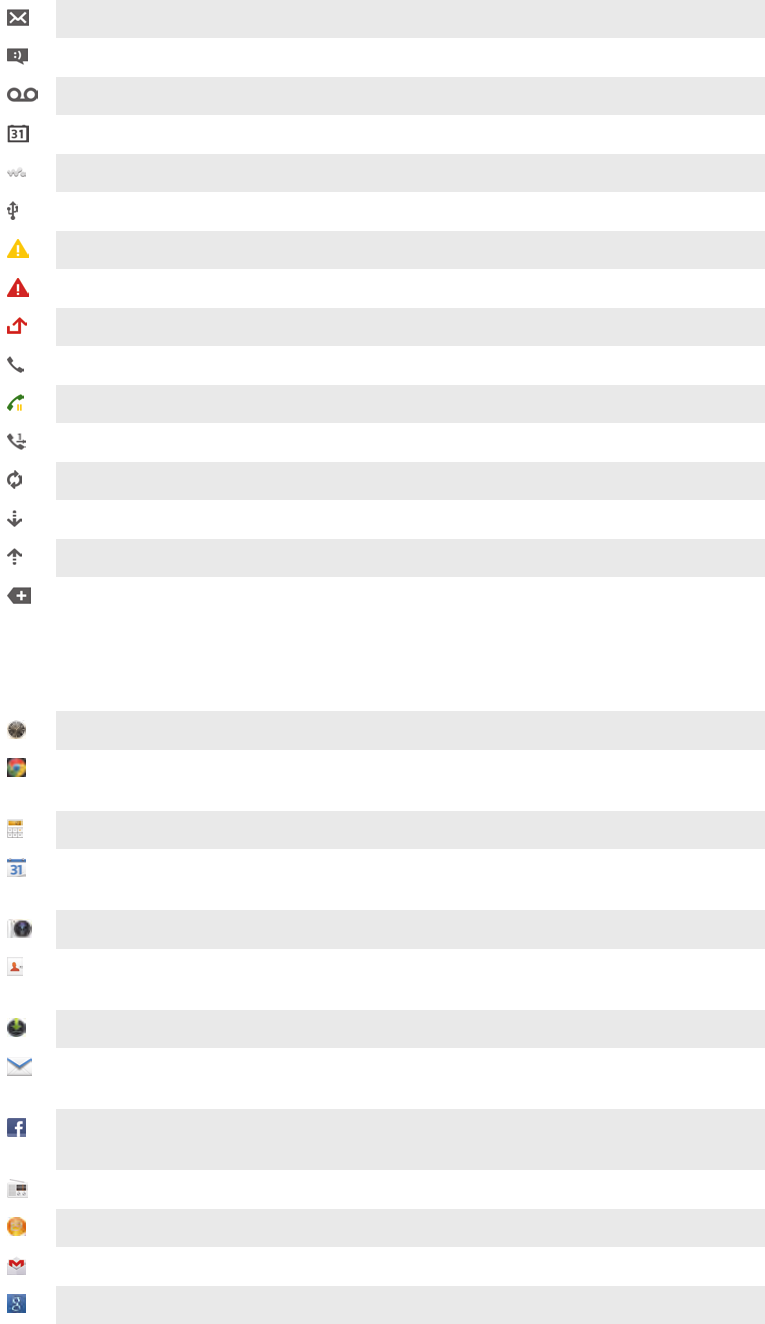
Notification icons
The following notification icons may appear on your screen:
New email message
New text message or multimedia message
New voicemail
An upcoming calendar event
A song is playing
The device is connected to a computer via a USB cable
Warning message
Error message
Missed call
Call ongoing
Call on hold
Call forwarding on
Software updates available
Downloading data
Uploading data
More (undisplayed) notifications
Application overview
Use the Alarm and clock application to set various kinds of alarms.
Use your web browser to navigate and view web pages, manage bookmarks,
and manage text and images.
Use the Calculator application to perform basic calculations.
Use the Calendar application to keep track of your events and manage your
appointments.
Use the camera to take photos and record video clips.
Use the Contact application to manage phone numbers, email address and
other information related to your contacts.
Access your downloaded applications.
Use the Email application to send and receive emails through both private
and corporate accounts.
Use the Facebook application to engage in social networking with friends,
family members and colleagues around the world.
Browse and listen to FM radio stations.
Use the Album application to view and to work with your photos and videos.
Use the Gmail™ application to read, write and organise email messages.
Search for information in your device and on the web.
126
This is an Internet version of this publication. © Print only for private use.
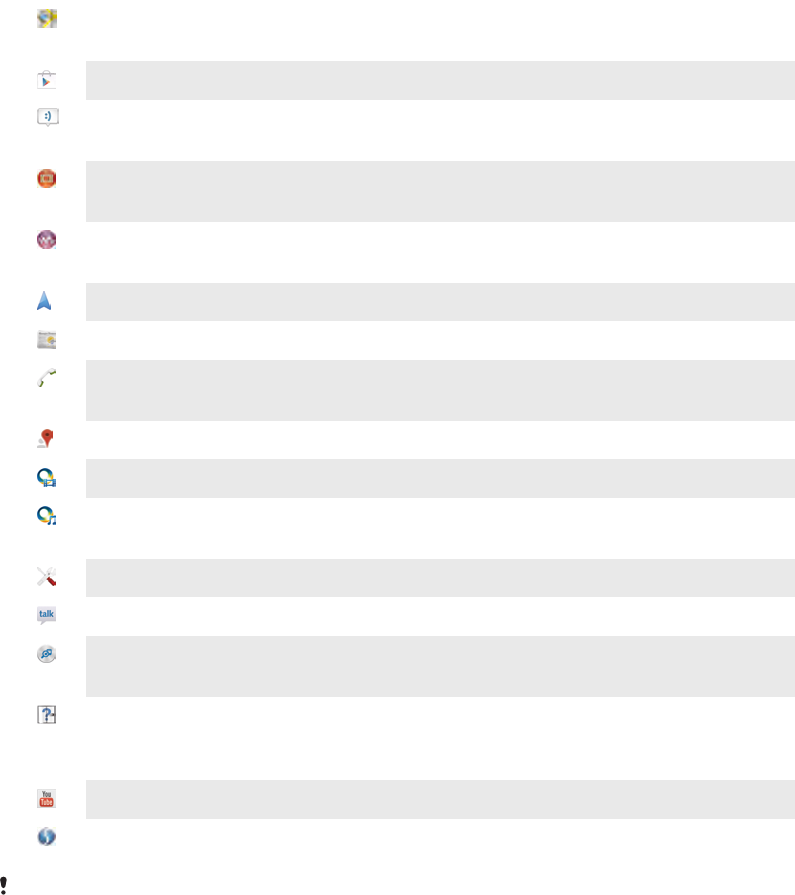
View your current location, find other locations, and calculate routes using
Google Maps™.
Go to Google Play™ to download free and paid applications for your device.
Use the Messaging application to send and receive text and multimedia
messages.
Use the Movies application to play videos in your device, and share videos
with your friends or on other devices using DLNA™.
Use the "WALKMAN" application to organise and play music, audio books
and podcasts.
Navigate your way using spoken, turn-by-turn instructions.
View news stories and weather forecasts.
Make phone calls by dialling the number manually or by using the smart dial
function.
Search for places, for example, restaurants and cafés.
Use the Video Unlimited™ application to rent and purchase videos.
Use the subscription-based Music Unlimited™ application to access millions
of songs over a mobile data connection or Wi-Fi® connection.
Optimise settings to suit your own requirements.
Use the Google Talk™ application to chat with friends online.
Identify music tracks that you hear playing in your surroundings, and get
artist, album and other info.
Use the Help application to access user support in the device. For example,
you can access a User guide, troubleshooting information, plus tips and
tricks.
Use YouTube™ to share and view videos from around the world.
Download and install new applications and updates.
Some applications are not supported all networks and/or service providers in all areas.
127
This is an Internet version of this publication. © Print only for private use.
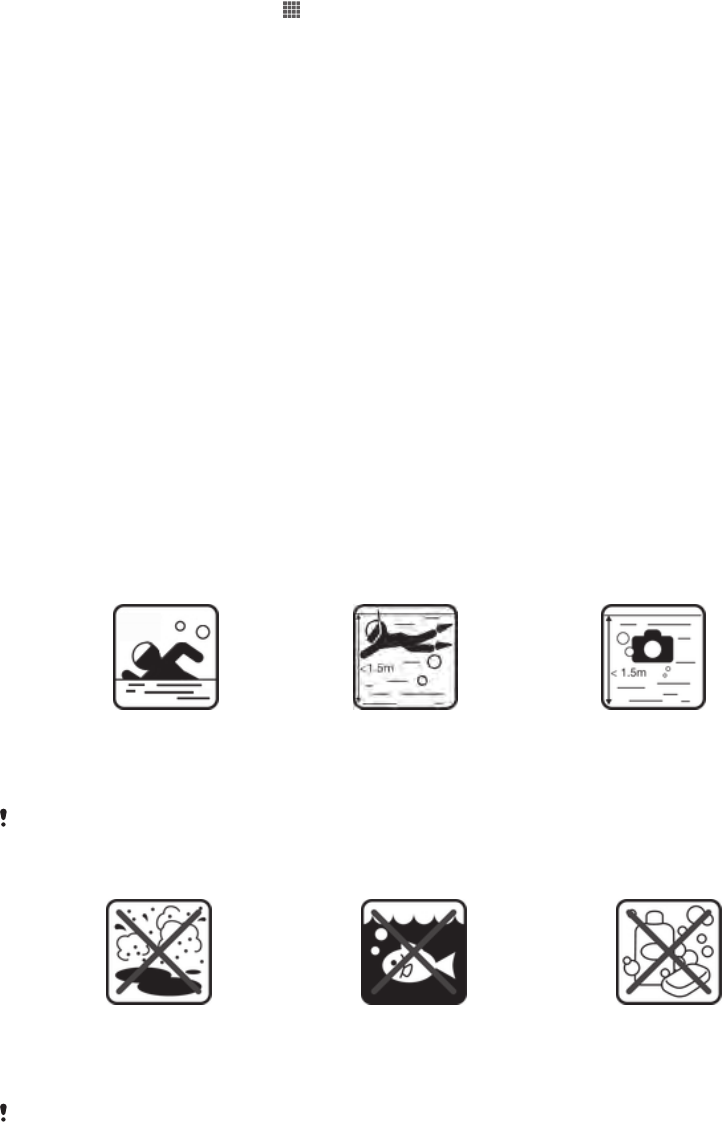
Important information
Important information leaflet
Before you use your device, please read the Important information leaflet provided in
the Setup guide in your device or in the box.
To access the setup guide manually
1From the Home screen, tap .
2Tap Settings > Setup guide.
Limitations to services and features
Some of the services and features described in this User guide are not supported in
all countries/regions or by all networks and/or service providers in all areas. Without
limitation, this applies to the GSM International Emergency Number, 112. Please
contact your network operator or service provider to determine availability of any
specific service or feature and whether additional access or usage fees apply.
Use of certain features and applications described in this guide may require access
to the Internet. You may incur data connection charges when you connect to the
Internet from your device. Contact your wireless service provider for more
information.
Protecting your device from water and dust
In order for your device to be waterproof, the covers for the micro USB port and the
headset jack must be firmly closed. Also, make sure that the battery cover is
attached correctly.
Avoid exposing your device to environments with excessive dust or moisture. Normal
wear and tear along with damage to your device can reduce its ability to resist dust
or moisture. You can use the device in the following fresh (non-saline) water
conditions:
Swimming pool Diving Shooting photos
and videos
You should only use the device in water depths of 1.5 metres or less.
Do not use your device in the following conditions:
Sand/mud Salt water Other liquid
chemicals
Water can sometimes cause unintended touch actions on the screen. So it is recommended to
activate the Touch Block function before using the device in water. You may need to first
download the Touch Block application by using the Update center application in your device.
128
This is an Internet version of this publication. © Print only for private use.

Your smartphone is waterproof and dust resistant in compliance with the Ingress
Protection ratings IP5X, IPX5 and IPX8 (see details below). Always firmly attach all
covers to ensure the water and dust resistance of the device. If liquid is detected
inside the device, for example, underneath one of the covers or on the battery, your
warranty will be void. Never submerge your device in salt water or let the micro USB
port or headset jack come in contact with salt water. Also, never expose the device
to any liquid chemicals, or to moist environments with extreme high or low
temperatures. The waterproof ability of the micro USB port and the headset jack is
not guaranteed in all environments or conditions. After using the device in water, dry
off the areas around the micro USB port cover and the headset jack cover.
If the speaker or microphone get wet, dry these areas and wait for three hours before
using them again. You can, however, use other features in the device that do not
utilise the speaker or microphone.
All compatible accessories, including batteries, chargers, handsfree devices and
micro USB cables, are not waterproof and dust resistant on their own.
Your warranty does not cover damage or defects caused by abuse or improper use
of your device. If you have any further questions about the use of your products, refer
to our Customer support service for help.
IP (Ingress Protection) rating
Your device has an IP rating, which means it has undergone certified tests to
measure its resistance levels to both dust and water. The first digit in the two-digit IP
rating indicates the level of protection against solid objects, including dust. The
second digit indicates how resistant the device is to water. The higher the numbers,
the higher the respective protection.
Your smartphone is waterproof and dust resistant in compliance with the Ingress
Protection ratings IP5X, IPX5 and IPX8 (see details below). These ratings mean that
your device is dust resistant and is protected against low pressure water stream as
well as against the effects of submersion for 30 minutes in fresh (non-saline) water up
to 1.5 metres deep. You can therefore use the device in dusty environments, when
your fingers are wet, and in extreme weather conditions, for example, when it’s
snowing or raining, or when humidity levels are high. You can also use the device in
fresh water conditions (for example, in a swimming pool) to take underwater photos
or shoot underwater videos using the Camera key. See the table below for more
details.
Resistance to solid objects and dust Resistance to water
IP0X. No special protection IPX0. No special protection
IP1X. Protected against solid objects > 50 mm in
diameter IPX1. Protected against dripping water
IP2X. Protected against solid objects > 12.5 mm in
diameter IPX2. Protected against dripping water when tilted
up to 15 degrees from normal position
IP3X. Protected against solid objects > 2.5 mm in
diameter IPX3. Protected against spraying water
IP4X. Protected against solid objects > 1 mm in
diameter IPX4. Protected against splashing water
IP5X. Protected against dust; limited ingress (no
harmful deposit) IPX5. Protected against water jet spray
IP6X. Dust tight IPX6. Protected against heavy jet spray
IPX7. Protected against the effects of immersion
IPX8. Protected against submersion
The IPX5 and IPX8 ratings are based on tests lasting 30 minutes in water depths of 1.5 metres.
Go to www.sonymobile.com/testresults for more information.
129
This is an Internet version of this publication. © Print only for private use.
Legal information
Sony C5503/C5502
This User guide is published by Sony Mobile Communications AB or its local affiliated company, without any
warranty. Improvements and changes to this User guide necessitated by typographical errors, inaccuracies of
current information, or improvements to programs and/or equipment, may be made by Sony Mobile
Communications AB at any time and without notice. Such changes will, however, be incorporated into new
editions of this User guide.
©Sony Mobile Communications AB, 2013.
All rights reserved.
Your mobile phone has the capability to download, store and forward additional content, for example,
ringtones. The use of such content may be restricted or prohibited by rights of third parties, including but not
limited to restriction under applicable copyright laws. You, and not Sony, are entirely responsible for additional
content that you download to or forward from your mobile phone. Prior to your use of any additional content,
please verify that your intended use is properly licensed or is otherwise authorized. Sony does not guarantee
the accuracy, integrity or quality of any additional content or any other third party content. Under no
circumstances will Sony be liable in any way for your improper use of additional content or other third party
content.
This User guide may reference services or applications provided by third parties. Use of such programming or
services may require separate registration with the third party provider and may be subject to additional terms
of use. For applications accessed on or through a third-party website, please review such websites’ terms of
use and applicable privacy policy in advance. Sony does not warrant or guarantee the availability or
performance of any third-party websites or offered services.
Remove the battery to see regulatory information such as the CE mark.
All product and company names mentioned herein are the trademarks or registered trademarks of their
respective owners. Any rights not expressly granted herein are reserved. All other trademarks are property of
their respective owners.
Visit www.sonymobile.com for more information.
All illustrations are for illustration purposes only and may not accurately depict the actual phone.
This product is protected by certain intellectual property rights of Microsoft. Use or distribution of such
technology outside of this product is prohibited without a license from Microsoft.
Content owners use Windows Media digital rights management technology (WMDRM) to protect their
intellectual property, including copyrights. This device uses WMDRM software to access WMDRM-protected
content. If the WMDRM software fails to protect the content, content owners may ask Microsoft to revoke the
software's ability to use WMDRM to play or copy protected content. Revocation does not affect unprotected
content. When you download licenses for protected content, you agree that Microsoft may include a
revocation list with the licenses. Content owners may require you to upgrade WMDRM to access their content.
If you decline an upgrade, you will not be able to access content that requires the upgrade.
This product is licensed under the MPEG-4 visual and AVC patent portfolio licenses for the personal and non-
commercial use of a consumer for (i) encoding video in compliance with the MPEG-4 visual standard
("MPEG-4 video") or the AVC standard ("AVC video") and/or (ii) decoding MPEG- 4 or AVC video that was
encoded by a consumer engaged in a personal and non-commercial activity and/or was obtained from a video
provider licensed by MPEG LA to provide MPEG-4 and/or AVC video. No license is granted or shall be implied
for any other use. Additional information including that relating to promotional, internal and commercial uses
and licensing may be obtained from MPEG LA, L.L.C. See http://www.mpegla.com. MPEG Layer-3 audio
decoding technology licensed from Fraunhofer IIS and Thomson.
130
This is an Internet version of this publication. © Print only for private use.
Index
A
accounts ..................................................................11
Exchange Active Sync® ..................................11
Facebook™ .....................................................11
Google™ .........................................................11
adjusting volume .....................................................59
Airplane mode .........................................................31
alarm ......................................................................115
Album ................................................................81, 82
map .................................................................86
My albums .......................................................83
online albums ..................................................87
opening ...........................................................81
pictures ............................................................82
SensMe™ slideshow .......................................84
thumbnail size .................................................82
viewing ..........................................82, 83, 86, 87
viewing local content .......................................81
viewing online photos ......................................88
Android Market™ - See Google Play™ ..................37
Android™ ..................................................................7
animated wallpaper .................................................20
answering service ....................................................41
applications
arranging .........................................................22
overview ........................................................126
screen ..............................................................20
sorting .............................................................22
audio ........................................................................62
adjusting volume .............................................59
playing .............................................................59
playing tracks in random order .......................62
audio content
related content ................................................60
B
back cover
attaching ............................................................9
removing ............................................................8
backing up
contacts ...................................................49, 119
content ..........................................................119
battery .....................................................................12
Bluetooth™ wireless technology ...........................102
BRAVIA® Engine .....................................................81
brightness ................................................................31
business cards
sending ............................................................48
C
calendar .................................................................115
create an event ..............................................115
calls ...................................................................39, 43
barring .............................................................42
diverting ...........................................................42
emergency .......................................................39
forwarding .......................................................42
log ....................................................................40
missed .............................................................40
multiple ............................................................41
reject ................................................................42
settings ............................................................42
waiting .............................................................41
camera .........................................................70, 72, 77
closing .............................................................70
controls ...........................................................70
face detection ..................................................71
geotagging ......................................................72
icons ................................................................77
overview ..........................................................70
recording videos ........................................76, 77
screen ..............................................................70
self-portraits ....................................................71
settings ......................................................72, 77
smile detection ................................................72
Smile Shutter™ ...............................................72
taking photos ......................................70, 71, 72
using the flash .................................................71
video ................................................................76
viewing photos ................................................71
viewing videos .................................................77
zoom ................................................................71
caps lock .................................................................25
charging ...................................................................12
chat ..........................................................................52
conference calls ......................................................41
connectivity .............................................................94
contacts ...................................................................44
backing up .......................................................49
copying ............................................................49
favourite ...........................................................48
groups .............................................................48
importing from SIM card .................................45
joining contact information ..............................47
picture .............................................................47
sending ............................................................48
sharing .............................................................48
transferring ................................................44, 45
corporate email, calendar and contacts ................110
cropping
photos .............................................................84
D
data traffic ...............................................................34
date
format ..............................................................30
deleting ....................................................................59
an alarm .........................................................115
music ...............................................................65
photos .............................................................85
tracks ...............................................................59
videos ..............................................................86
device
battery .............................................................13
performance ....................................................13
update ...........................................................118
download
Internet settings ...............................................33
driving directions ...................................................114
E
editing
photos .............................................................85
email ........................................................................53
more than one account ...................................53
emergency numbers ................................................39
equaliser ..................................................................59
events
calendar .........................................................115
extensions ...............................................................18
F
face detection ..........................................................71
Facebook™
"Like" a track on Facebook™ .........................60
synchronisation .............................................111
131
This is an Internet version of this publication. © Print only for private use.
Xperia™ with Facebook ................................111
favourites
removing radio channels as ............................68
saving radio channels as .................................68
fixed dialling ............................................................43
flash
using when taking photos ...............................71
Flight mode - See Airplane mode ............................31
FM radio
favourites .........................................................68
selecting a channel ..........................................67
Friends’ music .........................................................62
front camera ............................................................70
G
geotagging
of photos .........................................................72
gesture input ...........................................................27
Gmail™ ....................................................................53
Google Latitude™ .................................................114
Google Maps™ .....................................................114
Google Play™ .........................................................37
Google Talk™ ..........................................................52
Google™ account setup .........................................54
Google™ synchronisation .....................................110
GPS .......................................................................113
H
headset ....................................................................33
using ................................................................33
Home screen ...........................................................18
customising .....................................................19
I
icons ..............................................................125, 126
in the camera ...................................................77
importing SIM contacts ...........................................45
improving photos with Mobile BRAVIA® Engine ....81
infinite button ...........................................................60
instant messaging ...................................................52
Internet
settings ............................................................33
web browser ....................................................93
K
keyboard .................................................................25
settings ............................................................28
keys .........................................................................12
L
language ..................................................................31
writing ..............................................................28
Latitude .................................................................114
LCD backlight control ..............................................31
"Like" a photo on Facebook™ ................................88
"Like" a track on Facebook™ .................................60
"Like" a video on Facebook™ .................................88
live wallpaper ...........................................................20
location ............................................................72, 113
locks
activating the screen .......................................10
locking the screen ...........................................10
screen lock ......................................................10
M
maintenance ..........................................................118
Maps ..............................................................113, 114
marking options .......................................................15
Media Go™ ...........................................................106
messages
settings ............................................................33
MHL (Mobile High-Definition Link) ........................106
micro SIM card
inserting .............................................................9
Microsoft® Exchange synchronisation .................110
Mobile BRAVIA® Engine .........................................81
Movies .....................................................................89
clearing video information ...............................90
Multimedia Messaging Service (MMS)
settings ............................................................33
music ...........................................................33, 58, 63
adjusting volume .............................................59
changing tracks ...............................................59
deleting ............................................................65
downloading music information ......................61
hearing protection ...........................................63
My playlists ......................................................63
pausing a track ................................................59
playing .............................................................59
purchasing .......................................................64
searching using TrackID™ ..............................64
sending ............................................................60
sharing .............................................................64
shortcuts .........................................................61
transferring to your device ..............................58
transferring to/from a computer ......................58
using a headset ...............................................33
viewing artist info ............................................65
Visualiser .........................................................60
music services .........................................................64
Music Unlimited™ ...................................................65
My music .................................................................61
N
Navigation application ...........................................114
notification .............................................................126
light ..................................................................23
panel ..........................................................23, 24
ringtone ...........................................................30
setting ..............................................................24
O
on-screen keyboard ................................................25
overview ..................................................................61
P
pausing a track ........................................................59
personal information ................................................44
phone maintenance ...............................................118
phonebook ..............................................................44
Phonepad ..........................................................25, 27
photo albums
viewing ............................................................81
photos .....................................................................85
adding a geotag ..............................................85
adding the geographical position ....................72
associating with a contact ..............................47
cropping ..........................................................84
deleting ............................................................85
editing ..............................................................85
photo viewer ....................................................82
rotating ............................................................84
selecting ..........................................................82
SensMe™ slideshow .......................................84
sharing .............................................................85
slideshow ........................................................84
taking ...................................................70, 71, 72
transferring to/from a computer ......................58
using as ...........................................................84
viewing ................................................71, 81, 82
viewing on a map ............................................86
viewing same location .....................................72
zooming ...........................................................84
PIN .........................................................................121
132
This is an Internet version of this publication. © Print only for private use.
playing
music ...............................................................59
playlists ....................................................................62
adding a track .................................................62
deleting ............................................................63
playing your own .............................................63
removing tracks ...............................................63
powering off ............................................................10
powering on .............................................................10
presets
removing radio channels as ............................68
saving radio channels as .................................68
protective plastic sheet ...........................................15
PUK .......................................................................121
purchasing
music ...............................................................64
R
radio ........................................................................67
favourites .........................................................68
listening to with the speaker ...........................68
mono sound ....................................................68
moving between channels ..............................67
opening ...........................................................67
radio region .....................................................67
searching for channels ....................................68
selecting a channel ..........................................67
stereo sound ...................................................68
visualizer ..........................................................67
radio sound .............................................................68
receiving items using Bluetooth™ .........................103
recently used applications window .........................21
recommending music ..............................................60
recommending photos and videos ..........................88
recording videos ......................................................70
using the camera key ......................................76
recycling your device ............................................123
resetting .................................................................120
resizing
photos .............................................................84
ringtone .................................................................115
rotating
photos .............................................................84
S
scanning barcodes ................................................107
screen ......................................................................31
cracked ............................................................15
glass ................................................................15
screen unlock pattern ....................................121
warranty ...........................................................15
screen mirroring ....................................................107
searching
music using TrackID™ ....................................64
track information .............................................64
self-portrait ..............................................................70
sending
business cards ................................................48
contacts ...........................................................48
music ...............................................................60
sending items using Bluetooth™ ..................103
SensMe™ channels ................................................62
services ...................................................................11
settings
call ...................................................................42
camera ......................................................72, 77
data usage .......................................................34
Internet ............................................................33
messaging .......................................................33
MMS ................................................................33
quick settings ..................................................23
still camera ......................................................72
video camera ...................................................77
setup guide ..............................................................10
sharing
music ...............................................................64
photos .............................................................85
shuffle music ...........................................................62
silent mode ..............................................................29
SIM card ................................................................121
exporting contacts to ......................................49
importing contacts from ..................................45
slideshow ................................................................84
Smart Connect ......................................................108
smile detection ........................................................72
Smile Shutter™ .......................................................72
SOS - See emergency numbers ..............................39
STAMINA mode
changing settings ............................................14
standby time
estimating ........................................................14
status .....................................................................125
bar ...................................................................23
still camera ........................................................70, 72
settings ............................................................72
support ..................................................................118
Support application ...............................................123
surround sound feature ...........................................59
symbols ...................................................................25
synchronising ........................................................110
Facebook™ contacts, calendar, photos .......111
Google™ contacts, calendar, email ..............110
with Microsoft® Exchange ............................110
T
taking photos ...........................................................70
by tapping .......................................................71
self-portraits ....................................................71
using face detection ........................................71
using smile detection ......................................72
using Smile Shutter™ ......................................72
using the camera key ......................................70
telephony - See calls ...............................................39
tethering
USB tethering ..................................................95
with Xperia Link™ ...........................................95
text input method ....................................................25
themes .....................................................................20
time ..........................................................................30
time management ..................................................115
TrackID™ technology ..............................................64
buying a track ..................................................64
deleting a track ................................................65
opening ...........................................................64
searching for track information .......................64
sharing a track .................................................64
using results ....................................................64
using with the FM Radio .................................69
viewing artist info ............................................65
viewing charts .................................................64
transferring
contacts .....................................................44, 45
turning off ................................................................10
turning on ................................................................10
U
updating your device .............................................118
usage info ................................................................34
USB connection ....................................................104
using Movies ...........................................................89
using the equaliser ..................................................59
133
This is an Internet version of this publication. © Print only for private use.
V
vibration ...........................................................30, 115
video albums
viewing ............................................................81
video camera ...............................................70, 76, 77
recording videos ..............................................77
settings ............................................................77
Video Unlimited™ ....................................................91
buying videos ..................................................91
creating an account .........................................91
menu overview ..........................................91, 92
notifications .....................................................91
renting videos ..................................................91
watching a video .............................................92
videos ......................................................................85
adjusting volume .............................................85
deleting ............................................................86
fast forwarding and rewinding .........................85
pausing ............................................................85
playing .............................................................85
recording ...................................................76, 77
selecting ..........................................................82
sending ............................................................85
sharing .............................................................85
transferring to/from a computer ......................58
viewing ................................................77, 81, 82
viewing
Movies .............................................................89
photos .............................................................71
videos recorded using the camera ..................77
voice input ...............................................................29
voice recognition .....................................................29
voicemail .................................................................41
volume
adjusting for videos .........................................85
key ...................................................................29
W
"WALKMAN" application
adding tracks to playlists ................................62
deleting tracks .................................................59
minimising .......................................................59
overview ..........................................................58
playing tracks in random order .......................62
playlists ...........................................................62
using ................................................................59
using the equaliser ..........................................59
"WALKMAN" application widget .............................63
wallpaper .................................................................20
web browser ............................................................93
widgets ....................................................................19
resizing ............................................................19
wireless networks ..................................................113
Z
zoom ........................................................................71
zooming
photos .............................................................84
134
This is an Internet version of this publication. © Print only for private use.
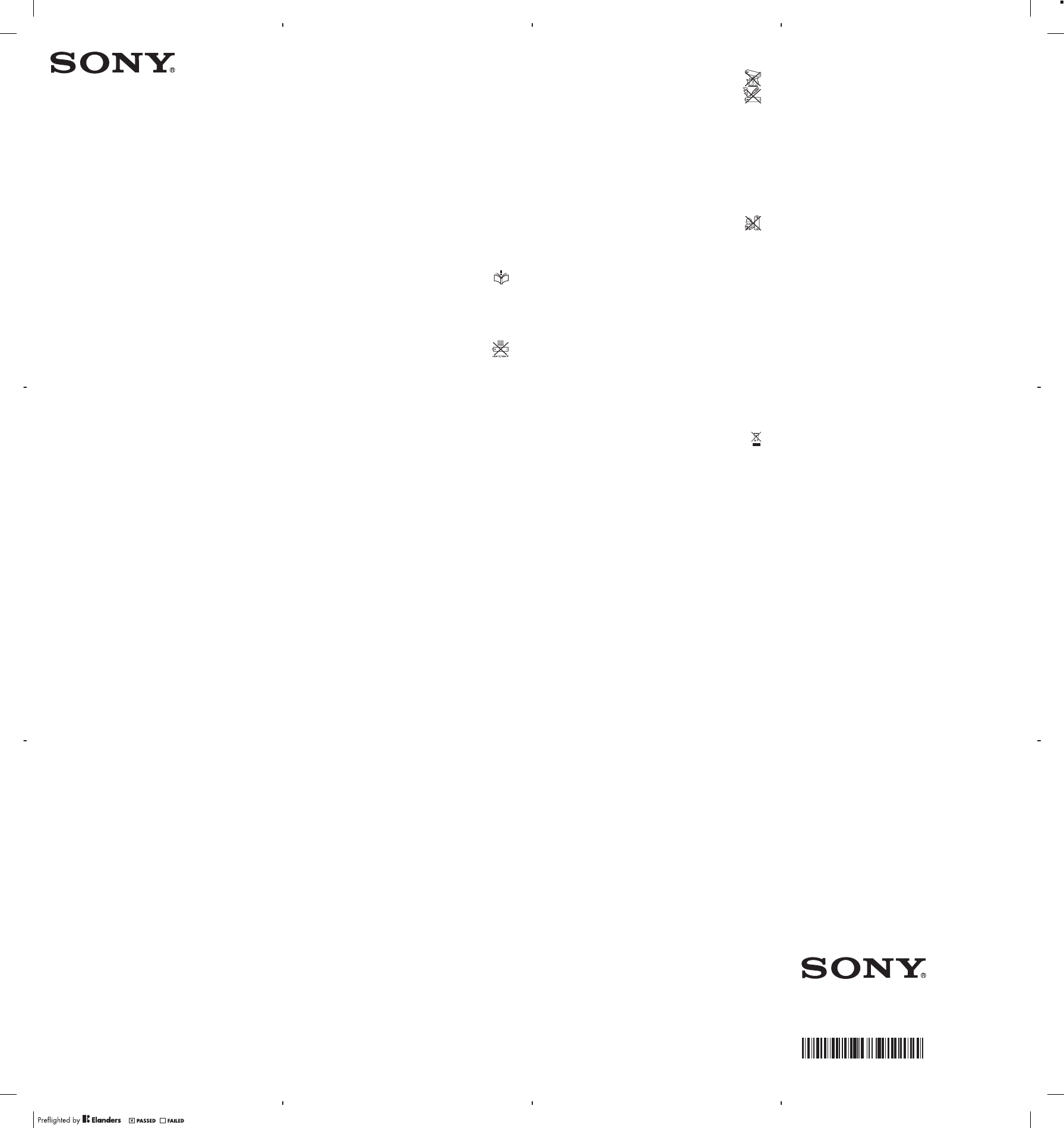
Important information
Sony Consumer Web site
At www.sonymobile.com/support there is a support section where
help and tips are only a few clicks away. Here you will find the latest
computer software updates and tips on how to use your product
more efficiently.
Service and support
You have access to a portfolio of exclusive service advantages
such as:
•Global and local Web sites providing support.
•A global network of Contact Centers.
•An extensive network of Sony service partners.
•A warranty period. Learn more about the warranty conditions in
theLimited warrantysection.
At www.sonymobile.com/support, you can find the latest support
tools and information. For operator-specific services and features,
please contact your network operator.
You can also contact our Contact Centers. If your country/region
is not represented in the list below, please contact your local
dealer. (Calls are charged according to national rates, including
local taxes, unless the phone number is a toll-free number.)
If your product needs service, please contact the dealer from
whom it was purchased, or one of our service partners. For
warranty claims, save proof of purchase.
Guidelines for Safe and Efficient Use
Please follow these guidelines. Failure to do so might entail a
potential health risk or product malfunction. If in doubt as to
its proper function, have the product checked by a certified service
partner before charging or using it.
Recommendations for care and safe use of our products
•Handle with care and keep in a clean and dust-free place.
•Warning! May explode if disposed of in fire.
•Do not expose to liquid or moisture or excess humidity.
•For optimum performance, the product should not be
operated in temperatures below -10°C(+14°F) or above
2
+45°C(+113°F). Do not expose the battery to
temperatures above +60°C(+140°F).
•Do not expose to flames or lit tobacco products.
•Do not drop, throw or try to bend the product.
•Do not paint or attempt to disassemble or modify the
product. Only Sony authorised personnel should perform
service.
•Consult with authorised medical staff and the instructions of the
medical device manufacturer before using the product near
pacemakers or other medical devices or equipment.
•Discontinue use of electronic devices, or disable the radio
transmitting functionality of the device, where required or
requested to do so.
•Do not use where a potentially explosive atmosphere exists.
•Do not place the product, or install wireless equipment, in the
area above an air bag in a car.
•Caution: Cracked or broken displays may create sharp edges or
splinters that could be harmful upon contact.
•Do not use the Bluetooth Headset in positions where it is
uncomfortable or will be subject to pressure.
Children
Warning! Keep out of the reach of children. Do not allow
children to play with mobile phones or accessories. They
could hurt themselves or others. Products may contain small parts
that could become detached and create a choking hazard.
Power supply (Charger)
Connect the charger to power sources as marked on the product.
Do not use outdoors or in damp areas. Do not alter or subject the
cord to damage or stress. Unplug the unit before cleaning it. Never
alter the plug. If it does not fit into the outlet, have a proper outlet
installed by an electrician. When a power supply is connected there
is a small drain of power. To avoid this small energy waste,
disconnect the power supply when the product is fully charged.
Use of charging devices that are not Sony branded may pose
increased safety risks.
3
Battery
New or idle batteries can have short-term reduced capacity. Fully
charge the battery before initial use. Use for the intended purpose
only. Charge the battery in temperatures between +5°C(+41°F) and
+45°C(+113°F). Do not put the battery into your mouth. Do not let
the battery contacts touch another metal object. Turn off the
product before removing the battery. Performance depends on
temperatures, signal strength, usage patterns, features selected
and voice or data transmissions. Only Sony service partners should
remove or replace built-in batteries. Use of batteries that are not
Sony branded may pose increased safety risks. Replace the battery
only with another Sony battery that has been qualified with the
product per the standard IEEE-1725. Use of an unqualified battery
may present a risk of fire, explosion, leakage or other hazard.
Personal medical devices
Mobile phones may affect implanted medical equipment. Reduce
risk of interference by keeping a minimum distance of
15 cm(6 inches) between the phone and the device. Use the phone
at your right ear. Do not carry the phone in your breast pocket. Turn
off the phone if you suspect interference. For use in proximity to
personal medical devices, please consult a physician and the
device manufacturer.
Driving
Some vehicle manufacturers forbid the use of phones in their
vehicles unless a handsfree kit with an external antenna supports
the installation. Check with the vehicle manufacturer's
representative to be sure that the mobile phone or Bluetooth
handsfree will not affect the electronic systems in the vehicle. Full
attention should be given to driving at all times and local laws and
regulations restricting the use of wireless devices while driving must
be observed.
GPS/Location based functions
Some products provide GPS/Location based functions. Location
determining functionality is provided “As is” and “With all faults”.
Sony does not make any representation or warranty as to the
accuracy of such location information.
4
Use of location-based information by the device may not be
uninterrupted or error free and may additionally be dependent on
network service availability. Please note that functionality may be
reduced or prevented in certain environments such as building
interiors or areas adjacent to buildings.
Caution: Do not use GPS functionality in a manner which causes
distraction from driving.
Emergency calls
Calls cannot be guaranteed under all conditions. Never rely solely
upon mobile phones for essential communication. Calls may not be
possible in all areas, on all networks, or when certain network
services and/or phone features are used.
Antenna
Use of antenna devices not marketed by Sony could damage the
phone, reduce performance, and produce SAR levels above the
established limits. Do not cover the antenna with your hand as this
affects call quality, power levels and can shorten talk and standby
times.
Radio Frequency (RF) exposure and Specific Absorption
Rate (SAR)
When the phone or Bluetooth handsfree is turned on, it emits low
levels of radio frequency energy. International safety guidelines
have been developed through periodic and thorough evaluation of
scientific studies. These guidelines establish permitted levels of
radio wave exposure. The guidelines include a safety margin
designed to assure the safety of all persons and to account for any
variations in measurements.
Specific Absorption Rate (SAR) is used to measure radio
frequency energy absorbed by the body when using a mobile
phone. The SAR value is determined at the highest certified power
level in laboratory conditions, but because the phone is designed to
use the minimum power necessary to access the chosen network,
the actual SAR level can be well below this value. There is no proof
of difference in safety based on difference in SAR value.
Products with radio transmitters sold in the US must be certified
by the Federal Communications Commission (FCC). When required,
tests are performed when the phone is placed at the ear and when
5
worn on the body. For body-worn operation, the phone has been
tested when positioned a minimum of 15 mm from the body without
any metal parts in the vicinity of the phone or when properly used
with an appropriate Sony accessory and worn on the body. When
operating with “Hotspot” functionality engaged, a separation
distance of 10mm was used.
For more information about SAR and radio frequency exposure,
go to: www.sonymobile.com/health.
Flight mode
Bluetooth and WLAN functionality, if available in the device, can be
enabled in Flight mode but may be prohibited onboard aircraft or in
other areas where radio transmissions are prohibited. In such
environments, please seek proper authorisation before enabling
Bluetooth or WLAN functionality even in Flight mode.
Malware
Malware (short for malicious software) is software that can harm the
mobile phone or other computers. Malware or harmful applications
can include viruses, worms, spyware, and other unwanted
programs. While the device does employ security measures to
resist such efforts, Sony does not warrant or represent that the
device will be impervious to the introduction of malware. You can
however reduce the risk of malware attacks by using care when
downloading content or accepting applications, refraining from
opening or responding to messages from unknown sources, using
trustworthy services to access the Internet, and only downloading
content to the mobile phone from known, reliable sources.
Accessories
Use only Sony branded original accessories and certified service
partners. Sony does not test third-party accessories. Accessories
may influence RF exposure, radio performance, loudness, electric
safety and other areas. Third-party accessories and parts may pose
a risk to your health or safety or decrease performance.
Accessible Solutions/Special Needs
In the US, compatible Sony Xperia phones may offer compatibility
with TTY terminals (with use of necessary accessory). For more
6
information call the Sony Special Needs Center on 877 878 1996
(TTY) or 877 207 2056 (voice), or go to www.sonyericsson-snc.com.
Disposal of old electrical and electronic equipment and
battery
This symbols on the electronic product or on its packaging
indicates that the electronic product inclusive the battery should
not be treated as household waste. Instead it should be handed
over to the applicable collection point for the recycling of electrical
and electronic equipment. Do not attempt to remove internal
batteries. Internal batteries shall be removed only by a waste
treatment facility or trained service professional.
By ensuring this product is disposed of correctly, you will help
prevent potential negative consequences for the environment and
human health, which could otherwise be caused by inappropriate
waste handling of this product. The recycling of materials will help
to conserve natural resources. For more detailed information about
recycling of this product, please contact your local city office, your
household waste disposal service or the shop where you
purchased the product, by calling a Sony Contact Center or at
www.sonymobile .com/recycling.
Memory card
If the product comes complete with a removable memory card, it is
generally compatible with the handset purchased but may not be
compatible with other devices or the capabilities of their memory
cards. Check other devices for compatibility before purchase or
use. If the product is equipped with a memory card reader, check
memory card compatibility before purchase or use.
Memory cards are generally formatted prior to shipping. To
reformat the memory card, use a compatible device. Do not use the
standard operating system format when formatting the memory
card on a PC. For details, refer to the operating instructions of the
device or contact customer support.
SIM card
If your phone is equipped with a standard-sized SIM card slot,
inserting an incompatible SIM card (for example, a micro SIM card,
a micro SIM card with a non-Sony adapter, or a standard SIM card
cut into a micro SIM card size) in the SIM card slot may damage
7
your SIM card or your phone permanently. Sony does not warrant
and will not be responsible for any damage caused by use of
incompatible or modified SIM cards.
For Devices Supporting 3D Viewing capabilities
In viewing 3D images shot with this phone on a 3D-compatible
monitor, you may experience discomfort in the form of eye strain,
fatigue, or nausea. To prevent these symptoms, we recommend
that you take regular breaks. However, you need to determine for
yourself the length and frequency of breaks you require, as they
vary according to the individual. If you experience any type of
discomfort, stop viewing the 3D images until you feel better, and
consult a physician as necessary. Also refer to the operating
instructions supplied with the device or software you have
connected or are using with this phone. Note that a child’s eyesight
is still at the development stage (particularly children below the age
of 6). Consult a pediatrician or ophthalmologist before letting your
child view 3D images, and make sure he/she observes the above
precautions when viewing such images.
Warning!
If the device requires an adapter for insertion into the handset or
another device, do not insert the card directly without the required
adapter.
Precautions on memory card use
•Do not expose the memory card to moisture.
•Do not touch terminal connections with your hand or any metal
object.
•Do not strike, bend, or drop the memory card.
•Do not attempt to disassemble or modify the memory card.
•Do not use or store the memory card in humid or corrosive
locations or in excessive heat such as a closed car in summer, in
direct sunlight or near a heater, etc.
•Do not press or bend the end of the memory card adapter with
excessive force.
•Do not let dirt, dust, or foreign objects get into the insert port of
any memory card adapter.
•Check you have inserted the memory card correctly.
8
•Insert the memory card as far as it will go into any memory card
adapter needed. The memory card may not operate properly
unless fully inserted.
•We recommend that you make a backup copy of important data.
We are not responsible for any loss or damage to content you
store on the memory card.
•Recorded data may be damaged or lost when you remove the
memory card or memory card adapter, turn off the power while
formatting, reading or writing data, or use the memory card in
locations subject to static electricity or high electrical field
emissions.
Protection of personal information
Erase personal data before disposing of the product. To delete
data, perform a master reset. Deleting data from the phone memory
does not ensure that it cannot be recovered. Sony does not warrant
against recovery of information and does not assume responsibility
for disclosure of any information even after a master reset.
Loudness warning!
Avoid volume levels that may be harmful to your hearing.
End User Licence Agreement
Software delivered with this device and its media is owned by Sony
Mobile Communications AB, and/or its affiliated companies and its
suppliers and licensors.
Sony grants you a non-exclusive limited licence to use the
Software solely in conjunction with the Device on which it is
installed or delivered. Ownership of the Software is not sold,
transferred or otherwise conveyed.
Do not use any means to discover the source code or any
component of the Software, reproduce and distribute the Software,
or modify the Software. You are entitled to transfer rights and
obligations to the Software to a third party, solely together with the
Device with which you received the Software, provided the third
party agrees in writing to be bound by the terms of this Licence.
This licence exists throughout the useful life of this Device. It can
be terminated by transferring your rights to the Device to a third
party in writing.
9
Failure to comply with any of these terms and conditions will
terminate the licence immediately.
Sony and its third party suppliers and licensors retain all rights,
title and interest in and to the Software. To the extent that the
Software contains material or code of a third party, such third
parties shall be beneficiaries of these terms.
This licence is governed by the laws of Sweden. When
applicable, the foregoing applies to statutory consumer rights.
In the event Software accompanying or provided in conjunction
with your device is provided with additional terms and conditions,
such provisions shall also govern your possession and usage of the
Software.
Export regulations
Export regulations: Goods delivered under this Agreement may be
the subject to import and export regulations of the European Union,
the United States and other countries. Purchaser will comply with
these applicable laws and regulations and will obtain and maintain
any export and import license required for the delivery of goods to
Purchaser under this Agreement. Without limiting the foregoing,
and as an example, Purchaser will not knowingly export or re-
export goods to destinations identified pursuant to Articles in
Chapter II of European Council Regulation (EC) 428/2009 and
specifically, and without limitation, Purchaser will also comply with
U.S. government Export Administration Regulations (“EAR”, 15
C.F.R. §§ 730-774, http://www.bis.doc.gov/) administered by
Department of Commerce, Bureau of Industry and Security and
economic sanctions regulations (30 C.F.R. §§ 500 et. seq., http://
www.treas.gov/offices/enforcement/ofac/) administered by the U.S.
Department of Treasury, Office of Foreign Assets Control.
Limited Warranty
Sony Mobile Communications AB, SE-221 88 Lund, Sweden,
(Sony) or its local affiliated company, provides this Limited Warranty
for your mobile phone, original accessory delivered with your
mobile phone, and/or your mobile computing product (hereinafter
referred to as “Product”).
10
Should your Product need warranty service, please return it to
the dealer from whom it was purchased, or contact your local Sony
Contact Center (national rates may apply) or visit
www.sonymobile.com to get further information.
Our warranty
Subject to the conditions of this Limited Warranty, Sony warrants
this Product to be free from defects in design, material and
workmanship at the time of its original purchase by a consumer.
This Limited Warranty will last for a period of two (2) years as from
the original date of purchase of the Product for your mobile phone,
and for a period of one (1) year following the original purchase date
of the Product for all original accessories (such as the battery,
charger or handsfree kit) which may be delivered with your mobile
phone.
What we will do
If, during the warranty period, this Product fails to operate under
normal use and service, due to defects in design, materials or
workmanship, Sony authorised distributors or service partners, in
the country/region* where you purchased the Product, will, at their
option, either repair or replace the Product in accordance with the
terms and conditions stipulated herein.
Sony and its service partners reserve the right to charge a
handling fee if a returned Product is found not to be under warranty
according to the conditions below.
Please note that some of your personal settings, downloads and
other information may be lost when your Sony Product is repaired
or replaced. At present, Sony may be prevented by applicable law,
other regulation or technical restrictions from making a backup
copy of certain downloads. Sony does not take any responsibility
for any lost information of any kind and will not reimburse you for
any such loss. You should always make backup copies of all the
information stored on your Sony Product such as downloads,
calendar and contacts before handing in your Sony Product for
repair or replacement.
Conditions
1. This Limited Warranty is valid only if the original proof of purchase
for this Product issued by a Sony authorised dealer specifying the
11
www.sonymobile.com
Sony Mobile Communications AB
SE-221 88 Lund, Sweden
1222-9269.9
June 27, 2012 15:00:07
Legal-Leaflets---Generic_EN (24M)_1222-9269.9.pdf 1 of 2

date of purchase and serial number**, is presented with the
Product to be repaired or replaced. Sony reserves the right to
refuse warranty service if this information has been removed or
changed after the original purchase of the Product from the
dealer.
2. If Sony repairs or replaces the Product, the repair for the defect
concerned, or the replaced Product shall be warranted for the
remaining time of the original warranty period or for ninety (90)
days from the date of repair, whichever is longer. Repair or
replacement may involve the use of functionally equivalent
reconditioned units. Replaced parts or components will become
the property of Sony.
3. This warranty does not cover any failure of the Product due to
normal wear and tear, or due to misuse, including but not limited
to use in other than the normal and customary manner, in
accordance with the Sony instructions for use and maintenance
of the Product. Nor does this warranty cover any failure of the
Product due to accident, software or hardware modification or
adjustment, acts of God or damage resulting from liquid.
A rechargeable battery can be charged and discharged more
than a hundred times. However, it will eventually wear out – this is
not a defect and corresponds to normal wear and tear. When the
talk-time or standby time is noticeably shorter, it is time to replace
the battery. Sony recommends that you use only batteries and
chargers approved by Sony.
Minor variations in display brightness and colour may occur
between phones. There may be tiny bright or dark dots on the
display. It occurs when individual dots have malfunctioned and
can not be adjusted. Two defective pixels are deemed
acceptable.
Minor variations in camera image appearance may occur
between phones. This is nothing uncommon and is not regarded
as a defective camera module.
4. Since the cellular system on which the Product is to operate is
provided by a carrier independent from Sony, Sony will not be
responsible for the operation, availability, coverage, services or
range of that system.
5. This warranty does not cover Product failures caused by
installations, modifications, or repair or opening of the Product
performed by a non-Sony authorised person.
12
6. The warranty does not cover Product failures which have been
caused by use of accessories or other peripheral devices which
are not Sony branded original accessories intended for use with
the Product.
Sony disclaims any and all warranties, whether express or
implied, for failures caused to the Product or peripheral devices
as a result of viruses, trojan horses, spyware, or other malicious
software. Sony strongly recommends that you install appropriate
virus protection software on your Product and any peripheral
devices connected to it, as available, and update it regularly, to
better protect your device. It is understood, however, that such
software will never fully protect your Product or its peripheral
devices and Sony disclaims all warranties, whether express or
implied, in case of failure by such antivirus software to fulfil its
intended purpose.
7. Tampering with any of the seals on the Product will void the
warranty.
8. THERE ARE NO EXPRESS WARRANTIES, WHETHER WRITTEN
OR ORAL, OTHER THAN THIS PRINTED LIMITED WARRANTY.
ALL IMPLIED WARRANTIES, INCLUDING WITHOUT LIMITATION
THE IMPLIED WARRANTIES OF MERCHANTABILITY OR
FITNESS FOR A PARTICULAR PURPOSE, ARE LIMITED TO THE
DURATION OF THIS LIMITED WARRANTY. IN NO EVENT SHALL
SONY OR ITS LICENSORS BE LIABLE FOR INCIDENTAL OR
CONSEQUENTIAL DAMAGES OF ANY NATURE WHATSOEVER,
INCLUDING BUT NOT LIMITED TO LOST PROFITS OR
COMMERCIAL LOSS TO THE FULL EXTENT THOSE DAMAGES
CAN BE DISCLAIMED BY LAW.
Some countries/states do not allow the exclusion or limitation of
incidental or consequential damages, or limitation of the duration of
implied warranties, so the preceding limitations or exclusions may
not apply to you.
The warranty provided does not affect the consumer’s statutory
rights under applicable legislation in force, nor the consumer’s
rights against the dealer arising from their sales / purchase
contract.
*Geographical scope of the warranty
If you have purchased your Product in a country member of the
European Economic Area (EEA) or in Switzerland or the Republic of
13
Turkey, and such Product was intended for sale in the EEA or in
Switzerland or in Turkey, you can have your Product serviced in any
EEA country or in Switzerland or in Turkey, under the warranty
conditions prevailing in the country in which you require servicing,
provided that an identical Product is sold in such country by an
authorised Sony distributor. To find out if your Product is sold in the
country you are in, please call the local Sony Contact Center.
Please observe that certain services may not be available outside
the country of original purchase, for example, due to the fact that
your Product may have an interior or exterior which is different from
equivalent models sold in other countries. Please note in addition
that it may sometimes not be possible to repair SIM-locked
Products.
Our goods come with guarantees that cannot be excluded under
the Australian Consumer Law. If you purchased your product in
Australia, you are entitled to a replacement or refund for a major
failure and compensation for any other reasonably foreseeable loss
or damage. You are also entitled to have the goods repaired or
replaced if the goods fail to be of acceptable quality and the failure
does not amount to a major failure. For warranty service in
Australia, please contact 1300 650 050 or Sony Service Centre, 320
Princes Hwy, ROCKDALE NSW 2216.
** In some countries/regions additional information (such as a
valid warranty card) may be requested.
Trademarks and acknowledgements
The Liquid Identity logo and Xperia are trademarks or registered
trademarks of Sony Mobile Communications AB.
Sony is a trademark or a registered trademark of Sony Corporation.
Ericsson is a trademark or registered trademark of
Telefonaktiebolaget LM Ericsson.
Bluetooth is a trademark or a registered trademark of Bluetooth SIG
Inc. and any use of such mark by Sony is under license.
Other product and company names mentioned herein may be the
trademarks of their respective owners.
Any rights not expressly granted herein are reserved.
14
Anguilla 1-800-080-9518
(Toll Free)
questions.CO@support.sonymobile.co
m
Antigua and
Barbuda
1-800-081-9518
(Toll Free)
questions.CO@support.sonymobile.co
m
Argentina 0800-333-7427
(número gratuito)
questions.CO@support.sonymobile.co
m
Australia 1300 650-050
(Toll Free)
questions.AU@support.sonymobile.co
m
The
Bahamas
1-800-205-6062
(Toll Free)
questions.CO@support.sonymobile.co
m
Barbados 1-800-082-9518
(Toll Free)
questions.CO@support.sonymobile.co
m
Belgique/
België
02-0745 1611 questions.BE@support.sonymobile.co
m
Belize AN 815, PIN
5597 (Toll Free)
questions.CO@support.sonymobile.co
m
Bermuda 1-800-083-9518
(Toll Free)
questions.CO@support.sonymobile.co
m
Bolivia 800-100-542
(número gratuito)
questions.CO@support.sonymobile.co
m
Brasil 4001-0444
(Capitais e
regiões
metropolitanas)
0800 884 0444
(Demais regiões)
questions.BR@support.sonymobile.co
m
Canada 1 866 766 9374
(Toll Free / sans
frais)
questions.CA@support.sonymobile.co
m
Cayman
Islands
1-800-084-9518
(Toll Free)
questions.CO@support.sonymobile.co
m
15
Central and
Southern
Africa
+27 11 506 0123 questions.CF@support.sonymobile.co
m
Česká
republika 844 550 055 questions.CZ@support.sonymobile.co
m
Chile 800-646-425
(número gratuito)
questions.CO@support.sonymobile.co
m
Colombia 01800-0966-080
(número gratuito)
questions.CO@support.sonymobile.co
m
Costa Rica 0 800 011 0400
(número gratuito)
questions.CO@support.sonymobile.co
m
Danmark 3331 2828 questions.DK@support.sonymobile.co
m
Deutschland 0180 534 2020
(ortsübliche
Gebühren)
questions.DE@support.sonymobile.co
m
Dominica 1-800-085-9518
(Toll Free)
questions.CO@support.sonymobile.co
m
Ecuador 1-800-0102-50
(número gratuito)
questions.CO@support.sonymobile.co
m
Eesti 06 032 032 questions.EE@support.sonymobile.co
m
Egypt/رصم 16727 questions.EG@support.sonymobile.co
m
Ελλάδα 801 11 810 810
+30 210 899 19 19
(από κινητό
τηλέφωνο)
questions.GR@support.sonymobile.co
m
El Salvador 800-6323
(número gratuito)
questions.CO@support.sonymobile.co
m
España 902 180 576
(tarifa local)
questions.ES@support.sonymobile.co
m
16
France 09 69 32 21 21
09 69 32 21 22
(Xperia™
uniquement)
questions.FR@support.sonymobile.co
m
Guatemala 1-800-300-0057
(número gratuito)
questions.CO@support.sonymobile.co
m
Haïti/Ayiti AN 193, PIN
5598 (numéro
gratuit / nimewo
gratis)
questions.CO@support.sonymobile.co
m
Honduras AN 8000122,
PIN 5599
(número gratuito)
questions.CO@support.sonymobile.co
m
Hong Kong/
香港
+852 8203 8863 questions.HK@support.sonymobile.co
m
Hrvatska 062 000 000 questions.HR@support.sonymobile.co
m
India/भारत 1800 11 1800
(Toll Free)
+91 (011)
39011111
questions.IN@support.sonymobile.com
Indonesia +62 21 2935
7669
questions.ID@support.sonymobile.com
Ireland 1850 545 888
(Local rate)
questions.IE@support.sonymobile.com
Italia 06 48895206
(tariffa locale)
questions.IT@support.sonymobile.com
Jamaica 1-800-442-3471
(Toll Free)
questions.CO@support.sonymobile.co
m
Κύπρος/
Kıbrıs
0800 90 909 questions.CY@support.sonymobile.co
m
Latvija 67 21 43 01 questions.LV@support.sonymobile.co
m
Lietuva 8 700 55030 questions.LT@support.sonymobile.co
m
17
Magyarorsz
ág
01 880 47 47 questions.HU@support.sonymobile.co
m
Malaysia 1 800-88-7666 questions.MY@support.sonymobile.co
m
Maroc/
+212 2 2958 344 questions.MA@support.sonymobile.co
m
México 0 1800 000 4722
(número gratuito)
questions.MX@support.sonymobile.co
m
Nederland 0900 8998318 questions.NL@support.sonymobile.co
m
Nederlandse
Antillen
001-866-509-86
60 (gratis
nummer)
questions.CO@support.sonymobile.co
m
New
Zealand
0800-100-150
(Toll Free)
questions.NZ@support.sonymobile.co
m
Nicaragua AN 1800-0166,
PIN 5600
(número gratuito)
questions.CO@support.sonymobile.co
m
Norge 815 00 840
(lokaltakst)
questions.NO@support.sonymobile.co
m
Österreich 0810 200 245 questions.AT@support.sonymobile.co
m
Pakistan/
021 - 111 22 55
73
questions.PK@support.sonymobile.co
m
Panamá 00800-787-0009
(número gratuito)
questions.CO@support.sonymobile.co
m
Paraguay 009 800 54
20032 (número
gratuito)
questions.CO@support.sonymobile.co
m
Perú 0800-532-38
(número gratuito)
questions.CO@support.sonymobile.co
m
Philippines/
Pilipinas
+632 479 9777
or 1800 1 853
7669
questions.PH@support.sonymobile.co
m
18
Polska +48 22 22 77
444
questions.PL@support.sonymobile.co
m
Portugal 808 204 466
(chamada local)
questions.PT@support.sonymobile.co
m
República
Dominicana
1-800-751-3370
(número gratuito)
questions.CO@support.sonymobile.co
m
România +40 21 401 0401 questions.RO@support.sonymobile.co
m
Saint Kitts
and Nevis
1-800-087-9518
(Toll Free)
questions.CO@support.sonymobile.co
m
Saint
Vincent and
the
Grenadines
1-800-088-9518
(Toll Free)
questions.CO@support.sonymobile.co
m
Schweiz/
Suisse/
Svizzera
0848 824 040 questions.CH@support.sonymobile .co
m
Singapore +65 6744 0733 questions.SG@support.sonymobile.co
m
Slovenia 0800 81291 questions.si@support.sonymobile.com
Slovensko 02 5443 6443 questions.SK@support.sonymobile.co
m
South Africa 0861 632222 questions.ZA@support.sonymobile.co
m
South
Κorea/대한
민국
(+82) 1588 4170 questions.KO@support.sonymobile.co
m
Suomi 09 299 2000 questions.FI@support.sonymobile.com
Sverige 013 24 45 00
(lokal taxa)
questions.SE@support.sonymobile.co
m
Thailand 001 800 852
7663 or 02401
3030
questions.CO@support.sonymobile.co
m
19
Trinidad and
Tobago
1-800-080-9521
(Toll Free)
questions.CO@support.sonymobile.co
m
Türkiye +90 212 473 77
77
questions.TR@support.sonymobile.co
m
United
Kingdom
08705 237 237
(Local rate)
questions.GB@support.sonymobile.co
m
United
States
1 866 766 9374 questions.US@support.sonymobile.co
m
Uruguay 000-401-787-01
3 (número
gratuito)
questions.CO@support.sonymobile.co
m
Venezuela 0-800-1-00-2250
(número gratuito)
questions.CO@support.sonymobile.co
m
Việt Nam 1900 1525 (miễn
phí)
questions.VN@support.sonymobile .co
m
България 0800 1 8778 questions.BG@support.sonymobile.co
m
Россия 8-800-1008022 questions.RU@support.sonymobile.co
m
Україна +38 044 590
1515
questions.UA@support.sonymobile.co
m
+971 4 3919 880 questions.JO@support.sonymobile.co
m
+971 4 3919 880
(UAE)
questions.AE@support.sonymobile.co
m
+971 4 3919 880 questions.KW@support.sonymobile.co
m
800-8200-727 questions.SA@support.sonymobile.co
m
20
中国 +86 400 810
0000
questions.CN@sonymobile.com
台灣 +886 2
25625511
questions.TW@support.sonymobile.co
m
ไทย 02 2483 030 questions.TH@support.sonymobile.co
m
21
June 27, 2012 15:00:08
Legal-Leaflets---Generic_EN (24M)_1222-9269.9.pdf 2 of 2
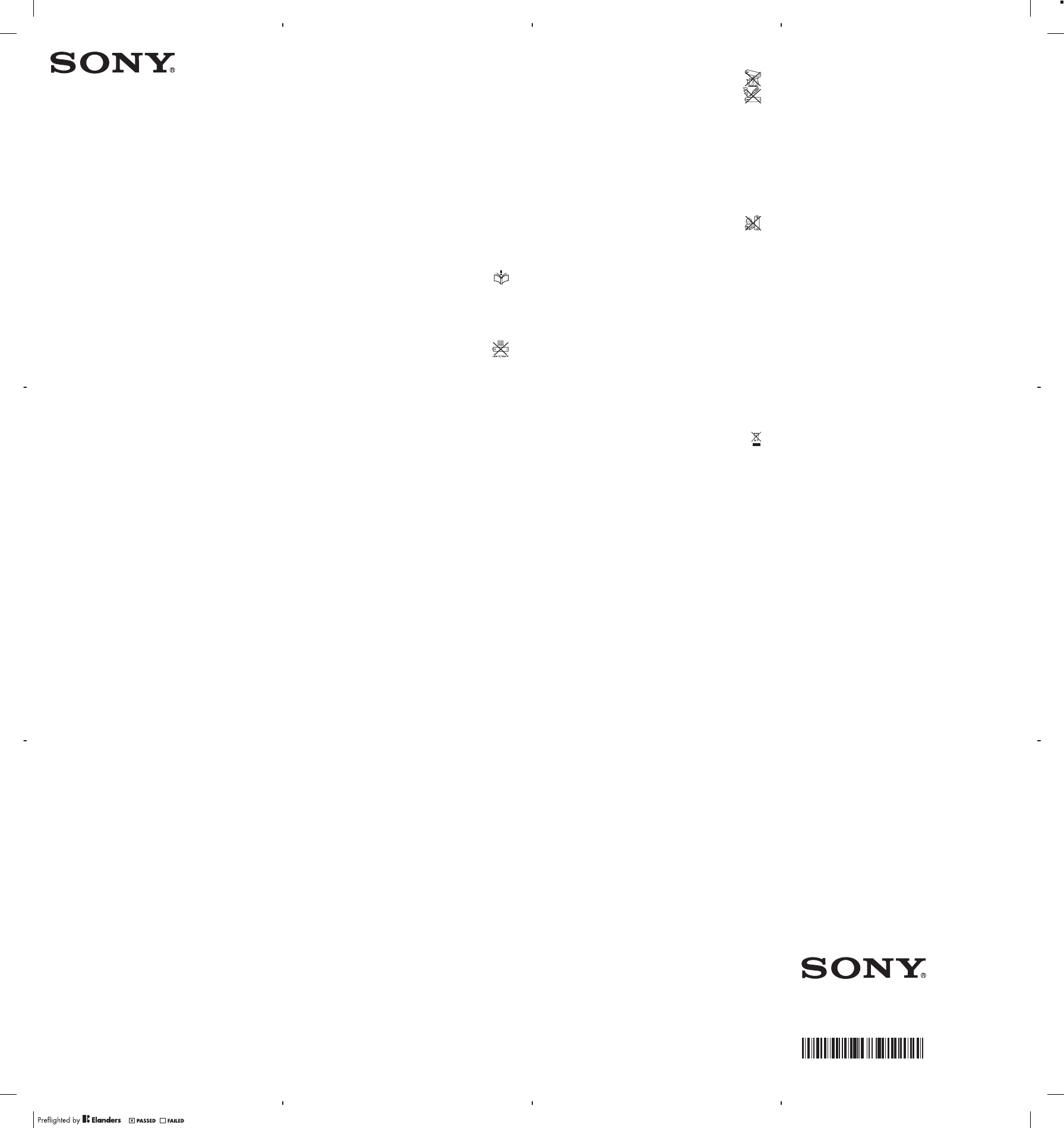
Important information
Sony Consumer Web site
At www.sonymobile.com/support there is a support section where
help and tips are only a few clicks away. Here you will find the latest
computer software updates and tips on how to use your product
more efficiently.
Service and support
You have access to a portfolio of exclusive service advantages
such as:
•Global and local Web sites providing support.
•A global network of Contact Centers.
•An extensive network of Sony service partners.
•A warranty period. Learn more about the warranty conditions in
theLimited warrantysection.
At www.sonymobile.com/support, you can find the latest support
tools and information. For operator-specific services and features,
please contact your network operator.
You can also contact our Contact Centers. If your country/region
is not represented in the list below, please contact your local
dealer. (Calls are charged according to national rates, including
local taxes, unless the phone number is a toll-free number.)
If your product needs service, please contact the dealer from
whom it was purchased, or one of our service partners. For
warranty claims, save proof of purchase.
Guidelines for Safe and Efficient Use
Please follow these guidelines. Failure to do so might entail a
potential health risk or product malfunction. If in doubt as to
its proper function, have the product checked by a certified service
partner before charging or using it.
Recommendations for care and safe use of our products
•Handle with care and keep in a clean and dust-free place.
•Warning! May explode if disposed of in fire.
•Do not expose to liquid or moisture or excess humidity.
•For optimum performance, the product should not be
operated in temperatures below -10°C(+14°F) or above
2
+45°C(+113°F). Do not expose the battery to
temperatures above +60°C(+140°F).
•Do not expose to flames or lit tobacco products.
•Do not drop, throw or try to bend the product.
•Do not paint or attempt to disassemble or modify the
product. Only Sony authorised personnel should perform
service.
•Consult with authorised medical staff and the instructions of the
medical device manufacturer before using the product near
pacemakers or other medical devices or equipment.
•Discontinue use of electronic devices, or disable the radio
transmitting functionality of the device, where required or
requested to do so.
•Do not use where a potentially explosive atmosphere exists.
•Do not place the product, or install wireless equipment, in the
area above an air bag in a car.
•Caution: Cracked or broken displays may create sharp edges or
splinters that could be harmful upon contact.
•Do not use the Bluetooth Headset in positions where it is
uncomfortable or will be subject to pressure.
Children
Warning! Keep out of the reach of children. Do not allow
children to play with mobile phones or accessories. They
could hurt themselves or others. Products may contain small parts
that could become detached and create a choking hazard.
Power supply (Charger)
Connect the charger to power sources as marked on the product.
Do not use outdoors or in damp areas. Do not alter or subject the
cord to damage or stress. Unplug the unit before cleaning it. Never
alter the plug. If it does not fit into the outlet, have a proper outlet
installed by an electrician. When a power supply is connected there
is a small drain of power. To avoid this small energy waste,
disconnect the power supply when the product is fully charged.
Use of charging devices that are not Sony branded may pose
increased safety risks.
3
Battery
New or idle batteries can have short-term reduced capacity. Fully
charge the battery before initial use. Use for the intended purpose
only. Charge the battery in temperatures between +5°C(+41°F) and
+45°C(+113°F). Do not put the battery into your mouth. Do not let
the battery contacts touch another metal object. Turn off the
product before removing the battery. Performance depends on
temperatures, signal strength, usage patterns, features selected
and voice or data transmissions. Only Sony service partners should
remove or replace built-in batteries. Use of batteries that are not
Sony branded may pose increased safety risks. Replace the battery
only with another Sony battery that has been qualified with the
product per the standard IEEE-1725. Use of an unqualified battery
may present a risk of fire, explosion, leakage or other hazard.
Personal medical devices
Mobile phones may affect implanted medical equipment. Reduce
risk of interference by keeping a minimum distance of
15 cm(6 inches) between the phone and the device. Use the phone
at your right ear. Do not carry the phone in your breast pocket. Turn
off the phone if you suspect interference. For use in proximity to
personal medical devices, please consult a physician and the
device manufacturer.
Driving
Some vehicle manufacturers forbid the use of phones in their
vehicles unless a handsfree kit with an external antenna supports
the installation. Check with the vehicle manufacturer's
representative to be sure that the mobile phone or Bluetooth
handsfree will not affect the electronic systems in the vehicle. Full
attention should be given to driving at all times and local laws and
regulations restricting the use of wireless devices while driving must
be observed.
GPS/Location based functions
Some products provide GPS/Location based functions. Location
determining functionality is provided “As is” and “With all faults”.
Sony does not make any representation or warranty as to the
accuracy of such location information.
4
Use of location-based information by the device may not be
uninterrupted or error free and may additionally be dependent on
network service availability. Please note that functionality may be
reduced or prevented in certain environments such as building
interiors or areas adjacent to buildings.
Caution: Do not use GPS functionality in a manner which causes
distraction from driving.
Emergency calls
Calls cannot be guaranteed under all conditions. Never rely solely
upon mobile phones for essential communication. Calls may not be
possible in all areas, on all networks, or when certain network
services and/or phone features are used.
Antenna
Use of antenna devices not marketed by Sony could damage the
phone, reduce performance, and produce SAR levels above the
established limits. Do not cover the antenna with your hand as this
affects call quality, power levels and can shorten talk and standby
times.
Radio Frequency (RF) exposure and Specific Absorption
Rate (SAR)
When the phone or Bluetooth handsfree is turned on, it emits low
levels of radio frequency energy. International safety guidelines
have been developed through periodic and thorough evaluation of
scientific studies. These guidelines establish permitted levels of
radio wave exposure. The guidelines include a safety margin
designed to assure the safety of all persons and to account for any
variations in measurements.
Specific Absorption Rate (SAR) is used to measure radio
frequency energy absorbed by the body when using a mobile
phone. The SAR value is determined at the highest certified power
level in laboratory conditions, but because the phone is designed to
use the minimum power necessary to access the chosen network,
the actual SAR level can be well below this value. There is no proof
of difference in safety based on difference in SAR value.
Products with radio transmitters sold in the US must be certified
by the Federal Communications Commission (FCC). When required,
tests are performed when the phone is placed at the ear and when
5
worn on the body. For body-worn operation, the phone has been
tested when positioned a minimum of 15 mm from the body without
any metal parts in the vicinity of the phone or when properly used
with an appropriate Sony accessory and worn on the body. When
operating with “Hotspot” functionality engaged, a separation
distance of 10mm was used.
For more information about SAR and radio frequency exposure,
go to: www.sonymobile.com/health.
Flight mode
Bluetooth and WLAN functionality, if available in the device, can be
enabled in Flight mode but may be prohibited onboard aircraft or in
other areas where radio transmissions are prohibited. In such
environments, please seek proper authorisation before enabling
Bluetooth or WLAN functionality even in Flight mode.
Malware
Malware (short for malicious software) is software that can harm the
mobile phone or other computers. Malware or harmful applications
can include viruses, worms, spyware, and other unwanted
programs. While the device does employ security measures to
resist such efforts, Sony does not warrant or represent that the
device will be impervious to the introduction of malware. You can
however reduce the risk of malware attacks by using care when
downloading content or accepting applications, refraining from
opening or responding to messages from unknown sources, using
trustworthy services to access the Internet, and only downloading
content to the mobile phone from known, reliable sources.
Accessories
Use only Sony branded original accessories and certified service
partners. Sony does not test third-party accessories. Accessories
may influence RF exposure, radio performance, loudness, electric
safety and other areas. Third-party accessories and parts may pose
a risk to your health or safety or decrease performance.
Accessible Solutions/Special Needs
In the US, compatible Sony Xperia phones may offer compatibility
with TTY terminals (with use of necessary accessory). For more
6
information call the Sony Special Needs Center on 877 878 1996
(TTY) or 877 207 2056 (voice), or go to www.sonyericsson-snc.com.
Disposal of old electrical and electronic equipment and
battery
This symbols on the electronic product or on its packaging
indicates that the electronic product inclusive the battery should
not be treated as household waste. Instead it should be handed
over to the applicable collection point for the recycling of electrical
and electronic equipment. Do not attempt to remove internal
batteries. Internal batteries shall be removed only by a waste
treatment facility or trained service professional.
By ensuring this product is disposed of correctly, you will help
prevent potential negative consequences for the environment and
human health, which could otherwise be caused by inappropriate
waste handling of this product. The recycling of materials will help
to conserve natural resources. For more detailed information about
recycling of this product, please contact your local city office, your
household waste disposal service or the shop where you
purchased the product, by calling a Sony Contact Center or at
www.sonymobile .com/recycling.
Memory card
If the product comes complete with a removable memory card, it is
generally compatible with the handset purchased but may not be
compatible with other devices or the capabilities of their memory
cards. Check other devices for compatibility before purchase or
use. If the product is equipped with a memory card reader, check
memory card compatibility before purchase or use.
Memory cards are generally formatted prior to shipping. To
reformat the memory card, use a compatible device. Do not use the
standard operating system format when formatting the memory
card on a PC. For details, refer to the operating instructions of the
device or contact customer support.
SIM card
If your phone is equipped with a standard-sized SIM card slot,
inserting an incompatible SIM card (for example, a micro SIM card,
a micro SIM card with a non-Sony adapter, or a standard SIM card
cut into a micro SIM card size) in the SIM card slot may damage
7
your SIM card or your phone permanently. Sony does not warrant
and will not be responsible for any damage caused by use of
incompatible or modified SIM cards.
For Devices Supporting 3D Viewing capabilities
In viewing 3D images shot with this phone on a 3D-compatible
monitor, you may experience discomfort in the form of eye strain,
fatigue, or nausea. To prevent these symptoms, we recommend
that you take regular breaks. However, you need to determine for
yourself the length and frequency of breaks you require, as they
vary according to the individual. If you experience any type of
discomfort, stop viewing the 3D images until you feel better, and
consult a physician as necessary. Also refer to the operating
instructions supplied with the device or software you have
connected or are using with this phone. Note that a child’s eyesight
is still at the development stage (particularly children below the age
of 6). Consult a pediatrician or ophthalmologist before letting your
child view 3D images, and make sure he/she observes the above
precautions when viewing such images.
Warning!
If the device requires an adapter for insertion into the handset or
another device, do not insert the card directly without the required
adapter.
Precautions on memory card use
•Do not expose the memory card to moisture.
•Do not touch terminal connections with your hand or any metal
object.
•Do not strike, bend, or drop the memory card.
•Do not attempt to disassemble or modify the memory card.
•Do not use or store the memory card in humid or corrosive
locations or in excessive heat such as a closed car in summer, in
direct sunlight or near a heater, etc.
•Do not press or bend the end of the memory card adapter with
excessive force.
•Do not let dirt, dust, or foreign objects get into the insert port of
any memory card adapter.
•Check you have inserted the memory card correctly.
8
•Insert the memory card as far as it will go into any memory card
adapter needed. The memory card may not operate properly
unless fully inserted.
•We recommend that you make a backup copy of important data.
We are not responsible for any loss or damage to content you
store on the memory card.
•Recorded data may be damaged or lost when you remove the
memory card or memory card adapter, turn off the power while
formatting, reading or writing data, or use the memory card in
locations subject to static electricity or high electrical field
emissions.
Protection of personal information
Erase personal data before disposing of the product. To delete
data, perform a master reset. Deleting data from the phone memory
does not ensure that it cannot be recovered. Sony does not warrant
against recovery of information and does not assume responsibility
for disclosure of any information even after a master reset.
Loudness warning!
Avoid volume levels that may be harmful to your hearing.
End User Licence Agreement
Software delivered with this device and its media is owned by Sony
Mobile Communications AB, and/or its affiliated companies and its
suppliers and licensors.
Sony grants you a non-exclusive limited licence to use the
Software solely in conjunction with the Device on which it is
installed or delivered. Ownership of the Software is not sold,
transferred or otherwise conveyed.
Do not use any means to discover the source code or any
component of the Software, reproduce and distribute the Software,
or modify the Software. You are entitled to transfer rights and
obligations to the Software to a third party, solely together with the
Device with which you received the Software, provided the third
party agrees in writing to be bound by the terms of this Licence.
This licence exists throughout the useful life of this Device. It can
be terminated by transferring your rights to the Device to a third
party in writing.
9
Failure to comply with any of these terms and conditions will
terminate the licence immediately.
Sony and its third party suppliers and licensors retain all rights,
title and interest in and to the Software. To the extent that the
Software contains material or code of a third party, such third
parties shall be beneficiaries of these terms.
This licence is governed by the laws of Sweden. When
applicable, the foregoing applies to statutory consumer rights.
In the event Software accompanying or provided in conjunction
with your device is provided with additional terms and conditions,
such provisions shall also govern your possession and usage of the
Software.
Export regulations
Export regulations: Goods delivered under this Agreement may be
the subject to import and export regulations of the European Union,
the United States and other countries. Purchaser will comply with
these applicable laws and regulations and will obtain and maintain
any export and import license required for the delivery of goods to
Purchaser under this Agreement. Without limiting the foregoing,
and as an example, Purchaser will not knowingly export or re-
export goods to destinations identified pursuant to Articles in
Chapter II of European Council Regulation (EC) 428/2009 and
specifically, and without limitation, Purchaser will also comply with
U.S. government Export Administration Regulations (“EAR”, 15
C.F.R. §§ 730-774, http://www.bis.doc.gov/) administered by
Department of Commerce, Bureau of Industry and Security and
economic sanctions regulations (30 C.F.R. §§ 500 et. seq., http://
www.treas.gov/offices/enforcement/ofac/) administered by the U.S.
Department of Treasury, Office of Foreign Assets Control.
Limited Warranty
Sony Mobile Communications AB, SE-221 88 Lund, Sweden,
(Sony) or its local affiliated company, provides this Limited Warranty
for your mobile phone, original accessory delivered with your
mobile phone, and/or your mobile computing product (hereinafter
referred to as “Product”).
10
Should your Product need warranty service, please return it to
the dealer from whom it was purchased, or contact your local Sony
Contact Center (national rates may apply) or visit
www.sonymobile.com to get further information.
Our warranty
Subject to the conditions of this Limited Warranty, Sony warrants
this Product to be free from defects in design, material and
workmanship at the time of its original purchase by a consumer.
This Limited Warranty will last for a period of two (2) years as from
the original date of purchase of the Product for your mobile phone,
and for a period of one (1) year following the original purchase date
of the Product for all original accessories (such as the battery,
charger or handsfree kit) which may be delivered with your mobile
phone.
What we will do
If, during the warranty period, this Product fails to operate under
normal use and service, due to defects in design, materials or
workmanship, Sony authorised distributors or service partners, in
the country/region* where you purchased the Product, will, at their
option, either repair or replace the Product in accordance with the
terms and conditions stipulated herein.
Sony and its service partners reserve the right to charge a
handling fee if a returned Product is found not to be under warranty
according to the conditions below.
Please note that some of your personal settings, downloads and
other information may be lost when your Sony Product is repaired
or replaced. At present, Sony may be prevented by applicable law,
other regulation or technical restrictions from making a backup
copy of certain downloads. Sony does not take any responsibility
for any lost information of any kind and will not reimburse you for
any such loss. You should always make backup copies of all the
information stored on your Sony Product such as downloads,
calendar and contacts before handing in your Sony Product for
repair or replacement.
Conditions
1. This Limited Warranty is valid only if the original proof of purchase
for this Product issued by a Sony authorised dealer specifying the
11
www.sonymobile.com
Sony Mobile Communications AB
SE-221 88 Lund, Sweden
1222-9269.9
June 27, 2012 15:00:07
Legal-Leaflets---Generic_EN (24M)_1222-9269.9.pdf 1 of 2

date of purchase and serial number**, is presented with the
Product to be repaired or replaced. Sony reserves the right to
refuse warranty service if this information has been removed or
changed after the original purchase of the Product from the
dealer.
2. If Sony repairs or replaces the Product, the repair for the defect
concerned, or the replaced Product shall be warranted for the
remaining time of the original warranty period or for ninety (90)
days from the date of repair, whichever is longer. Repair or
replacement may involve the use of functionally equivalent
reconditioned units. Replaced parts or components will become
the property of Sony.
3. This warranty does not cover any failure of the Product due to
normal wear and tear, or due to misuse, including but not limited
to use in other than the normal and customary manner, in
accordance with the Sony instructions for use and maintenance
of the Product. Nor does this warranty cover any failure of the
Product due to accident, software or hardware modification or
adjustment, acts of God or damage resulting from liquid.
A rechargeable battery can be charged and discharged more
than a hundred times. However, it will eventually wear out – this is
not a defect and corresponds to normal wear and tear. When the
talk-time or standby time is noticeably shorter, it is time to replace
the battery. Sony recommends that you use only batteries and
chargers approved by Sony.
Minor variations in display brightness and colour may occur
between phones. There may be tiny bright or dark dots on the
display. It occurs when individual dots have malfunctioned and
can not be adjusted. Two defective pixels are deemed
acceptable.
Minor variations in camera image appearance may occur
between phones. This is nothing uncommon and is not regarded
as a defective camera module.
4. Since the cellular system on which the Product is to operate is
provided by a carrier independent from Sony, Sony will not be
responsible for the operation, availability, coverage, services or
range of that system.
5. This warranty does not cover Product failures caused by
installations, modifications, or repair or opening of the Product
performed by a non-Sony authorised person.
12
6. The warranty does not cover Product failures which have been
caused by use of accessories or other peripheral devices which
are not Sony branded original accessories intended for use with
the Product.
Sony disclaims any and all warranties, whether express or
implied, for failures caused to the Product or peripheral devices
as a result of viruses, trojan horses, spyware, or other malicious
software. Sony strongly recommends that you install appropriate
virus protection software on your Product and any peripheral
devices connected to it, as available, and update it regularly, to
better protect your device. It is understood, however, that such
software will never fully protect your Product or its peripheral
devices and Sony disclaims all warranties, whether express or
implied, in case of failure by such antivirus software to fulfil its
intended purpose.
7. Tampering with any of the seals on the Product will void the
warranty.
8. THERE ARE NO EXPRESS WARRANTIES, WHETHER WRITTEN
OR ORAL, OTHER THAN THIS PRINTED LIMITED WARRANTY.
ALL IMPLIED WARRANTIES, INCLUDING WITHOUT LIMITATION
THE IMPLIED WARRANTIES OF MERCHANTABILITY OR
FITNESS FOR A PARTICULAR PURPOSE, ARE LIMITED TO THE
DURATION OF THIS LIMITED WARRANTY. IN NO EVENT SHALL
SONY OR ITS LICENSORS BE LIABLE FOR INCIDENTAL OR
CONSEQUENTIAL DAMAGES OF ANY NATURE WHATSOEVER,
INCLUDING BUT NOT LIMITED TO LOST PROFITS OR
COMMERCIAL LOSS TO THE FULL EXTENT THOSE DAMAGES
CAN BE DISCLAIMED BY LAW.
Some countries/states do not allow the exclusion or limitation of
incidental or consequential damages, or limitation of the duration of
implied warranties, so the preceding limitations or exclusions may
not apply to you.
The warranty provided does not affect the consumer’s statutory
rights under applicable legislation in force, nor the consumer’s
rights against the dealer arising from their sales / purchase
contract.
*Geographical scope of the warranty
If you have purchased your Product in a country member of the
European Economic Area (EEA) or in Switzerland or the Republic of
13
Turkey, and such Product was intended for sale in the EEA or in
Switzerland or in Turkey, you can have your Product serviced in any
EEA country or in Switzerland or in Turkey, under the warranty
conditions prevailing in the country in which you require servicing,
provided that an identical Product is sold in such country by an
authorised Sony distributor. To find out if your Product is sold in the
country you are in, please call the local Sony Contact Center.
Please observe that certain services may not be available outside
the country of original purchase, for example, due to the fact that
your Product may have an interior or exterior which is different from
equivalent models sold in other countries. Please note in addition
that it may sometimes not be possible to repair SIM-locked
Products.
Our goods come with guarantees that cannot be excluded under
the Australian Consumer Law. If you purchased your product in
Australia, you are entitled to a replacement or refund for a major
failure and compensation for any other reasonably foreseeable loss
or damage. You are also entitled to have the goods repaired or
replaced if the goods fail to be of acceptable quality and the failure
does not amount to a major failure. For warranty service in
Australia, please contact 1300 650 050 or Sony Service Centre, 320
Princes Hwy, ROCKDALE NSW 2216.
** In some countries/regions additional information (such as a
valid warranty card) may be requested.
Trademarks and acknowledgements
The Liquid Identity logo and Xperia are trademarks or registered
trademarks of Sony Mobile Communications AB.
Sony is a trademark or a registered trademark of Sony Corporation.
Ericsson is a trademark or registered trademark of
Telefonaktiebolaget LM Ericsson.
Bluetooth is a trademark or a registered trademark of Bluetooth SIG
Inc. and any use of such mark by Sony is under license.
Other product and company names mentioned herein may be the
trademarks of their respective owners.
Any rights not expressly granted herein are reserved.
14
Anguilla 1-800-080-9518
(Toll Free)
questions.CO@support.sonymobile.co
m
Antigua and
Barbuda
1-800-081-9518
(Toll Free)
questions.CO@support.sonymobile.co
m
Argentina 0800-333-7427
(número gratuito)
questions.CO@support.sonymobile.co
m
Australia 1300 650-050
(Toll Free)
questions.AU@support.sonymobile.co
m
The
Bahamas
1-800-205-6062
(Toll Free)
questions.CO@support.sonymobile.co
m
Barbados 1-800-082-9518
(Toll Free)
questions.CO@support.sonymobile.co
m
Belgique/
België
02-0745 1611 questions.BE@support.sonymobile.co
m
Belize AN 815, PIN
5597 (Toll Free)
questions.CO@support.sonymobile.co
m
Bermuda 1-800-083-9518
(Toll Free)
questions.CO@support.sonymobile.co
m
Bolivia 800-100-542
(número gratuito)
questions.CO@support.sonymobile.co
m
Brasil 4001-0444
(Capitais e
regiões
metropolitanas)
0800 884 0444
(Demais regiões)
questions.BR@support.sonymobile.co
m
Canada 1 866 766 9374
(Toll Free / sans
frais)
questions.CA@support.sonymobile.co
m
Cayman
Islands
1-800-084-9518
(Toll Free)
questions.CO@support.sonymobile.co
m
15
Central and
Southern
Africa
+27 11 506 0123 questions.CF@support.sonymobile.co
m
Česká
republika 844 550 055 questions.CZ@support.sonymobile.co
m
Chile 800-646-425
(número gratuito)
questions.CO@support.sonymobile.co
m
Colombia 01800-0966-080
(número gratuito)
questions.CO@support.sonymobile.co
m
Costa Rica 0 800 011 0400
(número gratuito)
questions.CO@support.sonymobile.co
m
Danmark 3331 2828 questions.DK@support.sonymobile.co
m
Deutschland 0180 534 2020
(ortsübliche
Gebühren)
questions.DE@support.sonymobile.co
m
Dominica 1-800-085-9518
(Toll Free)
questions.CO@support.sonymobile.co
m
Ecuador 1-800-0102-50
(número gratuito)
questions.CO@support.sonymobile.co
m
Eesti 06 032 032 questions.EE@support.sonymobile.co
m
Egypt/رصم 16727 questions.EG@support.sonymobile.co
m
Ελλάδα 801 11 810 810
+30 210 899 19 19
(από κινητό
τηλέφωνο)
questions.GR@support.sonymobile.co
m
El Salvador 800-6323
(número gratuito)
questions.CO@support.sonymobile.co
m
España 902 180 576
(tarifa local)
questions.ES@support.sonymobile.co
m
16
France 09 69 32 21 21
09 69 32 21 22
(Xperia™
uniquement)
questions.FR@support.sonymobile.co
m
Guatemala 1-800-300-0057
(número gratuito)
questions.CO@support.sonymobile.co
m
Haïti/Ayiti AN 193, PIN
5598 (numéro
gratuit / nimewo
gratis)
questions.CO@support.sonymobile.co
m
Honduras AN 8000122,
PIN 5599
(número gratuito)
questions.CO@support.sonymobile.co
m
Hong Kong/
香港
+852 8203 8863 questions.HK@support.sonymobile.co
m
Hrvatska 062 000 000 questions.HR@support.sonymobile.co
m
India/भारत 1800 11 1800
(Toll Free)
+91 (011)
39011111
questions.IN@support.sonymobile.com
Indonesia +62 21 2935
7669
questions.ID@support.sonymobile.com
Ireland 1850 545 888
(Local rate)
questions.IE@support.sonymobile.com
Italia 06 48895206
(tariffa locale)
questions.IT@support.sonymobile.com
Jamaica 1-800-442-3471
(Toll Free)
questions.CO@support.sonymobile.co
m
Κύπρος/
Kıbrıs
0800 90 909 questions.CY@support.sonymobile.co
m
Latvija 67 21 43 01 questions.LV@support.sonymobile.co
m
Lietuva 8 700 55030 questions.LT@support.sonymobile.co
m
17
Magyarorsz
ág
01 880 47 47 questions.HU@support.sonymobile.co
m
Malaysia 1 800-88-7666 questions.MY@support.sonymobile.co
m
Maroc/
+212 2 2958 344 questions.MA@support.sonymobile.co
m
México 0 1800 000 4722
(número gratuito)
questions.MX@support.sonymobile.co
m
Nederland 0900 8998318 questions.NL@support.sonymobile.co
m
Nederlandse
Antillen
001-866-509-86
60 (gratis
nummer)
questions.CO@support.sonymobile.co
m
New
Zealand
0800-100-150
(Toll Free)
questions.NZ@support.sonymobile.co
m
Nicaragua AN 1800-0166,
PIN 5600
(número gratuito)
questions.CO@support.sonymobile.co
m
Norge 815 00 840
(lokaltakst)
questions.NO@support.sonymobile.co
m
Österreich 0810 200 245 questions.AT@support.sonymobile.co
m
Pakistan/
021 - 111 22 55
73
questions.PK@support.sonymobile.co
m
Panamá 00800-787-0009
(número gratuito)
questions.CO@support.sonymobile.co
m
Paraguay 009 800 54
20032 (número
gratuito)
questions.CO@support.sonymobile.co
m
Perú 0800-532-38
(número gratuito)
questions.CO@support.sonymobile.co
m
Philippines/
Pilipinas
+632 479 9777
or 1800 1 853
7669
questions.PH@support.sonymobile.co
m
18
Polska +48 22 22 77
444
questions.PL@support.sonymobile.co
m
Portugal 808 204 466
(chamada local)
questions.PT@support.sonymobile.co
m
República
Dominicana
1-800-751-3370
(número gratuito)
questions.CO@support.sonymobile.co
m
România +40 21 401 0401 questions.RO@support.sonymobile.co
m
Saint Kitts
and Nevis
1-800-087-9518
(Toll Free)
questions.CO@support.sonymobile.co
m
Saint
Vincent and
the
Grenadines
1-800-088-9518
(Toll Free)
questions.CO@support.sonymobile.co
m
Schweiz/
Suisse/
Svizzera
0848 824 040 questions.CH@support.sonymobile .co
m
Singapore +65 6744 0733 questions.SG@support.sonymobile.co
m
Slovenia 0800 81291 questions.si@support.sonymobile.com
Slovensko 02 5443 6443 questions.SK@support.sonymobile.co
m
South Africa 0861 632222 questions.ZA@support.sonymobile.co
m
South
Κorea/대한
민국
(+82) 1588 4170 questions.KO@support.sonymobile.co
m
Suomi 09 299 2000 questions.FI@support.sonymobile.com
Sverige 013 24 45 00
(lokal taxa)
questions.SE@support.sonymobile.co
m
Thailand 001 800 852
7663 or 02401
3030
questions.CO@support.sonymobile.co
m
19
Trinidad and
Tobago
1-800-080-9521
(Toll Free)
questions.CO@support.sonymobile.co
m
Türkiye +90 212 473 77
77
questions.TR@support.sonymobile.co
m
United
Kingdom
08705 237 237
(Local rate)
questions.GB@support.sonymobile.co
m
United
States
1 866 766 9374 questions.US@support.sonymobile.co
m
Uruguay 000-401-787-01
3 (número
gratuito)
questions.CO@support.sonymobile.co
m
Venezuela 0-800-1-00-2250
(número gratuito)
questions.CO@support.sonymobile.co
m
Việt Nam 1900 1525 (miễn
phí)
questions.VN@support.sonymobile .co
m
България 0800 1 8778 questions.BG@support.sonymobile.co
m
Россия 8-800-1008022 questions.RU@support.sonymobile.co
m
Україна +38 044 590
1515
questions.UA@support.sonymobile.co
m
+971 4 3919 880 questions.JO@support.sonymobile.co
m
+971 4 3919 880
(UAE)
questions.AE@support.sonymobile.co
m
+971 4 3919 880 questions.KW@support.sonymobile.co
m
800-8200-727 questions.SA@support.sonymobile.co
m
20
中国 +86 400 810
0000
questions.CN@sonymobile.com
台灣 +886 2
25625511
questions.TW@support.sonymobile.co
m
ไทย 02 2483 030 questions.TH@support.sonymobile.co
m
21
June 27, 2012 15:00:08
Legal-Leaflets---Generic_EN (24M)_1222-9269.9.pdf 2 of 2